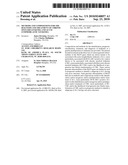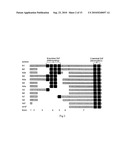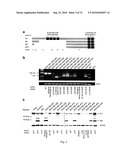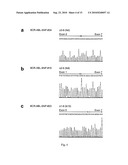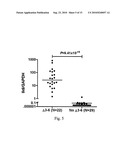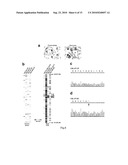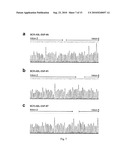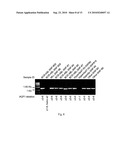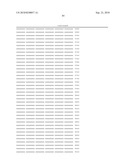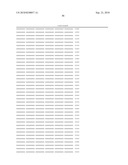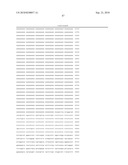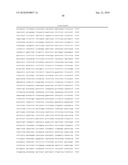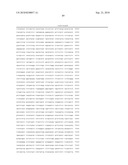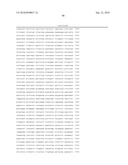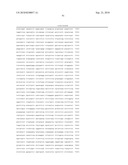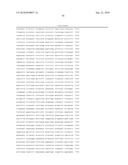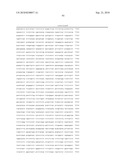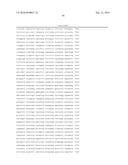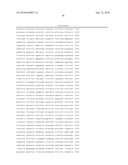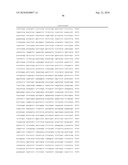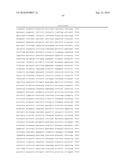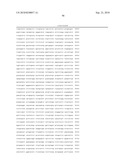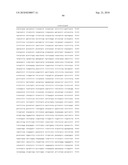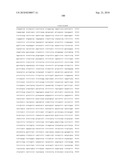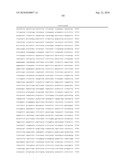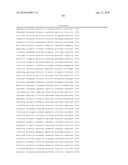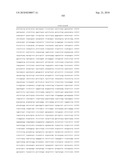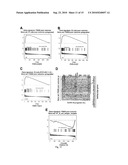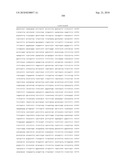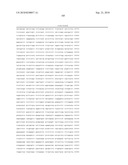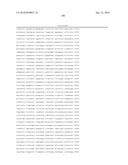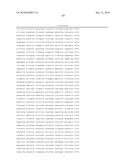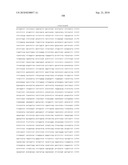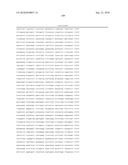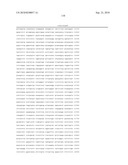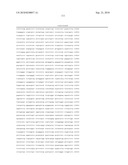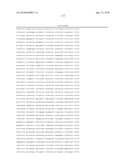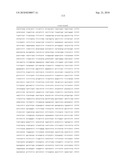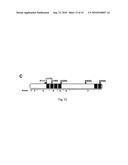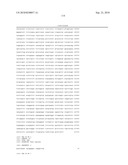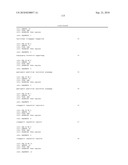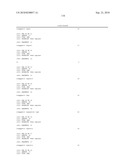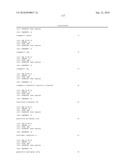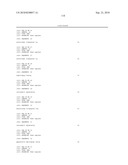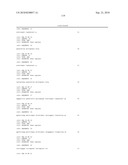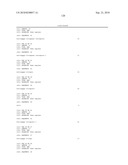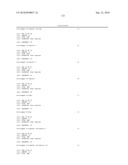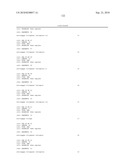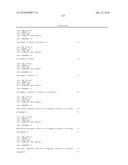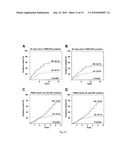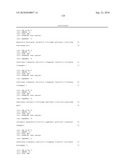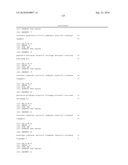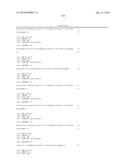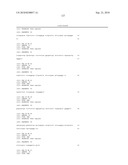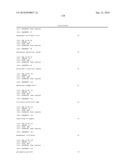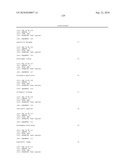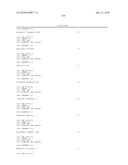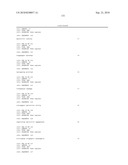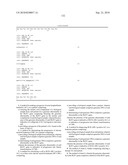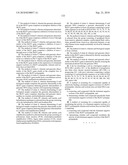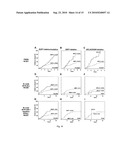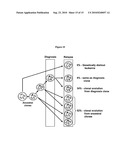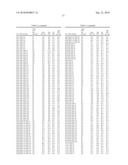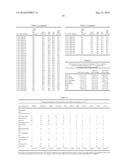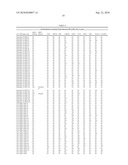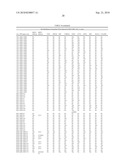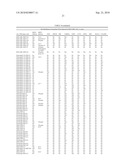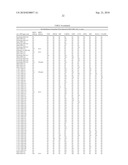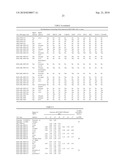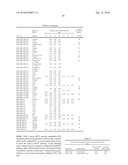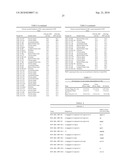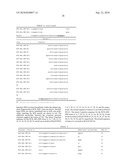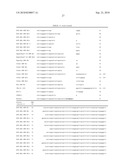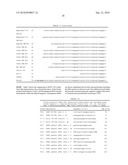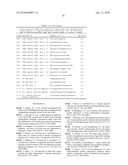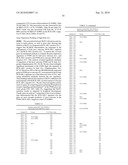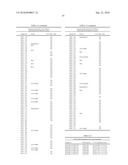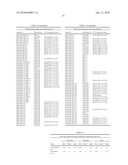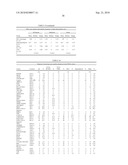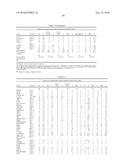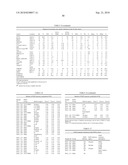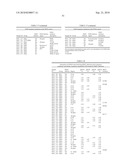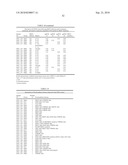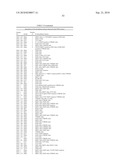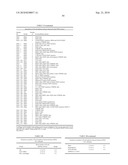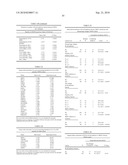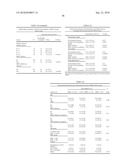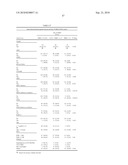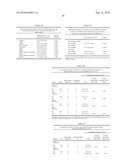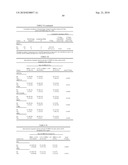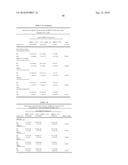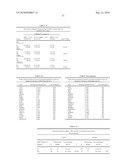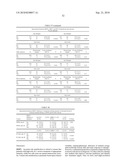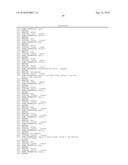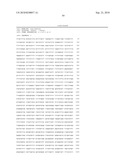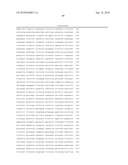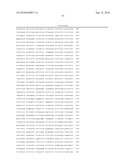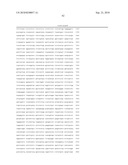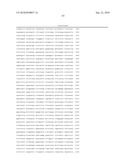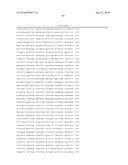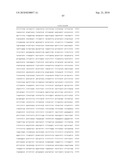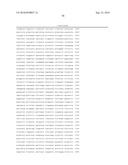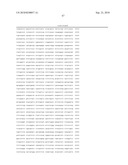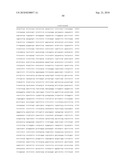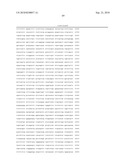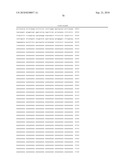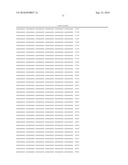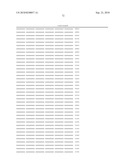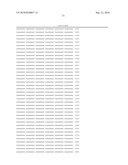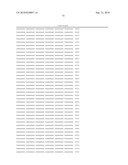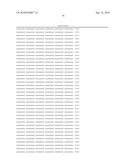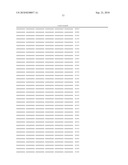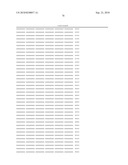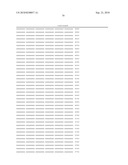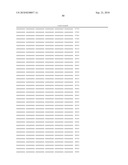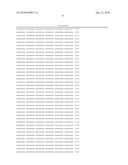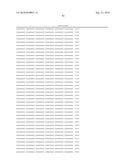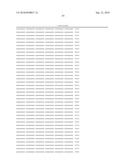Patent application title: METHODS AND COMPOSITIONS FOR THE DIAGNOSIS AND TREATMENT OF CHRONIC MYELOID LEUKEMIA AND ACUTE LYMPHOBLASTIC LEUKEMIA
Inventors:
James Downing (Memphis, TN, US)
Charles Mullighan (Memphis, TN, US)
Assignees:
St. Jude Children's Research Hospital
IPC8 Class: AC12Q168FI
USPC Class:
435 6
Class name: Chemistry: molecular biology and microbiology measuring or testing process involving enzymes or micro-organisms; composition or test strip therefore; processes of forming such composition or test strip involving nucleic acid
Publication date: 2010-09-23
Patent application number: 20100240057
Claims:
1. A method for making a prognosis of acute lymphoblastic leukemia (ALL)
in a patient comprisinga) assaying the nucleic acid complement of a
biological sample from said patient for a genomic abnormality in the
IKZF1 gene comprising detecting the genomic abnormality of the IKZF1 gene
in the nucleic acid complement of said biological sample, wherein the
presence of the genomic abnormality of said IKZF1 gene is indicative of a
subgroup of ALL having poor outcomes; and,b) providing a prognosis of the
patient's ALL based on the assay of step (a).
2. A method for determining the progression of chronic myeloid leukemia (CML) in a patient comprisinga) providing a biological sample from said patient, wherein said biological sample comprises genomic DNA of said sample,b) determining if said genomic DNA comprises a genomic abnormality in the IKZF1 gene,wherein the presence of the genomic abnormality of said IKZF1 gene is indicative of progression into blastic transformation of CML.
3. A method for classifying a cell as BCR-ABL1 positive ALL or as blast crisis chronic myeloid leukemia (BC-CML) comprisinga) providing a biological sample from a patient, wherein said biological sample comprises genomic DNA of said sample,b) determining if said genomic DNA comprises a genomic abnormality in the IKZF1 gene,wherein the presence of the genomic abnormality of said IKZF1 gene is indicative of BCR-ABL1 positive ALL or is indicative of progression into blastic transformation of CML.
4. A method for diagnosing BCR-ABL1 positive ALL in a leukemia patient comprisinga) providing a biological sample from said patient, wherein said biological sample comprises genomic DNA of said sample,b) determining if said genomic DNA comprises a genomic abnormality in the IKZF1 gene,wherein the presence of the genomic abnormality of said IKZF1 gene is indicative of BCR-ABL1 positive ALL.
5. The method of claim 1, further comprising selecting a therapy for said patient.
6. The method of claim 1, wherein the genomic abnormality in the IKZF1 gene comprises a deletion of the IKZF1 gene.
7. The method of claim 1, wherein the genomic abnormality in the IKZF1 gene comprises an intragenic deletion of the IKZF1 gene.
8. The method of claim 1, wherein said genomic abnormality in the IKZF1 gene comprises a deletion of at least one exon of the IKZF1 gene.
9. The method of claim 7, wherein said genomic abnormality of the IKZF1 gene comprises a deletion of exon 3 through exon 6 of the IKZF1 gene.
10. The method of claim 7, wherein said genomic abnormality of the IKZF1 gene comprises a deletion of exon 2 through exon 6 of the IKZF1 gene.
11. The method of claim 7, wherein said genomic abnormality of the IKZF1 gene comprises a deletion of exon 1 through exon 6 of the IKZF1 gene.
12. The method of claim 7, wherein said genomic abnormality of the IKZF1 gene comprises a deletion of the promoter or a deletion in the 5' region of the IKZF1 gene.
13. The method claim 1, wherein said genomic abnormality of the IKZF1 gene results in the expression of a dominant negative isoform of a IKZF1 polypeptide, wherein said isoform does not bind DNA.
14. The method of claim 1, wherein said genomic abnormality of the IKZF1 gene results in the complete loss of expression of the IKZF1 polypeptide.
15. The method of claim 1, wherein said genomic abnormality of the IKZF1 gene results from a recombinase activating gene (RAG) mediated-recombination event.
16. The method of claim 1, wherein determining if said biological sample comprises the genomic abnormality in the IKZF1 gene comprises detecting genomic abnormalities of genomic DNA using a nucleic acid sequencing technique.
17. The method of claim 1, wherein determining if said biological sample comprises the genomic abnormalities in the IKZF1 gene comprises detecting said genomic abnormalities in a nucleic acid hybridization technique.
18. The method of claim 17, wherein said nucleic acid hybridization technique is selected from the group consisting of in situ hybridization (ISH) and Southern blot.
19. The method of claim 1, wherein determining if said biological sample comprises the genomic abnormality in the IKZF1 gene comprises detecting said genomic abnormalities in a nucleic acid amplification method.
20. The method of claim 19, wherein said nucleic acid amplification method is selected from the group consisting of polymerase chain reaction (PCR), transcription-mediated amplification (TMA), ligase chain reaction (LCR), strand displacement amplification (SDA), and nucleic acid sequence based amplification (NASBA).
21. The method of claim 1, wherein determining if said genomic DNA comprises a genomic abnormality in the IKZF1 gene employs at least one primer comprising a nucleotide sequence as set forth in SEQ ID NO: 74, 75, 76, 77, 78, 79, 80, 81, 82, 83, 84, 85, 86, 87, 88, 89, 90, 91, 92, 93, 94, 95, 96, 97, 98, 99, 100, 101, 102, 103, or 104.
22. The method of claim 1, wherein said biological sample is selected from the group consisting of peripheral blood, bone marrow, apheresis samples, cerebrospinal fluid, saliva, urine, gonadal tissue, tissue (e.g. chloroma) biopsies, or any other human tissue sample potentially involved by leukemic infiltration.
23. The method of claim 1, wherein said biological sample is from a human.
24. The method of claim 4, wherein said genomic abnormality in the IKZF1 gene is detected by directly assaying the genomic DNA sequence.
25. The method of claim 4, wherein said genomic abnormality in the IKZF1 gene is detected by directly assaying the transcript produced from the genomic DNA.
26. A kit for classifying a cell in a biological sample as BCR-ABL1 positive ALL or the likelihood of progression into blast crisis chronic myeloid leukemia (BC-CML) or prognosing ALL with poor outcomes comprising a primer consisting of a polynucleotide sequence as set forth in SEQ ID NO: 74, 75, 76, 77, 78, 79, 80, 81, 82, 83, 84, 85, 86, 87, 88, 89, 90, 91, 92, 93, 94, 95, 96, 97, 98, 99, 100, 101, 102, 103, and/or 104.
27. A method of screening for a compound capable of selectively binding a dominant negative isoform of a IKZF1 polypeptide, wherein said isoform does not bind DNA comprisinga) contacting said compound with the dominant negative isoform of the IKZF1 polypeptide, andb) determining whether said compound specifically binds said dominant negative isoform of the IKZF1 polypeptide.
28. A method of screening for a compound capable of modulating the activity of a dominant negative isoform of a IKZF1 polypeptide wherein said isoform does not bind DNA Comprisinga) contacting said compound with the dominant negative isoform of the IKZF1 polypeptide, andb) determining whether said compound modulates the activity of said dominant negative isoform of the IKZF1 polypeptide.
Description:
FIELD OF THE INVENTION
[0001]The present invention relates generally to the detection and/or prognosis and/or diagnosis and/or treatment of sub-types of acute lymphoblastic leukemia and/or chronic myeloid leukemia.
BACKGROUND OF THE INVENTION
[0002]Leukemia's are classified into four multiple groups or types, including: acute myeloid leukemia (AML), acute lymphatic leukemia (ALL), chronic myeloid (CML) and chronic lymphocytic leukemia (CLL). Within these groups, several subcategories can be further identified using a panel of standard diagnostic techniques. These different subcategories of leukemia are associated with varying clinical outcomes and therefore are the basis for different treatment strategies.
[0003]The development of new specific drugs and treatment approaches requires the identification of specific subtypes that may benefit from a distinct therapeutic protocol and, thus, can improve outcome of distinct subsets of leukemia. As it is mandatory for the patients suffering from these specific leukemia subtypes to be identified as fast as possible so that the best therapy can be applied, diagnostics today must accomplish sub-classification with maximal precision. Thus, methods and compositions are needed in the art to provide means for additional leukemia diagnostic and prognostic markers.
SUMMARY OF THE INVENTION
[0004]Compositions and methods for the identification, prognosis, classification, diagnosis and/or treatment of leukemia or a genetic predisposition to leukemia are provided. In one embodiment, the present invention is based on the discovery of multiple genomic abnormalities of the IKZF1 (Ikaros) gene which are shown herein to be associated with acute lymphoblastic leukemia (ALL), more particularly, with BCR-ABL1 positive ALL, and to be associated with chronic myeloid leukemia (CML), more particularly, a subtype of CML termed blast crisis chronic myeloid leukemia (BC-CML). In another embodiment, the present invention demonstrates that the genomic abnormalities of the IKZF1 gene can be used as prognostic markers to identify a subgroup of BCR-ABL1 negative ALL having very poor outcomes. The present invention therefore provides compositions comprising polynucleotides, including both genomic sequences of the various IKZF1 genomic abnormalities disclosed herein and any transcripts encoded thereby. Such polynucleotides comprising the genomic abnormalities of the IKZF1 gene find use, for example, as biomarkers for use in methods for detecting genomic abnormalities which are associated with ALL, more specifically, which are associated with BCR-ABL1 positive ALL, and/or for detecting genomic abnormalities which are associated with CML, more particularly, with BC-CML or the likelihood of progression into blastic transformation of CML. In another embodiment, the biomarkers can be used as a prognostic markers to identify a subgroup of ALL having very poor outcomes. Accordingly, the present invention encompasses methods and compositions useful in the identification and/or the prognosis and/or predisposition and/or treatment of a subject with ALL and/or a subject with CML, more particularly, with BC-CML or the likelihood of progression into blastic transformation of CML.
[0005]The compositions of the invention can further be employed in methods for selecting a therapy for a subject affect by leukemia. Including, for example, selecting an appropriate therapy for ALL and/or selecting a therapy for CML, more particularly, a therapy for a patient with BC-CML or for a patient with CML having a likelihood of progression into blastic transformation of CML. Further provided are methods for identifying agents that target a polypeptide expressed from the IKZF1 genomic abnormality. Thus, methods to screen for compounds that can serve as molecular targets for drugs useful in modulating the activity of the polypeptides expressed from the IKZF1 genomic abnormalities are provided. Such compounds can find use in treating ALL and/or treating a subject with CML, more particularly, treating a subject with BC-CML or a patient having CML with the likelihood of progression into blastic transformation of CML. Accordingly, the present invention encompasses methods and compositions useful in the identification and/or the prognosis and/or predisposition and/or treatment of ALL and/or CML, more specifically, BC-CML.
DESCRIPTION OF THE FIGURES
[0006]FIG. 1A-C depicts IKZF1 deletions in BCR-ABL1 ALL. a, Domain structure of IKZF1. Coding exons 3-5 encode four N-terminal zinc fingers (black boxes) responsible for DNA binding. The C-terminal zinc fingers encoded by exon 7 are essential for homo- and heterodimerization. b. Genomic organization of IKZF1 and location of each of the 36 deletions observed in BCR-ABL1 B-progenitor ALL. Each line depicts the deletion(s) observed in each case. In five cases, two discontiguous deletions were observed. Hemizygous deletions are solid lines and homozygous deletions dashed. Arrows indicate deletions extending beyond the limits of the figure. The exact boundaries of the deletions were defined by genomic qPCR, and for IKZF1 Δ3-6, by long-range genomic PCR. c, dChipSNP raw log2ratio copy number data depicting IKZF1 deletions for 29 BCR-ABL1 cases and 3 B-progenitor ALL cell lines.
[0007]FIG. 2 provides the structure of Ikaros isoforms. IKZF1 has 8 exons (0-7), of which exons 1-7 (gray boxes) are coding. Exons 3-5 encode four N-terminal zinc fingers (black boxes) responsible for DNA binding. The C-terminal zinc fingers encoded by exon 7 are essential for homo- and heterodimerization. Two novel Ikaros isoforms that arise from genomic deletions of exons 2-6 (Ik9) or 1-6 (Ik10) were identified. Neither is translated into a detectable protein in ALL blasts.
[0008]FIGS. 3A and B provides Ikaros isoforms in ALL blasts. a, Domain structure of the IKZF1 isoforms detected by RT-PCR, examples of which are shown in panel b. b, RT-PCR for IKZF1 transcripts (using exon 0 and 7 specific primers) in representative cases with various IKZF1 genomic abnormalities. Each case expressing an aberrant isoform had a corresponding IKZF1 genomic deletion. IKZF1 Δ3-6 was also detected in the BCR-ABL1 ALL cell lines SUP-B15 and OP1, and Δ1-6 in the ALL cell line 380. Western blotting for Ikaros using a C-terminus specific polyclonal antibody. Ik6 was only detectable in cases with IKZF1 Δ3-6. The Δ1-6 and Δ2-6 deletions do not produce a detectable protein. In three cases with multiple focal hemizygous deletions involving different regions of IKZF1 (BCR-ABL-SNP-#26, -#29, and -#31), no wild type Ikaros was detectable by RT-PCR or western blotting, indicating that the deletions involve both copies of IKZF1 in each case.
[0009]FIG. 4A-C demonstrates that sequencing of RT-PCR products confirms the expression of non-DNA binding Ikaros isoforms in IKZF1 deleted cases. The junction of BCR-ABL-SNP-#34 is set forth in SEQ ID NO:2. The junction of BCR-ABL-SNP-#19 is set forth in SEQ ID NO:3. The junction of BCR-ABL-SNP-#23 is set forth in SEQ ID NO:4.
[0010]FIG. 5 shows that quantitative RT-PCR for the Ik6 transcript confirms that expression of this isoform is restricted to cases with IKZF1 Δ3-6. Exact Wilcoxon-Mann-Whitney P value is shown.
[0011]FIG. 6A-D shows IKZF1 deletions in blast crisis CML. a, Examples of peripheral blood smears of chronic phase and (myeloid) blast crisis CML. b, dChipSNP log2ratio copy number heatmaps of four CML cases showing acquisition of IKZF1 deletions at progression to blast crisis. c, Pherograms of IKZF1 exon 7 sequencing demonstrating acquisition of the c. 1520C>A, p.Ser507X mutation at blast crisis in case CML-#7. As this case has a concomitant hemizygous IKZF1 deletion involving exon 7, the mutation appears homozygous. The junction for CML-#7-CP is set forth in SEQ ID NO:5 and SEQ ID NO: 127 and the junction for CML-#7-BC is set forth in SEQ ID NO:6 and SEQ ID NO:131.
[0012]FIG. 7A-C presents pherograms of sequencing of IKZF1 Δ3-6 breakpoints. Regions matching the reference genomic IKZF1 sequence are shown by arrows, separated by additional nucleotides not matching the consensus sequence. The sequence for BCR-ABL-SNP-#4 is set forth in SEQ ID NO:37. The sequence for BCR-ABL-SNP-#1 is set forth in SEQ ID NO:38. The sequence for BCR-ABL-SNP-#7 is set forth in SEQ ID NO:39.
[0013]FIG. 8 shows genomic PCR of IKZF1 Δ3-6. Primers used were C814 and C814; products were then directly sequenced to characterize the sequence flanking deletion breakpoints.
[0014]FIG. 9 shows the PAX5 deletions in P9906 ALL. Specifically, the Raw log ratio copy number at the PAX5 locus is shown for all cases with an IKZF1 copy number alterations (CAN). Blue is deletion, and red gain. HD, hyperdiploid.
[0015]FIG. 10 shows the IKZF1 deletions in P9906 ALL. Specifically, the Raw log2 ratio copy number at the IKZF1 locus is shown for all cases with an IKZF1 CNA.
[0016]FIG. 11A-E shows the gene set enrichment analysis (GSEA) of poor outcome P9906 ALL, poor outcome St Jude ALL, and BCR-ABLJ positive St Jude ALL. A, Genes are ranked (bottom of panel, green) based on correlation between expression and class distinction (here SPC predicted poor outcome v non-poor outcome). GSEA then determines if the members of a gene set (here a gene set of the top 100 upregulated genes in St Jude poor outcome ALL) are randomly distributed in the ranked gene list, or primarily found at the top or bottom. Occurrences of members of the gene set in the ranked gene list are shown as vertical black lines above the ranked signature. An enrichment score ES is calculated that reflects the degree to which a gene set is overrepresented at the top or bottom of the entire ranked list. The ES is a running sum, Kolmogorov-Smirnov like statistic calculated by walking down list L and increasing the statistic when a gene in S is encountered, and decreasing it when it is not. The magnitude of the increment depends on the strength of association with phenotype, and the ES is the maximum deviation from zero encountered in the random walk, and is depicted as a red curve. The "leading edge" genes are those members of the gene set responsible for the observed enrichment, and are those hits occurring to the left of the vertical dotted red line. The significance level of ES is calculated by phenotype-based permutation testing, and when a database of gene sets are evaluated, as in this analysis, the significance level is adjusted for multiple hypothesis testing by calculation of a false discovery rate (FDR). Here there is highly significant enrichment of the St Jude poor outcome upregulated gene set in the P9906 poor outcome signature. B, enrichment of the P9906 poor outcome upregulated gene set in the St Jude poor outcome signature. These analyses demonstrate similarity between the signatures of P9906 and St Jude poor outcome ALL. C, enrichment of the P9906 poor outcome upregulated gene set in St Jude BCR-ABL1 positive ALL, demonstrating similarity of P9906 poor outcome (BCRABL1 negative) and St Jude BCR-ABL1 positive signatures. D, heatmap of St Jude ALL and P9906 poor outcome upregulated genes, corresponding to the GSEA plot in C. B-A, BCR-ABL1 positive; E-R, ETV6-RUNXJ positive; H50, high hyperdiploid; Hypo, hypodiploid; T-P, TCF3-PBX1. Increased expression genes of the P9906 poor outcome gene set is seen in BCR-ABL1 ALL; "leading edge" genes responsible for the enrichment are shown at the right of the panel. E, negative enrichment of B cell antigen receptor/signal transduction genes in P9906 poor outcome ALL.
[0017]FIG. 12 shows the primary structure of IKAROS, showing location of the six zinc fingers (green) and missense (), frameshift (.diamond-solid.), and nonsense (.tangle-solidup.) mutations identified in the P9906 cohort.
[0018]FIG. 13A-D shows the associations between the supervised principal components derived CNA predictors and outcome in P9906 and St Jude cohorts. P9906 predictor and cumulative incidence of any adverse events (A) and any relapse (B) in the St Jude cohort. St Jude predictor and cumulative incidence of adverse events (C) and relapse (D) in the P9906 cohort. HR, SPC predicted poor outcome; LR, SPC predicted poor outcome.
[0019]FIG. 14A-I shows the association of IKZF1, EBF1 and BTLA/CD200 genetic alterations and incidence of any relapse in the P9906 cohort (A-C), the entire St Jude B-ALL cohort (D-F), and the St Jude cohort after exclusion of BCR-ABL1 positive cases (G-I). Only IKZF1 abnormalities were associated with outcome in both P9906 and St Jude cohorts.
[0020]FIG. 15 shows the clonal relationship of diagnosis and relapse samples in ALL. The majority of relapse cases have a clear relationship to the presenting diagnostic leukemic clone, either arising through the acquisition of additional genetic lesions, or more commonly, arising from a ancestral (pre-diagnosis) clone. In the latter scenario, the relapse clone retains some but not all of the lesions found in the diagnostic sample, while acquiring new lesions. Lesion specific backtracking studies revealed that in most cases the relapse clone exists as a minor sub-clone within the diagnostic sample prior to the initiation of therapy. In only a minority of ALL cases does the relapse clone represent the emergence of a genetically distinct and thus unrelated second leukemia.
DETAILED DESCRIPTION OF THE INVENTION
[0021]The present inventions now will be described more fully hereinafter with reference to the accompanying drawings, in which some, but not all embodiments of the inventions are shown. Indeed, these inventions may be embodied in many different forms and should not be construed as limited to the embodiments set forth herein; rather, these embodiments are provided so that this disclosure will satisfy applicable legal requirements. Like numbers refer to like elements throughout.
[0022]Many modifications and other embodiments of the inventions set forth herein will come to mind to one skilled in the art to which these inventions pertain having the benefit of the teachings presented in the foregoing descriptions and the associated drawings. Therefore, it is to be understood that the inventions are not to be limited to the specific embodiments disclosed and that modifications and other embodiments are intended to be included within the scope of the appended claims. Although specific terms are employed herein, they are used in a generic and descriptive sense only and not for purposes of limitation.
I Genomic Abnormalities of IKZF1
[0023]In one embodiment, the present invention has identified various genomic abnormalities in the IKZF1 gene that are correlated with ALL, more particularly, with BCR-ABL1 positive ALL, and that are correlated with CML, more particularly, BC-CML or the likelihood of progression into blastic transformation of CML. In addition, the genomic abnormalities in the IKZF1 gene can further be used as prognostic markers of ALL, more particularly, prognostic markers for subtypes of ALL having very poor outcomes, including, the B-progenitor ALL subtypes, including BCR-ABL1(+) and BCR-ABL1(-) subtypes. Various methods and compositions that allow for the direct detection of such genomic abnormalities in IKZF1 are provided. Compositions of the invention include IKZF1 polynucleotides and variants and fragments thereof that can be used to detect the chromosomal abnormalities in the IKZF1 gene that are associated with ALL, more particularly, with BCR-ABL1 positive ALL, and that are associated with CML, more particularly, BC-CML and that are associated with the prognosis of subtype of ALL having very poor outcomes, including, B-progenitor ALL. "Acute lymphoblastic leukemia" or "ALL" comprises a heterogeneous group of leukemic disorders characterized by recurring chromosomal abnormalities including translocations, trisomies and deletions. As used herein "BCR-ABL1" comprises an ALL subtype that is characterized by the presence of the Philadelphia chromosome arising from the t(9; 22)(q34; q11.2) translocation, which encodes the constitutively activated BCR-ABL1 tyrosine kinase. See, for example, Riberio et al. (1987) Blood 70:948 and Gleissner et al. (2002) Blood 99:1536, both of which are herein incorporated by reference. Chronic myeloid leukemia is a myeloproliferative disorder characterized by the presence of the BCR-ABL1 transcript in most cases. CML typically presents as an indolent chronic phase, and subsequently progresses through a more aggressive accelerated phase, eventually terminating in an overt blastic phase (blast crisis), which may be of lymphoid or myeloid lineage.
[0024]As used herein, the "IKZF1" gene or the "Ikaros" gene refers to a genomic polynucleotide that encodes an IKZF1 polypeptide, where the encoded polypeptide is a member of a family of zinc finger nuclear proteins that is required for normal lymphoid development. The IKZF1 polypeptide has a central DNA-binding domain consisting of four zinc fingers, and a homo- and heterodimerization domain consisting of the two C-terminal zinc fingers (FIGS. 5 and 6). See, for example, Hahm et al. (1994) Mol Cell Biol 14 (11): 7111; Molnar et al., (1994) Mol Cell Biol 14 (12):8292; Molnar et al., (1996) J Immunol 156 (2): 585; Rebollo et al. (2003) Immunol Cell Biol 81 (3): 171; Sun (1996) Embo J 15 (19):5358, each of which is herein incorporated by reference. The human genomic sequence of IKZF1 is set forth in SEQ ID NO:1. The various exons/introns of the IKZF1 genomic sequence are further illustrated in SEQ ID NO:1. It will be appreciated by those skilled in the art that DNA sequence polymorphisms may exist within a population (e.g., the human population). Such genetic polymorphisms in a polynucleotide comprising the IKZF1 gene as set forth in SEQ ID NO:1 may exist among individuals within a population due to natural allelic variation. The term IKZF1 gene encompasses such natural variations.
[0025]The term "gene" refers to a nucleic acid (e.g., DNA) sequence that comprises coding sequences necessary for the production of a polypeptide, precursor, or RNA (e.g., rRNA, tRNA). The term also encompasses the coding region of a structural gene and the sequences located adjacent to the coding region on both the 5' and 3' end which allow for the expression of the sequence. Sequences located 5' of the coding region and present on the mRNA are referred to as 5' non-translated sequences. Sequences located 3' or downstream of the coding region and present on the mRNA are referred to as 3' non-translated sequences. A genomic form or clone of a gene contains the coding region interrupted with non-coding sequences termed "introns" or "intervening regions" or "intervening sequences." Introns are segments of a gene that are transcribed into nuclear RNA (hnRNA); introns may contain regulatory elements such as enhancers. Introns are removed or "spliced out" from the nuclear or primary transcript; introns therefore are absent in the messenger RNA (mRNA) transcript. The mRNA functions during translation to specify the sequence or order of amino acids in a nascent polypeptide.
[0026]As used herein, a "genomic abnormality" refers to any alteration in the genomic sequence. Such rearrangements include a point mutation, a deletion, a substitution, or amplification of the gene, including a complete or partial deletion or amplification of any one or any combination of the promoter, the 5' regulatory region of the IKZF1 gene, the coding region of the IKZF1 gene, and/or the 3' regulatory region of the IKZF1 gene. Substitutions and/or deletions and/or additions can range from 1, 2, 3, 5, 10, 30, 60, 100, 200, 300, 400, 500 nucleotides in length or higher. Rearrangements can further include an insertion into the genomic sequence in any one or any combination of the various regions outlined above. In specific embodiments, the genomic abnormality comprises a deletion of the entire IKZF1 gene. In other embodiments, the genomic abnormality comprises an intragenic deletion. In other embodiments, the genomic abnormality comprises sequence mutations (nucleotide substitutions) of the gene.
[0027]As used herein, a "genomic abnormality" of IKZF1 is characterized phenotypically by the association of the genomic abnormality with ALL and/or CML, more particularly, with BCR-ABL1 positive ALL and/or with a BC-CML; the likelihood of progression into blastic transformation of CML. In still other embodiments, the genomic abnormality of the IKZF1 gene is characterized phenotypically by the association of the genomic abnormality with a subgroup of ALL having very poor outcomes, including, BCR-ABL1 positive and BCR-ABL1 negative B-progenitor ALL subtypes.
[0028]The term "intragenic deletion" refers to any internal deletion in the genomic DNA of a gene. Thus, the term "intragenic deletion of IKZF1" refers to any internal deletion in the genomic DNA comprising the IKZF1 gene. As used herein, an intragenic deletion of an IKZF1 allele is characterized phenotypically by the association of the intragenic deletion with ALL and/or CML, more particularly, with BCR-ABL1 positive ALL and/or BC-CML or the likelihood of progression into BC-CML. At the genetic level, the intragenic deletion is part of the genetic make-up of the cell (contained within the genomic DNA). In specific embodiments, the intragenic deletion of IKZF1 comprises an internal deletion of various exons including, for example, a deletion of at least one of exon 0, exon 1, exon 2, exon 3, exon 4, exon 5, exon 6, and/or exon 7 of the IKZF1 gene or any combination thereof. It is recognized that as used herein, a deletion of an exon or intron can encompass both the complete absence of the recited exon or intron sequence, or the absence of at least a fragment of the full exon or full intron. In other words, the chromosomal break can occur anywhere within the recited exon or in the flanking intron. The exons of the human IKZF1 gene are designated in the genomic sequence of the human IKZF1 gene in SEQ ID NO: 1.
[0029]In specific embodiments, the genomic abnormality of the IKZF1 gene comprises a deletion of exon 3 through exon 6. In further embodiments, the genomic abnormality resulting in the deletion of exon 3 through exon 6 results from a proximal chromosomal break point occurring within intron 2 and a distal chromosomal break point occurring within intron 6. See, for example, Table 9. The specific genomic abnormality depicted in Table 9 is referred to herein as IKZF1Δexon3-6 or IK6.
[0030]Additional, non-limiting examples of genomic abnormalities of the IKZF1 gene are shown throughout the experimental section. For instance, the genomic abnormality of the IKZF1 gene can comprise a deletion of exon 2 through exon 6 (referred to here in as IKZF1Δexon2-6 or Ik9). In such rearrangements, the genomic abnormality could result from a proximal chromosomal break point occurring in intron 1 or in exon 2 and a distal chromosomal break point occurring in intron 6 or exon 6. In still other examples, the genomic abnormality of the IKZF1 gene can comprise a deletion of exon 1 through exon 6 (referred to herein as IKZF1Δexon1-6 or Ik6). In such rearrangements, the genomic abnormality could result from a proximal chromosomal break point occurring upstream of exon 1 or in exon 1 and a distal chromosomal break point occurring in intron 6 or exon 6.
[0031]The term "intragenic substitution" refers to any internal substitution in the genomic DNA of a gene. Thus, the term "intragenic substitution of IKZF1" refers to any internal substitution or point mutations in the genomic DNA comprising the IKZF1 gene. As used herein, an intragenic substitution of an IKZF1 allele is characterized phenotypically by the association of the intragenic deletion with ALL and/or CML, more particularly, with BCR-ABL1 positive ALL; and/or with BC-CML or progression into blastic transformation CML; and/or with a subgroup of ALL with very poor outcomes.
[0032]The term "intragenic addition" refers to any internal addition in the genomic DNA of a gene. Thus, the term "intragenic addition of IKZF1" refers to any internal addition in the genomic DNA comprising the IKZF1 gene. As used herein, an intragenic addition of an IKZF1 allele is characterized phenotypically by the association of the intragenic addition with ALL and/or CML, more particularly, with BCR-ABL1 positive ALL; and/or with BC-CML or progression into blastic transformation CML; and/or with a subgroup of ALL with very poor outcomes.
[0033]Further provided are a series of genetic abnormality which are shown to be associated with CML in blast crisis which, in specific embodiments, comprise point mutations in IKZF1.
[0034]In specific embodiments, the genomic abnormality in the IKZF1 gene results in the expression of a dominate negative isoform of the IKZF1 polypeptide. In specific embodiments, the dominant negative isoform of the IKZF1 polypeptide lacks the ability to bind DNA. In other embodiments, the genomic abnormality in the IKZF1 gene results in the complete loss of expression of the IKZF1 polypeptide. In still further embodiments, the genomic abnormality of the IKZF1 gene results from a recombinase activating gene (RAG) mediated recombination event. Representative methods to assay for such activities are disclosed herein in the experimental section.
[0035]The term "junction of a genomic abnormality" refers to the region of the polynucleotide which is joined following the occurrence of the genomic abnormality. In view of the characterization of the various chromosomal abnormalities of IKZF1 disclosed herein, novel polynucleotides are provided that comprise the novel polynucleotide junctions of IKZF1 that occur following the various genomic abnormalities.
[0036]In specific embodiments, the polynucleotides comprising the IKZF1 genomic abnormalities or active variants and fragments thereof, do not encode an IKZF1 polypeptide, but rather have the ability to specifically detect the IKZF1 genomic abnormality in the genomic DNA of a biological sample, and thereby allow for the identification/classification and/or the prognosis and/or predisposition of the biological sample to ALL, more particularly, BCR-ABL1 positive ALL and/or to CML, more particularly, to BC-CML or the likelihood of progression of blastic transformation of CML. In other embodiments, the polynucleotides comprising IKZF1 genomic abnormalities or active fragments or variants thereof allow for the detection of prognostic markers of a subtype of ALL having very poor outcomes. Various methods and compositions to carry out such methods are disclosed elsewhere herein.
[0037]In specific embodiments, detecting the IKZF1 genomic abnormalities find use in selecting a therapy for a subject affect by leukemia. Thus, upon the detection of the IKZF1 genomic abnormality, and in specific embodiments, the identification of the specific IKZF1 genomic abnormality, a therapy may be selected or customized for the subject in view of the IKZF1 genomic abnormalities.
[0038]In one embodiment, a method for making a prognosis of an acute lymphoblastic leukemia having a poor outcome in a patient is provided. Thus, the genomic abnormalities of the IKZF1 gene can be used as prognostic markers that allow for the prediction of the probable course and outcome of ALL and/or the likelihood of recovery from the disease. As demonstrated herein, the genomic abnormalities of IKZF1 identify a subgroup of ALL with very poor outcomes. Thus, the identification of genomic abnormalities can be used to improve the ability to accurately stratify patients for appropriate therapy. Such a prognosis can be used to improve outcome prediction, predict risk of relapse, predict risk of treatment failure, and/or design treatment regimes. Such methods comprise assaying the nucleic acid complement of a biological sample for a genomic abnormality in the IKZF1 gene. Such methods comprise detecting the genomic abnormality of the IKZF1 gene in the nucleic acid complement of the biological sample, where the presence of the genomic abnormality of the IKZF1 gene is indicative of a subgroup of ALL with poor outcomes. A prognosis of the patient's ALL based on the genomic abnormalities of IKZF1 gene is then provided.
[0039]As used herein, the "nucleic acid complement" of a sample comprises any polynucleotide contained in the sample. The nucleic acid complement that is employed in the methods and compositions of the invention can include all of the polynucleotides contained in the sample or any fraction thereof. For example, the nucleic acid complement could comprise the genomic DNA and/or the mRNA and/or cDNAs of the given biological sample. Thus, the genomic abnormalities in the IKZF1 gene can be detected in the genomic DNA or through the transcribed products thereof.
[0040]Methods are further provided that allow for determining the progression of chronic myeloid leukemia in a patient. In one embodiment, a method for classifying a cell sample as BC-CML or having a likelihood of progression into blastic transformation of CML is provided. Such methods can comprise determining if the biological sample comprises a genomic abnormality of the IKZF1 gene. The presence of the genomic abnormality of the IKZF1 gene is indicative of progression into blastic transformation of CML. Thus, the methods and compositions of the invention allow for one to distinguish patients having a likelihood of progression of blastic transformation of CML and/or to determine the general course of treatment for these patients.
II. Methods of Detecting Genomic Abnormalities
[0041]Various methods and compositions for identifying a genomic abnormality in the IKZF1 gene are provided. Such methods find use in identifying and/or detecting such rearrangements in any biological material and thus allow for the identification, prognosis, classification, treatment, and/or diagnosis of leukemia or a genetic predisposition to ALL, more particularly, BCR-ABL1 positive ALL and/or to CML, more particularly, with BC-CML or the likelihood of progression into blastic transformation of CML. Such methods further find use to detect a subset of BCR-ABL1 positive and BCR-ABL1 negative B-progenitor ALL subtypes having very poor outcomes.
[0042]In one embodiment, a method is provided for assaying a biological sample for a genomic abnormality of the IKZF1 gene. The method comprises (a) providing a biological sample from a subject, wherein the biological sample comprises genomic DNA of the subject and (b) determining if the genomic DNA comprises a genomic abnormality in the IKZF1 gene. In one embodiment, the presence of the genomic abnormality of the IKZF1 gene is indicative of ALL, more particularly, BCR-ABL1 positive ALL. In another embodiment, the presence of the genomic abnormality of the IKZF1 gene is indicative of CML, more particularly, BC-CML or the likelihood of progression into blastic transformation of CML. In still another embodiment, the presence of the genomic abnormality of the IKZF1 gene is used as a prognostic marker to identify a subgroup of ALL with very poor outcomes, including the BCR-ABL1 positive and BCR-ABL1 negative B-progenitor ALL subtypes.
[0043]Such methods can be used to identify various IKZF1 genomic abnormalities including for example, a deletion of the entire IKZF1 gene, an intragenic deletion of the IKZF1 gene, or a deletion of at least one exon of the IKZF1 gene. In specific methods, the IKZF1 genomic abnormality that is detected comprises a deletion of exon 3 through exon 6 of the IKZF1 gene; a deletion of exon 2 through exon 6 of the IKZF1 gene; or a deletion of exon 1 through exon 6 of the IKZF1 gene. Alternatively, such methods can be employed to detect any of the additional IKZF1 genomic abnormalities disclosed herein.
[0044]It is further recognized that the diagnostic method used to detect the genomic abnormalities may be one which allows for the detection of the rearrangement without discriminating between the various IKZF1 genomic abnormalities disclosed herein.
[0045]Alternatively, the method employed may be such as to allow for a specific IKZF1 rearrangement to be distinguished. In other methods, an initial assay may be performed to confirm the presence of an IKZF1 genomic abnormality but not identify the specific genomic abnormality. If desired, a secondary assay can then be performed to determine the identity of the particular IKZF1 genomic abnormality. The second assay may use a different detection technology than the initial assay.
[0046]It is further recognized that the IKZF1 genomic abnormalities may be detected along with other markers in a multiplex or panel format. Markers are selected for their predictive value alone or in combination with the IKZF1 genomic abnormalities. Markers for other leukemias, diseases, infections, and metabolic conditions are also contemplated for inclusion in a multiplex of panel format. For example, when detecting IKZF1 genomic abnormalities to identify a subgroup of ALL with very poor outcomes, a test for the BCR-ABL1 translocation can also be performed. Such a test, however, is not required. Ultimately, the information provided by the methods of the present invention will assist a physician in choosing the best course of treatment for a particular patient.
[0047]As used herein, a "biological sample" can comprise any sample in which one desires to determine if the nucleic acid complement of the sample contains an IKZF1 genomic abnormality. For example, a biological sample can comprise a sample from any organism, including a mammal, such as a human, a primate, a rodent, a domestic animal (such as a feline or canine) or an agricultural animal (such as a ruminant, horse, swine or sheep). The biological sample can be derived from any cell, tissue or biological fluid from the organism of interest. The sample may comprises any clinically relevant tissue, such as, but not limited to, bone marrow samples, tumor biopsy, fine needle aspirate, or a sample of bodily fluid, such as, blood, plasma, serum, lymph, ascitic fluid, cystic fluid or urine. The sample used in the methods of the invention will vary based on the assay format, nature of the detection method, and the tissues, cells or extracts which are used as the sample. It is recognized that the sample typically requires preliminary processing designed to isolate or enrich the sample for the genomic DNA. A variety of techniques known to those of ordinary skill in the art may be used for this purpose.
[0048]As used herein, a "probe" is an isolated polynucleotide to which is attached a conventional detectable label or reporter molecule, e.g., a radioactive isotope, ligand, chemiluminescent agent, enzyme, etc. Such a probe is complementary to a strand of a target polynucleotide, which in specific embodiments of the invention comprise a polynucleotide comprising a junction of the IKZF1 genomic abnormality. Deoxyribonucleic acid probes may include those generated by PCR using IKZF1 specific primers, olignucleotide probes synthesized in vitro, or DNA obtained from bacterial artificial chromosome or cosmid libraries. Probes include not only deoxyribonucleic or ribonucleic acids but also polyamides and other probe materials that can specifically detect the presence of the target DNA sequence. For nucleic acid probes, examples of detection reagents include, but are not limited to radiolabeled probes, enzymatic labeled probes (horse radish peroxidase, alkaline phosphatase), affinity labeled probes (biotin, avidin, or steptavidin), and fluorescent labeled probes (6-FAM, VIC, TAMRA, MGB). One skilled in the art will readily recognize that the nucleic acid probes described in the present invention can readily be incorporated into one of the established kit formats which are well known in the art.
[0049]As used herein, "primers" are isolated polynucleotides that are annealed to a complementary target DNA strand by nucleic acid hybridization to form a hybrid between the primer and the target DNA strand., then extended along the target DNA strand by a polymerase, e.g., a DNA polymerase. Primer pairs of the invention refer to their use for amplification of a target polynucleotide, e.g., by the polymerase chain reaction (PCR) or other conventional nucleic-acid amplification methods. "PCR" or "polymerase chain reaction" is a technique used for the amplification of specific DNA segments (see, U.S. Pat. Nos. 4,683,195 and 4,800,159; herein incorporated by reference).
[0050]Probes and primers are of sufficient nucleotide length to bind to the target DNA sequence and specifically detect and/or identify a polynucleotide comprising an IKZF1 genomic abnormality or a junction of an IKZF1 genomic abnormality. It is recognized that the hybridization conditions or reaction conditions can be determined by the operator to achieve this result. This length may be of any length that is of sufficient length to be useful in a detection method of choice. Generally, 8, 11, 14, 16, 18, 20, 22, 24, 26, 28, 30, 40, 50, 75, 100, 200, 300, 400, 500, 600, 700 nucleotides or more, or between about 11-20, 20-30, 30-40, 40-50, 50-100, 100-200, 200-300, 300-400, 400-500, 500-600, 600-700, 700-800, or more nucleotides in length are used. Such probes and primers can hybridize specifically to a target sequence under high stringency hybridization conditions. Probes and primers according to embodiments of the present invention may have complete DNA sequence identity of contiguous nucleotides with the target sequence, although probes differing from the target DNA sequence and that retain the ability to specifically detect and/or identify a target DNA sequence may be designed by conventional methods. Accordingly, probes and primers can share about 80%, 85%, 90%, 91%, 92%, 93%, 94%, 95%, 96%, 97%, 98%, 99% or greater sequence identity or complementarity to the target polynucleotide (i.e., SEQ ID NO: 1 or to a fragment thereof). Probes can be used as primers, but are generally designed to bind to the target DNA or RNA and are not used in an amplification process.
[0051]Specific primers can be used to amplify the junction of an IKZF1 genomic abnormality to produce an amplicon that can be used as a "specific probe" or can itself be detected for identifying an IKZF1 genomic abnormality in a biological sample. When the probe is hybridized with the polynucleotides of a biological sample under conditions which allow for the binding of the probe to the sample, this binding can be detected and thus allow for an indication of the presence of the IKZF1 genomic abnormality in the biological sample. Such identification of a bound probe has been described in the art. The specific probe may comprise a sequence of at least 80%, between 80 and 85%, between 85 and 90%, between 90 and 95%, and between 95 and 100% identical (or complementary) to a specific region of the IKZF1 gene.
[0052]As used herein, "amplified DNA" or "amplicon" refers to the product of polynucleotide amplification of a target polynucleotide that is part of a nucleic acid template. For example, to determine whether the nucleic acid complement of a biological sample comprises an IKZF1 genomic abnormality, the nucleic acid complement of the biological sample may be subjected to a polynucleotide amplification method using a primer pair that includes a first primer derived from the 5' flanking sequence adjacent to a junction of an IKZF1 genomic abnormality, and a second primer derived from the 3' flanking sequence adjacent to the junction of the IKZF1 genomic abnormality to produce an amplicon that is diagnostic for the presence of the IKZF1 genomic abnormality. By "diagnostic" for an IKZF1 genomic abnormality is intended the use of any method or assay which discriminates between the present or the absence of an IKZF1 genomic abnormality in a biological sample. The amplicon is of a length and has a sequence that is also diagnostic for the IKZF1 genomic abnormality (i.e., has a junction sequence of the IKZF1 genomic abnormality). The amplicon may range in length from the combined length of the primer pairs plus one nucleotide base pair to any length of amplicon producible by a DNA amplification protocol. A member of a primer pair derived from the flanking sequence may be located a distance from the junction or breakpoint. This distance can range from one nucleotide base pair up to the limits of the amplification reaction, or about twenty thousand nucleotide base pairs. The use of the term "amplicon" specifically excludes primer dimers that may be formed in the DNA thermal amplification reaction.
[0053]Methods for preparing and using probes and primers are described, for example, in Molecular Cloning: A Laboratory Manual, 2nd ed, vol. 1-3, ed. Sambrook et al., Cold Spring Harbor Laboratory Press, Cold Spring Harbor, N.Y. 1989 (hereinafter, "Sambrook et al., 1989"); Current Protocols in Molecular Biology, ed. Ausubel et al., Greene Publishing and Wiley-Interscience, New York, 1992 (with periodic updates) (hereinafter, "Ausubel et al., 1992"); and Innis et al., PCR Protocols: A Guide to Methods and Applications, Academic Press: San Diego, 1990. PCR primer pairs can be derived from a known sequence, for example, by using computer programs intended for that purpose such as the PCR primer analysis tool in Vector NTI version 10 (Informax Inc., Bethesda Md.); PrimerSelect (DNASTAR Inc., Madison, Wis.); and Primer (Version 0.5©, 1991, Whitehead Institute for Biomedical Research, Cambridge, Mass.). Additionally, the sequence can be visually scanned and primers manually identified using guidelines known to one of skill in the art.
[0054]As outline in further detail below, any conventional nucleic acid hybridization or amplification or sequencing method can be used to specifically detect the presence of a polynucleotide arising due to an IKZF1 genomic abnormality. By "specifically detect" is intended that the polynucleotide can be used either as a primer to amplify the junction of an IKZF1 genomic abnormality or the polynucleotide can be used as a probe that hybridizes under stringent conditions to a polynucleotide having an IKZF1 genomic abnormality. The level or degree of hybridization which allows for the specific detection of the IKZF1 genomic abnormality is sufficient to distinguish the polynucleotide with the IKZF1 genomic abnormality from a polynucleotide that does not contain the rearrangement and thereby allow for discriminately identifying an IKZF1 genomic abnormality. By "shares sufficient sequence identity or complentarity to allow for the amplification of an IKZF1 chromosome rearrangement" is intended the sequence shares at least 80%, 85%, 90%, 91%, 92%, 93%, 94%, 95%, 96%, 97%, 98%, 99% or 100% identity or complementarity to a fragment or across the full length of the IKZF1 polynucleotide.
[0055]The IKZF1 genomic abnormalities may be detected using a variety of nucleic acid techniques known to those of ordinary skill in the art, including but not limited to: nucleic acid sequencing; nucleic acid hybridization; and, nucleic acid amplification. Nucleic acid hybridization includes methods using labeled probes directed against purified DNA, amplified DNA, and fixed leukemic cell preparations (fluorescence in situ hybridization).
[0056]Illustrative non-limiting examples of nucleic acid sequencing techniques include, but are not limited to, chain terminator (Sanger) sequencing and dye terminator sequencing. Chain terminator sequencing uses sequence-specific termination of a DNA synthesis reaction using modified nucleotide substrates. Extension is initiated at a specific site on the template DNA by using a short radioactive, or other labeled, oligonucleotide primer complementary to the template at that region. The oligonucleotide primer is extended using a DNA polymerase, standard four deoxynucleotide bases, and a low concentration of one chain terminating nucleotide, most commonly a di-deoxynucleotide. This reaction is repeated in four separate tubes with each of the bases taking turns as the di-deoxynucleotide. Limited incorporation of the chain terminating nucleotide by the DNA polymerase results in a series of related DNA fragments that are terminated only at positions where that particular di-deoxynucleotide is used. For each reaction tube, the fragments are size-separated by electrophoresis in a slab polyacrylamide gel or a capillary tube filled with a viscous polymer. The sequence is determined by reading which lane produces a visualized mark from the labeled primer as you scan from the top of the gel to the bottom. Dye terminator sequencing alternatively labels the terminators. Complete sequencing can be performed in a single reaction by labeling each of the di-deoxynucleotide chain-terminators with a separate fluorescent dye, which fluoresces at a different wavelength.
[0057]The present invention further provides methods for identifying nucleic acids containing an IKZF1 genomic abnormality which do not necessarily require sequence amplification and are based on, for example, the known methods of Southern (DNA:DNA) blot hybridizations, in situ hybridization and FISH of chromosomal material, using appropriate probes. Such nucleic acid probes can be used that comprise nucleotide sequences in proximity to the IKZF1 genomic abnormality junction, or breakpoint. By "in proximity to" is intended within about 100 kilobases (kb) of the IKZF1 genomic abnormality junction.
[0058]In situ hybridization (ISH) is a type of hybridization that uses a labeled complementary DNA or RNA strand as a probe to localize a specific DNA or RNA sequence in a portion or section of tissue (in situ), or, if the tissue is small enough, the entire tissue (whole mount ISH). DNA ISH can be used to determine the structure of chromosomes. Sample cells and tissues are usually treated to fix the target transcripts in place and to increase access of the probe. The probe hybridizes to the target sequence at elevated temperature, and then the excess probe is washed away. The probe that was labeled with either radio-, fluorescent- or antigen-labeled bases is localized and quantitated in the tissue using either autoradiography, fluorescence microscopy or immunohistochemistry, respectively. ISH can also use two or more probes, labeled with radioactivity or the other non-radioactive labels, to simultaneously detect two or more transcripts. In some embodiments, the IKZF1 genomic abnormalities are detected using fluorescence in situ hybridization (FISH).
[0059]In specific embodiments, probes for detecting an IKZF1 genomic abnormality are labeled with appropriate fluorescent or other markers and then used in hybridizations. The Examples section provided herein sets forth various protocol that are effective for detecting the genomic abnormalities, but one of skill in the art will recognize that many variations of these assay can be used equally well. Specific protocols are well known in the art and can be readily adapted for the present invention. Guidance regarding methodology may be obtained from many references including: In situ Hybridization:
[0060]Medical Applications (eds. G. R. Coulton and J. de Belleroche), Kluwer Academic Publishers, Boston (1992); In situ Hybridization: hi Neurobiology; Advances in Methodology (eds. J. H. Eberwine, K. L. Valentino, and J. D. Barchas), Oxford University Press Inc., England (1994); In situ Hybridization: A Practical Approach (ed. D. G. Wilkinson), Oxford University Press Inc., England (1992)); Kuo et al. (1991) Am. J. Hum. Genet. 42:112-119; Klinger et al. (1992) Am. J. Hum. Genet. 51:55-65; and Ward et al. (1993) Am. J. Hum. Genet. 52:854-865). There are also kits that are commercially available and that provide protocols for performing FISH assays (available from e.g., Oncor, Inc., Gaithersburg, Md.). Patents providing guidance on methodology include U.S. Pat. Nos. 5,225,326; 5,545,524; 6,121,489 and 6,573,043. All of these references are hereby incorporated by reference in their entirety and may be used along with similar references in the art and with the information provided in the Examples section herein to establish procedural steps convenient for a particular laboratory.
[0061]Southern blotting can be used to detect specific DNA sequences. In such methods, DNA that is extracted from a sample is fragmented, electrophoretically separated on a matrix gel, and transferred to a membrane filter. The filter bound DNA is subject to hybridization with a labeled probe complementary to the sequence of interest. Hybridized probe bound to the filter is detected.
[0062]In hybridization techniques, all or part of a polynucleotide that selectively hybridizes to a target polynucleotide having an IKZF1 genomic abnormality is employed. By "stringent conditions" or "stringent hybridization conditions" when referring to a polynucleotide probe is intended conditions under which a probe will hybridize to its target sequence to a detectably greater degree than to other sequences (e.g., at least 2-fold over background). Stringent conditions are sequence-dependent and will be different in different circumstances. By controlling the stringency of the hybridization and/or washing conditions, target sequences that are 100% complementary to the probe can be identified (homologous probing). Alternatively, stringency conditions can be adjusted to allow some mismatching in sequences so that lower degrees of identity are detected (heterologous probing). Generally, a probe is less than about 1000 nucleotides in length or less than 500 nucleotides in length.
[0063]As used herein, a substantially identical or complementary sequence is a polynucleotide that will specifically hybridize to the complement of the nucleic acid molecule to which it is being compared under high stringency conditions. Appropriate stringency conditions which promote DNA hybridization, for example, 6× sodium chloride/sodium citrate (SSC) at about 45° C., followed by a wash of 2×SSC at 50° C., are known to those skilled in the art or can be found in Current Protocols in Molecular Biology, John Wiley & Sons, N.Y. (1989), 6.3.1-6.3.6. Typically, stringent conditions for hybridization and detection will be those in which the salt concentration is less than about 1.5 M Na ion, typically about 0.01 to 1.0 M Na ion concentration (or other salts) at pH 7.0 to 8.3 and the temperature is at least about 30° C. for short probes (e.g., 10 to 50 nucleotides) and at least about 60° C. for long probes (e.g., greater than 50 nucleotides). Stringent conditions may also be achieved with the addition of destabilizing agents such as formamide. Exemplary low stringency conditions include hybridization with a buffer solution of 30 to 35% formamide, 1 M NaCl, 1% SDS (sodium dodecyl sulphate) at 37° C., and a wash in 1× to 2×SSC (20×SSC=3.0 M NaCl/0.3 M trisodium citrate) at 50 to 55° C. Exemplary moderate stringency conditions include hybridization in 40 to 45% formamide, 1.0 M NaCl, 1% SDS at 37° C., and a wash in 0.5× to 1×SSC at 55 to 60° C. Exemplary high stringency conditions include hybridization in 50% formamide, 1 M NaCl, 1% SDS at 37° C., and a wash in 0.1×SSC at 60 to 65° C. Optionally, wash buffers may comprise about 0.1% to about 1% SDS. Duration of hybridization is generally less than about 24 hours, usually about 4 to about 12 hours. The duration of the wash time will be at least a length of time sufficient to reach equilibrium.
[0064]In hybridization reactions, specificity is typically the function of post-hybridization washes, the critical factors being the ionic strength and temperature of the final wash solution. For DNA-DNA hybrids, the Tm can be approximated from the equation of Meinkoth and Wahl (1984) Anal. Biochem. 138:267-284: Tm=81.5° C.+16.6 (log M)+0.41 (% GC)-0.61 (% form)-500/L; where M is the molarity of monovalent cations, % GC is the percentage of guanosine and cytosine nucleotides in the DNA, % form is the percentage of formamide in the hybridization solution, and L is the length of the hybrid in base pairs. The Tm is the temperature (under defined ionic strength and pH) at which 50% of a complementary target sequence hybridizes to a perfectly matched probe. Tm is reduced by about 1° C. for each 1% of mismatching; thus, Tm, hybridization, and/or wash conditions can be adjusted to hybridize to sequences of the desired identity. For example, if sequences with ≧90% identity are sought, the Tm can be decreased 10° C. Generally, stringent conditions are selected to be about 5° C. lower than the thermal melting point (Tm) for the specific sequence and its complement at a defined ionic strength and pH. However, severely stringent conditions can utilize a hybridization and/or wash at 1, 2, 3, or 4° C. lower than the thermal melting point (Tm); moderately stringent conditions can utilize a hybridization and/or wash at 6, 7, 8, 9, or 10° C. lower than the thermal melting point (Tm); low stringency conditions can utilize a hybridization and/or wash at 11, 12, 13, 14, 15, or 20° C. lower than the thermal melting point (Tm). Using the equation, hybridization and wash compositions, and desired Tm, those of ordinary skill will understand that variations in the stringency of hybridization and/or wash solutions are inherently described. If the desired degree of mismatching results in a Tm, of less than 45° C. (aqueous solution) or 32° C. (formamide solution), it is optimal to increase the SSC concentration so that a higher temperature can be used. An extensive guide to the hybridization of nucleic acids is found in Tijssen (1993) Laboratory Techniques in Biochemistry and Molecular Biology--Hybridization with Nucleic Acid Probes, Part I, Chapter 2 (Elsevier, N.Y.); and Ausubel et al., eds. (1995) Current Protocols in Molecular Biology, Chapter 2 (Greene Publishing and Wiley-Interscience, New York). See Sambrook et al. (1989) Molecular Cloning: A Laboratory Manual (2d ed., Cold Spring Harbor Laboratory Press, Plainview, N.Y.) and Haymes et al. (1985) In: Nucleic Acid Hybridization, a Practical Approach, IRL Press, Washington, D.C. A polynucleotide is said to be the "complement" of another polynucleotide if they exhibit complementarity. As used herein, molecules are said to exhibit "complete complementarity" when every nucleotide of one of the polynucleotide molecules is complementary to a nucleotide of the other. Two molecules are said to be "minimally complementary" if they can hybridize to one another with sufficient stability to permit them to remain annealed to one another under at least conventional "low-stringency" conditions. Similarly, the molecules are said to be "complementary" if they can hybridize to one another with sufficient stability to permit them to remain annealed to one another under conventional "high-stringency" conditions.
[0065]Regarding the amplification of a target polynucleotide (e.g., by PCR) using a particular amplification primer pair, "stringent conditions" are conditions that permit the primer pair to hybridize to the target polynucleotide to which a primer having the corresponding sequence (or its complement) would bind and preferably to produce an identifiable amplification product (the amplicon) having a junction of an IKZF1 genomic abnormality in a DNA thermal amplification reaction. In a PCR approach, oligonucleotide primers can be designed for use in PCR reactions to amplify a junction of an IKZF1 genomic abnormality. Methods for designing PCR primers and PCR cloning are generally known in the art and are disclosed in Sambrook et al. (1989) Molecular Cloning: A Laboratory Manual (2d ed., Cold Spring Harbor Laboratory Press, Plainview, N.Y.). See also Innis et al., eds. (1990) PCR Protocols: A Guide to Methods and Applications (Academic Press, New York); Innis and Gelfand, eds. (1995) PCR Strategies (Academic Press, New York); and Innis and Gelfand, eds. (1999) PCR Methods Manual (Academic Press, New York). Methods of amplification are further described in U.S. Pat. Nos. 4,683,195, 4,683,202 and Chen et al. (1994) PNAS 91:5695-5699. These methods as well as other methods known in the art of DNA amplification may be used in the practice of the embodiments of the present invention. It is understood that a number of parameters in a specific PCR protocol may need to be adjusted to specific laboratory conditions and may be slightly modified and yet allow for the collection of similar results. These adjustments will be apparent to a person skilled in the art.
[0066]The amplified polynucleotide (amplicon) can be of any length that allows for the detection of the IKZF1 genomic abnormality. For example, the amplicon can be about 10, 50, 100, 200, 300, 500, 700, 100, 2000, 3000, 4000, 5000 nucleotides in length or longer.
[0067]Any primer can be employed in the methods of the invention that allows a junction of the IKZF1 genomic abnormality to be amplified and/or detected. For example, in specific embodiments, at least one of the primers employed in the method of detection or amplification comprises the sequence set forth in SEQ ID NO:74, 75, 76, 77, 78, 79, 80, 81, 82, 83, 84, 85, 86, 87, 88, 89, 90, 91, 92, 93, 94, 95, 96, 97, 98, 99, 100, 101, 102, 103, and/or 104. Methods for designing PCR primers are generally known in the art and are disclosed in Sambrook et al. (1989) Molecular Cloning: A Laboratory Manual (2d ed., Cold Spring Harbor Laboratory Press, Plainview, N.Y.). See also Innis et al., eds. (1990) PCR Protocols: A Guide to Methods and Applications (Academic Press, New York); Innis and Gelfand, eds. (1995) PCR Strategies (Academic Press, New York); and Innis and Gelfand, eds. (1999) PCR Methods Manual (Academic Press, New York). Other known methods of PCR that can be used in the methods of the invention include, but are not limited to, methods using paired primers, nested primers, single specific primers, degenerate primers, gene-specific primers, mixed DNA/RNA primers, vector-specific primers, partially mismatched primers, and the like.
[0068]Thus, in specific embodiments, a method of detecting the presence of an IKZF1 genomic abnormality in a biological sample is provided. The method comprises (a) providing a sample comprising the genomic DNA of a subject; (b) providing a pair of DNA primer molecules that can amplify an amplicon having a junction of an IKZF1 genomic abnormality (c) providing DNA amplification reaction conditions; (d) performing the DNA amplification reaction, thereby producing a DNA amplicon molecule; and (e) detecting the DNA amplicon molecule. In order for a nucleic acid molecule to serve as a primer or probe it need only be sufficiently complementary in sequence to be able to form a stable double-stranded structure under the particular solvent and salt concentrations employed.
[0069]In still other embodiments, genomic abnormalities of genomic DNA may be amplified prior to or simultaneous with detection. Illustrative non-limiting examples of nucleic acid amplification techniques include, but are not limited to, polymerase chain reaction (PCR), ligase chain reaction (LCR), strand displacement amplification (SDA), and nucleic acid sequence based amplification (NASBA). The polymerase chain reaction (U.S. Pat. Nos. 4,683,195, 4,683,202, 4,800,159 and 4,965,188, each of which is herein incorporated by reference in its entirety), commonly referred to as PCR, uses multiple cycles of denaturation, annealing of primer pairs to opposite strands, and primer extension to exponentially increase copy numbers of a target nucleic acid sequence. For other various permutations of PCR see, e.g., U.S. Pat. Nos. 4,683,195, 4,683,202 and 4,800,159; Mullis et al, (1987) Meth. Enzymol. 155: 335; and, Murakawa et al., (1988) DNA 7: 287, each of which is herein incorporated by reference in its entirety.
[0070]The ligase chain reaction (Weiss (1991) Science 254: 1292, herein incorporated by reference in its entirety), commonly referred to as LCR, uses two sets of complementary DNA oligonucleotides that hybridize to adjacent regions of the target nucleic acid. The DNA oligonucleotides are covalently linked by a DNA ligase in repeated cycles of thermal denaturation, hybridization and ligation to produce a detectable double-stranded ligated oligonucleotide product.
[0071]Strand displacement amplification (Walker et al. (1992) Proc. Natl. Acad. Sci. USA 89: 392-396; U.S. Pat. Nos. 5,270,184 and 5,455,166, each of which is herein incorporated by reference in its entirety), commonly referred to as SDA, uses cycles of annealing pairs of primer sequences to opposite strands of a target sequence, primer extension in the presence of a dNTP[alpha]S to produce a duplex hemiphosphorothioated primer extension product, endonuclease-mediated nicking of a hemimodified restriction endonuclease recognition site, and polymerase-mediated primer extension from the 3' end of the nick to displace an existing strand and produce a strand for the next round of primer annealing, nicking and strand displacement, resulting in geometric amplification of product. Thermophilic SDA (tSDA) uses thermophilic endonucleases and polymerases at higher temperatures in essentially the same method (EP Pat. No. 0 684 315).
[0072]Non-amplified or amplified IKZF1 genomic abnormalities can be detected by any conventional means. For example, the genomic abnormalities can be detected by hybridization with a detectably labeled probe and measurement of the resulting hybrids. Illustrative non-limiting examples of detection methods are described below.
[0073]One illustrative detection method, the Hybridization Protection Assay (HPA) involves hybridizing a chemiluminescent oligonucleotide probe (e.g., an acridinium ester-labeled (AE) probe) to the target sequence, selectively hydrolyzing the chemiluminescent label present on unhybridized probe, and measuring the chemiluminescence produced from the remaining probe in a luminometer. See, e.g., U.S. Pat. No. 5,283,174 and Nelson et al. (1995) Nonisotopic Probing, Blotting, and Sequencing, ch. 17 (Larry J. Kricka ed., 2d ed., each of which is herein incorporated by reference in its entirety).
[0074]Another illustrative detection method provides for quantitative evaluation of the amplification process in real-time. Evaluation of an amplification process in "real-time" involves determining the amount of amplicon in the reaction mixture either continuously or periodically during the amplification reaction, and using the determined values to calculate the amount of target sequence initially present in the sample. A variety of methods for determining the amount of initial target sequence present in a sample based on real-time amplification are well known in the art. These include methods disclosed in U.S. Pat. Nos. 6,303,305 and 6,541,205, each of which is herein incorporated by reference in its entirety. Another method for determining the quantity of target sequence initially present in a sample, but which is not based on a real-time amplification, is disclosed in U.S. Pat. No. 5,710,029, herein incorporated by reference in its entirety.
[0075]Amplification products may be detected in real-time through the use of various self-hybridizing probes, most of which have a stem-loop structure. Such self-hybridizing probes are labeled so that they emit differently detectable signals, depending on whether the probes are in a self-hybridized state or an altered state through hybridization to a target sequence. By way of non-limiting example, "molecular torches" are a type of self-hybridizing probe that includes distinct regions of self-complementarity (referred to as "the target binding domain" and "the target closing domain") which are connected by a joining region (e.g., non-nucleotide linker) and which hybridize to each other under predetermined hybridization assay conditions. In a preferred embodiment, molecular torches contain single-stranded base regions in the target binding domain that are from 1 to about 20 bases in length and are accessible for hybridization to a target sequence present in an amplification reaction under strand displacement conditions. Under strand displacement conditions, hybridization of the two complementary regions, which may be fully or partially complementary, of the molecular torch is favored, except in the presence of the target sequence, which will bind to the single-stranded region present in the target binding domain and displace all or a portion of the target closing domain. The target binding domain and the target closing domain of a molecular torch include a detectable label or a pair of interacting labels (e.g., luminescent/quencher) positioned so that a different signal is produced when the molecular torch is self-hybridized than when the molecular torch is hybridized to the target sequence, thereby permitting detection of probe:target duplexes in a test sample in the presence of unhybridized molecular torches. Molecular torches and a variety of types of interacting label pairs are disclosed in U.S. Pat. No. 6,534,274, herein incorporated by reference in its entirety.
[0076]Another example of a detection probe having self-complementarity is a "molecular beacon." Molecular beacons include nucleic acid molecules having a target complementary sequence, an affinity pair (or nucleic acid arms) holding the probe in a closed conformation in the absence of a target sequence present in an amplification reaction, and a label pair that interacts when the probe is in a closed conformation. Hybridization of the target sequence and the target complementary sequence separates the members of the affinity pair, thereby shifting the probe to an open conformation. The shift to the open conformation is detectable due to reduced interaction of the label pair, which may be, for example, a fluorophore and a quencher (e.g., DABCYL and EDANS). Molecular beacons are disclosed in U.S. Pat. Nos. 5,925,517 and 6,150,097, herein incorporated by reference in its entirety.
[0077]Other self-hybridizing probes are well known to those of ordinary skill in the art. By way of non-limiting example, probe binding pairs having interacting labels, such as those disclosed in U.S. Pat. No. 5,928,862 (herein incorporated by reference in its entirety) might be adapted for use in the present invention. Probe systems used to detect single nucleotide polymorphisms (SNPs) might also be utilized in the present invention. Additional detection systems include "molecular switches," as disclosed in U.S. Publ. No. 20050042638, herein incorporated by reference in its entirety. Other probes, such as those comprising intercalating dyes and/or fluorochromes, are also useful for detection of amplification products in the present invention. See, e.g., U.S. Pat. No. 5,814,447 (herein incorporated by reference in its entirety).
[0078]Various methods can be used to detect the IKZF1 genomic abnormality or amplicon having a junction of an IKZF1 genomic abnormality, including, but not limited to, Genetic Bit Analysis (Nikiforov et al. (1994) Nucleic Acid Res. 22: 4167-4175) where a DNA oligonucleotide is designed which overlaps both the adjacent flanking DNA sequence and the inserted DNA sequence. The oligonucleotide is immobilized in wells of a microwell plate. Following PCR of the region of interest (using one primer in the inserted sequence and one in the adjacent flanking sequence) a single-stranded PCR product can be hybridized to the immobilized oligonucleotide and serve as a template for a single base extension reaction using a DNA polymerase and labeled ddNTPs specific for the expected next base. Readout may be fluorescent or ELISA-based. A signal indicates presence of the insert/flanking sequence due to successful amplification, hybridization, and single base extension.
[0079]Another detection method is the Pyrosequencing technique as described by Winge ((2000) Innov. Pharma. Tech. 00: 18-24). In this method, an oligonucleotide is designed that overlaps the junction. The oligonucleotide is hybridized to a single-stranded PCR product from the region of interest (one primer in the inserted sequence and one in the flanking sequence) and incubated in the presence of a DNA polymerase, ATP, sulfurylase, luciferase, apyrase, adenosine 5' phosphosulfate and luciferin. dNTPs are added individually and the incorporation results in a light signal which is measured. A light signal indicates the presence of the transgene insert/flanking sequence due to successful amplification, hybridization, and single or multi-base extension.
[0080]Fluorescence Polarization as described by Chen et al. ((1999) Genome Res. 9: 492-498, 1999) is also a method that can be used to detect an amplicon of the invention. Using this method, an oligonucleotide is designed which overlaps the inserted DNA junction. The oligonucleotide is hybridized to a single-stranded PCR product from the region of interest (one primer in the inserted DNA and one in the flanking DNA sequence) and incubated in the presence of a DNA polymerase and a fluorescent-labeled ddNTP. Single base extension results in incorporation of the ddNTP. Incorporation can be measured as a change in polarization using a fluorometer. A change in polarization indicates the presence of the genomic abnormality sequence due to successful amplification, hybridization, and single base extension.
[0081]Taqman® (PE Applied Biosystems, Foster City, Calif.) is described as a method of detecting and quantifying the presence of a DNA sequence and is fully understood in the instructions provided by the manufacturer. Briefly, a FRET oligonucleotide probe is designed which overlaps the junction. The FRET probe and PCR primers (one primer in the insert DNA sequence and one in the flanking genomic sequence) are cycled in the presence of a thermostable polymerase and dNTPs. Hybridization of the FRET probe results in cleavage and release of the fluorescent moiety away from the quenching moiety on the FRET probe. A fluorescent signal indicates the presence of the flanking/transgene insert sequence due to successful amplification and hybridization.
[0082]In one embodiment, the method of detecting a genomic abnormality of IKZF1 comprises (a) contacting the biological sample with a polynucleotide probe that hybridizes under stringent hybridization conditions with a polynucleotide having an IKZF1 genomic abnormality and specifically detects the IKZF1 genomic abnormality; (b) subjecting the sample and probe to stringent hybridization conditions; and (c) detecting hybridization of the probe to the polynucleotide, wherein detection of hybridization indicates the presence of the IKZF1 genomic abnormality.
III. Kits
[0083]The materials used in the above assay methods are ideally suited for the preparation of a kit. Various detection reagents can be developed and used to assay the presence of the IKZF1 genomic abnormality. The terms "kits" and "systems," as used herein in the context of the IKZF1 genomic abnormality detection reagents, are intended to refer to such things as combinations of multiple IKZF1 genomic abnormality detection reagents, or one or more IKZF1 genomic abnormality detection reagents in combination with one or more other types of elements or components (e.g., other types of biochemical reagents, containers, packages, such as packaging intended for commercial sale, substrates to which SNP detection reagents are attached, electronic hardware components, and the like). Accordingly, the present invention further provides IKZF1 genomic abnormality detection kits and systems, including but not limited to, packaged probe and primer sets (e.g., TaqMan probe/primer sets), arrays/microarrays of nucleic acid molecules, and beads that contain one or more probes, primers, or other detection reagents for detecting one or more IKZF1 genomic abnormality. The kits/systems can optionally include various electronic hardware components. For example, arrays (e.g., DNA chips) and microfluidic systems (e.g., lab-on-a-chip systems) provided by various manufacturers typically include hardware components. Other kits/systems (e.g., probe/primer sets) may not include electronic hardware components, but can include, for example, one or more IKZF1 genomic abnormality detection reagents along with other biochemical reagents packaged in one or more containers.
[0084]In some embodiments, a IKZF1 genomic abnormality kit typically contains one or more detection reagents and other components (e.g., a buffer, enzymes, such as DNA polymerases or ligases, chain extension nucleotides, such as deoxynucleotide triphosphates, positive control sequences, negative control sequences, and the like) necessary to carry out an assay or reaction, such as amplification and/or detection of a polynucleotide comprising a junction of one of the IKZF1 genomic abnormalities. A kit can further contain means for determining the amount of the target polynucleotide and means for comparing with an appropriate standard, and can include instructions for using the kit to detect the IKZF1 genomic abnormality. In one embodiment, kits are provided which contain the necessary reagents to carry out one or more assays to detect one or more of the IKZF1 genomic abnormality as disclosed herein. The IKZF1 genomic abnormality detection kits/systems may contain, for example, one or more probes, or pairs of probes, that hybridize to a nucleic acid molecule at or near the junction region.
[0085]In specific embodiments, a kit for identifying an IKZF1 genomic abnormality in a biological sample is provided. The kit comprises a first and a second primer, wherein the first and second primer amplify a polynucleotide comprising an IKZF1 genomic abnormality junction and thereby detect an IKZF1 genomic abnormality.
[0086]Further provided are polynucleotide detection kits comprising at least one polynucleotide that can specifically detect an IKZF1 genomic abnormality. In specific embodiments, the polynucleotide comprises at least one polynucleotide molecule of a sufficient length of contiguous nucleotides homologous or complementary to SEQ ID NO: 1 or a variant thereof to allow for the detection of an IKZF1 genomic abnormality.
III. Compounds Useful in Modulating the Activity of Polypeptides Expressed From the IKZF1 Genomic Abnormalities
[0087]Further provided are methods for identifying agents that target a polypeptide expressed from the IKZF1 genomic abnormalities. Thus, methods to screen for compounds that can serve as molecular targets for drugs useful in modulating the activity of the polypeptides expressed from the IKZF1 genomic abnormalities are provided. Such compounds can find use in treating All (i.e., BCR-ABL1 positive ALL, B-progenitor (+) ALL or B-progenitor (-) ALL, and/or in treating CML, more particularly, in treating BC-CML or treating, preventing or delaying progression into BC-CML. The invention provides a method (also referred to herein as a "screening assay") for identifying modulators, i.e., candidate or test compounds or agents (e.g., peptides, peptidomimetics, small molecules, or other drugs) that modulate (e.g. inhibits) the activity of a polypeptide expressed from the IKZF1 gene having a genomic abnormality.
[0088]The test compounds of the present invention can be obtained using any of the numerous approaches in combinatorial library methods known in the art, including biological libraries, spatially addressable parallel solid phase or solution phase libraries, synthetic library methods requiring deconvolution, the "one-bead one-compound" library method, and synthetic library methods using affinity chromatography selection. The biological library approach is limited to peptide libraries, while the other four approaches are applicable to peptide, nonpeptide oligomer, or small molecule libraries of compounds (Lam (1997) Anticancer Drug Des. 12:145).
[0089]Examples of methods for the synthesis of molecular libraries can be found in the art, for example in: DeWitt et al. (1993) Proc. Natl. Acad. Sci. USA 90:6909; Erb et al. (1994) Proc. Natl. Acad. Sci. USA 91:11422; Zuckermann et al. (1994). J. Med. Chem. 37:2678; Cho et al. (1993) Science 261:1303; Carrell et al. (1994) Angew. Chem. Int. Ed. Engl. 33:2059; Carell et al. (1994) Angew. Chem. Int. Ed. Engl. 33:2061; and Gallop et al. (1994) J. Med. Chem. 37:1233.
[0090]Libraries of compounds may be presented in solution (e.g., Houghten (1992) Bio/Techniques 13:412-421), or on beads (Lam (1991) Nature 354:82-84), chips (Fodor (1993) Nature 364:555-556), bacteria (U.S. Pat. No. 5,223,409), spores (U.S. Pat. Nos. 5,571,698; 5,403,484; and 5,223,409), plasmids (Cull et al. (1992) Proc. Natl. Acad. Sci. USA 89:1865-1869), or phage (Scott and Smith (1990) Science 249:386-390; Devlin (1990) Science 249:404-406; Cwirla et al. (1990) Proc. Natl. Acad. Sci. USA 87:6378-6382; and Felici (1991) J. Mol. Biol. 222:301-310).
[0091]The compounds screened in the above assay can be, but are not limited to, small molecules, peptides, carbohydrates, or vitamin derivatives. The agents can be selected and screened at random or rationally selected or designed using protein modeling techniques. For random screening, agents such as peptides or carbohydrates are selected at random and are assayed for their ability to bind to the polypeptide expressed from the IKZF1 gene having the genomic abnormality. Alternatively, agents may be rationally selected or designed. As used herein, an agent is said to be "rationally selected or designed" when the agent is chosen based on the configuration of the polypeptide expressed from the IKZF1 gene having the genomic abnormality. For example, one skilled in the art can readily adapt currently available procedures to generate peptides capable of binding to a specific peptide sequence in order to generate rationally designed antipeptide peptides, see, for example, Hurby et al., "Application of Synthetic Peptides: Antisense Peptides," in Synthetic Peptides: A User's Guide, W.H. Freeman, New York (1992), pp. 289-307; and Kaspczak et al., Biochemistry 28:9230-2938 (1989).
[0092]Determining the ability of the test compound to specifically bind to the polypeptide expressed from the IKZF1 gene having the genomic abnormality can be accomplished, for example, by coupling the test compound with a radioisotope or enzymatic label such that binding of the test compound to the polypeptide expressed from the IKZF1 gene having the genomic abnormality can be determined by detecting the labeled compound in a complex. For example, test compounds can be labeled with 125I, 35S, 14C, or 3H, either directly or indirectly, and the radioisotope detected by direct counting of radioemmission or by scintillation counting. Alternatively, test compounds can be enzymatically labeled with, for example, horseradish peroxidase, alkaline phosphatase, or luciferase, and the enzymatic label detected by determination of conversion of an appropriate substrate to product.
[0093]In another embodiment, an assay of the present invention is a cell-free assay comprising contacting a polypeptide expressed from the IKZF1 gene having the genomic abnormality with a test compound and determining the ability of the test compound to specifically bind to the polypeptide expressed from the IKZF1 gene having the genomic abnormality. Binding of the test compound to the polypeptide expressed from the IKZF1 gene having the genomic abnormality can be determined either directly or indirectly as described above.
[0094]In another embodiment, an assay is a cell-free assay comprising contacting the polypeptide expressed from the IKZF1 gene having the genomic abnormality with a test compound and determining the ability of the test compound to specifically modulate (i.e., inhibit or activate) the activity of the polypeptide expressed from the IKZF1 gene having the genomic abnormality. Determining the ability of the test compound to inhibit the activity of a polypeptide expressed from the IKZF1 gene having the genomic abnormality using any method that can assay for IKZF1 activity. In addition, one could assay for the treatment of ALL (i.e., BCR-ABL1 positive ALL, B-progenitor (+) ALL or B-progenitor (-) ALL) and/or in the treatment of CML, more particularly, in the treatment of BC-CML or treating, preventing or delaying progression into BC-CML.
[0095]Such desired compounds may be further screened for selectivity by determining whether they suppress or eliminate phenotypic changes or activities associated with expression of the polypeptides expressed from IKZF1 genes having a genomic abnormality in the cells. The agents are screened by administering the agent to the cell or alternatively, the activity of the selective agent can be monitored in an in vitro assay. It is recognized that it is preferable that a range of dosages of a particular agent be administered to the cells to determine if the agent is useful for treating ALL, more particularly, BCR-ABL1 positive ALL and/or in the treatment of CML, more particularly, in the treatment of BC-CML and/or treating, preventing or delaying progression into BC-CML.
[0096]There are numerous variations of the above assays which can be used by a skilled artisan in order to isolate agonists. See, for example, Burch, R. M., in Medications Development. Drug Discovery, Databases, and Computer-Aided Drug Design, NIDA Research Monograph 134, NIH Publication No. 93-3638, Rapaka, R. S., and Hawks, R. L., eds., U.S. Dept. of Health and Human Services, Rockville, Md. (1993), pages 37-45.
[0097]Using the above procedures, the present invention provides compound capable of binding or modulating the activity of a polypeptide expressed from the IKZF1 gene having the genomic abnormality, produced by a method comprising the steps of (a) contacting said compound with the polypeptide expressed from the IKZF1 gene having the genomic abnormality, and (b) determining whether the agent specifically binds or modulates the activity of the polypeptide expressed from the IKZF1 gene having the genomic abnormality. Additional step(s) to determine whether such binding is selective for the IKZF1 polypeptide expressed from a IKZF1 gene lacking a genomic abnormality may also be employed.
V. Sequence Identity
[0098]As used herein, "sequence identity" or "identity" in the context of two polynucleotides or polypeptide sequences makes reference to the residues in the two sequences that are the same when aligned for maximum correspondence over a specified comparison window. When percentage of sequence identity is used in reference to proteins it is recognized that residue positions which are not identical often differ by conservative amino acid substitutions, where amino acid residues are substituted for other amino acid residues with similar chemical properties (e.g., charge or hydrophobicity) and therefore do not change the functional properties of the molecule. When sequences differ in conservative substitutions, the percent sequence identity may be adjusted upwards to correct for the conservative nature of the substitution. Sequences that differ by such conservative substitutions are said to have "sequence similarity" or "similarity". Means for making this adjustment are well known to those of skill in the art. Typically this involves scoring a conservative substitution as a partial rather than a full mismatch, thereby increasing the percentage sequence identity. Thus, for example, where an identical amino acid is given a score of 1 and a non-conservative substitution is given a score of zero, a conservative substitution is given a score between zero and 1. The scoring of conservative substitutions is calculated, e.g., as implemented in the program PC/GENE (Intelligenetics, Mountain View, Calif.).
[0099]As used herein, "percentage of sequence identity" means the value determined by comparing two optimally aligned sequences over a comparison window, wherein the portion of the polynucleotide sequence in the comparison window may comprise additions or deletions (i.e., gaps) as compared to the reference sequence (which does not comprise additions or deletions) for optimal alignment of the two sequences. The percentage is calculated by determining the number of positions at which the identical nucleic acid base or amino acid residue occurs in both sequences to yield the number of matched positions, dividing the number of matched positions by the total number of positions in the window of comparison, and multiplying the result by 100 to yield the percentage of sequence identity.
[0100]Unless otherwise stated, sequence identity/similarity values provided herein refer to the value obtained using GAP Version 10 using the following parameters: % identity and % similarity for a nucleotide sequence using GAP Weight of 50 and Length Weight of 3, and the nwsgapdna.cmp scoring matrix; % identity and % similarity for an amino acid sequence using GAP Weight of 8 and Length Weight of 2, and the BLOSUM62 scoring matrix; or any equivalent program thereof. By "equivalent program" is intended any sequence comparison program that, for any two sequences in question, generates an alignment having identical nucleotide or amino acid residue matches and an identical percent sequence identity when compared to the corresponding alignment generated by GAP Version 10.
[0101]By "fragment" is intended a portion of the polynucleotide. Fragments of an IKZF1 polynucleotide or an exon or intron or promoter or 5'/3' regulatory region thereof or fragments of a polynucleotide comprising an IKZF1 genomic abnormality are useful as, for example, probes and primers and need not encode the IKZF1 polypeptide. Instead, such fragments and variants are able to detect an IKZF1 genomic abnormality that is associated with ALL, more particularly with BCR-ABL1 positive ALL and/or associated with CML, more particularly, BC-CML or the likelihood of progression into blastic transformation of CML. Alternatively, such fragments and variants are able to detect an IKZF1 genomic abnormality that is predictive of a subtype of ALL having a very poor outcome. Thus, fragments of a nucleotide sequence may range from at least about 10, about 15, 20 nucleotides, about 50 nucleotides, about 75 nucleotides, about 100 nucleotides, 200 nucleotides, 300 nucleotides, 400 nucleotides, 500 nucleotides, 600 nucleotides, 700 nucleotides and up to the full-length polynucleotide employed in the invention. Methods to assay for the activity of a desired polynucleotide or polypeptide are described elsewhere herein.
[0102]"Variants" is intended to mean substantially similar sequences. For polynucleotides, a variant comprises a deletion and/or addition of one or more nucleotides at one or more internal sites within the native polynucleotide and/or a substitution of one or more nucleotides at one or more sites in the native polynucleotide. Generally, variants of a particular polynucleotide of the invention having the desired activity will have at least about 40%, 45%, 50%, 55%, 60%, 65%, 70%, 75%, 80%, 85%, 90%, 91%, 92%, 93%, 94%, 95%, 96%, 97%, 98%, 99% or more sequence identity to that particular polynucleotide as determined by sequence alignment programs and parameters described elsewhere herein.
[0103]An "isolated" or "purified" polynucleotide or polypeptide or biologically active fragment or variant thereof, is substantially free of other cellular material, or culture medium when produced by recombinant techniques, or substantially free of chemical precursors or other chemicals when chemically synthesized. Preferably, an "isolated" nucleic acid is free of sequences (preferably protein encoding sequences) that naturally flank the nucleic acid (i.e., sequences located at the 5' and 3' ends of the nucleic acid) in the genomic DNA of the organism from which the nucleic acid is derived. For purposes of the invention, "isolated" when used to refer to nucleic acid molecules excludes isolated chromosomes. For example, in various embodiments, the isolated nucleic acid molecules can contain less than about 5 kb, 4 kb, 3 kb, 2 kb, 1 kb, 0.5 kb, or 0.1 kb of nucleotide sequences that naturally flank the nucleic acid molecule in genomic DNA of the cell from which the nucleic acid is derived.
[0104]As used herein, the use of the term "polynucleotide" is not intended to limit the present invention to polynucleotides comprising DNA. Those of ordinary skill in the art will recognize that polynucleotides, can comprise ribonucleotides and combinations of ribonucleotides and deoxyribonucleotides. Such deoxyribonucleotides and ribonucleotides include both naturally occurring molecules and synthetic analogues. The polynucleotides of the invention also encompass all forms of sequences including, but not limited to, single-stranded forms, double-stranded forms, hairpins, stem-and-loop structures, and the like.
[0105]The following examples are offered by way of illustration and not by way of limitation.
EXPERIMENTAL
Example 1
Abstract
[0106]The Philadelphia chromosome, encoding BCR-ABL1, is the defining lesion of chronic myelogenous leukemia (CML) and a subset of acute lymphoblastic leukemia (ALL). To define oncogenic lesions that cooperate with BCR-ABL1 to induce ALL, we performed genome-wide analysis of diagnostic leukemic samples from 304 individuals with ALL, including 43 BCR-ABL1 B-progenitor ALLs, and 34 CML cases. IKZF1 (encoding the transcription factor Ikaros) was deleted in 83.7% of BCR-ABL1 ALL, but not in chromic phase CML. Deletion of IKZF1 was also identified as an acquired lesion in lymphoid blast crisis of CML. The IKZF1 deletions resulted in haploinsufficiency, expression of a dominant negative Ikaros isoform or the complete loss of Ikaros expression. Sequencing of IKZF1 deletion breakpoints suggested that aberrant RAG-mediated recombination is responsible for the deletions. These findings suggest that genetic lesions resulting in the loss of Ikaros function are a key event in the development of BCR-ABL1 ALL.
Methods
[0107]Patients and samples. Two hundred eighty two patients with acute lymphoblastic leukemia (ALL) treated at St. Jude Children's Research Hospital, 22 adult BCR-ABL1 ALL patients treated at the University of Chicago, and 49 samples obtained from 23 adult patients with chronic myeloid leukemia (CML) treated at the Institute of Medical and Veterinary Science, Adelaide, and 36 AML and ALL cell lines were studied (Tables 1 and 2). The CML cohort included 24 chronic phase, 7 accelerated phase and 15 blast crisis samples, and three samples obtained at complete cytogenetic response. All blast crisis samples were flow sorted to at least 90% blast purity prior to DNA extraction using FACS Vantage SE (with DiVa option) flow cytometers (BD Biosciences, San Jose, Calif.) and fluorescein isothiocyanate labelled CD45, allophycocyanin labelled CD33 and phycoerythrin labelled CD19 and CD13 antibodies (BD Biosciences). Germline tissue was obtained by also sorting the non-blast population in 7 cases. Informed consent for the use of leukemic cells for research was obtained from patients, parents or guardians in accordance with the Declaration of Helsinki, and study approval was obtained from the SJCRH institutional review board.
[0108]Single nucleotide polymorphism microarray analysis. Collection and processing of diagnostic and remission bone marrow and peripheral blood samples for Affymetrix single nucleotide polymorphism microarray analysis has been previously reported in detail9. Affymetrix 250K Sty and Nsp arrays were performed on all samples. 50 k Hind 240 and 50 k Xba 240 arrays were performed for 252 ALL samples (Table 1).
[0109]Fluorescent in situ hybridization. Fluorescence in situ hybridization for IKZF1 deletion was performed using diagnostic bone marrow or peripheral blood leukemic cells in Carnoy's fixative as previously described9. BAC clones CTD-2382L6 and CTC-79 1O3 (for IKZF1, Open Biosystems, Huntsville, Ala.) were labelled with fluorescein isothiocyanate, and control 7q3 1 probes RP1 1-460K21 (Children's Hospital Oakland Research Institute, Oakland, Calif.) and CTB-133K23 (Open Biosystems), were labelled with rhodamine. At least 100 interphase nuclei were scored per case.
[0110]IKZF1 PCR, cloning, quantitative PCR and genomic sequencing. RNA was extracted and reverse transcribed using random hexamer primers and Superscript III (Invitrogen, Carlsbad, Calif.) as previously described9. IKZF1 transcripts were amplified from cDNA using the Advantage 2 PCR enzyme (Clontech, Mountain View) as previously described9 using primers that anneal in exon 0 and 7 of IKZF1. PCR products were purified, and sequenced directly and after cloning into pGEM-T-Easy (Promega, Madison, Wis.). Genomic quantitative PCR for exons 1-7 of IKZF1, and real-time PCR to quantify expression of Ik6 were performed as previously described9. All primers and probes are listed in Table 10. Genomic sequencing of IKZF1 exons 0-7 in all ALL and CML samples was performed as previously described9.
[0111]Western blotting. Whole cell lysates of 3-6×106 leukemic cells were prepared and blotted as previously described9 using N- and C-terminus specific rabbit polyclonal Ikaros antibodies (Santa Cruz Biotechnology, Santa Cruz, Calif.).
[0112]Methylation analysis. Methylation status of the IKZF1 promoter CpG island (chr7:5012 1508-50121714) was performed using MALDI-TOF mass spectrometry of PCR-amplified, bisulfite modified genomic DNA extracted from leukemic cells as previously described8,29. Statistical analysis. Associations between ALL subtype and IKZF1 deletion frequency were calculated using the exact likelihood ratio test. Differences in Ik6 expression between IKZF1 Δ3-6 and non-Δ3-6 cases was assessed using the exact Wilcoxon-Mann-Whitney test. All P values reported are two-sided. Analyses were performed using StatXact v8.0.0 (Cytel, Cambridge, Mass.).
[0113]Cell lines examined by SNP array. Thirty-six acute myeloid and lymphoid leukemia cell lines were genotyped using the Affymetrix Mapping 250 k Sty and Nsp arrays. These were the ALL cell lines 380 (MYC-IGH and BCL2-IGH B-precursor), 697 (TCF3-PBX1), AT 1 (ETV6-R UNX1), BV1 73 (CML in lymphoid blast crisis), CCRF-CEM (TAL-SIL), Jurkat (T-ALL), Kasumi-2 (TCF3-PBX1), MHH-CALL-2 (hyperdiploid B-precursor ALL), MHH-CALL-3 (TCF3-PBX1), MOLT3 (T-ALL), MOLT4 (T-ALL), NALM-6 (B-precursor ALL), OP1 (BCR-ABL1), Reh (ETV6-RUNX1), RS4; 11 (MLL-AF4), SD1 (BCR-ABL1), SUP-B15 (BCR-ABL1), TOM-1 (BCR-ABL1), U-937 (PICALM-AF10), UOCB1 (TCF3-HLF), YT (NK leukemia); and the AML cell lines CMK (FAB M7), HL-60 (FAB M2), K-562 (CML in myeloid blast crisis), Kasumi-1 (RUNX1-RUNX1T1), KG-1 (myelocytic leukemia), ME-1 (CBFB-MYH11), ML-2 (MLL-AF6), M-07e (FAB M7), Mono Mac 6 (MLL-AF9), MV4-1 1 (MLL-AF4), NB4 (PML-RARA), NOMO-1 (MLL-AF9), PL21 (FAB M3), SKNO-1 (RUNX1-RUNX1T1) and THP-1 (FAB M5). Cell lines were obtained from the Deutsche Sammlung von Mikroorganismen and Zellkulturen, Braunschweig, Germany; the American Type Culture Collection, Manassas, Va., from local institutional repositories, or were gifts from Olaf Heidenreich (SKNO-1) and Dario Campana (OP1). Cells were culture in accordance with previously published recommendations30. The paediatric BCR-ABL1 B-precursor ALL cell line OP131 was cultured in RPMI-1640 containing 100 units/ml penicillin, 100 μg/ml streptomycin, 2 mM glutamine and 10% fetal bovine serum. DNA was extracted from 5×106 cells obtained during log phase growth after washing in PBS using the Qlamp DNA blood mini kit (Qiagen, Valencia, Calif.).
[0114]Obtaining primary SNP array data. SNP array CEL and SNP call TXT files (generated by Affymetrix GTYPE 4.0 using the DM algorithm) have been deposited in NCBIs Gene Expression Omnibus (GEO, www.ncbi.nlm.nih.gov/geo/) and are accessible through GEO Series accession numbers GSE9109-91 13. These accessions contain the following data: GSE9109: Sty and Nsp files for 304 ALL samples, and Hind and Xba files for 252 of these samples; GSE91 10: Sty and Nsp files for 56 CML samples; GSE9 111: Sty, Nsp, Hind and Xba files for 50 remission acute leukemia samples used as references for copy number analysis; GSE91 12: Sty and Nsp files for 36 acute leukemia cell lines; GSE9 11 3: A superseries containing all of the above data.
Results
[0115]Acute lymphoblastic leukemia (ALL) comprises a heterogeneous group of disorders characterized by recurring chromosomal abnormalities including translocations, trisomies and deletions. An ALL subtype with especially poor prognosis is characterized by the presence of the Philadelphia chromosome arising from the t(9; 22)(q34; q1 1.2) translocation, which encodes the constitutively activated BCR-ABL1 tyrosine kinase. BCR-ABL1 positive ALL constitutes 5% of paediatric B-progenitor ALL and approximately 40% of adult ALL1,2. Expression of BCR-ABL1 is also the pathologic lesion underlying chronic myelogenous leukemia (CML)3. Data from murine studies demonstrates that expression of BCR-ABL1 in haematopoietic stem cells can alone induce a CML-like myeloproliferative disease, but cooperating oncogenic lesions are required for the generation of a blastic leukemia4,5. Although the p210 and p190 BCR-ABL1 fusions are most commonly found in CML and paediatric BCR-ABL1 ALL respectively, either fusion may be found in adult BCR-ABL1 ALL6. Importantly, a number of genetic lesions including additional cytogenetic aberrations and mutations in tumor suppressor genes have been described in CML cases progressing to blast crisis7. However, the specific lesions responsible for the generation of BCR-ABL1 acute lymphoid leukemia and blastic transformation of CML remain incompletely understood7. To identify cooperating oncogenic lesions in ALL, we recently performed a genome-wide analysis of paediatric ALL8. This analysis identified an average of 6.8 genomic copy number alterations (CNA) in 9 BCR-ABL1 ALL cases, including deletions in genes that play a regulatory role in normal B cell development.
[0116]To extend this analysis and identify lesions that distinguish CML from BCR-ABL1 ALL, we have now examined DNA from leukemic samples from 304 paediatric and adult ALLs (254 B-progenitor, 50 T-lineage), including 21 paediatric and 22 adult BCR-ABL1 ALL, and 23 adult CML samples (Table 1). Samples were analyzed using the 250 k Sty and Nsp Affymetrix SNP arrays (and also the 100K arrays for most cases). This identified a mean of 8.79 somatic CNA per BCR-ABL1 ALL case (range 1-26), with 1.44 gains (range 0-13) and 7.33 losses (range 0-25) (Table 2). No significant differences were noted in the frequency of CNAs between paediatric and adult BCR-ABL1 ALL cases. The most frequent somatic CNA was deletion of IKZF1, which encodes the transcription factor Ikaros (Table 3). IKZF1 was deleted in 36 (83.7%) of 43 BCR-ABL1 ALL cases, including 76.2% of paediatric and 90.9% of adult BCR-ABL1 ALL cases. CDKN2A was deleted in 53.5% of BCR-ABL1 ALL cases, most of which (87.5%) also had deletions of IKZF1 (FIGS. 3 and 4). Conversely, of the BCR-ABL1 ALL cases with IKZF1 deletions, 41.6% lacked CDKN2A alterations. Deletion of PAX5 occurred in 51% of BCR-ABL ALL cases, again with the majority also having a deletion of IKZF1 (95%) (FIGS. 3 and 4). No other defining CNAs were identified in the rare BCR-ABL1 ALL cases that lacked a deletion of IKZF1.
[0117]Ikaros is a member of a family of zinc finger nuclear proteins that is required for normal lymphoid development9-12. Ikaros has a central DNA-binding domain consisting of four zinc fingers, and a homo- and heterodimerization domain consisting of the two C-terminal zinc fingers13 (FIGS. 5 and 6). Alternative splicing generates multiple Ikaros isoforms, several of which lack the N-terminal zinc fingers required for DNA binding; however, the physiological relevance of these isoforms in normal hematopoiesis remains unclear9-11,14 (FIG. 2). The IKZF1 deletions identified in BCR-ABL1 ALL were predominantly mono-allelic and were limited to the gene in 25 cases, conclusively identifying IKZF1 as the genetic target (FIG. 1). In 19 cases the deletions were confined to a subset of internal IKZF1 exons, most commonly exons 3-6 (Δ3-6; N=15). Importantly, the Δ3-6 deletion is predicted to encode an Ikaros isoform that lacks the DNA-binding domain but retains the C-terminal zinc fingers. The IKZF1 deletions were confirmed by FISH and genomic quantitative PCR, and were in the predominant leukemic clone (Table 5 and data not shown). Detailed analysis failed to reveal any evidence of either IKZF1 point mutations or inactivation of its promoter by CpG methylation in primary ALL samples (data not shown).
[0118]The expression of aberrant, dominant negative Ikaros isoforms in B- and T-lineage ALL has been previously reported by several groups15-22, although alternative splicing has been reported to be the underlying mechanism23. Importantly, the Δ3-6 isoform of Ikaros has been shown to function as a dominant negative inhibitor of the transcriptional activity of Ikaros and related family members13. Moreover, mice heterozygous for a null IKZF1 allele develop clonal T cell expansions24 and mice transgenic for the an IKZF1 A3-6 gene lack T, B, NK and dendritic cells, and develop a T cell lymphoproliferative diseases25,26, demonstrating that alteration in the level of IKZF1 expression is oncogenic.
[0119]The high frequency of focal deletions in IKZF1 in BCR-ABL1 ALL suggests that expression of alternative IKZF1 transcripts may be the result of specific genetic lesions, and not alternative splicing of an intact gene. To further explore this possibility, we performed RT-PCR analysis for IKZF1 transcripts in 159 cases (FIG. 3). This demonstrated that expression of the Ik6 transcript, which lacks exons 3-6, was exclusively observed in cases harbouring the IKZF1 A3-6 deletion (FIG. 3b). Furthermore, we detected two novel Ikaros isoforms exclusively in cases with larger deletions; Ik9 in a case with deletion of exons 2-6, and Ik10 in three cases with deletion of exons 1-6 (FIGS. 3A and B, and FIG. 4). For each isoform, Ik6, 9 and 10, there was concordance between the transcripts detected by RT-PCR and the extent of deletion defined by SNP array and genomic PCR analysis (FIG. 3b). Moreover, analysis of 22 IKZF1 A3-6 and 29 non-A3-6 cases with a quantitative PCR assay specific for the Ik6 transcript confirmed that Ik6 expression was restricted to cases with the A3-6 deletion (P=6.41×10-15, FIG. 5). In addition, the Ik6 protein isoform was only detectable by western blotting in cases with a A3-6 IKZF1 deletion (data not shown). We also did not observe expression of Ik6 following the enforced expression of BCR-ABL1 in Arf null or wild type murine hematopoietic precursors (data not shown). Together, these data indicate that the expression of non-DNA binding Ikaros isoforms is due to IKZF1 genomic abnormalities, and not aberrant post-transcriptional splicing induced by BCR-ABL1, as has been suggested23.
[0120]To identify CNAs in CML, we performed SNP array analysis on 23 CML cases. In addition to chronic phase CML (CP-CML), we also examined matched accelerated phase (APCML, N=7) and blast crisis (BC-CML, N=15, 12 myeloid and 3 lymphoid) samples (Table 6). This identified only 0.47 CNAs per CP-CML case (range 0-8) (Table 7), suggesting that BCR-ABL1 is sufficient to induce CML, but alone does not result in substantial genomic instability. Importantly, no recurrent lesions were identified. In contrast, there was a mean of 7.8 CNAs per BC-CML case (range 0-28) (Table 7), with IKZF1 deletions in four BC samples, including two of the three cases with lymphoid blast crisis (FIG. 6b). Two of the IKZF1 deletions involved the entire gene (CML-#4-BC and #22-BC), one Δ3-6 (CML-#1-BC, which was associated with Ik6 expression by RT-PCR) and one Δ3-7 (CML-#7-BC). CML-#7-BC also had an IKZF1 nonsense mutation in the C-terminal zinc finger domain of exon 7 in the non-deleted allele (c.1520C>A, p. Ser507X, FIG. 6c). One BC sample had a CDKN2A deletion, and four cases had CNAs involving PAX5 (two deletions, one internal amplification, one trisomy 9), with two of these also having IKZF1 deletion. CNAs were identified in two AP-CML samples. These data demonstrate an increased burden of genomic aberrations during progression of CML, with IKZF1 mutation a frequent event in the transformation of CML to lymphoid blast crisis.
[0121]To explore the mechanism responsible for the identified IKZF1 deletion, we sequenced the IKZF1 Δ3-6 genomic breakpoints (Table 8 and FIG. 7). The deletions were restricted to highly localized sequences in introns 2 and 6 (Table 8 and FIG. 7). Moreover, heptamer recombination signal sequences (RSSs) recognized by the RAG enzymes during V(D)J recombination27 were located immediately internal to the deletion breakpoints, and a variable number of additional nucleotides were present between the consensus intron 2 and 6 sequences, suggestive of the action of terminal deoxynucleotidyl transferase (TdT). Together, these data suggest that the IKZF1 Δ3-6 deletion arises due to aberrant RAG-mediated recombination.
[0122]In summary, we have identified a high frequency of CNAs in BCR-ABL1 ALL and BCCML, but not in CP-CML. The high frequency of recurring CNAs suggests that these lesions directly contribute to the generation of BCR-ABL1 ALL. Among the identified lesions, our analysis revealed a near obligate deletion of IKZF1 in BCR-ABL1 ALL, with 83.7% of paediatric and adult cases containing a deletion that leads to a reduction in dose and/or the expression of an altered Ikaros isoform. By contrast, deletion of IKZF1 was not detected in CP-CML, but was identified as an acquired lesion in 2 of 3 lymphoid BC-CML samples. Furthermore, our data suggest that the IKZF1 deletions result from aberrant RAG-mediated recombination. These data, and the low frequency of IKZF1 deletions in other paediatric B-progenitor ALL cases, suggests that alterations in Ikaros directly contribute to the pathogenesis of BCR-ABL1 ALL. How reduced activity of Ikaros, and possibly that of other family members through the expression of dominant negative Ikaros isoforms, collaborates with BCR-ABL1 to induce lymphoblastic leukemia remains to be determined. Importantly, mice with attenuated Ikaros expression exhibit a partial block of B lymphoid maturation at the pro-B cell stage28, suggesting that Ikaros loss may contribute to the arrested B lymphoid maturation in BCR-ABL1 ALL. However, the high co-occurrence of PAX5 deletions in many cases suggests that IKZF1 deletion contributes to transformation in additional ways. The frequent co-deletion of CDKN2A (encoding INK4A/ARF) with IKZF1 in BCR-ABL1 ALL is a notable finding. This suggests that attenuated Ikaros activity may either collaborate with disruption of INK4A/ARF-mediated tumor suppression, or act through alternative uncharacterized tumor suppressor pathways in ALL. Dissecting the contribution of altered Ikaros activity to BCR-ABL1 leukaemogenesis should not only provide valuable mechanistic insights, but will also help to determine if the presence of this genetic lesion can be used to gain a therapeutic advantage against this aggressive leukemia.
[0123]Table 1. The acute lymphoblastic leukemia cases studied by Affymetrix SNP array. * Adult BCR-ABL1 B-ALL cases. .sup.†IKZF1 sequencing for these cases was not performed or failed due to limited DNA. ND, not done.
TABLE-US-00001 TABLE 1 350K SNP Nsp data Hind Xba Sty SNP ALL SNP identifier reported3 SNP call SNP SNP call rate Hyperdip>50-SNP-#1 Yes 91.7 98.5 93.2 93.4 Hyperdip>50-SNP-#2 Yes 96.2 99.0 97.1 88.7 Hyperdip>50-SNP-#3 Yes 95.2 97.0 94.8 92.2 Hyperdip>50-SNP-#4 Yes 93.1 97.0 93.4 91.9 Hyperdip>50-SNP-#5 Yes 88.6 94.7 92.3 93.8 Hyperdip>50-SNP-#6 Yes 90.7 97.2 89.4 96.4 Hyperdip>50-SNP-#7 Yes 90.9 98.0 91.2 90.6 Hyperdip>50-SNP-#8 Yes 89.8 90.8 93.2 93.9 Hyperdip>50-SNP-#9 Yes 90.3 94.5 91.5 93.5 Hyperdip>50-SNP-#10 Yes 87.8 93.5 94.1 92.5 Hyperdip>50-SNP-#11 Yes 85.8 97.1 90.9 85.5 Hyperdip>50-SNP-#12 Yes 91.9 95.6 91.3 88.8 Hyperdip>50-SNP-#13 Yes 95.8 92.6 97.4 90.9 Hyperdip>50-SNP-#14 Yes 88.4 95.8 94.8 88.2 Hyperdip>50-SNP-#15 Yes 89.3 95.9 97.3 92.3 Hyperdip>50-SNP-#16 Yes 91.0 93.0 97.2 89.0 Hyperdip>50-SNP-#17 Yes 94.7 94.0 95.1 89.0 Hyperdip>50-SNP-#18 Yes 92.4 90.9 88.5 89.6 Hyperdip>50-SNP-#19 Yes 94.1 94.1 86.8 88.5 Hyperdip>50-SNP-#20 Yes 93.6 93.7 84.3 92.0 Hyperdip>50-SNP-#21 Yes 85.1 95.7 92.8 86.4 Hyperdip>50-SNP-#22 Yes 89.7 92.4 84.1 89.7 Hyperdip>50-SNP-#23 Yes 92.0 96.5 91.8 96.7 Hyperdip>50-SNP-#24 Yes 96.9 98.1 83.6 91.8 Hyperdip>50-SNP-#25 Yes 97.4 97.5 95.3 92.2 Hyperdip>50-SNP-#26 Yes 94.2 97.5 88.2 88.5 Hyperdip>50-SNP-#27 Yes 96.4 97.8 90.5 94.4 Hyperdip>50-SNP-#28 Yes 97.3 98.3 87.2 95.7 Hyperdip>50-SNP-#29 Yes 94.7 97.4 84.8 92.4 Hyperdip>50-SNP-#30 Yes 94.2 97.4 93.9 93.4 Hyperdip>50-SNP-#31 Yes 89.0 98.1 94.8 93.4 Hyperdip>50-SNP-#32 Yes 97.0 97.3 93.1 92.8 Hyperdip>50-SNP-#33 Yes 96.1 97.7 92.4 92.1 Hyperdip>50-SNP-#34 Yes 94.6 96.8 94.7 92.3 Hyperdip>50-SNP-#35 Yes 95.1 97.6 91.8 91.1 Hyperdip>50-SNP-#36 Yes 92.0 97.8 92.2 93.0 Hyperdip>50-SNP-#37 Yes 93.5 96.6 93.1 94.5 Hyperdip>50-SNP-#38 Yes 95.4 97.5 94.5 89.9 Hyperdip>50-SNP-#39 Yes 91.1 98.2 94.7 89.8 Hyperdip>50-SNP-#40 No 94.3 94.9 91.3 94.4 E2A-PBX1-SNP-#1 Yes 94.6 98.6 95.2 90.8 E2A-PBX1-SNP-#2 Yes 86.0 97.2 89.7 96.6 E2A-PBX1-SNP-#3 Yes 88.8 95.8 91.8 92.8 E2A-PBX1-SNP-#4 Yes 90.5 94.9 77.7 91.9 E2A-PBX1-SNP-#5 Yes 93.9 96.4 80.4 82.9 E2A-PBX1-SNP-#6 Yes 92.1 98.3 90.6 91.2 E2A-PBX1-SNP-#7 Yes 93.0 96.5 96.4 86.7 E2A-PBX1-SNP-#8 Yes 92.7 94.4 96.2 86.1 E2A-PBX1-SNP-#9 Yes 94.6 99.0 86.6 87.7 E2A-PBX1-SNP-#10 Yes 96.3 99.2 89.6 93.2 E2A-PBX1-SNP-#11 Yes 93.9 99.1 90.3 94.8 E2A-PBX1-SNP-#12 Yes 92.9 98.8 94.3 90.5 E2A-PBX1-SNP-#13 Yes 96.0 98.4 94.5 86.3 E2A-PBX1-SNP-#14 Yes 94.9 99.0 74.0 91.1 E2A-PBX1-SNP-#15 Yes 94.4 98.8 96.0 87.6 E2A-PBX1-SNP-#16 Yes 91.7 94.7 96.3 88.4 E2A-PBX1-SNP-#17 Yes 95.2 99.2 96.1 85.4 TEL-AML1-SNP-#1 Yes 97.3 99.2 97.8 84.1 TEL-AML1-SNP-#2 Yes 96.9 99.0 96.6 93.2 TEL-AML1-SNP-#3 Yes 95.8 98.3 96.1 92.8 TEL-AML1-SNP-#4 Yes 97.0 99.2 97.0 95.9 TEL-AML1-SNP-#5 Yes 95.4 98.0 95.0 94.6 TEL-AML1-SNP-#6 Yes 94.8 98.8 95.4 91.7 TEL-AML1-SNP-#7 Yes 97.2 98.9 94.8 93.3 TEL-AML1-SNP-#8 Yes 95.0 98.7 96.0 94.7 TEL-AML1-SNP-#9 Yes 91.6 95.0 94.1 90.0 TEL-AML1-SNP-#10 Yes 93.3 94.3 93.6 95.1 TEL-AML1-SNP-#11 Yes 92.8 92.9 93.7 93.9 TEL-AML1-SNP-#12 Yes 96.0 87.2 89.8 94.1 TEL-AML1-SNP-#13 Yes 85.5 91.1 92.9 94.0 TEL-AML1-SNP-#14 Yes 90.8 95.9 90.4 93.2 TEL-AML1-SNP-#15 Yes 83.7 93.8 87.6 89.6 TEL-AML1-SNP-#16 Yes 85.5 89.9 95.1 93.7 TEL-AML1-SNP-#17 Yes 87.0 94.2 95.7 92.2 TEL-AML1-SNP-#18 Yes 94.0 86.7 96.0 90.7 TEL-AML1-SNP-#19 Yes 90.1 95.3 97.1 89.9 TEL-AML1-SNP-#20 Yes 94.9 94.1 98.2 92.6 TEL-AML1-SNP-#21 Yes 94.2 96.3 97.2 93.1 TEL-AML1-SNP-#22 Yes 93.1 88.9 87.8 91.5 TEL-AML1-SNP-#23 Yes 93.0 95.3 83.6 89.4 TEL-AML1-SNP-#24 Yes 89.2 90.0 89.6 89.9 TEL-AML1-SNP-#25 Yes 90.1 92.7 89.1 92.7 TEL-AML1-SNP-#26 Yes 93.3 93.5 94.7 90.8 TEL-AML1-SNP-#27 Yes 91.8 94.0 82.8 90.0 TEL-AML1-SNP-#28 Yes 90.0 94.0 92.4 86.8 TEL-AML1-SNP-#29 Yes 96.2 96.7 94.5 94.4 TEL-AML1-SNP-#30 Yes 97.4 98.2 90.4 94.7 TEL-AML1-SNP-#31 Yes 97.6 98.9 89.0 94.1 TEL-AML1-SNP-#32 Yes 97.8 99.1 88.1 90.2 TEL-AML1-SNP-#33 Yes 96.5 98.8 89.4 91.3 TEL-AML1-SNP-#34 Yes 88.4 98.7 89.9 93.1 TEL-AML1-SNP-#35 Yes 97.2 98.8 89.0 92.5 TEL-AML1-SNP-#36 Yes 98.3 98.2 88.7 93.6 TEL-AML1-SNP-#37 Yes 97.2 97.5 85.5 92.2 TEL-AML1-SNP-#38 Yes 97.6 97.8 82.4 93.5 TEL-AML1-SNP-#39 Yes 97.3 98.9 84.5 94.9 TEL-AML1-SNP-#40 Yes 94.8 98.9 95.5 93.2 TEL-AML1-SNP-#41 Yes 98.0 97.9 93.5 94.5 TEL-AML1-SNP-#42 Yes 95.2 97.9 92.6 92.2 TEL-AML1-SNP-#43 Yes 96.7 98.9 93.0 91.9 TEL-AML1-SNP-#44 Yes 92.6 99.1 94.6 95.2 TEL-AML1-SNP-#45 Yes 97.1 98.6 96.2 93.6 TEL-AML1-SNP-#46 Yes 94.8 97.5 94.7 91.5 TEL-AML1-SNP-#47 Yes 94.5 98.1 96.3 90.7 TEL-AML1-SNP-#48 No 93.9 98.1 95.9 90.4 MLL-SNP-#1 Yes 89.3 96.2 91.0 95.0 MLL-SNP-#2 Yes 95.4 96.6 93.0 93.0 MLL-SNP-#3 Yes 92.3 96.7 97.0 92.8 MLL-SNP-#4 Yes 94.1 97.6 97.0 92.0 MLL-SNP-#5 Yes 94.9 99.5 96.0 95.0 MLL-SNP-#6 Yes 92.9 99.0 89.9 95.0 MLL-SNP-#7 Yes 97.1 98.7 96.0 95.0 MLL-SNP-#8 Yes 93.7 99.4 94.0 98.0 MLL-SNP-#9 Yes 96.9 98.7 95.9 95.6 MLL-SNP-#10 Yes 96.4 99.2 94.0 92.0 MLL-SNP-#11 Yes 93.7 99.1 95.7 72.8 MLL-SNP-#12 No ND ND 95.4 92.8 MLL-SNP-#13 No ND ND 92.9 90.2 MLL-SNP-#15 No ND ND 94.9 80.9 MLL-SNP-#16 No ND ND 94.1 96.0 MLL-SNP-#17 No ND ND 93.9 89.3 MLL-SNP-#18 No ND ND 92.3 93.5 MLL-SNP-#19 No ND ND 91.0 83.2 MLL-SNP-#20 No ND ND 92.5 90.1 MLL-SNP-#21 No ND ND 90.8 94.3 MLL-SNP-#22 No ND ND 95.2 94.3 MLL-SNP-#23 No ND ND 94.9 93.5 BCR-ABL-SNP-#1 Yes 95.4 97.2 94.8 94.7 BCR-ABL-SNP-#2 Yes 90.0 95.8 91.5 96.5 BCR-ABL-SNP-#3 Yes 92.1 95.4 94.7 93.4 BCR-ABL-SNP-#4 Yes 94.0 96.3 96.0 84.9 BCR-ABL-SNP-#5 Yes 90.9 97.6 92.3 92.7 BCR-ABL-SNP-#6 Yes 87.9 94.5 92.1 86.1 BCR-ABL-SNP-#7 Yes 92.9 93.4 93.8 86.8 BCR-ABL-SNP-#8 Yes 90.2 98.6 87.7 91.9 BCR-ABL-SNP-#9 Yes 97.0 99.1 95.3 93.6 BCR-ABL-SNP-#10 No ND ND 90.3 83.1 BCR-ABL-SNP-#11 No ND ND 94.6 89.6 BCR-ABL-SNP-#12 No ND ND 96.8 92.2 BCR-ABL-SNP-#13.sup.† No ND ND 96.0 94.0 BCR-ABL-SNP-#14 No ND ND 95.4 84.3 BCR-ABL-SNP-#15 No ND ND 95.1 92.8 BCR-ABL-SNP-#16 No ND ND 95.8 96.4 BCR-ABL-SNP-#17 No ND ND 94.9 94.5 BCR-ABL-SNP-#18 No ND ND 96.0 94.1 BCR-ABL-SNP-#19 No ND ND 93.9 94.0 BCR-ABL-SNP-#20 No ND ND 93.6 90.3 BCR-ABL-SNP-#21 No ND ND 94.2 87.9 BCR-ABL-SNP-#22* No ND ND 95.9 91.7 BCR-ABL-SNP-#23* No ND ND 92.3 92.7 BCR-ABL-SNP-#24* No ND ND 96.4 94.8 BCR-ABL-SNP-#25* No ND ND 95.2 92.8 BCR-ABL-SNP-#26* No ND ND 95.4 87.6 BCR-ABL-SNP-#27* No ND ND 92.7 92.7 BCR-ABL-SNP-#28* No ND ND 93.9 94.4 BCR-ABL-SNP-#29* No ND ND 92.3 88.0 BCR-ABL-SNP-#30* No ND ND 94.1 86.8 BCR-ABL-SNP-#31* No ND ND 97.4 88.4 BCR-ABL-SNP-#32* No ND ND 95.5 94.7 BCR-ABL-SNP-#33* No ND ND 97.9 93.1 BCR-ABL-SNP-#34* No ND ND 97.2 93.0 BCR-ABL-SNP-#35* No ND ND 96.0 89.6 BCR-ABL-SNP-#36* No ND ND 94.8 91.7 BCR-ABL-SNP-#37* No ND ND 95.8 91.8 BCR-ABL-SNP-#38* No ND ND 95.7 80.6 BCR-ABL-SNP-#39* No ND ND 94.2 85.9 BCR-ABL-SNP-#40* No ND ND 96.8 92.0 BCR-ABL-SNP-#41* No ND ND 94.3 91.2 BCR-ABL-SNP-#42* No ND ND 94.3 93.1 BCR-ABL-SNP-#43* No ND ND 89.3 92.2 Hyperdip47-50-SNP-#1 Yes 95.3 97.8 93.1 94.0 Hyperdip47-50-SNP-#2 Yes 96.5 97.0 95.4 95.8 Hyperdip47-50-SNP-#3 Yes 93.3 98.7 96.0 90.1 Hyperdip47-50-SNP-#4 Yes 91.2 92.9 95.0 94.4 Hyperdip47-50-SNP-#5 Yes 92.4 96.4 91.3 95.2 Hyperdip47-50-SNP-#6 Yes 92.9 92.5 93.7 92.1 Hyperdip47-50-SNP-#7 Yes 92.9 95.7 98.5 93.9 Hyperdip47-50-SNP-#8 Yes 93.0 95.9 96.4 87.4 Hyperdip47-50-SNP-#9 Yes 92.5 93.5 97.6 90.4 Hyperdip47-50-SNP-#10 Yes 86.2 94.7 97.8 92.6 Hyperdip47-50-SNP-#11 Yes 94.2 88.6 97.3 93.5 Hyperdip47-50-SNP-#12 Yes 92.9 96.3 97.8 94.7 Hyperdip47-50-SNP-#13 Yes 93.3 94.4 90.3 81.4 Hyperdip47-50-SNP-#14 Yes 88.0 96.2 95.8 91.9 Hyperdip47-50-SNP-#15 Yes 84.6 94.9 90.2 91.3 Hyperdip47-50-SNP-#16 Yes 97.7 99.1 88.6 87.8 Hyperdip47-50-SNP-#17 Yes 96.5 98.6 93.2 93.0 Hyperdip47-50-SNP-#18 Yes 96.9 99.0 94.4 92.8 Hyperdip47-50-SNP-#19 Yes 94.4 99.0 93.5 93.3 Hyperdip47-50-SNP-#20 Yes 94.1 95.2 96.4 91.0 Hyperdip47-50-SNP-#21 Yes 98.0 94.4 95.6 96.7 Hyperdip47-50-SNP-#22 Yes 94.2 97.0 93.9 93.8 Hyperdip47-50-SNP-#23 Yes 88.6 99.3 95.2 88.4 Hyperdip47-50-SNP-#24 No 95.7 97.1 96.0 91.0 Hypodip-SNP-#1 Yes 97.3 97.6 95.6 88.8 Hypodip-SNP-#2 Yes 93.6 99.0 96.7 90.7 Hypodip-SNP-#3 Yes 93.3 96.1 95.1 97.5 Hypodip-SNP-#4 Yes 94.3 98.6 91.3 94.6 Hypodip-SNP-#5 Yes 93.0 98.9 90.3 93.2 Hypodip-SNP-#6 Yes 91.0 98.7 85.7 90.8 Hypodip-SNP-#7 Yes 96.1 99.1 85.0 92.7 Hypodip-SNP-#8 Yes 96.5 98.2 90.7 89.1 Hypodip-SNP-#9 Yes 92.3 97.5 93.1 95.3 Hypodip-SNP-#10 Yes 96.0 99.1 93.9 90.1 Other-SNP-#1 Yes 93.6 96.3 93.2 85.9 Other-SNP-#2 Yes 93.4 95.7 97.3 86.1 Other-SNP-#3 Yes 93.3 98.2 98.9 92.5 Other-SNP-#4 Yes 93.0 97.8 94.3 90.5 Other-SNP-#5 Yes 91.1 92.1 87.1 85.3 Other-SNP-#6 Yes 93.1 98.6 91.9 94.6 Other-SNP-#7 Yes 93.5 92.2 92.7 92.1 Other-SNP-#8 Yes 95.0 94.0 97.5 87.2 Other-SNP-#9 Yes 93.6 97.4 97.6 88.3 Other-SNP-#10 Yes 80.6 99.3 92.8 92.1 Other-SNP-#11 Yes 95.3 98.8 95.7 87.0 Other-SNP-#12 Yes 98.1 99.1 96.2 90.7 Other-SNP-#13 Yes 98.1 95.2 92.7 91.3 Other-SNP-#14 Yes 95.6 99.3 90.7 94.3 Other-SNP-#15 Yes 91.1 98.9 92.4 77.4 Other-SNP-#16 Yes 95.4 97.7 94.2 90.1 Other-SNP-#17 No 95.7 87.5 93.0 90.0 Other-SNP-#18 No 95.8 96.4 93.0 85.0 Other-SNP-#19 No 96.9 95.8 93.2 95.1 Other-SNP-#20 No 97.8 96.2 95.0 91.8 Other-SNP-#21 No ND ND 93.9 86.8 Other-SNP-#22 No ND ND 92.4 94.5 Other-SNP-#23 No ND ND 91.8 87.9 Other-SNP-#24 No ND ND 93.8 90.7 Other-SNP-#25 No ND ND 92.9 89.1 Other-SNP-#26 No ND ND 91.6 85.2 Pseudodip-SNP-#1 Yes 96.4 99.2 95.0 75.2 Pseudodip-SNP-#2 Yes 97.2 98.6 95.5 95.4 Pseudodip-SNP-#3 Yes 94.0 94.1 97.1 93.4 Pseudodip-SNP-#4 Yes 92.6 95.8 96.9 95.2 Pseudodip-SNP-#5 Yes 92.5 88.7 95.1 95.3 Pseudodip-SNP-#6 Yes 93.0 94.6 95.1 93.9 Pseudodip-SNP-#7 Yes 92.7 93.8 88.0 90.9 Pseudodip-SNP-#8 Yes 87.0 94.5 90.1 96.1 Pseudodip-SNP-#9 Yes 88.9 95.5 85.6 86.4 Pseudodip-SNP-#10 Yes 89.0 95.1 89.7 91.7 Pseudodip-SNP-#11 Yes 88.2 95.5 94.5 87.8 Pseudodip-SNP-#12 Yes 91.1 97.5 90.6 95.7 Pseudodip-SNP-#13 Yes 91.3 99.2 84.5 90.5
Pseudodip-SNP-#14 Yes 94.2 98.6 90.9 93.3 Pseudodip-SNP-#15 Yes 96.5 98.8 88.7 96.4 Pseudodip-SNP-#16 Yes 94.4 97.8 86.1 96.0 Pseudodip-SNP-#17 Yes 94.6 99.4 93.8 94.4 Pseudodip-SNP-#18 Yes 97.9 99.0 93.0 97.3 Pseudodip-SNP-#19 Yes 96.7 99.3 95.0 90.0 Pseudodip-SNP-#20 Yes 97.0 99.2 96.1 93.6 Pseudodip-SNP-#21 No ND ND 90.7 90.5 Pseudodip-SNP-#22 No 95.0 98.3 91.9 87.1 Pseudodip-SNP-#23 No 95.6 96.5 92.0 92.0 Pseudodip-SNP-#24 No 96.8 94.3 95.0 92.0 T-ALL-SNP-#1 Yes 95.3 98.8 97.2 94.5 T-ALL-SNP-#2 Yes 96.5 98.8 95.7 89.7 T-ALL-SNP-#3 Yes 96.1 97.7 92.8 90.5 T-ALL-SNP-#4 Yes 97.6 97.8 92.1 92.9 T-ALL-SNP-#5 Yes 95.7 98.9 93.5 92.8 T-ALL-SNP-#6 Yes 90.2 96.9 92.9 91.9 T-ALL-SNP-#7 Yes 91.5 95.2 97.2 94.3 T-ALL-SNP-#8 Yes 87.3 93.8 80.9 96.9 T-ALL-SNP-#9 Yes 85.9 92.8 96.8 95.3 T-ALL-SNP-#10 Yes 91.2 96.0 83.6 97.4 T-ALL-SNP-#11 Yes 94.4 97.4 88.6 97.6 T-ALL-SNP-#12 Yes 94.9 97.6 89.9 92.9 T-ALL-SNP-#13 Yes 93.8 98.8 94.0 95.0 T-ALL-SNP-#14 Yes 93.1 98.2 88.0 91.2 T-ALL-SNP-#15 Yes 95.0 92.0 87.6 94.6 T-ALL-SNP-#16 Yes 87.0 98.2 91.8 88.7 T-ALL-SNP-#17 Yes 87.7 98.4 90.3 95.1 T-ALL-SNP-#18 Yes 89.4 94.8 93.2 93.1 T-ALL-SNP-#19 Yes 80.6 95.9 92.1 89.7 T-ALL-SNP-#20 Yes 94.6 97.2 96.3 95.5 T-ALL-SNP-#21 Yes 96.0 85.1 98.7 93.3 T-ALL-SNP-#22 Yes 94.1 90.7 98.3 90.6 T-ALL-SNP-#23 Yes 87.0 91.0 96.6 93.5 T-ALL-SNP-#24 Yes 94.7 96.5 95.9 89.8 T-ALL-SNP-#25 Yes 93.0 96.1 81.8 87.3 T-ALL-SNP-#26 Yes 92.4 95.6 91.1 91.4 T-ALL-SNP-#27 Yes 91.1 94.6 90.9 90.2 T-ALL-SNP-#28 Yes 84.8 94.0 95.9 89.7 T-ALL-SNP-#29 Yes 96.7 98.9 97.6 94.0 T-ALL-SNP-#30 Yes 97.9 99.0 91.7 92.1 T-ALL-SNP-#31 Yes 95.3 98.9 85.3 91.5 T-ALL-SNP-#32 Yes 93.8 98.3 89.8 94.1 T-ALL-SNP-#33 Yes 96.9 98.4 92.5 90.6 T-ALL-SNP-#34 Yes 97.3 98.4 94.5 93.7 T-ALL-SNP-#35 Yes 98.4 98.6 96.2 96.9 T-ALL-SNP-#36 Yes 98.4 98.6 90.6 94.6 T-ALL-SNP-#37 Yes 97.7 92.5 85.8 90.6 T-ALL-SNP-#38 Yes 97.5 97.7 93.9 88.2 T-ALL-SNP-#39 Yes 96.7 98.8 93.9 94.6 T-ALL-SNP-#40 Yes 97.5 98.3 95.0 91.7 T-ALL-SNP-#41 Yes 96.5 98.7 92.5 93.6 T-ALL-SNP-#42 Yes 97.4 98.9 91.5 95.8 T-ALL-SNP-#43 Yes 96.6 98.5 93.3 94.0 T-ALL-SNP-#44 Yes 94.0 99.3 92.0 94.0 T-ALL-SNP-#45 Yes 95.9 98.5 94.3 95.7 T-ALL-SNP-#46 Yes 96.1 98.4 95.0 90.7 T-ALL-SNP-#47 Yes 95.7 98.1 90.9 93.1 T-ALL-SNP-#48 Yes 97.4 98.5 88.1 89.9 T-ALL-SNP-#49 Yes 96.9 98.1 98.4 85.1 T-ALL-SNP-#50 Yes 97.3 98.8 91.0 92.2
TABLE-US-00002 TABLE 2 The frequency of copy number abnormalities (CNAs) in pediatric acute lymphoblastic leukemia. HD > 50, hyperdiploidy with greater than 50 chromosomes. Deletions All CNAs Gains (mean, range) (mean, range) (mean, range) HD > 50 11.21 (6-21) 1.92 (0-13) 13.08 (6-30) TCF3-PBX1 0.76 (0-3) 1.24 (0-4) 1.94 (0-5) ETV6-RUNX1 1.25 (0-10) 8.52 (0-33) 9.69 (1-33) MLL-rearranged 0.26 (0-1) 1.00 (0-5) 1.26 (0-5) BCR-ABL1 1.44 (0-13) 7.33 (0-25) 8.79 (1-26) Hypodiploid 1.10 (0-4) 6.90 (3-20) 8 (3-24) Other 1.57 (0-13) 5.52 (0-22) 7.09 (0-30) T-ALL 0.96 (0-10) 6.08 (0-50) 7.02 (0-50) Total 2.48 (0-21) 5.34 (0-50) 7.80 (0-50)
TABLE-US-00003 TABLE 3 depicts the frequency of recurring DNA copy number abnormalities in ALL. ALL subtype (N) IKZF1 CDKN2A PAX5 C20orf94 RB1 MEF2C EBF1 BTG1 DLEU FHIT ETV6 B-progenitor (254) BCR-ABL1(43) 36 23 22 10 8 6 6 6 4 4 3 childhood (21) 16 13 12 3 4 4 3 2 3 2 1 adult (22) 20 10 10 7 4 2 3 4 1 2 2 Hypodiploid (10) 5 10 10 0 0 0 1 1 0 1 2 Other B-ALL 15 25 22 4 1 2 5 1 3 10 (75) High hyperdiploid 2 8 4 1 3 0 0 0 5 0 3 (39) MLL-rearranged 1 4 4 0 2 0 0 0 3 0 2 (22) TCF3-PBX1 (17) 0 6 7 0 2 0 0 0 2 0 0 ETV6-RUNX1 0 14 16 6 2 0 5 7 4 6 33 (48) T-lineage (50) 2 36 5 1 6 1 3 0 3 0 4 Total (304) 61 126 90 22 24 7 17 19 22 14 57 P 6.6 × 10-27 7.4 × 10-10 1.4 × 10-9 7.0 × 10-8 1.1 × 10-6 0.0004 0.0247 1.5 × 10-7 2.6 × 10-6 0.0076 9.1 × 10-15 The prevalence of recurring genomic abnormalities in BCR-ABL1 B-progenitor ALL identified by SNP array analysis is shown for each ALL subtype. The exact likelihood ratio P value for variation in the frequency of each lesion across ALL subtypes is shown. The DLEU region at 13q14 incorporates the miRNA genes MIRN16-1 and MIRN15A.
TABLE-US-00004 TABLE 4 The distribution of recurring CNAs observed in BCR-ABL1 ALL. e, exon. IKZF1 IKZF1 ALL SNP paper code deletion deletion FHIT MEF2C EBF CDKNA PAX5 ETV6 BTG1 RB1 DLEU2 C20orf94 Hyperdip>50-SNP-#1 No No No No No No No No No No No Hyperdip>50-SNP-#2 No No No No No No No No No No No Hyperdip>50-SNP-#3 No No No No No No No No Yes Yes No Hyperdip>50-SNP-#4 No No No No Yes No No No No No No Hyperdip>50-SNP-#5 No No No No No No No No No No No Hyperdip>50-SNP-#6 No No No No No No No No No No No Hyperdip>50-SNP-#7 No No No No Yes No No No No No No Hyperdip>50-SNP-#8 No No No No No No No No No No No Hyperdip>50-SNP-#9 No No No No No No No No No No No Hyperdip>50-SNP-#10 No No No No No No No No Yes Yes No Hyperdip>50-SNP-#11 No No No No No No No No No No No Hyperdip>50-SNP-#12 No No No No Yes No No No No No No Hyperdip>50-SNP-#13 No No No No No No No No No No No Hyperdip>50-SNP-#14 No No No No No No No No No No No Hyperdip>50-SNP-#15 No No No No No No No No No No No Hyperdip>50-SNP-#16 No No No No No No No No No No No Hyperdip>50-SNP-#17 No No No No Yes Yes Yes No No No No Hyperdip>50-SNP-#18 No No No No No No No No No No No Hyperdip>50-SNP-#19 No No No No No No No No No No No Hyperdip>50-SNP-#20 No No No No No No No No No No No Hyperdip>50-SNP-#21 No No No No No No No No No Yes No Hyperdip>50-SNP-#22 No No No No No No No No No No No Hyperdip>50-SNP-#23 No No No No No No No No No No No Hyperdip>50-SNP-#24 No No No No Yes Yes Yes No No No No Hyperdip>50-SNP-#25 No No No No Yes No No No No No No Hyperdip>50-SNP-#26 No No No No No No No No No No No Hyperdip>50-SNP-#27 No No No No No No No No No No No Hyperdip>50-SNP-#28 No No No No No Yes No No Yes Yes Yes Hyperdip>50-SNP-#29 No No No No No Yes No No No No No Hyperdip>50-SNP-#30 No No No No No No No No No No No Hyperdip>50-SNP-#31 Yes Promoter- No No No No No No No No No No e2 Hyperdip>50-SNP-#32 No No No No No No No No No Yes No Hyperdip>50-SNP-#33 No No No No No No No No No No No Hyperdip>50-SNP-#34 Yes All gene No No No No No Yes No No No No Hyperdip>50-SNP-#35 No No No No No No No No No No No Hyperdip>50-SNP-#36 No No No No No No No No No No No Hyperdip>50-SNP-#37 No No No No Yes No No No No No No Hyperdip>50-SNP-#38 No No No No No No No No No No No Hyperdip>50-SNP-#39 No No No No Yes No No No No No No E2A-PBX1-SNP-#1 No No No No No No No No No No No E2A-PBX1-SNP-#2 No No No No No No No No No No No E2A-PBX1-SNP-#3 No No No No No No No No No No No E2A-PBX1-SNP-#4 No No No No No No No No No No No E2A-PBX1-SNP-#5 No No No No Yes Yes No No No No No E2A-PBX1-SNP-#6 No No No No Yes Yes No No No No No E2A-PBX1-SNP-#7 No No No No No No No No No No No E2A-PBX1-SNP-#8 No No No No No Yes No No Yes Yes No E2A-PBX1-SNP-#9 No No No No No No No No No No No E2A-PBX1-SNP-#10 No No No No Yes Yes No No No No No E2A-PBX1-SNP-#11 No No No No Yes Yes No No Yes Yes No E2A-PBX1-SNP-#12 No No No No No No No No No No No E2A-PBX1-SNP-#13 No No No No Yes Yes No No No No No E2A-PBX1-SNP-#14 No No No No No No No No No No No E2A-PBX1-SNP-#15 No No No No No No No No No No No E2A-PBX1-SNP-#16 No No No No Yes Yes No No No No No E2A-PBX1-SNP-#17 No No No No No No No No No No No TEL-AML1-SNP-#1 No No No No No No Yes No No No No TEL-AML1-SNP-#2 No No No No No No No No No Yes No TEL-AML1-SNP-#3 No No No No No No Yes No No No No TEL-AML1-SNP-#4 No No No No Yes No Yes No No No No TEL-AML1-SNP-#5 No No No Yes No No Yes Yes No No No TEL-AML1-SNP-#6 No No No No No No Yes No No No No TEL-AML1-SNP-#7 No No No No Yes No Yes No No No No TEL-AML1-SNP-#8 No No No No No No Yes Yes No No No TEL-AML1-SNP-#9 No No No No No Yes No Yes No No Yes TEL-AML1-SNP-#10 No Yes No No Yes No No No No No No TEL-AML1-SNP-#11 No No No No No Yes Yes No No No No TEL-AML1-SNP-#12 No No No Yes Yes No Yes No No No Yes TEL-AML1-SNP- No No No No No No No No No No No TEL-AML1-SNP- No No No No Yes No Yes No No No No TEL-AML1-SNP- No No No No No Yes No No No No No TEL-AML1-SNP- No No No No No No Yes No No No No TEL-AML1-SNP- No No No No No No Yes No No No No TEL-AML1-SNP- No No No No No Yes Yes No No No No TEL-AML1-SNP- No No No No No Yes Yes No No No No TEL-AML1-SNP- No No No No No Yes Yes No No No No TEL-AML1-SNP- No No No No No Yes Yes No No No No TEL-AML1-SNP- No No No No Yes No Yes No No No Yes TEL-AML1-SNP- No Yes No No No Yes Yes No No No No TEL-AML1-SNP- No No No No No No Yes Yes No No No TEL-AML1-SNP- No No No No No No No No No No No TEL-AML1-SNP- No No No Yes No No Yes No No No No TEL-AML1-SNP- No No No No No Yes No No No No No TEL-AML1-SNP- No Yes No No No Yes No Yes No No Yes TEL-AML1-SNP- No No No No Yes No No No No No No TEL-AML1-SNP- No Yes No No Yes Yes No Yes No No No TEL-AML1-SNP- No No No No No No Yes No No No No TEL-AML1-SNP- No No No No No Yes Yes No Yes Yes No TEL-AML1-SNP- No No No Yes No Yes Yes No No No No TEL-AML1-SNP- No No No No No No Yes No Yes Yes No TEL-AML1-SNP- No No No No Yes No No No No No No TEL-AML1-SNP- No Yes No No Yes No Yes No No No No TEL-AML1-SNP- No No No No No No No No No No No TEL-AML1-SNP- No No No No No Yes Yes No No No No TEL-AML1-SNP- No No No No Yes No Yes No No No Yes TEL-AML1-SNP- No No No No No No Yes No No No No TEL-AML1-SNP- No No No No No No Yes No No No No TEL-AML1-SNP- No No No Yes No Yes Yes No No No No TEL-AML1-SNP- No No No No Yes No No No No No No TEL-AML1-SNP- No Yes No No Yes No No Yes No No Yes TEL-AML1-SNP- No No No No No No Yes No No Yes No TEL-AML1-SNP- No No No No No No Yes No No No No TEL-AML1-SNP- No No No No No Yes Yes No No No No TEL-AML1-SNP- No No No No Yes No No No No No No MLL-SNP-#12 No No No No No No No No No No No MLL-SNP-#13 No No No No No No No No No No No MLL-SNP-#15 No No No No No No No No No No No MLL-SNP-#1 No No No No No No No No No No No MLL-SNP-#2 No No No No Yes Yes Yes No No No No MLL-SNP-#3 No No No No No No No No No No No MLL-SNP-#4 No No No No No No No No No No No MLL-SNP-#16 No No No No Yes Yes Yes No Yes Yes No MLL-SNP-#17 No No No No No Yes No No Yes Yes No MLL-SNP-#18 No No No No No No No No No No No MLL-SNP-#19 No No No No No Yes, No No No No No amplifie MLL-SNP-#5 No No No No No No No No No No No MLL-SNP-#6 Yes A3-6 No No No No No No No No No No MLL-SNP-#7 No No No No No No No No No No No MLL-SNP-#20 No No No No Yes No No No No No No MLL-SNP-#8 No No No No No No No No No No No MLL-SNP-#9 No No No No No No No No No No No MLL-SNP-#10 No No No No No No No No No No No MLL-SNP-#21 No No No No Yes No No No No Yes No MLL-SNP-#22 No No No No No No No No No No No MLL-SNP-#11 No No No No No No No No No No No MLL-SNP-#23 No No No No No No No No No No No BCR-ABL-SNP-#1 Yes A3-6 Yes Yes No Yes Yes No Yes Yes No Yes BCR-ABL-SNP-#2 No No No No No No No No No No No BCR-ABL-SNP-#3 Yes e3-distal No No No No No No No No No No BCR-ABL-SNP-#4 Yes A3-6 No No No Yes Yes No No No No No BCR-ABL-SNP-#5 Yes A3-6 No No Yes No No No Yes No No No BCR-ABL-SNP-#6 No No No No Yes No No No No No No BCR-ABL-SNP-#7 Yes A3-6 No No No No Yes Yes No No No Yes BCR-ABL-SNP-#10 Yes A3-6 No No No No Yes No No No No No BCR-ABL-SNP-#11 No No No No Yes No No No No No Yes BCR-ABL-SNP-#12 Yes A3-6 No No No No Yes No No No Yes No BCR-ABL-SNP-#13 Yes A3-6 No No No Yes Yes No No Yes No Yes BCR-ABL-SNP-#14 No No No No No No No No No No No BCR-ABL-SNP-#15 Yes promoter No No Yes Yes Yes No No Yes No Yes e3- BCR-ABL-SNP-#16 Yes A3-6 No No No Yes No No No No No No BCR-ABL-SNP-#17 Yes promoter-e2 No No Yes No No No No No No No BCR-ABL-SNP-#18 Yes All gene No No No No No No No No No No BCR-ABL-SNP-#8 No No No No No No No No No No No BCR-ABL-SNP-#19 Yes A1-6 No Yes No Yes Yes No Yes Yes No Yes BCR-ABL-SNP-#20 Yes All gene-e3 No No No Yes Yes No No No No No BCR-ABL-SNP-#9 Yes All gene, Yes No No No Yes No No No No No homozygous A1-distal BCR-ABL-SNP-#21 Yes All gene, No No No Yes No Yes Yes No No Yes homo A3- Hyperdip47-50-SNP-#1 No No No No No No Yes No Yes Yes No Hyperdip47-50-SNP-#2 Yes A3-6 No No No Yes No No No No No No Hyperdip47-50-SNP-#3 No No No No No No No No No No No Hyperdip47-50-SNP-#4 No No No No Yes No No No No No No Hyperdip47-50-SNP-#5 No No No No Yes Yes No No No No Yes Hyperdip47-50-SNP-#6 No No No No Yes Yes No No No No No Hyperdip47-50-SNP-#7 No No No No No No No No No No Yes Hyperdip47-50-SNP-#8 No No No No No Yes No No No No No Hyperdip47-50-SNP-#9 No No No No Yes Yes No No No No No Hyperdip47-50-SNP-#10 No No No No Yes Yes Yes No No No No Hyperdip47-50-SNP-#1 Yes All gene Yes No No No No No Yes No No No Hyperdip47-50-SNP-#12 No No No No No No No No No No No Hyperdip47-50-SNP-#13 No No No No No No No No No No No Hyperdip47-50-SNP-#14 No No No No No No No No No No No Hyperdip47-50-SNP-#15 No No No No No No No No No No No Hyperdip47-50-SNP-#16 No No No No No No No No No No No Hyperdip47-50-SNP-#17 No No No No No No No No No No No Hyperdip47-50-SNP-#18 Yes A1-7 No No No Yes No No No No No No Hyperdip47-50-SNP-#19 No No No No Yes Yes No Yes No No No Hyperdip47-50-SNP-#20 No No No Yes No Yes No No No No No Hyperdip47-50-SNP-#21 No No No No Yes No No Yes No No No Hyperdip47-50-SNP-#22 No No No No Yes No No No No No Yes Hyperdip47-50-SNP-#23 No No No No No No No No No No No Hyperdip-SNP-#1 Yes All gene No No No Yes Yes Yes No No No No Hyperdip-SNP-#26 No No No No Yes Yes No No No No No Hyperdip-SNP-#3 No No No No Yes Yes Yes No No No No Hyperdip-SNP-#4 Yes Δ3-6 No No No Yes Yes No No No No No Hyperdip-SNP-#5 Yes All gene No No Yes Yes Yes No No No No No Hyperdip-SNP-#6 No No No No Yes Yes No No No No No Hyperdip-SNP-#7 Yes All gene No No No Yes yes No Yes No No No Hyperdip-SNP-#8 Yes All gene Yes No No Yes Yes No No No No No Hyperdip-SNP-#9 No No No No Yes Yes No No No No No Hyperdip-SNP-#10 No No No No Yes Yes No No No No No Pseudodip-SNP-#1 No No No No Yes Yes Yes No No No No Other-SNP-#1 No No No No No No No No No No No Pseudodip-SNP-#2 No No No No Yes Yes No No No No No Pseudodip-SNP-#3 No No No No Yes No No No No No No Pseudodip-SNP-#4 No No No No No Yes No Yes No No Yes Pseudodip-SNP-#22 No No No No No No No No No No No Pseudodip-SNP-#5 No No No No No No No No No No No Pseudodip-SNP-#6 Yes All gene No No No Yes Yes No No No No No Pseudodip-SNP-#7 No No No No No No Yes No No No No Other-SNP-#2 Yes All gene No No No No No Yes No No No No Other-SNP-#3 Yes Δ3-6 No No Yes No Yes No No No No No Other-SNP-#4 No No No No No Yes Yes No No No No Other-SNP-#5 No No No No No Yes No No No No No Pseudodip-SNP-#8 No No No No No No No No No No No Pseudodip-SNP-#9 No No No No Yes Yes No No No No No Pseudodip-SNP-#10 No No No No No No No No No No No Pseudodip-SNP-#11 No No No No No Yes No No No No No Other-SNP-#6 No No No No No No No No No No No Pseudodip-SNP-#12 No No No No Yes Yes No No No No No Other-SNP-#7 No No No No No No No No No No No Pseudodip-SNP-#23 No No No No Yes No No No No No No Pseudodip-SNP-#24 No No No No No No No No No No No Other-SNP-#17 Yes Δ3-6 No No No No No No No No No No Hyperdip47-50-SNP-#24 Yes Δ3-6 No No No No No No No No No No Other-SNP-#8 No No No No No No No No No No No Other-SNP-#9 Yes Δ3-6 No No No No No No No No No No Pseudodip-SNP-#13 No No No No No Yes No No No No No Pseudodip-SNP-#14 No No No No No No No No No No No Other-SNP-#10 No No No No Yes No No No No No No Pseudodip-SNP-#15 No No No No Yes No No No No No No Other-SNP-#18 No No No No No No No No No No No Pseudodip-SNP-#16 No No No No Yes No No No No No No Other-SNP-#11 No No No No No No No No No No No Pseudodip-SNP-#21 No No No No No No Yes No No No No Other-SNP-#12 Yes Δ3-6 No No No No No No No No No No Hyperdip>50-SNP-#40 No No No No No No No No No No No Other-SNP-#19 Yes Δ3-6 No No No No No No No No No No Other-SNP-#13 No No No No No No No No No No No Pseudodip-SNP-#17 No Yes No No Yes No No No No No No Other-SNP-#14 No No No No Yes Yes No No No No No Pseudodip-SNP-#18 No No No No No No Yes No No No No Pseudodip-SNP-#19 No No No No No No Yes No No No No Pseudodip-SNP-#20 Yes All gene No No No Yes No No No No No No Other-SNP-#15 No No No No No No No No No No No Other-SNP-#20 No No No No No No No No No No No Other-SNP-#16 No No No No No No Yes No No No No T-ALL-SNP-#1 No No No No Yes No No No Yes No No T-ALL-SNP-#2 No No No No Yes No No No Yes No No T-ALL-SNP-#3 Yes All gene No No No Yes Yes No No No No No T-ALL-SNP-#4 No No No No No No Yes No Yes Yes No T-ALL-SNP-#5 No No No No Yes No No No No No No T-ALL-SNP-#6 No No No No Yes Yes No No No No Yes T-ALL-SNP-#7 No No No No Yes No No No No No No T-ALL-SNP-#8 No No No No No No No No No No No T-ALL-SNP-#9 No No No No Yes No No No No No No T-ALL-SNP-#10 No No No No No No No No No No No T-ALL-SNP-#11 No No No No No No No No No No No
T-ALL-SNP-#12 No No No Yes No No No No No No No T-ALL-SNP-#13 No No No No Yes No No No No No No T-ALL-SNP-#14 No No No No Yes No No No No No No T-ALL-SNP-#15 Yes Δ3-6 No No No Yes No No No No No No T-ALL-SNP-#16 No No No No Yes No No No No No No T-ALL-SNP-#17 No No No No No No Yes No No No No T-ALL-SNP-#18 No No No No No No No No No No No T-ALL-SNP-#19 No No No No Yes Yes No No No No No T-ALL-SNP-#20 No No No No Yes Yes No No No No No T-ALL-SNP-#21 No No No No Yes No Yes No No No No T-ALL-SNP-#22 No No No No Yes No No No No No No T-ALL-SNP-#23 No No No No Yes No No No No No No T-ALL-SNP-#24 No No No No Yes No No No No No No T-ALL-SNP-#25 No No No No Yes No No No No No No T-ALL-SNP-#26 No No No No Yes No No No No No No T-ALL-SNP-#27 No No No No Yes No No No No No No T-ALL-SNP-#28 No No No No Yes No No No No No No T-ALL-SNP-#29 No No No No Yes No No No No No No T-ALL-SNP-#30 No No No No Yes No No No No No No T-ALL-SNP-#31 No No No No Yes No No No No No No T-ALL-SNP-#32 No No No No Yes No No No No No No T-ALL-SNP-#33 No No No No Yes No No No No No No T-ALL-SNP-#34 No No No No No No No No No No No T-ALL-SNP-#35 No No No No No No No No No No No T-ALL-SNP-#36 No No No No Yes No No No No No No T-ALL-SNP-#37 No No No No Yes No No No No No No T-ALL-SNP-#38 No No No No No No No No No No No T-ALL-SNP-#39 No No No No No No No No Yes Yes No T-ALL-SNP-#40 No No No No No No No No No No No T-ALL-SNP-#41 No No No Yes No No Yes No Yes Yes No T-ALL-SNP-#42 No No No No Yes No No No No No No T-ALL-SNP-#43 No No Yes Yes Yes No No No No No No T-ALL-SNP-#44 No No No No No No No No No No No T-ALL-SNP-#45 No No No No Yes No No No No No No T-ALL-SNP-#46 No No No No Yes No No No No No No T-ALL-SNP-#47 No No No No Yes No No No No No No T-ALL-SNP-#48 No No No No Yes No No No Yes No No T-ALL-SNP-#49 No No No No Yes Yes No No No No No T-ALL-SNP-#50 No No No No Yes No No No No No No Other-SNP-#21 No No No No Yes Yes No No No No No Other-SNP-#22 Yes A3-6 No No No No Yes No No No No No Other-SNP-#23 Yes A3-6 Yes No No No No No yes No No No Other-SNP-#24 No No No No Yes Yes No No No No No Other-SNP-#25 No No No No No No No No No No No Other-SNP-#26 Yes A3-6 No No No No No No No No No No BCR-ABL-SNP-#22 Yes All gene No No No No No No No No No No BCR-ABL-SNP-#23 Yes A1-6 No Yes Yes No No No No No No No BCR-ABL-SNP-#24 Yes All gene Yes Yes Yes Yes Yes No No No No No BCR-ABL-SNP-#25 Yes A1-7 No No No Yes Yes No No No No No BCR-ABL-SNP-#26 Yes Promoter; No No Yes No Yes Yes Yes Yes Yes Yes A3-6 BCR-ABL-SNP-#27 Yes All gene No No No Yes Yes No No No No No BCR-ABL-SNP-#28 Yes A1-6, No No No Yes Yes No No No No No homozygous A1-2 BCR-ABL-SNP-#29 Yes Promoter- No No No No No No No No No No e0; A3- BCR-ABL-SNP-#30 Yes All gene, No Yes No Yes Yes No No No No No homozygous A1-distal BCR-ABL-SNP-#31 Yes Promoter- No No No Yes Yes No No No No No e0, A4- BCR-ABL-SNP-#32 Yes A1-distal No No No Yes No No No No No No BCR-ABL-SNP-#33 Yes A3-6 Yes No No No No No No Yes No No BCR-ABL-SNP-#34 Yes A3-6 No No No Yes Yes No No No Yes No BCR-ABL-SNP-#35 No No No No Yes Yes No No No No No BCR-ABL-SNP-#36 Yes Homozygous No No No Yes Yes No No Yes Yes No all gene BCR-ABL-SNP-#37 Yes All gene No No No Yes No No No No No No BCR-ABL-SNP-#38 Yes A3-6 No No No Yes Yes No Yes No No Yes BCR-ABL-SNP-#39 Yes A3-6 No No No Yes Yes No No No No Yes BCR-ABL-SNP-#40 No No Yes No No No No No No No No BCR-ABL-SNP- Yes All gene No No No No No No No Yes No No BCR-ABL-SNP- Yes All gene No No No No No No No No No No BCR-ABL-SNP- Yes Δ3-6 No No No No No No No No No No
TABLE-US-00005 TABLE 5 % cells Region of Genomic qPCR IKZF1/RNAseP with IKZF1 IKZF1 ratio deletion ALL case deletion e1 e2 e3 e4 e5 e6 e7 on FISH Hyperdip > 50-SNP-#3 Promoter - e2 0.40 0.83 Hyperdip > 50-SNP- All gene 95 MLL-SNP-#6 e3-e6 1.09 0.54 0.52 BCR-ABL-SNP-#1 e3-e6 0.98 0.43 0.57 BCR-ABL-SNP-#2 WT 0.89 0.96 1.00 0.92 0.81 0.78 0.97 BCR-ABL-SNP-#3 e3-distal 0.96 1.02 0.56 0.82 BCR-ABL-SNP-#4 e3-e6 0.94 1.24 0.57 0.67 0.54 0.62 0.94 BCR-ABL-SNP-#5 e3-e6 1.17 0.54 0.52 BCR-ABL-SNP-#6 WT 1.06 1.04 1.03 1.14 1.23 1.07 1.09 BCR-ABL-SNP-#7 e3-e6 0.92 1.11 0.56 0.73 BCR-ABL-SNP-#8 WT 0.96 1.04 1.18 1.16 1.10 1.05 1.27 BCR-ABL-SNP-#9 All gene, homo 0.03 0.03 0.04 0.03 98 e1 - distal BCR-ABL-SNP-#10 e3-e6 0.99 0.56 0.62 BCR-ABL-SNP-#11 WT 0.95 1.11 1.01 1.25 1.13 1.09 1.00 BCR-ABL-SNP-#12 e3-e6 0.91 0.32 0.40 BCR-ABL-SNP-#13 e3-e6 1.23 0.49 0.52 BCR-ABL-SNP-#14 WT 1.08 1.10 1.21 1.23 1.16 1.12 1.21 BCR-ABL-SNP-#15 promoter, e3- 1.03 0.48 0.58 95 BCR-ABL-SNP-#16 e3-e6 1.16 0.54 0.65 BCR-ABL-SNP-#17 promoter-e2 0.54 0.59 1.08 1.00 BCR-ABL-SNP-#18 All gene 0.48 0.46 0.45 94 BCR-ABL-SNP-#19 e1-e6 0.51 0.50 0.48 BCR-ABL-SNP-#20 All gene 0.52 0.51 0.52 87 BCR-ABL-SNP-#21 All gene, homo 0.46 0.05 0.04 95 e3-e6 BCR-ABL-SNP-#22 All gene 0.69 0.52 0.53 90 BCR-ABL-SNP-#23 e1-e6 0.55 0.45 0.56 BCR-ABL-SNP-#24 All gene 0.47 0.44 0.45 78 BCR-ABL-SNP-#25 e1-e7 0.51 0.50 0.58 BCR-ABL-SNP-#26 Promoter; e3-e6 1.03 0.53 0.62 75 BCR-ABL-SNP-#27 All gene 0.52 0.55 0.52 100 BCR-ABL-SNP-#28 e1-e6, homo e1- 0.04 0.72 0.63 BCR-ABL-SNP-#29 Promoter-e0; 0.53 0.48 0.57 90 e3 - distal BCR-ABL-SNP-#30 All gene, homo 0.08 0.09 0.08 e1 - distal BCR-ABL-SNP-#31 Promoter-e0, 1.02 0.81 0.98 e4- distal BCR-ABL-SNP-#32 e1-distal 0.62 0.60 0.57 BCR-ABL-SNP-#33 e3-e6 1.34 0.69 0.53 BCR-ABL-SNP-#34 e3-e6 1.33 0.54 0.65 BCR-ABL-SNP-#35 WT 1.24 1.16 1.13 1.23 1.21 1.13 1.36 BCR-ABL-SNP-#36 Homo all gene 0.06 0.07 0.07 91 BCR-ABL-SNP-#37 All gene 0.54 0.46 0.46 95 BCR-ABL-SNP-#38 e3-e6 1.30 0.53 0.53 BCR-ABL-SNP-#39 e3-e6 0.98 0.47 0.47 BCR-ABL-SNP-#40 WT 1.29 1.04 1.15 1.18 1.14 1.21 1.31 BCR-ABL-SNP-#41 All gene 94 BCR-ABL-SNP-#42 All gene 0.43 0.42 0.40 84 BCR-ABL-SNP-#43 e3-e6 0.58 0.72 0.43 0.49 Hyperdip47-50-SNP- e3-e6 0.87 1.11 0.61 0.72 Hyperdip47-50-SNP- All gene 0.50 0.59 0.57 0.61 0.48 0.56 0.46 86 Hyperdip47-50-SNP- e1-e7 0.56 0.59 0.60 0.64 Hyperdip47-50-SNP- e3-e6 1.15 0.66 0.66 Other-SNP-#2 All gene 0.58 0.59 0.58 0.37 0.55 0.57 0.66 100 Other-SNP-#3 e3-e6 0.94 1.26 0.54 0.66 0.54 0.59 1.11 Other-SNP-#9 e3-e6 0.96 1.24 0.62 0.59 0.43 0.52 0.87 Other-SNP-#12 e3-e6 1.20 0.72 0.75 Other-SNP-#17 e3-e6 1.31 0.64 0.53 Other-SNP-#19 e3-e6 1.01 0.54 0.72 Other-SNP-#22 e3-e6 1.11 0.48 0.51 Other-SNP-#23 e3-e6 1.33 0.29 0.41 Other-SNP-#26 e3-e6 1.36 0.68 0.61 Pseudodip-SNP-#18 WT 0.94 1.14 1.09 0.78 0.86 0.90 1.24 Pseudodip-SNP-#20 All gene 0.47 0.48 0.56 0.48 96 Pseudodip-SNP-#6 All gene 0.47 0.63 0.63 0.71 0.46 0.54 0.44 97 Hypodip-SNP-#1 All gene 98 Hypodip-SNP-#4 e3-e6 1.25 0.49 0.58 Hypodip-SNP-#5 All gene 0.55 0.53 0.55 0.55 0.49 0.55 0.50 99 Hypodip-SNP-#7 All gene 0.54 0.56 0.44 Hypodip-SNP-#8 All gene 67 T-ALL-SNP-#15 2-6 0.81 1.17 0.61 0.72 0.41 0.54 0.83
[0124]Table 5 shows IKZF1 genomic quantitative PCR and fluorescent in situ hybridization (FISH) results. Genomic qPCR of all 7 coding IKZF1 exons was performed for 8 cases to verify the extent of IKZF1 deletions. In the remaining cases, a subset of exons was tested to confirm the focal IKZF1 deletions. IKZF1/RNAseP qPCR ratios of less than 0.75 indicate deletion, and ratios of less than 0.3 indicate homozygous deletion. e, exon; homo, homozygous (deletion); WT, wild type.
TABLE-US-00006 TABLE 6 Chronic myeloid leukemia (CML) cases examined by SNP array. 250k Sty SNP 250k Nsp Sample ID Sample status call rate SNP call rate CML-#1-CP Chronic phase 90.5 94.6 CML-#1-BC Myeloid blast crisis 88.8 94.1 CML-#2-CP.sup.† Chronic phase 89.9 94.1 CML-#2-CP2 Chronic phase 94.0 88.8 CML-#3-AP Accelerated phase 93.8 92.1 CML-#3-BC Myeloid blast crisis 92.1 92.7 CML-#4-CP Chronic phase 92.8 92.6 CML-#4-Rem Germline 94.6 95.3 CML-#4-BC Lymphoid blast crisis 92.3 94.5 CML-#5-Rem.sup.† Germline 94.5 93.6 CML-#5-BC-GL Germline 92.3 90.0 CML-#5-BC Myeloid blast crisis 94.7 92.2 CML-#6-CP.sup.† Chronic phase 91.2 86.4 CML-#6-BC-GL Germline 90.5 95.1 CML-#6-BC Myeloid blast crisis 88.9 89.8 CML-#7-CP Chronic phase 92.5 92.4 CML-#7-BC Lymphoid blast crisis 95.9 89.7 CML-#8-CP Chronic phase 94.7 92.9 CML-#8-AP Accelerated phase 92.8 91.3 CML-#9-BC Myeloid blast crisis 92.7 90.9 CML-#9-BC-GL Germline 93.1 92.2 CML-#10-AP Accelerated phase 94.9 94.5 CML-#10-CP Chronic phase 91.4 90.8 CML-#11-CP Chronic phase 92.0 92.5 CML-#11-AP Accelerated phase 95.7 91.6 CML-#12-CP Chronic phase 92.3 87.5 CML-#12-AP Accelerated phase 95.7 90.0 CML-#12-CP Chronic phase 92.7 91.9 CML-#13-CP Chronic phase 93.0 91.8 CML-#13-CP2 Chronic phase 91.9 94.0 CML-#14-BC Myeloid blast crisis 92.9 89.8 CML-#14-Rem Germline 91.0 94.0 CML-#15-CP Chronic phase 93.1 81.3 CML-#15-CP2 Chronic phase 92.9 93.3 CML-#15-BC Myeloid blast crisis 91.0 93.0 CML-#16-CP Chronic phase 91.0 92.5 CML-#16-CP2 Chronic phase 92.8 93.3 CML-#16-BC Myeloid blast crisis 92.5 90.6 CML-#16-BC-GL Germline 93.4 87.2 CML-#17-CP Chronic phase 92.7 92.1 CML-#17-AP Accelerated phase 91.5 90.0 CML-#18-BC Myeloid blast crisis 95.5 91.4 CML-#19-CP Chronic phase 92.7 90.1 CML-#19-BC Myeloid blast crisis 94.2 89.7 CML-#19-BC-GL Germline 88.5 93.5 CML-#20-CP Chronic phase 89.5 86.1 CML-#20-AP Accelerated phase 92.6 88.2 CML-#20-BC Myeloid blast crisis 92.5 82.2 CML-#21-CP.sup.† Chronic phase 90.8 92.0 CML-#21-CP2 Chronic phase 94.4 90.7 CML-#22-CP Chronic phase 92.4 86.8 CML-#22-BC Myeloid blast crisis 91.1 90.8 CML-#22-BC-GL Germline 92.6 90.8 CML-#23-CP Chronic phase 86.6 88.3 CML-#23-BC Lymphoid blast crisis 93.4 85.8 CML-#23-BC-GL Germline 91.2 93.1 .sup.†IKZF1 sequencing for these cases was not performed or failed due to limited DNA.
TABLE-US-00007 TABLE 7 The frequency of copy number abnormalities in CML. Deletions Gains Stage (Mean, range) (Mean, range) All lesions Chronic Phase (N = 19) 0.37 (0-6) 0.11 (0-2) 0.47 (0-8) Accelerated Phase 0.14 (0-1) 1 (0-5) 1.14 (0-6) (N = 7) Blast Crisis (N = 15) 4.93 (0-22) 2.93 (0-10) 7.8 (0-28)
TABLE-US-00008 TABLE 8 Intron 2 Additional Case Sequence nucleotides BCR-ABL-SNP-#1: ccagggatctcagaaattattagtacatcc gggcct BCR-ABL-SNP-#4: ccagggatctcagaaattattagtaca gc BCR-ABL-SNP-#7: ccagggatctcagaaattattagtacat gggg BCR-ABL-SNP-#10: ccagggatctcagca cc BCR-ABL-SNP-#12: ccagggatctcagcatc ggtt BCR-ABL-SNP-#13: cc ggggg BCR-ABL-SNP-#16: ccagggatctcagcatcc gagg BCR-ABL-SNP-#21: ccagggatctcagc cgggt BCR-ABL-SNP-#26: ccagggatctcagaaattattagt gcctt BCR-ABL-SNP-#33: ccagggatctcagcatcc BCR-ABL-SNP-#34: ccagggatctcagcatcc g BCR-ABL-SNP-#38: ccagggatctcagcatc acccc BCR-ABL-SNP-#39: ccagggatctcagc ttaa BCR-ABL-SNP-#42: ccagggatctcag ggcg Normal: ccagggatctcagaaattattagtacatcccacagtgaa Intron 6 Case Sequence BCR-ABL-SNP-#1: aaacatcaagtctagtgtaactg BCR-ABL-SNP-#4: gaaacatcaagtctagtgtaactg BCR-ABL-SNP-#7: acatcaagtctagtgtaactg BCR-ABL-SNP-#10: ggaaacatcaagtctagtgtaactg BCR-ABL-SNP-#12: aacatcaagtctagtgtaactg BCR-ABL-SNP-#13: aacatcaagtctagtgtaactg BCR-ABL-SNP-#16: aagtctagtgtaactg BCR-ABL-SNP-#21: catcaagtctagtgtaactg BCR-ABL-SNP-#26: aaacatcaagtctagtgtaactg BCR-ABL-SNP-#38: catcaagtctagtgtaactg BCR-ABL-SNP-#39: ggaaacatcaagtctagtgtaactg BCR-ABL-SNP-#42: acatcaagtctagtgtaactg BCR-ABL-SNP-#33: gaaacatcaagtctagtgtaactg BCR-ABL-SNP-#34: acatcaagtctagtgtaactg Normal: tgttgctgtggaaacatcaagtctactgtaactg indicates data missing or illegible when filed
heptamer RSSs located immediately within the deleted segment. Representative BCR-ABL1 cases are shown. The heptamer RSSs are shown underlined and in bold, and nucleotides matching the RSS exactly are shown in red. The additional nucleotides between the consensus genomic sequence suggests the action of TdT. The intron 2 junction sequence for the BCR-ABL-SNP clone #1, 4, 7, 10, 12, 13, 16, 21, 26, 33, 34, 38, 39, and 42 are set forth in SEQ ID NOS: 7, 8, 9, 10, 11, 12, 13, 14, 15, 16, 17, 18, 19, and 20, respectively. The normal sequence of intron 2 is set forth in SEQ ID NO:21. The intron 6 junction sequence for the BCR-ABL-SNP clone #1, 4, 7, 10, 12, 13, 16, 21, 26, 38, 39, 42, 33 and 34 are set forth in SEQ ID NOS:22, 23, 24, 25, 26, 27, 28, 29, 30, 31, 32, 33, 34, and 35, respectively. The normal sequence of intron 6 is set forth in SEQ ID NO:36.
TABLE-US-00009 TABLE 9 Proximal (intron 2) Additional nucleotides SEQ ID BCR-ABL-SNP-#1: catccagggatctcagaaattattagtacatcc gggcct 40 BCR-ABL-SNP-#4: catccagggatctcagaaattattagtaca gc 41 BCR-ABL-SNP-#7: catccagggatctcagaaattattagtacat gggg 42 BCR-ABL-SNP-#10: catccagggatctcagca cc 43 BCR-ABL-SNP-#12: catccagggatctcagcatc ggtt 44 BCR-ABL-SNP-#13: catcc ggggg 45 BCR-ABL-SNP-#16: catccagggatctcagcatcc gagg 46 BCR-ABL-SNP-#21: catccagggatctcagc cgggt 47 BCR-ABL-SNP-#26: catccagggatctcagaaattattagt gcctt 48 BCR-ABL-SNP-#33: catccagggatctcagcatcc 49 BCR-ABL-SNP-#34: catccagggatctcagcatcc g 50 BCR-ABL-SNP-#3 8 catccagggatctcagcatc acccc 51 BCR-ABL-SNP-#39: catccagggatctcagc ttaa 52 BCR-ABL-SNP-#42: catccagggatctcag ggcg 53 Hyperdip47-50-SNP-#2: catccagggatctcagaaattattagtacat gggg 54 Hyperdip47-50-SNP-#24: catccagggatctcagaaattattagtacatcc 55 Hypodip-SNP-#4: catccagggatctcagaaattattagtacatcc ac 56 Other-SNP-#3: catccagggatctcagaaattattagtaca aa 57 Other-SNP-#9: catccagggatctcagaaattattagtacatc agat 58 Other-SNP-#17: catccagggatctcagaaattattagtac cc 59 Other-SNP-#22: catccagggatctcagaaattattagtacatcc aaaagaaaaccc 60, 128 Other-SNP-#23: catccagggatctcaga cccttgggag 61, 129 Other-SNP-#26: catccagggatctcagaaattattagtac cctatcaga 62 MLL-SNP-#6: catccagggatctcagaaattattagtaca cccttgtcc 63 CML-# 1-BC: catccagggatctcagaaattattagtacatcc ggactttccgggggggtgtctttc 64, 130 BV173: catccagggatctcagaaa cttgaggg 65 SUPB15: catccagggatctcagcatccc g 66 Normal: catccagggatctcagaaattattagtacatcccacagtgaa 67 Distal SEQ (intron 6) ID BCR-ABL-SNP-#1: 68 aaacatcaagtctagtgtaactgtttcttcttcaaggtgatttgcattttattcctgaatgcctgagggttc BCR-ABL-SNP-#4: 69 gaaacatcaagtctagtgtaactgtttcttcttcaaggtgatttgcattttattcctgaatgcctgagggttc BCR-ABL-SNP-#7: 70 acatcaagtctagtgtaactgtttcttcttcaaggtgatttgcattttattcctgaatgcctgagggttc BCR-ABL-SNP-#10: 71 ggaaacatcaagtctagtgtaactgtttcttcttcaaggtgatttgcattttattcctgaatgcctgagggtt- c BCR-ABL-SNP-#12: 72 aacatcaagtctagtgtaactgtttcttcttcaaggtgatttgcattttattcctgaatgcctgagggttc BCR-ABL-SNP-#13: 73 aacatcaagtctagtgtaactgtttcttcttcaaggtgatttgcattttattcctgaatgcctgagggttc BCR-ABL-SNP-#16: 74 aagtctagtgtaactgtttcttcttcaaggtgatttgcattttattcctgaatgcctgagggttc BCR-ABL-SNP-#21: 75 catcaagtctagtgtaactgtttcttcttcaaggtgatttgcattttattcctgaatgcctgagggttc BCR-ABL-SNP-#26: 76 aaacatcaagtctagtgtaactgtttcttcttcaaggtgatttgcattttattcctgaatgcctgagggttc BCR-ABL-SNP-#38: 77 catcaagtctagtgtaactgtttcttcttcaaggtgatttgcattttattcctgaatgcctgagggttc BCR-ABL-SNP-#39: 78 ggaaacatcaagtctagtgtaactgtttcttcttcaaggtgatttgcattttattcctgaatgcctgagggtt- c BCR-ABL-SNP-#42: 79 acatcaagtctagtgtaactgtttcttcttcaaggtgatttgcattttattcctgaatgcctgagggttc BCR-ABL-SNP-#33: 80 gaaacatcaagtctagtgtaactgtttcttcttcaaggtgatttgcattttattcctgaatgcctgagggttc BCR-ABL-SNP-#34: 81 acatcaagtctagtgtaactgtttcttcttcaaggtgatttgcattttattcctgaatgcctgagggttc Hyperdip47-50- 82 aacatcaagtctagtgtaactgtttcttcttcaaggtgatttgcattttattcctgaatgcctgagggttc SNP-#2: Hyperdip47-50- 83 gaaacatcaagtctagtgtaactgtttcttcttcaaggtgatttgcattttattcctgaatgcctgagggttc SNP-#24: Hypodip-SNP-#4: 84 gtctagtgtaactgtttcttcttcaaggtgatttgcattttattcctgaatgcctgagggttc Other-SNP-#3: 85 gtaactgtttcttcttcaaggtgatttgcattttattcctgaatgcctgagggttc Other-SNP-#9: 86 aaacatcaagtctagtgtaactgtttcttcttcaaggtgatttgcattttattcctgaatgcctgagggttc Other-SNP-#17: 87 aaacatcaagtctagtgtaactgtttcttcttcaaggtgatttgcattttattcctgaatgcctgagggttc Other-SNP-#22: 88 gaaacatcaagtctagtgtaactgtttcttcttcaaggtgatttgcattttattcctgaatgcctgagggttc Other-SNP-#23: 89 ctgtttcttcttcaaggtgatttgcattttattcctgaatgcctgagggttc Other-SNP-#26: 90 tctagtgtaactgtttcttcttcaaggtgatttgcattttattcctgaatgcctgagggttc MLL-SNP-#6: 91 tcaagtctagtgtaactgtttcttcttcaaggtgatttgcattttattcctgaatgcctgagggttc CML-# 1-BC: 92 ctgtttcttcttcaaggtgatttgcattttattcctgaatgcctgagggttc BV173: 93 tgcattttattcctgaatgcctgagggttc SUPB15: 94 gtgtaactgtttcttcttcaaggtgatttgcattttattcctgaatgcctgagggttc Normal: 95 tgttgctgtggaaacatcaagtctagtgtaactgtttcttcttcaaggtgatttgcattttat- tcctgaatgcctgagggttc
[0125]Table 9 shows the sequencing of IKZF1 Δ3-6 deletions that demonstrates the restricted location of the breakpoints in both introns 2 and 6, and the heptamer RSSs located immediately within the deleted segment. The heptamer RSSs are shown underlined and in bold, and nucleotides matching the RSS exactly are shown in red. The additional nucleotides between the consensus genomic sequence suggests the action of Terminal deoxynucleotidyl transferase (TdT).
TABLE-US-00010 TABLE 10 Primers used for IKZF1 PCR. Quantitative PCR primers were designed using Primer Express 3.0 (Applied Biosystems, Foster City, CA). AS, antisense; FAM, 6-carboxyfluorescein; MGB, minor groove binder; P, probe; S, sense. Primer Description Sequence (5'→3') SEQ ID NO C506 IKZF1 RT-PCR, exon 0, S ctcttcgcccccgaggatcagtctt 96 C507 IKZF1 RT-PCR, exon 7, AS gaaggcggcagtccttgtgcttttc 97 C7 16 Actin (RT-PCR control), S agtgtgacgtggacatccgcaaagac 98 C7 17 Actin (RT-PCR control), AS gcttgctgatccacatctgctggaag 99 C567 IKZF1 genomic qPCR, exon 1, S ggatgctgatgagggtcaaga 100 C568 IKZF1 genomic qPCR, exon 1, AS ttcccacacagctatctcataagg 101 C569 IKZF1 genomic qPCR, exon 1, P FAM-atgtcccaagtttcaggtg-MGB 102 C570 IKZF1 genomic qPCR, exon 2, S gaaggaaagcccccctgtaa 103 C57 1 IKZF1 genomic qPCR, exon 2, AS gatcggcatgggctcatc 104 C572 IKZF1 genomic qPCR, exon 2, P FAM-cgatactccagatgagg-MGB 105 C5 12 IKZF1 genomic qPCR, exon 3, S tgcatcgggcccaatg 106 C5 13 IKZF1 genomic qPCR, exon 3, AS aactgagccaggccttacca 107 C514 IKZF1 genomic qPCR, exon 3, P FAM-ctcatggttcacaaaag-MGB 108 C558 IKZF1 genomic qPCR, exon 4, S caacctgctccggcacat 109 C559 IKZF1 genomic qPCR, exon 4, AS tgcagaggtggcatttgaag 110 C560 IKZF1 genomic qPCR, exon 4, P FAM-aagctgcattccggg-MGB 111 C561 IKZF1 genomic qPCR, exon 5, S gcgaagctctttagaggaacataaa 112 C562 IKZF1 genomic qPCR, exon 5, AS aggcccatgctttccaagt 113 C563 IKZF1 genomic qPCR, exon 5, P FAM-agcgctgccacaac-MGB 114 C564 IKZF1 genomic qPCR, exon 6, S aatcacagtgaaatggcagaagac 115 C565 IKZF1 genomic qPCR, exon 6, AS tctgtccagcacgagagatctc 116 C566 IKZF1 genomic qPCR, exon 6, P FAM-tgtgcaagataggatcag-MGB 117 C5 15 IKZF1 genomic qPCR, exon 7, S agacagaggatcaagggctttaga 118 C516 IKZF1 genomic qPCR, exon 7, AS ggcgcatctttctctgtgatt 119 C517 IKZF1 genomic qPCR, exon 7, P FAM-agcactccttcaatatg-MGB 120 C538 Ik6 RNA qPCR, S tcgggaggacagcaaagc 121 C539 Ik6 RNA qPCR, AS tgtcggacaggcccttgt 122 C540 Ik6 RNA qPCR, P FAM-ccaagagtgacagaggg-MGB 123 C8 13 Δ3-6 genomic deletion mapping S ccacagggcaagtcatccacattttg 124 C8 14 Δ3-6 genomic deletion mapping cagaccatagagtccctcctaggggaaaaa 125 C8 15 Δ3-6 genomic deletion ttcttagaagtctggagtctgtgaaggtca 126 mapping sequencing
REFERENCES
[0126]1. Ribeiro, R. C. et al., Clinical and biologic hallmarks of the Philadelphia chromosome in childhood acute lymphoblastic leukemia. Blood 70 (4), 948 (1987). [0127]2. Gleissner, B. et al., Leading prognostic relevance of the BCR-ABL translocation in adult acute B-lineage lymphoblastic leukemia: a prospective study of the German Multicenter Trial Group and confirmed polymerase chain reaction analysis. Blood 99 (5), 1536 (2002). [0128]3. Goldman, J. M. and Melo, J. V., Chronic myeloid leukemia--advances in biology and new approaches to treatment. N Engl J Med 349 (15), 1451 (2003). [0129]4. Daley, G. Q., Van Etten, R. A., and Baltimore, D., Blast crisis in a murine model of chronic myelogenous leukemia. Proc Natl Acad Sci USA 88 (24), 11335 (1991). [0130]5. Williams, R. T., Roussel, M. F., and Sherr, C. J., Arf gene loss enhances oncogenicity and limits imatinib response in mouse models of Bcr-Abl-induced acute lymphoblastic leukemia. Proc Natl Acad Sci USA 103 (17), 6688 (2006). [0131]6. Melo, J. V., The diversity of BCR-ABL fusion proteins and their relationship to leukemia phenotype. Blood 88 (7), 2375 (1996). [0132]7. Melo, J. V. and Barnes, D. J., Chronic myeloid leukaemia as a model of disease evolution in human cancer. Nat Rev Cancer 7 (6), 441 (2007). [0133]8. Mullighan, C. G. et al., Genome-wide analysis of genetic alterations in acute lymphoblastic leukaemia. Nature 446 (7137), 758 (2007). [0134]9. Hahm, K. et al., The lymphoid transcription factor LyF-1 is encoded by specific, alternatively spliced mRNAs derived from the Ikaros gene. Mol Cell Biol 14 (11), 7111 (1994). [0135]10. Molnar, A. and Georgopoulos, K., The Ikaros gene encodes a family of functionally diverse zinc finger DNA-binding proteins. Mol Cell Biol 14 (12), 8292 (1994). [0136]11. Molnar, A. et al., The Ikaros gene encodes a family of lymphocyte-restricted zinc finger DNA binding proteins, highly conserved in human and mouse. J Immunol 156 (2), 585 (1996). [0137]12. Rebollo, A. and Schmitt, C., Ikaros, Aiolos and Helios: transcription regulators and lymphoid malignancies. Immunol Cell Biol 81 (3), 171 (2003). [0138]13. Sun, L., Liu, A., and Georgopoulos, K., Zinc finger-mediated protein interactions modulate Ikaros activity, a molecular control of lymphocyte development. Embo J 15 (19), 5358 (1996). [0139]14. Klug, C. A. et al., Hematopoietic stem cells and lymphoid progenitors express different Ikaros isoforms, and Ikaros is localized to heterochromatin in immature lymphocytes. Proc Natl Acad Sci USA 95 (2), 657 (1998). [0140]15. Sun, L. et al., Expression of dominant-negative Ikaros isoforms in T-cell acute lymphoblastic leukemia. Clin Cancer Res 5 (8), 2112 (1999). [0141]16. Sun, L. et al., Expression of aberrantly spliced oncogenic ikaros isoforms in childhood acute lymphoblastic leukemia. J Clin Oncol 17 (12), 3753 (1999). [0142]17. Sun, L. et al., Expression of dominant-negative and mutant isoforms of the antileukemic transcription factor Ikaros in infant acute lymphoblastic leukemia. Proc Natl Acad Sci USA 96 (2), 680 (1999). [0143]18. Nakase, K. et al., Dominant negative isoform of the Ikaros gene in patients with adult B-cell acute lymphoblastic leukemia. Cancer Res 60 (15), 4062 (2000). [0144]19. Olivero, S. et al., Detection of different Ikaros isoforms in human leukaemias using real-time quantitative polymerase chain reaction. Br J Haematol 110 (4), 826 (2000). [0145]20. Nishii, K. et al., Expression of B cell-associated transcription factors in B-cell precursor acute lymphoblastic leukemia cells: association with PU. 1 expression, phenotype, and immunogenotype. Int J Hematol 71 (4), 372 (2000). [0146]21. Takanashi, M. et al., Expression of the Ikaros gene family in childhood acute lymphoblastic leukaemia. Br J Haematol 117 (3), 525 (2002). [0147]22. Tonnelle, C. et al., Overexpression of dominant-negative Ikaros 6 protein is restricted to a subset of B common adult acute lymphoblastic leukemias that express high levels of the CD34 antigen. Hematol J 4 (2), 104 (2003). [0148]23. Klein, F. et al., BCR-ABL1 induces aberrant splicing of IKAROS and lineage infidelity in pre-B lymphoblastic leukemia cells. Oncogene 25 (7), 1118 (2006). [0149]24. Wang, J. H. et al., Selective defects in the development of the fetal and adult lymphoid system in mice with an Ikaros null mutation. Immunity 5 (6), 537 (1996). [0150]25. Winandy, S., Wu, P., and Georgopoulos, K., A dominant mutation in the Ikaros gene leads to rapid development of leukemia and lymphoma. Cell 83 (2), 289 (1995). [0151]26. Nichogiannopoulou, A. et al., Defects in hemopoietic stem cell activity in Ikaros mutant mice. J Exp Med 190 (9), 1201 (1999). [0152]27. Fugmann, S. D. et al., The RAG proteins and V(D)J recombination: complexes, ends, and transposition. Annu Rev Immunol 18, 495 (2000). [0153]28. Kirstetter, P. et al., Ikaros is critical for B cell differentiation and function. Eur J Immunol 32 (3), 720 (2002). [0154]29. Ehrich, M. et al., Quantitative high-throughput analysis of DNA methylation patterns by base-specific cleavage and mass spectrometry. Proc Natl Acad Sci USA 102 (44), 15785 (2005) [0155]30. Drexler, H. G. The Leukemia-Lymphoma Cell Line Facts Book (Academic Press, London, 2001). [0156]31. Manabe, A. et al. Interleukin-4 induces programmed cell death (apoptosis) in cases of high-risk acute lymphoblastic leukemia. Blood 83, 173 1-7 (1994). [0157]32. Mullighan, C. G. et al. Genome-wide analysis of genetic alterations in acute lymphoblastic leukaemia. Nature 446, 75 8-64 (2007).
Example 2
Deletion of IKZF1 (Ikaros) is associated with Poor Prognosis in Acute Lymphoblastic Leukemia
[0158]Despite best current therapy, up to 20% of pediatric acute lymphoblastic leukemia (ALL) cases relapse. Recent genome-wide analyses have identified a high frequency of recurring DNA copy number abnormalities (CNA) in ALL, but the prognostic impact of these abnormalities has not been defined. We studied a cohort of 221 children with high-risk B-progenitor ALL that excluded known very high risk ALL subtypes (BCR-ABL1, hypodiploid and infant ALL), using single nucleotide polymorphism microarrays, transcriptional profiling and resequencing. A CNA poor outcome predictor was identified and tested in an independent validation cohort of 258 B-progenitor ALL cases.
[0159]Over 50 recurring CNA were identified, most commonly targeting genes encoding regulators of B-lymphoid development (66.8% of cases), with PAX5 targeted in 31.7% and IKZF1 in 28.6%. We identified a CNA predictor of very poor outcome in an independent validation cohort (P<0.0001), that was strongly associated with deletion or mutation of IKZF1, a gene that encodes the lymphoid transcription factor IKAROS. The gene expression signature of the poor outcome group was characterized by reduced expression of B-lineage specific genes, and was highly similar to the signature of BCR-ABL1 ALL, another high-risk ALL subtype also characterized by a high frequency of IKZF1 deletion. Genetic alterations of IKZF1 identify a subgroup of ALL with very poor outcome. Incorporation of molecular tests to identify IKZF1 alterations in diagnostic leukemic blasts should improve the ability to accurately stratify patients for appropriate therapy.
Introduction
[0160]Cure rates for children with acute lymphoblastic leukemia (ALL) now exceed 80%', but current therapies result in substantial toxicities, and up to 20% of ALL cases relapse2. In B-progenitor ALL, a number of recurring chromosomal abnormalities are used in risk stratification, including hyperdiploidy, hypodiploidy, translocations t(1 2; 2 1) [ETV6-R UNX1], t(9; 22)[BCR-ABL1], t(1; 19)[TCF3-PBX1] and rearrangement of MLL. Although treatment failure is common in BCRABL1 and MLL-rearranged ALL, relapse occurs in all subtypes, and the biological basis of resistance to therapy is poorly understood.
[0161]Recent genome-wide analyses of DNA copy number abnormalities (CNA) have identified numerous recurring genetic alterations in ALL3-6. Genes encoding transcriptional regulators of B lymphoid development, including PAX5, EBF1 and IKZF1 are mutated in over 40% of B-progenitor ALL3. Notably, deletion of IKZF1, encoding the early lymphoid transcription factor IKAROS, is a near obligate event in BCR-ABL1 positive ALL, and at the progression of chronic myeloid leukemia to lymphoid blast crisis. Other CNAs involve tumor suppressors and cell cycle regulators (CDKN2A/B, RB1, PTEN, ETV6), regulators of apoptosis (BTG1), drug receptor genes (NR3C1 and NR3C2), and lymphoid signaling molecules (BTLA, CD200)3.
[0162]A systematic analysis of associations between CNA and outcome in ALL has not been performed. Here we report a study examining CNAs in a cohort of 221 children with high-risk ALL. We identified a CNA outcome predictor driven by deletion of IKZF1 that predicts a high risk of relapse. Association of this CNA predictor with poor outcome was validated in an independent cohort of 258 B-progenitor ALL cases. This CNA predictor was associated with gene expression signature characterized by down regulation of B-lymphoid developmental genes and was also highly related to the expression signature of BCR-ABL1 pediatric ALL.
Methods
Patients and Samples
[0163]Two patient cohorts were examined, the first comprising 221 non-infant B-progenitor ALL cases treated on the Children's Oncology Group (COG) P9906 study that incorporated an augmented intensive regimen of post-induction chemotherapy (Table 11)7,8. All patients were at high risk of treatment failure based on the presence of central nervous system or testicular disease, MLL gene rearrangement, or age, gender and presentation leukocyte count9. BCR-ABL1 and hypodiploid ALL, and patients with induction failure were excluded. One hundred seventy cases (76.9%) lacked a recurring chromosomal abnormality. The validation cohort comprised 258 children with B-progenitor ALL treated at St Jude Children's Research Hospital3,5, and included both standard and high risk patients, common aneuploidies and recurring trans locations (including 21 BCR-ABL1 positive cases; Table 12). Informed consent and Institutional Review Board approval was obtained for both cohorts. Minimal residual disease (MRD) was measured at days 8 (peripheral blood) and 29 (bone marrow) of initial induction chemotherapy for 197 cases in the P9 906 cohort, and at days 19 and 46 for 160 cases in the St Jude cohort using multiparameter immunophenotyping as previously described8,10,11.
[0164]The P9906 cohort comprised 221 B-progenitor ALL cases treated on the Children's Oncology Group P9 906 study with an augmented intensive regimen of post-induction chemotherapy7 (Table 11). All patients were high risk based on the presence of central nervous system or testicular disease, MLL rearrangement, or based on age, gender and presentation leukocyte count28. BCR-ABL1 and hypodiploid ALL, and cases of primary induction failure were excluded. Hyperdiploid (as defined by trisomy of chromosomes 4 and 10 on cytogenetic analysis) and ETV6-RUNX1 cases were excluded unless CNS or testicular involvement was present at diagnosis. Of 276 cases enrolled, 271 were eligible, and 221 had suitable material for genomic analysis. Twenty-five (11.3%) cases were TCF3-PBX1 positive, 19 harbored MLL-rearrangements, four were hyperdiploid, and three were ETV6-RUNX1 positive.
[0165]One hundred seventy (7 6.9%) lacked a recurring chromosomal abnormality. The validation cohort comprised 258 B-progenitor ALL cases treated at St Jude Children's Research Hospital3,29, and included 44 high hyperdiploid (greater than 50 chromosomes), 10 hypodiploid, 17 TCF3-PBX1 positive, 50 ETV6-RUNX1 positive, 21 BCR-ABL1 positive and 24 MLL rearranged B-progenitor ALL cases, and 92 cases with low hyperdiploid, pseudodiploid, normal or miscellaneous karyotypes. These cases were treated on St Jude Total XI (N=8), XII (N=13), XIII (N=105), XIV (N=4), XV (N=1 14) and Interfant-99 (infant; N=5) protocols30-34. Nine cases were treated off protocol. The clinical protocol was approved by the National Cancer Institute and by the Institutional Review Board at each of the Children's Research institutions. Patients and/or a parent/guardian provided informed consent to participate in the clinical trial and for future research using clinical specimens.
Genomic Analyses
[0166]Leukemic and remission samples from all P9906 cases were genotyped using 250 k Sty and Nsp SNP arrays (Affymetrix, Santa Clara, Calif.). St Jude samples were genotyped with SNP 6.0 arrays (N=36), 250K Sty and Nsp arrays (N=37), and 250 k and 50 k arrays (N=1 85). SNP array analyses, gene expression profiling, and the use of Gene Set Enrichment Analysis36 and Gene Set Analysis'3 to compare gene expression signatures and examine associations between gene sets and outcome are described herein.
Single Nucleotide Polymorphism Microarray Analyses
[0167]All cases in the P9906 cohort were genotyped using 250K Sty and Nsp arrays, which together examine over 500,000 genomic loci. Thirty-six cases from the St Jude cohort were genotyped using SNP 6.0 arrays which examine over 1.87 million loci; 37 with 250K Sty and Nsp arrays, and 185 with both 250K and two 50K arrays that together examine over 615,000 markers were used in the remainder. SNP array data preprocessing and inference of DNA copy number abnormalities (CNAs) and loss-of-heterozygosity (LOH) was performed as previously described3,5. Briefly, SNP calls were generated using the DM or Birdseed algorithms in GTYPE 4.0 or Genotyping Console (Affymetrix) Summarization of probe level data was performed using the PM/MM (50K and 250K arrays) or PM-only (SNP 6.0 arrays) model-based expression algorithms in dChip (www.dchip.org)11. Normalization of array signals was performed using a reference normalization algorithm that utilizes only those SNP probes from diploid regions of each array to guide normalization3. To identify all tumor-acquired regions of CNA for each sample, circular binary segmentation36 (implemented as the DNAcopy package in R) was performed by directly comparing each tumor sample to the corresponding remission sample.
Genomic Resequencing of PAX5, EBF1 and IKZF1 and Mutation Detection.
[0168]Genomic resequencing of all the coding exons of PAX5, EBF1 and IKZF1 was performed for all P9906 samples. Genomic resequencing of all the coding exons of PAX5, IKZF1 and EBF1 was performed for all P9906 samples by Agencourt Biosciences (Beverley, Mass.). Genomic DNA was amplified in 384 well plates, with each PCR reaction containing 10 ng DNA, 1× HotStar buffer, 0.8 mM dNTPs, 1 mM MgCl2, 0.2 U HotStar enzyme (Qiagen) and 0.2 M forward and reverse primers in 10 l reaction volumes. PCR cycling parameters were: one cycle of 95° C. for 15 min, 35 cycles of 95° C. for 20 s, 60° C. for 30 s and 72° C. for 1 min, followed by one cycle of 72° C. for 3 min. PCR products were purified using proprietary large scale automated template purification systems using solid-phase reversible immobilization, and then sequenced using dye-terminator chemistry and ABI 3700/3730 machines (Applied Biosystems, Foster City, Calif.). Base calls and quality scores were determined using the program PHRED37,38.
[0169]Sequence variations including substitutions and insertion/deletions (indel) were analyzed using the SNPdetector39 and the IndelDetector40 software. A useable read was required to have at least one 30-bp window in which 90% of the bases have PHRED quality score of at least 30. Poor quality reads were filtered prior to variation detection. The minimum threshold of secondary to primary peak ratio for substitution and indel detection was set to be 20% and 10%, respectively. All sequence variations were annotated using a previously developed variation annotation pipeline41. Any variation that did not match a known polymorphism (defined as a dbSNP record that does not belong to OMIM SNP nor COSMIC somatic variation database42,43) and resulted in a non-silent amino acid change was considered a putative mutation.
[0170]All putative sequence mutations were confirmed by repeat genomic PCR and sequencing of both tumor and remission DNA. Where possible, expression of mutated PAX5 and IKZF1 alleles was confirmed by amplification and direct sequencing of full length PAX5 and IKZF1 cDNA as previously described3,29. Transcripts were then cloned into pGEM-T-Easy (Promega, Madison, Wis.) and multiple colonies sequenced. Confirmation of CNAs involving PAX5 and IKZF1 by genomic quantitative PCR was performed as previously described3,29.
Structural Modeling of PAX5 Mutations
[0171]Missense substitutions were generated in the PAX5 (residues 1-1 49)/ETS-1 (residues 331-440)/DNA structure44 and subjected to local refinement using the program O21. Structural representation was performed with the program PyMOL (Delano Scientific)46.
Analysis of Associations Between DNA Copy Number Abnormalities and Outcome
[0172]Supervised principal components (SPC) analysis46,47 was used to examine associations between CNAs and outcome of therapy in a genome-wide fashion. This method has previously been used to examine associations between transcriptional profiling data and outcome in cancer47. In this approach, regions of somatic DNA deletion for each sample were transformed into a matrix in which each column represented an individual case, each row represented an individual gene, and each cell represented copy number status for each gene targeted by CNAs in at least one case. Using the P9906 cohort as the training set, a modified univariate Cox score was calculated for the association between copy number status of each gene and event-free survival, and genes whose Cox score exceeded a threshold that best predicted survival were used to carry out supervised principal components analysis. To determine the Cox threshold, the training set was split and principal components were derived from one half of the samples, and then used in a Cox model to predict survival in the other half. By varying the threshold of Cox scores and using twofold cross-validation, this process was repeated ten times, and a threshold of ±1.8 (averaged over ten separate repeats of this procedure) was used to generate the principal components subsequently used to predict outcome.
[0173]For each case, we used the first principal component in a regression model to calculate a SPC risk score that represents the sum of the weighted copy number levels for each gene found to be significantly associated with prognosis. To validate the SPC predictor, we computed risk scores for each of the 258 cases in the St Jude validation cohort using the model developed in the P9906 training set, and tested whether these scores were correlated with survival. To illustrate the performance of the SPC risk score in predicting survival, cases in the validation cohort were classified as being high or low risk according to the calculated SPC risk score, and cumulative incidence of hematologic relapse and any relapse in each SPC risk group analyzed using Gray's estimator47. To examine the role of individual genes in determining outcome, we computed importance scores for genes with Cox scores exceeding the threshold defined by cross validation. The importance score is equivalent to the correlation between each gene and the first supervised principal component. Associations between genes with the top importance scores and hematologic and any relapse were then calcula ed using Gray's estimator. Event-free survival (EFS) was defined as the time from diagnosis until the date of failure (relapse, death, or second malignancy) or until the last follow-up date for all event-free survivors. Associations between genetic variables (deletions±sequence mutations of individual genes, presence and number B-cell pathway lesions) and EFS were estimated by the methods of Kaplan and Meier. Standard errors were calculated by the methods of Peto et al48. The Mantel-Haenszel test was used to compare EFS estimates for patients with and without lesion at each locus49. The proportional hazards model of Fine and Gray was used to adjust for age, presentation leukocyte count, cytogenetic subtype and levels of minimal residual disease (MRD)50. Analyses were performed using R (www.r-project.org)51, SAS (SAS v9. 1.2, SAS Institute, Cary, N.C.) and SPLUS (SPLUS 7.0, Insightful Corp., Palo Alto, Calif.)
[0174]To evaluate associations between genetic alterations and MRD, MRD data was converted into an ordinal variable (<0.01% 0.01≦MRD<1% and ≧1%) and association analyses performed using the Chi-Square test (FREQ procedure, SAS) with estimation of false discovery rate (MULTTEST, SAS). Significantly associated variables were then adjusted for age, presentation leukocyte count and genetic subtype using logistic regression.
Gene Expression Profiling of High Risk all
[0175]Gene expression profiling was performed using U133 Plus 2 microarrays (Affymetrix) for 198 P9906 samples, and using U133A microarrays (Affymetrix) for 175 St Jude samples. Probe intensities were generated using the MAS 5.0 algorithm, probe sets called absent in all samples in each cohort were excluded, and expression data log-transformed. To define the gene expression signature of poor outcome ALL in each cohort, we used limma (Linear Models for Microarray Analysis)52, the empirical Bayes t-test implemented in Bioconductor53 and the Benjamini-Hochberg method of false discovery rate (FDR) estimation54 to identify probe sets differentially expressed between cases defined as high or low risk according to their SPC risk score. This approach was also used to define the gene expression signature of BCR-ABL1 positive de novo pediatric ALL in the St Jude cohort.
[0176]To assess similarity between the high-risk gene expression signatures of the P9906 and St Jude cohorts, and between the high-risk signatures and the signature of BCR-ABL1 positive ALL, gene set enrichment analysis (GSEA)55 and direct comparison of the signatures was performed. Gene sets of the top up- and down-regulated genes in the signatures of high risk P9906 and St Jude ALL, and BCR-ABL1 positive ALL were created and added to the collection of curated gene sets available at the Molecular Signatures Database (www.broad.mit.edu/gsea/msigdb/). GSEA of high risk ALL was then performed for each cohort using this expanded collection of gene sets. In a complementary approach, we determined the fraction of the top 100 differentially expressed probe sets in P9906 high-risk ALL that were also differentially expressed in St Jude BCR-ABL1 positive ALL (at an FDR threshold of 5%). The Gene Set Analysis (GSA) algorithm, a modification of GSEA that allows testing of associations between gene sets and time-dependent variables such as survival time56, was used to examine associations between gene sets and EFS in the P9906 cohort.
Genomic Data Access
[0177]P9906 SNP array data are available to academic researchers upon request at caArray at CaBIG (the National Cancer Institute Cancer Biomedical Informatics Grid) (www.array.nci.nih.gov/caarray/project/mulli-001 12), and St Jude SNP array data at the National Center for Biotechnology Information (NCBI) Gene Expression Omnibus (GEO)57,58 (www.ncbi.nlm.nih.gov/geo, accession GSE1 1445). Primary gene expression data are available at GEO (P9906 data accession GSE11877, St Jude data accession GSE 12995) and (for P9906 data), caArray. All P9906 SNP array, gene expression, and sequence analysis data are available at http://target.cancer.gov/data/. All sequencing traces and sequencing primer Information have been deposited with NCBIs trace archive.
Results
Copy Number Alterations in High Risk All
[0178]We identified a mean of 8.36 CNAs per case in the P9906 cohort (Table 13), and over 50 recurring CNA where the minimal common region of change involved one or few genes (Table 14). The most common alterations were deletions of CDKN2A/B (45.7%), the lymphoid transcription factor genes PAX5 (31.7%, FIG. 9 and Table 16) and IKZF1 (28.6%, FIG. 10), ETV6 (TEL, 12.7%), RB1 (11.3%), and BTG1 (10.4%).
[0179]Twenty-two cases harbored 27 PAX5 sequence mutations (Table 17). The most frequent was the previously identified P80R mutation in the paired domain of PAX5 that results in marked attenuation of the DNA-binding and transactivating activity of PAX53 (FIG. 12A). Several novel paired domain missense (R59G, T75R), and transactivating domain splice site and frameshift mutations were identified. Each of the paired domain mutations is predicted to result in impaired binding of PAX5 to DNA, or disruption of the interaction of PAX5 with ETS 1 that is required for high affinity binding of PAX5 to target DNA sequences16 (FIG. 12B).
[0180]Sixty-three (28.6%) cases had deletion of IKZF1 (Tables 14 and 18, FIG. 10), which involved the entire IKZF1 locus in 16 cases. In the remainder, a subset of exons or the genomic region immediately upstream of IKZF1 was deleted. In 20 cases, coding exons 3-6 were deleted, which results in the expression of a dominant negative form of IKAROS, Ik6, that lacks all N-terminal, DNA-binding zinc fingers5. We also identified six novel missense, frameshift and nonsense IKZF1 mutations (FIG. 12C), each of which is predicted to impair IKAROS function. Mutation of G1 58 is known to attenuate the DNA binding activity of IKAROS17, and thus the G158S mutation we identified would likely act as a dominant negative IKAROS allele. Overall, 66.8% of the high-risk ALL cases harbored at least one mutation of genes regulating B lymphoid development (Tables 14 and 19), with significant variation in the frequency of lesions between ALL subtypes (Table 20).
Associations with Outcome
[0181]Supervised principal components (SPC) analysis of the P9906 cohort identified associations between copy number status of 23 genes and treatment outcome (Table 21). The resulting SPC risk score was associated with the risk of experiencing any adverse event in the St Jude validation cohort. The 10 year incidence of events in SPC-predicted high risk cases was 59.3% (95% confidence interval (CI) 43.6%-75.1%), compared to 26.7% (CI 19.5%-33.9%) for predicted low risk cases (P<0.0001; FIG. 10A); the 10 year incidence of relapse was 48.7% (CI 33.1%-64.3%) and 24.6% (CI 17.5%-3 1.6%) for high v. low risk cases (P=0.002; FIG. 13B). Conversely, using the St Jude cohort as the training set, a SPC predictor was identified that was associated with outcome in the P9906 cohort (high risk five year adverse events incidence 73.5% (CI 57.4%-89.6%) v. low risk 27.6% (CI 20.0%-35.2%), P<0.0001; relapse 72.3% (CI 56.1%-88.5%) v. 25.7% (CI 18.2% v 33.1%), P<0.0001, FIG. 13D).
[0182]Alterations of IKZF1, BTLA/CD200 and EBF1 were most significantly associated with the P9906 SPC predictor (Table 21). Of these, only IKZF1 was significantly associated with the predictor defined in the St Jude cohort (Table 22). Deletion or mutation of IKZF1 was significantly associated with increased risk of relapse and adverse events in both cohorts (Table 37, FIG. 14A,D, Tables 23-25). IKZF1 deletions were also associated with inferior outcome in St Jude BCR-ABL1 negative ALL (Table 37, FIG. 14G).
[0183]Furthermore, alteration of IKZF1 had independent prognostic significance after adjusting for age, presenting leukocyte count and cytogenetic subtype (Table 25). Deletions of EBF1 and BTLA/CD200 were only associated with inferior outcome in the P9906 cohort. Whilst an increasing number of genetic alterations targeting B cell development was also associated with inferior outcome (Supplementary Tables 23-25), no independent association between PAX5 lesions and outcome were observed in either cohort.
Associations with Minimal Residual Disease During Remission Induction Therapy
[0184]Consistent with previous data8,10,11, elevated MRD levels were strongly associated with increased risk of relapse in both cohorts (COG day 8 P<0.0001, day 29 P<0.0001; St Jude day 19 P<0.0001, day 46 P<0.0001). IKZF1 and EBF1 alterations were strongly associated with elevated day 29 MRD levels in the P9906 cohort. Sixteen of 66 (24.2%) IKZF1 deleted/mutated cases had high-level (>1%) MRD at day 29, compared to 6.5% of those without this abnormality (P=0.0002, Table 38 and Table 27). These associations remained significant in multivariable analysis adjusting for age, presentation leukocyte count and genetic subtype (EBF1 odds ratio (OR) 5.5, P=0.001; IKZF1 OR 2.7, P=0.002; Table 28). Importantly, the associations of IKZF1 with relapse and adverse events remained significant after adjusting for age, leukocyte count, subtype and MRD in this cohort (Table 29).
[0185]IKZF1 alterations were also associated with outcome in the subgroup of St Jude cases with MRD data (N=160; Tables 30 and 31). Deletion or mutation of IKZF1 was strongly associated with elevated MRD levels in this subset of patients. Thirteen (61.9%) IKZF1 deleted/mutated cases had high (≧1.0%) levels of residual disease at day 19, compared to 9.3% of cases without deletion (P<0.0001, Table 38 and Table 32). This association was also observed for day 46 MRD (33.3% v 0.7%, P<0.0001, Table 38 and Table 33). IKZF1 status was also associated with both day 19 (P=0.0001) and day 46 MRD (P=0.0001) in the BCR-ABL1 negative St Jude cohort (Tables 34 and 35).
Gene Expression Profiling of High-Risk ALL
[0186]The association between IKZF1 alterations and outcome in both cohorts, as well as prior data showing that deletion of IKZF1 is a frequent in BCR-ABL1 positive ALL5, suggest that IKAROS abnormalities are important in the pathogenesis of both poor outcome, BCR-ABL1 negative ALL and BCR-ABL1 positive ALL. To explore this, we used gene set enrichment analysis to compare the gene expression signatures of P9906 and St Jude poor outcome ALL, and BCR-ABL1 positive and P9906 poor outcome (BCR-ABL1 negative) ALL. This analysis revealed significant similarity of signatures of the poor outcome P9906 and St Jude ALL groups (Supplementary FIG. 3A-B). We also observed highly significant enrichment of the P9906 high risk signature in BCR-ABL1 positive St Jude ALL (Supplementary FIG. 3C-D). Moreover, 60% of the top 100 differentially expressed genes in P9906 poor outcome ALL were present in the St Jude BCRABL1 signature (at a false discovery level of 5%), indicating substantial similarity between the two signatures. These findings indicate that mutation of IKZF1 influences the transcriptome of both BCR-ABL1 positive and poor outcome BCR-ABL1 negative ALL. We also observed negative enrichment of a gene set comprising genes mediating B lymphocyte receptor signaling and development18 in the P9906 poor outcome group (FIG. 11E, Table 36), suggesting that IKZF1 mutation results in impaired B lymphoid development. Finally, gene set analysis13 using time to first event as phenotype demonstrated that the BCR-ABL1 signature was the gene set most strongly predictive of poor outcome in the P9906 (BCR-ABL1 negative) cohort (P<0.0001).
TABLE-US-00011 TABLE 11 Samples studied frGL tIG CIildPen's KHcoloKyLGrGUSHPJJV6 cohort Sample ID Group U133 Plus 2 data 9906_001 Yes 9906_002 TCF3-PBX1 Yes 9906_003 TCF3-PBX1 Yes 9906_004 Yes 9906_005 Yes 9906_006 MLL Yes 9906_007 Yes 9906_008 Yes 9906_009 Yes 9906_010 9906_011 9906_012 Yes 9906_013 Yes 9906_014 9906_016 9906_017 TCF3-PBX1 Yes 9906_018 Yes 9906_019 Yes 9906_020 Yes 9906_021 Yes 9906_022 Yes 9906_023 9906_024 Yes 9906_027 Yes 9906_028 TCF3-PBX1 Yes 9906_030 Yes 9906_031 Yes 9906_032 MLL Yes 9906_033 Yes 9906_034 Yes 9906_036 Yes 9906_037 Yes 9906_038 Yes 9906_039 Yes 9906_040 9906_041 MLL Yes 9906_042 Yes 9906_043 TCF3-PBX1 Yes 9906_045 Yes 9906_046 TCF3-PBX1 Yes 9906_047 Yes 9906_048 Yes 9906_049 Yes 9906_050 Yes 9906_051 MLL Yes 9906_052 Yes 9906_055 Yes 9906_057 9906_058 TCF3-PBX1 Yes 9906_060 Yes 9906_061 Yes 9906_062 Yes 9906_063 TCF3-PBX1 Yes 9906_064 Yes 9906_065 Yes 9906_066 Yes 9906_069 Yes 9906_070 9906_071 TCF3-PBX1 Yes 9906_073 Yes 9906_074 MLL Yes 9906_075 TCF3-PBX1 9906_076 Yes 9906_078 9906_079 TCF3-PBX1 Yes 9906_080 Yes 9906_082 Yes 9906_083 ETV6-RUNX1 Yes 9906_084 Yes 9906_085 Yes 9906_086 Yes 9906_087 9906_090 Yes 9906_092 Yes 9906_093 Yes 9906_094 Yes 9906_095 MLL Yes 9906_096 TCF3-PBX1 Yes 9906_097 MLL Yes 9906_098 Yes 9906_099 Yes 9906_100 TCF3-PBX1 9906_101 Yes 9906_102 Yes 9906_106 Yes 9906_107 Yes 9906_108 Yes 9906_109 9906_110 Yes 9906_111 Yes 9906_113 Yes 9906_114 Yes 9906_115 MLL Yes 9906_116 MLL Yes 9906_117 Yes 9906_118 Yes 9906_119 Yes 9906_120 Yes 9906_121 Yes 9906_122 Hyperdiploid Yes 9906_123 MLL Yes 9906_124 Yes 9906_126 Yes 9906_128 MLL 9906_129 Yes 9906_132 Yes 9906_133 Yes 9906_135 9906_136 Yes 9906_137 MLL Yes 9906_138 Yes 9906_139 MLL Yes 9906_141 Yes 9906_142 MLL Yes 9906_143 Yes 9906_144 Yes 9906_145 Yes 9906_146 Yes 9906_147 Yes 9906_148 Yes 9906_149 9906_150 Yes 9906_151 Yes 9906_152 TCF3-PBX1 Yes 9906_153 Yes 9906_154 9906_155 Yes 9906_156 TCF3-PBX1 Yes 9906_157 Yes 9906_159 TCF3-PBX1 Yes 9906_160 Yes 9906_161 Yes 9906_163 TCF3-PBX1 Yes 9906_165 9906_166 TCF3-PBX1 Yes 9906_167 Yes 9906_168 Yes 9906_170 Yes 9906_171 Hyperdiploid Yes 9906_173 Yes 9906_174 Yes 9906_175 Yes 9906_176 Yes 9906_177 Yes 9906_179 Yes 9906_180 Yes 9906_182 9906_183 9906_184 Yes 9906_185 Yes 9906_186 Yes 9906_187 TCF3-PBX1 Yes 9906_188 Yes 9906_189 Yes 9906_190 Yes 9906_192 Yes 9906_193 9906_195 Yes 9906_196 Yes 9906_198 TCF3-PBX1 Yes 9906_199 Yes 9906_202 TCF3-PBX1 Yes 9906_203 TCF3-PBX1 9906_206 Yes 9906_207 Yes 9906_209 Hyperdiploid Yes 9906_210 Yes 9906_211 9906_214 Yes 9906_215 Yes 9906_216 Yes 9906_217 Yes 9906_218 TCF3-PBX1 Yes 9906_219 Yes 9906_220 MLL Yes 9906_221 Yes 9906_222 Yes 9906_224 ETV6-RUNX1 Yes 9906_225 Yes 9906_227 MLL Yes 9906_228 Yes 9906_229 MLL Yes 9906_230 Yes 9906_231 9906_233 Yes 9906_234 Yes 9906_235 Yes 9906_236 TCF3-PBX1 Yes 9906_238 Yes 9906_239 Yes 9906_240 Yes 9906_241 Yes 9906_242 Yes 9906_243 ETV6-RUNX1 Yes 9906_244 Yes 9906_245 Hyperdiploid Yes 9906_246 Yes 9906_247 MLL Yes 9906_248 Yes 9906_249 Yes 9906_250 9906_251 Yes 9906_252 9906_253 Yes 9906_254 Yes 9906_255 Yes 9906_256 Yes 9906_257 Yes 9906_258 Yes 9906_259 Yes 9906_260 Yes 9906_261 MLL Yes 9906_262 Yes 9906_263 Yes 9906_264 Yes 9906_265 Yes 9906_267 Yes 9906_268 9906_269 9906_271 Yes 9906_272 TCF3-PBX1 Yes
TABLE-US-00012 TABLE 12 258 St Jude B-progenitor ALL cases examined. Sample ID SNP platform U133A expression chip Hyperdip>50-SNP-#01 250K/50K JD-ALD485-v5-U133A Hyperdip>50-SNP-#02 250K/50K JD0070-ALL-v5-U133A Hyperdip>50-SNP-#03 250K/50K JD-ALD510-v5-U133A Hyperdip>50-SNP-#04 250K/50K JD0017-ALL-v5-U133A Hyperdip>50-SNP-#05 250K/50K JD0020-ALL-v5-U133A Hyperdip>50-SNP-#06 250K/50K JD0023-ALL-v5-U133A Hyperdip>50-SNP-#07 250K/50K JD-ALD611-v5-U133A Hyperdip>50-SNP-#08 250K/50K JD-ALD612-v5-U133A Hyperdip>50-SNP-#09 250K/50K JD0041-ALL-v5-U133A Hyperdip>50-SNP-#10 250K/50K JD0077-ALL-v5-U133A Hyperdip>50-SNP-#11 250K/50K JD0111-ALL-v5-U133A Hyperdip>50-SNP-#12 250K/50K JD0097-ALL-v5-U133A Hyperdip>50-SNP-#13 250K/50K JD0117-ALL-v5-U133A Hyperdip>50-SNP-#14 250K/50K JD0120-ALL-v5-U133A Hyperdip>50-SNP-#15 250K/50K JD0121-ALL-v5-U133A Hyperdip>50-SNP-#16 250K/50K JD0127-ALL-v5-U133A Hyperdip>50-SNP-#17 250K/50K JD0151-ALL-v5-U133A Hyperdip>50-SNP-#18 250K/50K JD0168-B-ALL-v5-U133A Hyperdip>50-SNP-#19 250K/50K JD0178-ALL-v5-U133A Hyperdip>50-SNP-#20 250K/50K JD0191-ALL-v5-U133A Hyperdip>50-SNP-#21 250K/50K JD0196-ALL-v5-U133A Hyperdip>50-SNP-#22 250K/50K JD0219-ALL-v5-U133A Hyperdip>50-SNP-#23 250K/50K JD0222-ALL-v5-U133A Hyperdip>50-SNP-#24 250K/50K JD-ALD085-v5-U133A Hyperdip>50-SNP-#25 250K/50K Hyperdip>50-SNP-#26 250K/50K Hyperdip>50-SNP-#27 SNP 6.0 JD-ALD013-v5-U133A Hyperdip>50-SNP-#28 250K/50K Hyperdip>50-SNP-#29 250K/50K JD-ALD112-v5-U133A Hyperdip>50-SNP-#30 250K/50K JD-ALD163-v5-U133A Hyperdip>50-SNP-#31 250K/50K Hyperdip>50-SNP-#32 250K/50K Hyperdip>50-SNP-#33 250K/50K Hyperdip>50-SNP-#34 250K/50K Hyperdip>50-SNP-#35 250K/50K Hyperdip>50-SNP-#36 250K/50K Hyperdip>50-SNP-#37 250K/50K Hyperdip>50-SNP-#38 250K/50K Hyperdip>50-SNP-#39 250K/50K Hyperdip50-SNP-#51 SNP 6.0 Hyperdip50-SNP-#52 SNP 6.0 Hyperdip50-SNP-#53 SNP 6.0 Hyperdip50-SNP-#54 SNP 6.0 Hyperdip50-SNP-#55 SNP 6.0 E2A-PBX1-SNP-#01 250K/50K JD0004-ALL-v5-U133A E2A-PBX1-SNP-#02 250K/50K JD0015-ALL-v5-U133A E2A-PBX1-SNP-#03 250K/50K JD0036-ALL-v5-U133A E2A-PBX1-SNP-#04 250K/50K JD0042-ALL-v5-U133A E2A-PBX1-SNP-#05 250K/50K JD0083-ALL-v5-U133A E2A-PBX1-SNP-#06 250K/50K JD0099-ALL-v5-U133A E2A-PBX1-SNP-#07 250K/50K JD0104-ALL-v5-U133A E2A-PBX1-SNP-#08 250K/50K Failed Sample E2A-PBX1-SNP-#09 250K/50K JD0203-ALL-v5-U133A E2A-PBX1-SNP-#10 250K/50K JD-ALD019-v5-U133A E2A-PBX1-SNP-#11 250K/50K JD-ALD025-v5-U133A E2A-PBX1-SNP-#12 SNP 6.0 JD-ALD437-v5-U133A E2A-PBX1-SNP-#13 250K/50K JD-ALD034-v5-U133A E2A-PBX1-SNP-#14 250K/50K JD-ALD041-v5-U133A E2A-PBX1-SNP-#15 250K/50K JD-ALD071-v5-U133A E2A-PBX1-SNP-#16 250K/50K JD-ALD073-v5-U133A E2A-PBX1-SNP-#17 250K/50K JD-ALD079-v5-U133A TEL-AML1-SNP-#01 250K/50K JD0002-ALL-v5-U133A TEL-AML1-SNP-#02 250K/50K JD0066-ALL-v5-U133A TEL-AML1-SNP-#03 250K/50K JD0056-ALL-v5-U133A TEL-AML1-SNP-#04 250K/50K JD-ALD493-v5-U133A TEL-AML1-SNP-#05 250K/50K JD0058-ALL-v5-U133A TEL-AML1-SNP-#06 250K/50K JD0059-ALL-v5-U133A TEL-AML1-SNP-#07 250K/50K JD0005-ALL-v5-U133A TEL-AML1-SNP-#08 250K/50K JD0009-ALL-v5-U133A TEL-AML1-SNP-#09 250K/50K JD0033-ALL-v5-U133A TEL-AML1-SNP-#10 250K/50K JD0014-ALL-v5-U133A TEL-AML1-SNP-#11 250K/50K JD0016-ALL-v5-U133A TEL-AML1-SNP-#12 250K/50K JD0018-ALL-v5-U133A TEL-AML1-SNP-#13 250K/50K JD0048-ALL-v5-U133A TEL-AML1-SNP-#14 250K/50K JD0085-ALL-v5-U133A TEL-AML1-SNP-#15 250K/50K JD0101-ALL-v5-U133A TEL-AML1-SNP-#16 250K/50K JD0118-ALL-v5-U133A TEL-AML1-SNP-#17 250K/50K JD0107-ALL-v5-U133A TEL-AML1-SNP-#18 250K/50K JD0109-ALL-v5-U133A TEL-AML1-SNP-#19 250K/50K JD0123-ALL-v5-U133A TEL-AML1-SNP-#20 250K/50K JD0139-ALL-v5-U133A TEL-AML1-SNP-#21 250K/50K JD0149-ALL-v5-U133A TEL-AML1-SNP-#22 250K/50K JD0170-ALL-v5-U133A TEL-AML1-SNP-#23 250K/50K TEL-AML1-SNP-#24 250K/50K JD0175-ALL-v5-U133A TEL-AML1-SNP-#25 250K/50K JD0193-ALL-v5-U133A TEL-AML1-SNP-#26 250K/50K JD0201-ALL-v5-U133A TEL-AML1-SNP-#27 250K/50K TEL-AML1-SNP-#28 250K/50K JD0212-ALL-v5-U133A TEL-AML1-SNP-#29 250K/50K JD0221-ALL-v5-U133A TEL-AML1-SNP-#30 250K/50K TEL-AML1-SNP-#31 250K/50K JD-ALD004-v5-U133A TEL-AML1-SNP-#32 250K/50K JD-ALD005-v5-U133A TEL-AML1-SNP-#33 250K/50K JD-ALD006-v5-U133A TEL-AML1-SNP-#34 250K/50K JD-ALD096-v5-U133A TEL-AML1-SNP-#35 250K/50K TEL-AML1-SNP-#36 250K/50K JD-ALD108-v5-U133A TEL-AML1-SNP-#37 250K/50K JD-ALD109-v5-U133A TEL-AML1-SNP-#38 250K/50K TEL-AML1-SNP-#39 250K/50K TEL-AML1-SNP-#40 250K/50K TEL-AML1-SNP-#41 250K/50K TEL-AML1-SNP-#42 250K/50K TEL-AML1-SNP-#43 250K/50K TEL-AML1-SNP-#44 250K/50K JD-ALD054-v5-U133A TEL-AML1-SNP-#45 250K/50K TEL-AML1-SNP-#46 250K/50K TEL-AML1-SNP-#47 250K/50K TEL-AML1-SNP-#48 SNP 6.0 TEL-AML1-SNP-#49 SNP 6.0 TEL-AML1-SNP-#50 SNP 6.0 MLL-SNP-#01 250K/50K JD0080-ALL-v5-U133A MLL-SNP-#02 250K/50K JD0084-ALL-v5-U133A MLL-SNP-#03 250K/50K MLL-SNP-#04 250K/50K JD0124-ALL-v5-U133A MLL-SNP-#05 250K/50K JD-ALD009-v5-U133A MLL-SNP-#06 250K/50K JD-ALD433-v5-U133A MLL-SNP-#07 250K/50K JD-ALD180-v5-U133A MLL-SNP-#08 250K/50K JD-ALD057-v5-U133A MLL-SNP-#09 250K/50K JD-ALD052-v5-U133A MLL-SNP-#10 250K/50K JD-ALD294-v5-U133A MLL-SNP-#11 250K/50K JD-ALD078-v5-U133A MLL-SNP-#12 250K/50K MLL-SNP-#13 250K/50K MLL-SNP-#15 250K/50K MLL-SNP-#16 250K/50K MLL-SNP-#17 250K/50K JD0284-ALL-v5-U133A MLL-SNP-#18 250K/50K JD-ALD232-v5-U133A MLL-SNP-#19 250K/50K MLL-SNP-#20 250K/50K MLL-SNP-#21 250K/50K MLL-SNP-#22 250K/50K MLL-SNP-#23 250K/50K JD-ALD385-v5-U133A MLL-SNP-#24 SNP 6.0 MLL-SNP-#25 SNP 6.0 BCR-ABL-SNP-#01 250K/50K JD-ALD494-v5-U133A BCR-ABL-SNP-#02 250K/50K JD-ALD613-v5-U133A BCR-ABL-SNP-#03 250K/50K JD0102-ALL-v5-U133A BCR-ABL-SNP-#04 250K/50K JD0129-ALL-v5-U133A BCR-ABL-SNP-#05 250K/50K JD0154-ALL-v5-U133A BCR-ABL-SNP-#06 250K/50K JD0192-ALL-v5-U133A BCR-ABL-SNP-#07 250K/50K JD0206-ALL-v5-U133A BCR-ABL-SNP-#08 250K/50K JD-ALD008-v5-U133A BCR-ABL-SNP-#09 250K/50K JD-ALD035-v5-U133A BCR-ABL-SNP-#10 250K/50K JD-ALD386-v5-U133A BCR-ABL-SNP-#11 SNP 6.0 JD-ALD387-v5-U133A BCR-ABL-SNP-#12 250K/50K JD-ALD388-v5-U133A BCR-ABL-SNP-#13 250K/50K JD-ALD389-v5-U133A BCR-ABL-SNP-#14 250K/50K JD-ALD390-v5-U133A BCR-ABL-SNP-#15 SNP 6.0 JD-ALD233-v5-U133A BCR-ABL-SNP-#16 SNP 6.0 BCR-ABL-SNP-#17 250K/50K JD-ALD428-v5-U133A BCR-ABL-SNP-#18 SNP 6.0 JD-ALD264-v5-U133A BCR-ABL-SNP-#19 250K/50K JD-ALD171-v5-U133A BCR-ABL-SNP-#20 250K/50K JD-ALD039-v5-U133A BCR-ABL-SNP-#21 250K/50K JD-ALD391-v5-U133A Hypodip-SNP-#01 250K/50K JD0057-ALL-v5-U133A Hypodip-SNP-#02 250K/50K JD-ALD536-v5-U133A Hypodip-SNP-#03 250K/50K JD0025-ALL-v5-U133A Hypodip-SNP-#04 250K/50K JD0037-ALL-v5-U133A Hypodip-SNP-#05 250K/50K JD0087-ALL-v5-U133A Hypodip-SNP-#06 250K/50K JD0095-ALL-v5-U133A Hypodip-SNP-#07 250K/50K Hypodip-SNP-#08 250K/50K Hypodip-SNP-#09 250K/50K JD-ALD196-v5-U133A Hypodip-SNP-#10 250K/50K Hyperdip>50-SNP-#40 250K/50K JD-ALD280-v5-U133A Hyperdip47-50-SNP- 250K/50K JD0064-ALL-v5-U133A Hyperdip47-50-SNP- 250K/50K JD-ALD509-v5-U133A Hyperdip47-50-SNP- 250K/50K JD0062-ALL-v5-U133A Hyperdip47-50-SNP- SNP 6.0 JD-ALD554-v5-U133A Hyperdip47-50-SNP- 250K/50K JD0098-ALL-v5-U133A Hyperdip47-50-SNP- 250K/50K JD0112-ALL-v5-U133A Hyperdip47-50-SNP- 250K/50K JD0108-ALL-v5-U133A Hyperdip47-50-SNP- 250K/50K JD0132-ALL-v5-U133A Hyperdip47-50-SNP- 250K/50K JD0133-ALL-v5-U133A Hyperdip47-50-SNP-#1 250K/50K JD0137-ALL-v5-U133A Hyperdip47-50-SNP-#1 250K/50K JD0138-ALL-v5-U133A Hyperdip47-50-SNP- 250K/50K JD0150-ALL-v5-U133A Hyperdip47-50-SNP-#1 250K/50K JD0157-ALL-v5-U133A Hyperdip47-50-SNP- 250K/50K JD0181-ALL-v5-U133A Hyperdip47-50-SNP-#1 250K/50K JD0186B-ALL-v5-U133A Hyperdip47-50-SNP-#1 250K/50K Hyperdip47-50-SNP-#1 250K/50K Hyperdip47-50-SNP-#1 250K/50K Hyperdip47-50-SNP-#1 250K/50K Hyperdip47-50-SNP- 250K/50K Hyperdip47-50-SNP-#2 250K/50K Hyperdip47-50-SNP- 250K/50K Hyperdip47-50-SNP- 250K/50K Hyperdip47-50-SNP- 250K/50K JD-ALD242-v5-U133A Other-SNP-#01 250K/50K JD0065-ALL-v5-U133A Other-SNP-#02 250K/50K JD0116-ALL-v5-U133A Other-SNP-#03 250K/50K JD0122-ALL-v5-U133A Other-SNP-#04 250K/50K JD0131-ALL-v5-U133A Other-SNP-#05 250K/50K JD0166-ALL-v5-U133A Other-SNP-#06 250K/50K JD0202-ALL-v5-U133A Other-SNP-#07 250K/50K JD0226-ALL-v5-U133A Other-SNP-#08 250K/50K JD-ALD340-v5-U133A Other-SNP-#09 250K/50K JD-ALD363-v5-U133A Other-SNP-#10 250K/50K Other-SNP-#11 250K/50K Other-SNP-#12 250K/50K JD-ALD279-v5-U133A Other-SNP-#13 250K/50K Other-SNP-#14 250K/50K JD-ALD194-v5-U133A Other-SNP-#15 250K/50K JD-ALD066-v5-U133A Other-SNP-#16 250K/50K Other-SNP-#17 250K/50K JD-ALD329-v5-U133A Other-SNP-#18 250K/50K JD-ALD115-v5-U133A Other-SNP-#19 250K/50K JD-ALD185-v5-U133A Other-SNP-#20 250K/50K JD-ALD297-v5-U133A Other-SNP-#21 SNP 6.0 JD0021-ARD-v5-U133A Other-SNP-#22 250K/50K JD0031-ARD-v5-U133A Other-SNP-#23 250K/50K JD0025-ARD-v5-U133A Other-SNP-#24 250K/50K JD0003-ARD-v5-U133A Other-SNP-#25 250K/50K JD0018-ARD-v5-U133A Other-SNP-#26 250K/50K JD0014-ARD-v5-U133A Other-SNP-#27 SNP 6.0 Other-SNP-#28 SNP 6.0 Other-SNP-#29 SNP 6.0 Other-SNP-#30 SNP 6.0 Other-SNP-#31 SNP 6.0 Other-SNP-#32 SNP 6.0 Other-SNP-#33 SNP 6.0 Other-SNP-#34 SNP 6.0 Other-SNP-#35 SNP 6.0 Other-SNP-#36 SNP 6.0 Other-SNP-#37 SNP 6.0 JD-ALD146-v5-U133A Other-SNP-#38 SNP 6.0 JD-ALD420-v5-U133A Other-SNP-#39 SNP 6.0 Other-SNP-#40 SNP 6.0 Other-SNP-#41 SNP 6.0 Other-SNP-#42 SNP 6.0 JD0019-ALL-v5-U133A Other-SNP-#43 SNP 6.0 Pseudodip-SNP-#01 250K/50K JD0001-ALL-v5-U133A Pseudodip-SNP-#02 250K/50K JD0071-ALL-v5-U133A Pseudodip-SNP-#03 250K/50K JD0012-ALL-v5-U133A Pseudodip-SNP-#04 250K/50K JD0032-ALL-v5-U133A Pseudodip-SNP-#05 250K/50K JD0021-ALL-v5-U133A Pseudodip-SNP-#06 250K/50K JD-ALD610-v5-U133A Pseudodip-SNP-#07 250K/50K JD0103-ALL-v5-U133A Pseudodip-SNP-#08 250K/50K Failed Sample Pseudodip-SNP-#09 250K/50K JD0173-ALL-v5-U133A Pseudodip-SNP-#10 250K/50K JD0185B-ALL-v5-U133A Pseudodip-SNP-#11 250K/50K JD0188-ALL-v5-U133A
Pseudodip-SNP-#12 250K/50K JD0225-ALL-v5-U133A Pseudodip-SNP-#13 250K/50K Pseudodip-SNP-#14 250K/50K Pseudodip-SNP-#15 250K/50K Pseudodip-SNP-#16 250K/50K JD-ALD164-v5-U133A Pseudodip-SNP-#17 250K/50K Pseudodip-SNP-#18 SNP 6.0 Pseudodip-SNP-#19 250K/50K Pseudodip-SNP-#20 250K/50K Pseudodip-SNP-#21 250K/50K JD-ALD176-v5-U133A Pseudodip-SNP-#22 250K/50K JD0088-ALL-v5-U133A Pseudodip-SNP-#23 250K/50K JD-ALD136-v5-U133A Pseudodip-SNP-#24 250K/50K JD-ALD325-v5-U133A
TABLE-US-00013 TABLE 13 DNA copy number abnormality frequency in high-risk pediatric ALL All lesions Deletions Gains Group Mean Median Range Mean Median Range Mean Median Range ETV6-RUNX1 9.00 10 1-16 8.67 9 1-16 .67 0 0-2 N = 3 TCF3-PBX1 3.52 4 0-9 2.44 2 0-8 1.08 1 0-4 N = 25 MLL-rearranged 1.84 1 0-11 1.26 1 0-10 .58 0 0-2 N = 19 High hyperdiploid 16.5 16.5 6-27 2.0 2 0-4 14.5 14.5 0-23 N = 4 Other 9.59 7 0-86 5.84 5 0-33 3.78 1 0-75 N = 170 Total 8.36 6 0-86 5.03 4 0-33 3.35 1 0-75 N = 221 P <0.0001 <0.0001 <0.0001
TABLE-US-00014 TABLE 14 Regions of recurring copy number alteration in the P9906 cohort. ETV6- TCF3- Lesion Location All % RUNX1 % PBX1 % MLL % Hyperdiploid % Other % 221 3 25 19 4 170 PDE4B 1p31.2 3 1.4 0 0 0 0 0 0 0 0 3 1.8 NRAS 1p13.1 4 1.8 0 0 0 0 0 0 0 0 4 2.4 ADAR 1q22 4 1.8 0 0 0 0 0 0 0 0 4 2.4 LOC440742* 1q44 6 2.7 0 0 0 0 0 0 0 0 6 3.5 1q gain 1q23.3 1 23 10.4 0 0 16 64 0 0 1 25 6 3.5 ARPP-21 3p22.3 7 3.2 0 0 0 0 0 0 0 0 7 4.1 FHIT 3p14.2 2 .9 0 0 0 0 0 0 0 0 2 1.2 FLNB 3p14.3 5 2.3 0 0 0 0 0 0 0 0 5 2.9 BTLA/CD200 3q13.2 13 5.9 0 0 0 0 0 0 0 0 13 7.6 MBNL1 3q25.1 8 3.6 1 33.3 0 0 0 0 0 0 7 4.1 TBL1XR1 3q26.32 7 3.2 0 0 0 0 0 0 0 0 7 4.1 IL1RAP 3q28 3 1.4 0 0 0 0 0 0 0 0 3 1.8 ARHGAP24 4q21.23 4 1.8 0 0 0 0 0 0 0 0 4 2.4 NR3C2 4q31.23 5 2.3 2 66.7 0 0 0 0 0 0 3 1.8 FBXW7 4q31.3 3 1.4 0 0 0 0 0 0 0 0 3 1.8 EBF1 5q33.3 17 7.7 1 33.3 0 0 0 0 0 0 16 9.4 Histone cluster 6p22.2 9 4.0 1 33.3 0 0 0 0 0 0 8 4.7 GRIK2 6q16 14 6.3 1 33.3 2 8 0 0 0 0 11 6.5 ARMC2/SESN1 6q21 15 6.8 1 33.3 2 8 0 0 0 0 12 7.1 LOC389437 6q25.3 7 3.2 1 33.3 1 4 0 0 0 0 5 2.9 IKZF1 7p13 63 28.6 0 0 0 0 1 5.3 0 0 61 35.9 IKZF1 CNA or 7p13 67 30.3 0 0 0 0 2 10.5 0 0 65 38.2 sequence MSRA 8p23 4 1.8 0 0 0 0 0 0 0 0 4 2.4 TOX 8q12.1 8 3.6 1 33.3 0 0 0 0 0 0 7 4.1 CCDC26 8q24.21 23 10.4 0 0 3 12 2 10.5 2 50 16 9.4 CDKN2A/B 9p21.3 101 45.7 1 33.3 9 38 4 21.1 2 50 85 50 PAX5 CNA 9p13.2 70 31.7 1 33.3 10 40 1 5.3 1 25 57 33.5 PAX5 CNA or 9p13.2 81 36.7 1 33.3 11 44 1 5.3 1 25 67 39.4 sequence ABL1 9q34.13 3 1.4 0 0 0 0 0 0 0 0 3 1.8 ADARB2 10p15.2 4 1.8 0 0 0 0 0 0 0 0 4 2.4 COPEB/KLF6 10p15 2 0.9 0 0 0 0 0 0 0 0 2 1.17 ADD3 10q25.2 18 8.1 1 33.3 1 4 0 0 0 0 16 9.4 RAG1/2 11p12 8 3.6 0 0 0 0 1 5.3 0 0 7 4.1 NUP160/PTPRJ 11p11.2 4 1.8 0 0 0 0 0 0 0 0 4 2.4 ETV6 12p13.2 28 12.7 1 33.3 0 0 0 0 0 0 27 15.8 KRAS 12p12.1 14 6.3 0 0 2 8 1 5.3 0 0 11 6.5 BTG1 12q21.3 23 10.4 0 0 0 0 0 0 0 0 23 13.5 ZMYM5 13q12.1 3 1.4 0 0 0 0 0 0 0 0 3 1.8 ELF1 13q14.1 C13orf21/TSC22D1 13q14 20 9.1 0 0 5 20 0 0 0 0 15 8.8 RB1 13q14.2 25 11.3 0 0 5 20 0 0 0 0 20 11.8 DLEU2/7/mir15/ 13q14 21 9.5 0 0 5 20 0 0 0 0 16 9.4 16a) ATP10A 15q12 6 2.7 0 0 0 0 0 0 0 0 6 3.5 SPRED1 (5') 15q14 0 0 0 0 0 0 0 0 0 0 0 0 LTK 15q15.1 0 0 0 0 0 0 0 0 0 0 0 0 NF1 17q11.2 6 2.7 0 0 1 4 1 5.3 0 0 4 2.3 TCF3 19p13.3 21 9.5 0 0 15 60 0 0 0 0 6 3.5 C20orf94 20p12.2 19 8.6 0 0 1 4 0 0 0 0 18 10.6 ERG 21q22 11 5 0 0 0 0 0 0 0 0 11 6.5 iAmp21* 21, 10 4.5 0 0 0 0 0 0 0 0 10 5.8 varies VPREB1 22q11.2 57 25.8 2 66.7 0 0 0 0 0 0 55 32.4 IL3RA Xp22.33 15 6.8 0 0 0 0 0 0 0 0 15 8.8 DMD Xp21.1 15 6.8 0 0 5 20 0 0 0 0 10 5.8 B cell pathway 147 66.5 121 71.2 2 66.7 18 72 1 25 5 26.3 B cell pathway 154 69.7 128 75.3 2 66.7 18 72 1 25 5 26.3 including 221 3 25 19 4 170 B cell pathway 1.26 (0-5) 1.5 (0-5) 1.7 (0-3) 1.0 (0-2) 0.3 (0-1) 0.3 (0-1) lesion per case Abnormalities are deletions unless otherwise indicated. *B cell pathway lesions include deletions or sequence mutations involving BCL11A (N = 1), BLNK (N = 2), EBF1 (N = 17), IKZF1 (N = 67), IKZF2 (N = 1), LEF1 (N = 1), MEF2C (N = 1), PAX5 (N = 81), RAG1/2 (N = 8), SOX4 (N = 1), SPI1 (N = 1) and TCF3 (N = 21); no lesions were found in CD79A, GABPA, IKZF3, IL7RA, IRF4, IRF8, STAT3, STAT5A, or STAT5B. iAmp21, Intrachromosomal amplification of chromosome 21. *Adjacent ZNF238 indicates data missing or illegible when filed
TABLE-US-00015 TABLE 15 Regions of recurring copy number alteration in the St Jude cohort. TCF3- ETV6- Lesion Location All % H50 % PBX1 % RUNX % MLL % Ph % Hypo % Other % 258 44 17 50 24 21 10 92 PDE4B 1p31.2 2 8 0 0 0 0 2 4 0 0 0 0 0 0 0 0 NRAS 1p13.1 1 4 0 0 0 0 0 0 0 0 0 0 0 0 1 1.1 ADAR 1q22 2 8 0 0 0 0 0 0 0 0 0 0 0 0 2 2.2 LOC440742* 1q44 2 8 0 0 0 0 0 0 0 0 0 0 0 0 2 2.2 1q gain 1q23.3 1 30 11.6 13 29.5 16 94.1 0 0 0 0 0 0 0 0 1 1.1 ARPP-21 3p22.3 8 3.1 1 2.3 0 0 2 4 0 0 1 4.8 2 20 2 2.2 FHIT 3p14.2 12 4.7 0 0 0 0 6 12 0 0 2 9.5 1 10 3 3.3 FLNB 3p14.3 7 2.7 1 2.3 0 0 1 2 0 0 1 4.8 1 10 3 3.3 BTLA/CD200 3q13.2 16 6.2 0 0 0 0 8 16 0 0 5 23.8 1 10 2 2.2 MBNL1 3q25.1 9 3.5 2 4.5 0 0 3 6 0 0 2 9.5 1 10 1 1.1 TBL1XR1 3q26.32 15 5.8 1 2.3 0 0 8 16 1 4.2 1 4.8 0 0 4. 4.3 IL1RAP 3q28 3 1.2 0 0 0 0 1 2 0 0 1 4.8 1 10 0 0 ARHGAP24 4q21.23 2 8 0 0 0 0 0 0 0 0 0 0 1 10 1 1.1 NR3C2 4q31.23 10 3.9 0 0 0 0 6 12 0 0 0 0 1 10 3 3.3 LEF1 4q25 5 1.9 0 0 0 0 2 4.0 0 0 0 0 1 10 2 2.2 FBXW7 4q31.3 5 1.9 0 0 0 0 1 2 0 0 1 4.8 1 10 2 2.2 EBF1 5q33.3 12 4.7 1 2.3 0 0 5 10 0 0 3 14.3 1 10 2 2.2 Histone cluster 6p22.2 21 8.1 1 2.3 0 0 3 6 0 0 3 14.3 3 30 11 12 GRIK2 6q16 11 4.3 1 2.3 1 5.9 7 14 0 0 0 0 0 0 2 2.2 ARMC2/SESN1 6q21 13 5 0 0 0 0 8 16 0 0 0 0 0 0 5 5.4 4LOC389437 6q25.3 7 2.7 0 0 0 0 4 8 0 0 0 0 1 10 2 2/2 IKZF1 7p13 48 18.6 4 9.1 0 0 0 0 1 4.2 16 76.2 5 50 22 22.8 CDK6 7q21.2 8 3.1 1 2.3 0 0 0 0 0 0 2 9.5 3 30 2 2.2 MSRA 8p23 6 2.3 0 0 0 0 2 4.0 0 0 1 4.8 2 20 1 1.1 TOX 8q12.1 11 4.3 0 0 0 0 5 10 0 0 1 4.8 0 0 5 5.4 CCDC26 8q24.21 5 1.9 1 2.3 0 0 0 0 0 0 0 0 0 0 4 4.3 CDKN2A/B 9p21.3 87 33.7 9 20.5 6 35.3 15 30 4 16.7 11 52.4 10 100 32 34.8 PAX5 CNA 9p13.2 79 30.6 4 9.1 7 41.2 17 34 4 16.7 11 52.4 10 100 26 28.3 PAX5 CNA or 9p13.2 sequence ABL1 9q34.13 5 1.9 0 0 0 0 0 0 0 0 4 19 1 10 0 0 ADARB2 10p15.2 1 4 0 0 0 0 0 0 0 0 1 4.8 0 0 0 0 COPEB/KLF6 10p15 0 0 0 0 0 0 0 0 0 0 0 0 0 0 0 0 PTEN 10q23.31 BLNK 10q24.1 3 1.2 0 0 0 0 2 4 0 0 0 0 0 0 1 1.1 ADD3 10q25.2 14 5.4 1 2.3 0 0 4 8 0 0 5 23.8 0 0 4 4.3 RAG1/2 11p12 15 5.8 0 0 0 0 8 16 1 4.2 0 0 0 0 6 6.5 NUP160/PTPRJ 11p11.2 1 4 0 0 0 0 0 0 0 0 0 0 0 0 1 1.1 ATM 11q22.3 7 2.7 0 0 0 0 2 4 0 0 1 4.8 0 0 4 4.3 ETV6 12p13.2 63 24.4 5 11.5 0 0 34 68 2 8.3 2 9.5 2 20 18 19.6 KRAS 12p12.1 20 7.8 2 4.5 0 0 8 16 1 4.2 0 0 1 10 8 8.7 BTG1 12q21.33 18 7.0 0 0 0 0 7 14 0 0 4 19 1 10 6 6.5 ZMYM5 13q12.11 5 1.9 1 2.3 0 0 2 4 0 0 0 0 0 0 2 2.2 ELF1 13q14.11 12 4.7 2 4.5 2 11.8 4 8 1 4.2 0 0 1 10 2 2.2 C13orf21/TSC22 13q14 15 5.8 2 4.5 2 11.8 4 8 1 4.2 2 9.5 1 10 3 3.3 RB1 13q14.2 15 5.8 3 6.8 2 11.8 2 4 2 8.3 4 19 0 0 2 2.2 DLEU2/7/mir15 13q14 16 6.2 5 11.4 2 11.8 3 6 3 12.5 1 4.8 0 0 2 2.2 16a) ATP10A 15q12 5 1.9 0 0 0 0 1 2 0 0 1 4.8 1 10 2 2.2 SPRED1 (5') 15q14 6 2.3 0 0 0 0 0 0 0 0 1 4.8 1 10 4 4.3 LTK 15q15.1 6 2.3 0 0 0 0 3 6 0 0 0 0 1 10 2 2.2 NF1 17q11.2 8 3.1 1 2.3 0 0 2 4 0 0 0 0 1 10 4 4.3 IKZF3 (AIOLOS) 17q21.1 3 1.2 0 0 0 0 0 0 0 0 0 0 2 20 1 1.1 TCF3 19p13.3 17 6.6 1 2.3 16 94.1 0 0 0 0 0 0 0 0 0 0 C20orf94 20p12.2 20 7.8 2 4.5 0 0 7 14 0 0 7 33.3 0 0 4 4.3 ERG 21q22 14 5.4 0 0 0 0 0 0 0 0 0 0 0 0 14 15.2 iAmp21* 21, 11 4.3 0 0 0 0 5 10 0 0 0 0 0 0 6 6.5 varies VPREB1 22q11.22 80 31 7 15.9 1 5.9 35 70 1 4.2 7 33.3 3 30 26 28.3 IL3RA Xp22.33 18 7.0 1 2.3 0 0 6 12 0 0 0 0 1 10 10 10.9 DMD Xp21.1 11 4.3 1 2.3 0 0 4 8 0 0 0 0 0 0 6 6.5 B pathway 135 52.3 11 25 17 100 27 54 6 25 16 76.2 10 100 48 52.2 B pathway 166 64.3 16 36.4 17 100 42 64 6 25 16 76.2 10 100 59 64.1 with VPREB H50, high hyperdiploid, iAmp21, Intrachromosomal amplification of chromosome 21. *Adjacent to ZNF238. indicates data missing or illegible when filed
TABLE-US-00016 TABLE 16 Results of PAX5 genomic quantitative PCR. Sample PAX5 ID Group deletion region Exon 3 Exon 6 Exon 8 9906_002 TCF3-PBX1 All gene 0.60 0.58 0.61 9906_004 Other 5' to distal 0.13 0.16 0.20 9906_009 Other 5' to distal 0.47 0.53 0.58 9906_013 Other e3 - distal 0.54 0.31 0.33 9906_014 Other e2-e5 0.57 1.05 1.05 9906_028 TCF3-PBX1 All gene 0.44 0.50 0.44 9906_034 Other All gene 0.31 0.30 0.29 9906_037 Other e6 - distal 0.70 0.38 0.38 9906_040 Other All gene 0.31 0.35 0.37 9906_045 Other All gene 0.60 0.60 0.61 9906_046 TCF3-PBX1 All gene 0.42 0.41 0.39 9906_048 Other 5' - e7 0.39 0.12 0.65 9906_055 Other e2-e5 0.51 0.92 1.02 9906_063 TCF3-PBX1 e6 0.48 0.32 0.55 9906_065 Other All gene 0.50 0.52 0.47 9906_070 Other Promoter - e3 0.59 0.76 0.96 9906_080 Other e7-distal 0.80 0.84 0.50 9906_098 Other e9 0.95 0.95 0.94 9906_102 Other Amplification 2.77 1.21 0.90 e2-e5 9906_107 Other e7-distal 1.15 1.16 0.63 9906_111 Other e6-distal 1.09 0.60 0.57 9906_118 Other Promoter - e5 0.72 1.16 0.97 9906_124 Other e2-e4, e6 0.54 0.53 1.00 9906_141 Other e2-e5 0.61 1.06 0.98 9906_154 Other e2-e8 0.49 0.48 0.43 9906_157 Other e2-e6 0.42 0.44 0.86 9906_160 Other All gene 0.57 0.63 0.56 9906_161 Other 5' - e3 0.33 0.59 0.65 9906_163 TCF3-PBX1 5' - e7 0.03 0.03 0.04 9906_175 Other e6-8 0.97 0.54 0.55 9906_180 Other 5' - e7 0.71 0.35 0.81 9906_192 Other e8-9 0.78 0.83 0.43 9906_196 Other e2-e7, 0.49 0.06 0.99 homozygous e6-7 9906_218 TCF3-PBX1 All gene 0.44 0.46 0.50 9906_268 Other e6-distal 1.13 0.64 0.76 Results represent means of duplicate measurements, and are ratios of PAX5 to control (RNAse P). Values <0.75 represent hemizygous deletion, and <0.3 homozygous deletion.
TABLE-US-00017 TABLE 17 PAX5 sequence mutations in the P9906 cohort. PAX5 PAX5 PAX5 deletion mutation Sample ID Group deletion region description 9906_034 Other Yes All gene P80R 9906_060 Other No V151I 9906_065 Other Yes All gene G24R 9906_086 Other No G24R 9906_106 Other Yes All gene P80R 9906_110 Other No Exon 3 splice; D53V 9906_113 Other No I139T 9906_121 Other Yes All gene P80R 9906_156 TCF3-PBX1 No I301T 9906_173 Other Yes All gene T333fs 9906_179 Other No P80R; E201fs 9906_180 Other Yes Promoter-e7 S213L 9906_188 Other Yes All gene P80R 9906_192 Other Yes e8-9 R59G 9906_195 Other No T75R; V336fs 9906_228 Other No P80R; E201fs 9906_233 Other No P80R; E7 splice 9906_234 Other Yes Focal promoter E9 splice 9906_235 Other Yes All gene E9 splice 9906_239 Other No V319FS 9906_256 Other Yes All gene P80R 9906_258 Other No V319FS Five cases had two point mutations in trans, and 11 cases had deletions of one PAX5 allele and point mutation of the second allele. e, exon; fs, frameshift
TABLE-US-00018 TABLE 18 Description all P9906 cases harboring IKZF1 deletions and/or sequence mutations, and results of genomic quantitative PCR results for IKZF1 deletions. Sample IKZF1 gqPCR gqPCR gqPCR gqPCR IKZF1 ID Group deletion Region e1 e3 e5 e6 mutation 9906_261 MLL Yes e3-e6 0.96 0.58 0.59 9906_001 Other Yes e1-e6 9906_007 Other Yes e3-6 1.57 0.56 0.53 9906_014 Other Yes e1-7 0.56 0.61 0.56 9906_019 Other Yes All gene 0.67 0.66 0.59 G158S 9906_021 Other Yes All gene 9906_024 Other No H224fs 9906_027 Other Yes e3-e6 1.09 0.63 0.55 9906_030 Other Yes e3-e6 1.23 0.59 9906_033 Other Yes e3-e6 1.17 0.57 0.54 9906_038 Other Yes e3 - distal 9906_039 Other Yes All gene 0.54 0.53 9906_040 Other Yes All gene 0.73 0.59 9906_045 Other Yes e3-e6 0.97 0.56 0.71 9906_047 Other Yes e3-e6 1.17 0.71 0.68 9906_048 Other Yes e1-e6 0.65 0.72 0.64 9906_049 Other Yes All gene 0.71 0.75 0.71 9906_055 Other Yes All gene L117fs 9906_064 Other Yes 5'-e1 0.59 0.99 1.02 9906_065 Other No S402fs 9906_078 Other Yes 5'-e1 0.52 1.23 1.08 9906_082 Other Yes 5'-e1 0.56 1.02 1.09 9906_084 Other Yes e3-e6 1.22 0.53 0.57 9906_087 Other Yes All gene 0.64 0.70 0.68 9906_090 Other No R111* 9906_093 Other Yes All gene 9906_107 Other Yes e3-e6 1.11 0.57 0.65 9906_109 Other Yes 5'-e1 0.57 1.05 1.20 9906_113 Other Yes 5'-e1 0.54 1.05 1.47 9906_118 Other Yes All gene 0.59 0.61 0.61 9906_120 Other Yes All gene 9906_124 Other Yes e1-e5 0.69 0.57 0.81 9906_135 Other Yes All gene 0.57 0.57 0.57 9906_138 Other Yes e1-e5 9906_141 Other Yes e3-e6 9906_146 Other Yes e3-e6 9906_151 Other Yes e3-e6 9906_153 Other Yes All gene 9906_154 Other Yes e1-e3 0.53 1.00 1.40 9906_161 Other Yes e3 - distal 1.29 0.97 0.71 9906_168 Other Yes 5' - e1 0.67 1.07 1.05 9906_170 Other Yes e1-e4 0.49 0.91 1.23 9906_173 Other Yes All gene 0.74 0.66 0.65 9906_174 Other Yes e3 - distal 1.63 0.57 0.63 9906_175 Other Yes All gene 0.61 0.62 9906_179 Other No E504fs 9906_192 Other Yes e3 - distal 1.10 0.64 0.58 9906_196 Other Yes e2-e5 1.09 0.54 0.79 9906_206 Other Yes e1-e4 0.62 0.92 0.98 9906_210 Other Yes e1-e6 0.58 0.52 0.52 9906_215 Other Yes e1-e4 0.63 0.95 0.95 9906_217 Other Yes 5' - e6, 0.11 0.55 0.82 homozygous 5' - e1 9906_219 Other Yes All gene 0.63 0.75 0.52 9906_222 Other Yes e3-e6 0.99 0.65 0.63 9906_225 Other Yes e3-e6 1.21 0.43 0.58 9906_231 Other Yes e3-e6 9906_234 Other Yes e1-e6 0.62 0.66 0.58 9906_240 Other Yes e1-e6 0.59 0.63 0.69 9906_242 Other Yes e3-e6 0.99 0.49 0.48 9906_244 Other Yes e3-e6 1.06 0.60 0.54 9906_250 Other Yes e1-e6 0.45 0.50 0.49 9906_252 Other Yes e3-e6 1.04 0.60 0.57 9906_253 Other Yes All gene 0.45 0.46 0.45 9906_257 Other Yes e3-e6 0.97 0.91 0.65 9906_258 Other Yes e1-e6 0.61 0.62 0.62 9906_262 Other Yes e3-e6 0.96 0.53 0.52 9906_271 Other Yes e3-distal Results represent means of duplicate measurements, and are ratios of IKZF1 to control (RNAse P). Values <0.75 represent hemizygous deletion, and <0.3 homozygous deletion. e, exon; fs, frameshift (mutation); *nonsense mutation
TABLE-US-00019 TABLE 19 Description of B-cell pathway lesions observed in the P9906 cohort. Sample Number ID Group of B cell pathway lesions 9906_001 Other 2 IKZF1 deln; VPREB1 deln 9906_002 E2A 2 PAX5 deln; TCF3 deln 9906_003 E2A 1 TCF3 deln 9906_004 Other 1 PAX5 deln 9906_007 Other 3 IKZF1 deln; VPREB1 deln; MEF2C deln 9906_009 Other 2 PAX5 deln; VPREB1 deln 9906_010 Other 2 EBF1 deln; VPREB1 deln 9906_011 Other 1 IKZF2 deln 9906_012 Other 1 EBF1 deln 9906_013 Other 1 PAX5 deln; 9906_014 Other 4 EBF1 deln; IKZF1 deln; PAX5 deln; VPREB1 deln 9906_016 Other 1 EBF1 deln 9906_017 E2A 1 TCF3 deln 9906_019 Other 3 IKZF1 deln; G158S IKZF1 mutation; VPREB1 deln 9906_020 Other 2 RAG1/2 deln; VPREB1 deln 9906_021 Other 3 IKZF1 deln; PAX5 deln; VPREB1 deln 9906_024 Other 1 H224FS IKZF1 mutation 9906_027 Other 3 EBF1 deln; IKZF1 deln; VPREB1 deln 9906_028 E2A 1 PAX5 deln 9906_030 Other 1 IKZF1 deln 9906_031 Other 1 VPREB1 deln 9906_033 Other 1 IKZF1 deln 9906_034 Other 4 PAX5 deln; P80R PAX5 mutation; RAG1/2 deln; LEF1 deln 9906_037 Other 2 PAX5 deln; RAG1/2 deln 9906_038 Other 1 IKZF1 deln 9906_039 Other 1 IKZF1 deln 9906_040 Other 2 IKZF1 deln; PAX5 deln 9906_045 Other 2 IKZF1 deln; PAX5 deln 9906_046 E2A 2 PAX5 deln; TCF3 deln 9906_047 Other 2 IKZF1 deln; VPREB1 deln 9906_048 Other 3 IKZF1 deln; PAX5 deln, homozygous 9906_049 Other 1 IKZF1 deln 9906_052 Other 1 VPREB1 deln 9906_055 Other 3 IKZF1 deln; L1 17FS IKZF1 mutation; PAX5 deln 9906_057 Other 1 RAG1/2 deln 9906_058 E2A 1 TCF3 deln 9906_060 Other 2 V1 51I PAX5 mutation; VPREB1 deln 9906_063 E2A 2 PAX5 deln; TCF3 deln 9906_064 Other 2 IKZF1 deln; VPREB1 deln 9906_065 Other 4 S402FS IKZF1 mutation; PAX5 deln; G24R PAX5 mutation; VPREB1 deln 9906_066 Other 1 PAX5 deln 9906_070 Other 1 PAX5 deln 9906_071 E2A 1 PAX5 deln 9906_073 Other 2 RAG1/2 deln; TCF3 deln 9906_075 E2A 2 PAX5 deln; TCF3 deln 9906_078 Other 2 IKZF1 deln; VPREB1 deln 9906_079 E2A 2 PAX5 deln; TCF3 deln 9906_080 Other 1 PAX5 deln 9906_082 Other 3 IKZF1 deln; PAX5 deln; VPREB1 deln 9906_083 TEL 3 EBF1 deln; VPREB1 deln; SOX4 deln 9906_084 Other 3 EBF1 deln; IKZF1 deln; VPREB1 deln 9906_085 Other 1 RAG1/2 deln 9906_086 Other 1 G24R PAX5 mutation 9906_087 Other 1 IKZF1 deln 9906_090 Other 4 EBF1 deln; R1 11 * IKZF1 mutation;RAG1/2 deln; VPREB1 9906_092 Other 1 VPREB1 deln 9906_093 Other 1 IKZF1 deln 9906_094 Other 1 BLNK deln 9906_096 E2A 2 PAX5 deln; TCF3 deln 9906_097 MLL 1 PAX5 deln 9906_098 Other 1 PAX5 deln 9906_1 Other 2 focal internal PAX5 amplification; VPREB1 deln 9906_1 Other 2 PAX5 deln; P80R PAX5 mutation 9906_107 Other 2 IKZF1 deln; PAX5 deln 9906_108 Other 1 PAX5 deln 9906_1 Other 3 EBF1 deln; IKZF1 deln; TCF3 deln 9906_1 Other 3 D53V and E3 splice PAX5 mutation; VPREB1 deln 9906_111 Other 1 PAX5 deln 9906_1 Other 3 IKZF1 deln; I139T PAX5 mutation; VPREB1 deln 9906_114 Other 2 VPREB1 deln; BCL11A deln 9906_117 Other 2 EBF1 deln; VPREB1 deln 9906_118 Other 2 IKZF1 deln; PAX5 deln 9906_120 Other 3 IKZF1 deln; PAX5 deln; VPREB1 deln 9906_121 Other 2 PAX5 deln; P80R PAX5 mutation 9906_124 Other 3 IKZF1 deln; PAX5 deln; VPREB1 deln 9906_128 MLL 1 RAG1/2 deln 9906_135 Other 1 IKZF1 deln 9906_137 MLL 1 RAG1/2 deln 9906_138 Other 1 IKZF1 deln 9906_141 Other 3 IKZF1 deln; PAX5 deln; VPREB1 deln 9906_144 Other 1 VPREB1 deln 9906_145 Other 2 PAX5 deln; VPREB1 deln 9906_146 Other 1 IKZF1 deln 9906_147 Other 2 PAX5 deln; VPREB1 deln 9906_148 Other 1 PAX5 deln 9906_150 Other 2 PAX5 deln; VPREB1 deln 9906_151 Other 2 IKZF1 deln; VPREB1 deln 9906_153 Other 2 IKZF1 deln; VPREB1 deln 9906_154 Other 2 IKZF1 deln; PAX5 deln 9906_155 Other 1 VPREB1 deln 9906_156 E2A 1 I301T PAX5 mutation 9906_157 Other 2 PAX5 deln; VPREB1 deln 9906_159 E2A 1 TCF3 deln 9906_1 Other 2 PAX5 deln; VPREB1 deln 9906_161 Other 3 IKZF1 deln; PAX5 deln; VPREB1 deln 9906_1 E2A 2 PAX5 deln; TCF3 deln 9906_166 E2A 1 TCF3 deln 9906_168 Other 3 EBF1 deln; IKZF1 deln; RAG1/2 deln 9906_170 Other 1 IKZF1 deln 9906_171 T4 10 1 PAX5 deln 9906_1 Other 3 IKZF1 deln; PAX5 deln; T333FS PAX5 mutation 9906_1 Other 1 IKZF1 deln 9906_175 Other 3 IKZF1 deln; PAX5 deln; VPREB1 deln 9906 Other 1 PAX5 deln 9906 Other 1 PAX5 deln 9906_179 Other 4 E504FS IKZF1 mutation; P80R and E201FS PAX5 mutation; VPREB1 deln 9906_1 Other 2 PAX5 deln; S213L PAX5 mutation 9906_1 Other 2 RAG1/2 deln; SPI1 deln 9906 Other 1 PAX5 deln 9906_1 Other 2 VPREB1 deln; BLNK deln 9906_1 Other 2 PAX5 deln; P80R PAX5 mutation 9906_1 Other 3 IKZF1 deln; PAX5 deln; R59G PAX5 mutation 9906 Other 1 VPREB1 deln 9906 Other 2 T75R and V336FS PAX5 mutation 9906_1 Other 4 IKZF1 deln; PAX5 deln, homozygous; VPREB1 deln 9906 Other 1 PAX5 deln 9906_202 E2A 1 TCF3 deln 9906_206 Other 2 EBF1 deln; IKZF1 deln 9906 Other 3 IKZF1 deln; PAX5 deln; VPREB1 deln 9906_2 Other 3 PAX5 deln; IKZF1 deln; VPREB 1 deln 9906_21 Other 3 EBF1 deln; IKZF1 deln, homozygous 9906_218 E2A 2 PAX5 deln; TCF3 deln 9906_21 Other 2 IKZF1 deln; TCF3 deln 9906_222 Other 2 EBF1 deln; IKZF1 deln 9906_225 Other 4 IKZF1 deln; PAX5 deln; RAG1/2 deln; VPREB1 deln 9906_227 MLL 1 M3 1V IKZF1 mutation 9906_228 Other 2 P80R and E201FS PAX5 mutation 9906_231 Other 2 IKZF1 deln; VPREB1 deln 9906_233 Other 2 P80R and E7 splice PAX5 mutation 9906_234 Other 3 IKZF1 deln; PAX5 deln; E9 splice PAX5 mutation 9906_235 Other 2 PAX5 deln; E9 splice PAX5 mutation 9906_236 E2A 1 TCF3 deln 9906_239 Other 2 V3 1 9FS PAX5 mutation; VPREB1 deln 9906_240 Other 1 IKZF1 deln 9906_242 Other 1 IKZF1 deln 9906_243 TEL 2 PAX5 deln; VPREB1 deln 9906_244 Other 1 IKZF1 deln 9906_250 Other 4 EBF1 deln; IKZF1 deln; PAX5 deln; VPREB1 deln 9906_252 Other 1 IKZF1 deln 9906_253 Other 1 IKZF1 deln 9906_254 Other 1 PAX5 deln 9906_255 Other 1 focal internal PAX5 amplification 9906_256 Other 2 PAX5 deln; P80R PAX5 mutation 9906_257 Other 3 IKZF1 deln; PAX5 deln; VPREB1 deln 9906_258 Other 5 EBF1 deln; IKZF1 deln; V319FS PAX5 mutation; RAG1/2 VPREB1 deln 9906_259 Other 1 VPREB1 deln 9906_260 Other 1 RAG1/2 deln 9906_261 MLL 1 IKZF1 deln 9906_262 Other 2 IKZF1 deln; VPREB1 deln 9906_263 Other 2 TCF3 deln; VPREB1 deln 9906_264 Other 1 PAX5 deln; TCF3 deln 9906_265 Other 1 TCF3 deln 9906_268 Other 1 PAX5 deln 9906_271 Other 3 EBF1 deln; IKZF1 deln; VPREB1 deln In addition to PAX5 and IKZF1 abnormalities, lesions were also identified in CNAs were also observed in TCF3 (N = 21), EBF1 (N = 17), RAG1/2 (N = 8), BLNK (N = 2), BCL11A, IKZF2 (encoding the IKAROS family member HELIOS), LEF1, MEF2C, SOX4 and SPI1 (PU.1) (1 each). deln, deletion.
TABLE-US-00020 TABLE 20 Variation in number of B cell pathway lesions between P9906 ALL subtypes Mean number of B cell Group pathway lesions Range All 1.3 (0-5) 0-5 TCF3-PBX1 1.0 (0-2) 0-2 MLL-rearranged 0.3 (0-1) 0-1 Other 1.5 (0-5) 0-5 Hyperdiploid 0.3 (0-1) 0-1 ETV6-RUNX1 1.7 (0-1) 0-3 ANOVA P = 0.0001 Results of ANOVA post hoc Fister's PLSD test Mean Diff. P-Value Hyperdiploid, TCF3- -0.79 0.1829 PBX1 Hyperdiploid, ETV6- -1.417 0.0926 RUNX1 Hyperdiploid, MLL -0.013 0.9826 Hyperdiploid, Other -1.215 0.0298 TCF3-PBX1, ETV6- -0.627 0.3512 RUNX1 TCF3-PBX1, MLL 0.777 0.0210 TCF3-PBX1, Other -0.425 0.0723 ETV6-RUNX1, MLL 1.404 0.0408 ETV6-RUNX1, Other 0.202 0.7524 MLL, Other -1.202 <0.0001
TABLE-US-00021 TABLE 21 Genes with univariate Cox score exceeding threshold of ±1.8 in SPC analysis, P9906 cohort. Name Raw score Importance score IKZF1 -3.588 -27.988 BTLA -2.178 -5.401 EBF1 -1.858 -5.171 P2RY5 1.818 1.581 FLNB -1.96 -1.499 ZNF238 -2.024 -1.195 RAG1 -1.931 -1.037 CALM2 -1.873 0.999 HAAO -1.937 0.958 SRBD1 -1.999 0.832 MSH6 -1.92 0.824 SUSD3 -1.953 -0.743 PRKCE -1.808 0.72 PPM1B -2.07 0.611 FAM82A -1.986 0.525 HEATR5B -1.869 0.514 C9orf71 -1.888 0.511 ZFP36L2 -1.807 0.415 FXN -2.341 0.385 SLC46A2 -1.836 -0.318 SPAST -2.068 0.304 COX7A2L -1.803 0.296 PRKACG -2.735 -0.1 Raw score refers to the modified univariate Cox score calculated for each gene. Importance score is a measure of correlation between each gene and the first principal component derived from the SPC analysis.
TABLE-US-00022 TABLE 22 Genes with univariate Cox score exceeding threshold of ±1.9 in SPC analysis, St Jude cohort. Name Raw Score Importance Score IKZF1 -3.164 -18.607 TAS2R5 -2.056 -8.751 LOC136242 -2.034 -8.674 SVOPL -1.951 -8.584 C7orf34 -1.901 -8.577 FLJ36031 -1.944 -8.177 GPR37 -1.931 -8.107 Raw score refers to the modified univariate Cox score calculated for each gene. Importance score is a measure of correlation between each gene and the first principal component derived from the SPC analysis.
TABLE-US-00023 TABLE 23 Associations between of B cell pathway lesions, IKZF1 alterations and hematologic relapse, P9906 cohort Cumulative Incidence (SE)% Relapse Competing Lesion Loci N N Risks N 5 year P Hematologic relapse B cell pathway No 74 9 8 15.3 (5.6) Yes 147 35 26 30.4 (4.9) 0.084 Number of B pathway lesions N = 0 67 9 6 17.1 (6.2) N = 1 67 12 8 23.6 (7.1) N = 2 52 9 9 25.4 (8.8) N >= 3 35 14 11 43.1 (9.4) 0.02012 IKZF1 deletion No 158 20 22 14.4 (3.2) Yes 63 24 12 52.7 (8.9) 0.00004 IKZF1 deletion or mutation No 153 19 21 13.9 (3.1) Yes 68 25 13 52.7 (8.8) 0.00005 Any relapse B cell pathway lesions No 74 16 1 25.1 (6.3) Yes 147 58 3 46.6 (5.2) 0.021 Number of B pathway lesions N = 0 67 14 1 24.9 (6.8) N = 1 67 19 1 34.1 (7.5) N = 2 52 17 1 41.3 (9.4) N >= 3 35 24 1 72.1 (8.7) 0.00003 IKZF1 deletion No 158 39 3 26.7 (3.8) Yes 63 35 1 71.8 (8.4) 0.00006 IKZF1 deletion or mutation No 153 37 3 25.8 (3.8) Yes 68 37 1 71.9 (8.4) 0.00005
TABLE-US-00024 TABLE 24 Kaplan-Meier estimates of EFS by B cell pathway or IKZF1 lesions, P9906 cohort Event-free survival (SE)% Any Relapse Lesion N or Death N 5-Year P-Value B cell pathway lesions No 74 17 73.5 (12.6) Yes 147 61 51.3 (8.7) 0.019 Number of B cell pathway lesions N = 0 67 15 73.6 (13.4) N = 1 67 20 64.4 (11.1) N = 2 52 18 56.7 (16.7) N >= 3 35 25 25 (12.5) <0.00001 IKZF1 deletion No 158 42 71.4 (8.3) Yes 63 36 26.7 (10.2) 0.00007 IKZF1 deletion or mutation No 153 40 72.2 (8.3) Yes 68 38 26.7 (10.2) 0.00008
TABLE-US-00025 TABLE 25 Hazard ratio estimates of B-cell pathway and IKZF1 lesions on relapse and event free survival, P9906 cohort. Hazard Ratio (95% CI) P-value Hematologic relapse B cell pathway lesions 2.10 (1.05-4.2) 0.037 Number of B cell pathway 1.49 (1.11-2.02) 0.0087 lesions IKZF1 deletion 3.52 (1.85-6.7) 0.00013 IKZF1 deletion or mutation 3.38 (1.78-6.4) 0.00019 Any relapse B cell pathway lesion 2.07 (1.18-3.65) 0.011 Number of B cell pathway 1.72 (1.36-2.17) 0.000005 lesions IKZF1 deletion 2.89 (1.76-4.74) 0.00003 IKZF1 deletion or mutation 2.87 (1.75-4.72 0.00003 Event free survival B cell pathway lesion 2.08 (1.19-3.65) 0.10 Number of B cell pathway 1.70 (1.34-2.15) 0.00001 lesions IKZF1 deletion 2.71 (1.64-4.45) 0.00009 IKZF1 deletion or mutation 2.65 (1.61-4.33) 0.00011 Fine and Gray test, after adjustment for age, presentation leukocyte count and cytogenetic subtype.
TABLE-US-00026 TABLE 26 Associations between genomic abnormalities and day 8 MRD, P9906 cohort. Day 8 MRD N (%) P- Lesion Loci MRD <= 0.01% 0.01% < MRD <= 1.0% MRD > 1.0% Value RB1 No 24 (14.20) 59 (34.91) 86 (50.89) Yes 9 (33.33) 9 (33.33) 9 (33.33) 0.038 EBF1 No 32 (17.88) 66 (36.87) 81 (45.25) Yes 1 (5.88) 2 (11.76) 14 (82.35) 0.014 IKZF1 deletion No 26 (18.06) 51 (35.42) 67 (46.53) Yes 7 (13.46) 17 (32.69) 28 (53.85) 0.61 IKZF1 deletion or mutation No 26 (18.31) 51 (35.92) 65 (45.77) Yes 7 (12.96) 17 (31.48) 30 (55.56) 0.44 PAX5 deletion or mutation No 14 (11.20) 42 (33.60) 69 (55.20) Yes 19 (26.76) 26 (36.62) 26 (36.62) 0.007 Age group 1LagJH10 years 14 (21.21) 21 (31.82) 31 (46.97) Age > 10 years 19 (14.62) 47 (36.15) 64 (49.23) 0.49 WBC group WBC < 50K 17 (17.35) 39 (39.80) 42 (42.86) WBC ≧ 50k 16 (16.33) 29 (29.59) 53 (54.08) 0.25 Subtype Hyperdiploid or ETV6- 2 (40.00) 2 (40.00) 1 (20.00) RUNX1 TCF3-PBX1 2 (9.52) 12 (57.14) 7 (33.33) MLL-rearranged 4 (23.53) 8 (47.06) 5 (29.41) Others 25 (16.34) 46 (30.07) 82 (53.59) 0.075
TABLE-US-00027 TABLE 27 Associations between genetic lesions and day 29 MRD, P9906 cohort Day 29 MRD N (%) Lesion Loci MRD <= 0.01% 0.01% < MRD <= 1.0 MRD > 1.0 P-Value 1q gain No 113 46 25 Yes (61.41) 18 (25.00) 2 (13.59) 0.034 ABL1 No 131 (65.17) 48 (23.88) 22 (10.95) Yes 0 (0.00) 0 (0.00) 3 (100.0) <0.001 ADD3 No 124 (66.67) 44 (23.66) 18 (9.68) Yes 7 (38.89) 4 (22.22) 7 (38.89) 0.001 BTLA/CD200 No 127 (66.49) 44 (23.04) 20 (10.47) Yes 4 (30.77) 4 (30.77) 5 (38.46) 0.005 C20orf94 No 124 (65.96) 44 (23.40) 20 (10.64) Yes 7 (43.75) 4 (25.00) 5 (31.25) 0.044 EBF1 No 128 (68.09) 40 (21.28) 20 (10.64) Yes 3 (18.75) 8 (50.00) 5 (31.25) <0.001 IKZF1 deletion No 102 (71.33) 30 (20.98) 11 (7.69) Yes 29 (47.54) 18 (29.51) 14 (22.95) 0.00135 IKZF1 deletion or mutation No 100 (72.46) 29 (21.01) 9 (6.52) Yes 31 (46.97) 19 (28.79) 16 (24.24) 0.00019 PAX5 No 80 (58.39) 39 (28.47) 18 (13.14) Yes 51 (76.12) 9 (13.43) 7 (10.45) 0.034 PAX5 deletion or mutation No 72 (55.81) 39 (30.23) 18 (13.95) Yes 59 (78.67) 9 (12.00) 7 (9.33) 0.003 RAG1/2 No 130 (66.33) 42 (21.43) 24 (12.24) Yes 1 (12.50) 6 (75.00) 1 (12.50) 0.002 Age 1 < LagJIH ≧ 10 49 (74.24) 14 (21.21) 3 (4.55) Age > 10 years 82 (59.42) 34 (24.64) 22 (15.94) 0.039 WCC WBC < 50K 67 (64.42) 27 (25.96) 10 (9.62) WBC ≧ 50K 64 (64.00) 21 (21.00) 15 (15.00) 0.42 Subtype Hyperdiploid or ETV6-RUNX1 5 (83.33) 0 (0.00) 1 (16.67) TCF3-PBX1 22 (100.0) 0 (0.00) 0 (0.00) MLL-rearranged 7 (43.75) 8 (50.00) 1 (6.25) Others 97 (60.63) 40 (25.00) 23 (14.38) 0.002 indicates data missing or illegible when filed
TABLE-US-00028 TABLE 28 Association of genetic lesions with day 29 MRD adjusted by age, presentation leukocyte count and genetic subtype in the P9906 cohort Odds Ratio (95% CI) Adjusted Lesion vs. No Lesion P-Value 1q gain 0.56 (0.09-3.29) 0.513 ABL1 N/A 0.968 ADD3 4.57 (1.75-11.94) 0.002 BTLA/CD200 4.27 (1.46-12.49) 0.008 C20orf94 2.66 (0.98-7.23) 0.055 EBF1 5.54 (2.05-15.01) 0.001 IKZF1 2.38 (1.27-4.43) 0.0065 IKZF1 deletion or mutation 2.66 (1.43-4.92) 0.0019 PAX5 0.55 (0.28-1.08) 0.084 PAX5 deletion or mutation 0.39 (0.20-0.77) 0.007 RAG1/2 3.15 (0.84-11.80) 0.088
TABLE-US-00029 TABLE 29 Multivariable analysis of associations between IKZF1 deletion or mutation in the P9906 cohort adjusting for age, presentation leukocyte count, leukemia subtype, and MRD level. Hazard Ratio (95% CI) P-Value Hematologic relapse* Day 29 MRD 3.27 (1.80-5.94) 0.0001 Any relapse* Day 29 MRD 2.53 (1.62-3.98) <0.0001 Any event Day 8 MRD 2.69 (1.57-4.62) 0.0003 Day 29 MRD 1.97 (1.14-3.38) 0.014 *As there was no event for day 8 MRD < 0.01%, this analysis could not be performed for day 8 MRD and relapse
TABLE-US-00030 TABLE 30 Cumulative incidence of isolated or combined hematologic relapse by genetic lesions, St Jude cohort with MRD data (N = 160). Cumulative Incidence (SE)% P-Value P-Value Hematologic Competing Unstratified Stratified Gray's Lesion Sub N relapse N Risks N 5-Year Gray's Test Test* RAG1/2 No 150 17 6 10.4 (2.7) Yes 10 2 0 25.0 (17.2) 0.32 0.050 ATM1 No 158 18 6 10.7 (2.7) Yes 2 1 0 NA 0.022 0.008 KRAS No 147 15 6 9.8 (2.6) Yes 13 4 0 30.8 (16.9) 0.015 0.013 IKZF1 No 139 12 4 8.4 (2.6) Yes 21 7 2 29.4 (10.5) 0.001 0.039 *Stratified according to treatment protocol: Total XIII intermediate to high risk N = 23, Total XIII low risk N = 28, Total XIV and XV standard and high risk N = 50, total XV low risk N = 59.
TABLE-US-00031 TABLE 31 Cumulative incidence of hematologic relapse by genetic lesions, St Jude cohort with MRD data (N = 160). Cumulative Incidence (SE)% P-Value P-Value Hematologic competing Risks Unstratified Stratified Lesion N relapse N N 5-Year Gray's Test Gray's Test RAG1/2 No 141 12 5 7.1 (2.4) Yes 10 2 0 25.0 (17.2) 0.157 0.032 KRAS No 138 10 5 6.5 (2.3) Yes 13 4 0 30.8 (16.9) 0.002 0.002 IKZF1 No 136 10 4 6.8 (2.4) Yes 15 4 1 20.6 (11.1) 0.022 0.114 *Stratified according to treatment protocol: Total XIII intermediate to high risk N = 20, Total XIII low risk N = 28, Total XIV and XV standard and high risk N = 44, total XV low risk N = 59.
TABLE-US-00032 TABLE 32 Associations of genetic lesions and day 19 MRD, St Jude cohort (all B- progenitor ALL cases) Day 19 MRD N (%) MRD < 0.01% 0.01% ≦ MRD < 1.0% MRD ≧ 1.0% Lesion 71 (44.1%) 64 (39.8%) 26 (16.2%) exact P-Value ATP10A No 71 (44.94) 63 (39.87) 24 (15.19) Yes 0 (0.00) 1 (33.33) 2 (66.67) 0.0347 ARPP-21 No 70 (45.45) 62 (40.26) 22 (14.29) Yes 1 (14.29) 2 (28.57) 4 (57.14) 0.0101 GAB1 No 71 (45.22) 63 (40.13) 23 (14.65) Yes 0 (0.00) 1 (25.00) 3 (75.00) 0.0064 HIS T1H2BE No 68 (46.26) 59 (40.14) 20 (13.61) Yes 3 (21.43) 5 (35.71) 6 (42.86) 0.0134 IKZF1 No 69 (49.29) 58 (41.43) 13 (9.29) Yes 2 (9.52) 6 (28.57) 13 (61.90) 0.0000 CDK6 No 71 (45.81) 63 (40.65) 21 (13.55) Yes 0 (0.00) 1 (16.67) 5 (83.33) 0.0003 ABL1 No 71 (44.94) 64 (40.51) 23 (14.56) Yes 0 (0.00) 0 (0.00) 3 (100.0) 0.0040
TABLE-US-00033 TABLE 33 Associations of genetic lesions and day 46 MRD, St Jude cohort (all B- progenitor ALL cases) Day 46 MRD N (Column %) MRD < 0.01% 0.1% ≦ MRD < 1% MRD ≧ 1.0% exact Lesion Loci 126 (78.8%) 26 (16.3%) 8 (5%) P-value NF1 No 123 (80.39) 22 (14.38) 8 (5.23) Yes 3 (42.86) 4 (57.14) 0 (0.00) 0.0429 EBF1 No 122 (80.79) 23 (15.23) 6 (3.97) Yes 4 (44.44) 3 (33.33) 2 (22.22) 0.0210 6p22 Histone cluster No 120 (82.19) 21 (14.38) 5 (3.42) Yes 6 (42.86) 5 (35.71) 3 (21.43) 0.0030 HBS1L (5' of MYB) No 119 (78.81) 26 (17.22) 6 (3.97) Yes 7 (77.78) 0 (0.00) 2 (22.22) 0.0383 IKZF1 No 119 (85.61) 19 (13.67) 1 (0.72) Yes 7 (33.33) 7 (33.33) 7 (33.33) 0.0000 CDKN6 No 125 (81.17) 23 (14.94) 6 (3.90) Yes 1 (16.67) 3 (50.00) 2 (33.33) 0.0034 ABL No 126 (80.25) 25 (15.92) 6 (3.82) Yes 0 (0.00) 1 (33.33) 2 (66.67) 0.0015
TABLE-US-00034 TABLE 34 Associations of genetic lesions and day 19 MRD, St Jude cohort (B- progenitor ALL cases, excluding BCR-ABL1 ALL) D19 MRD N (Column %) MRD < 0.01% 0.01% ≦ MRD < 1.0% MRD ≧ 1.0% Lesion Loci 71 (46.4%) 61 (39.9%) 8 (38.1%) exact P-Value ATP10A No 71 (47.33) 60 (40.00) 19 (12.67) Yes 0 (0.00) 1 (33.33) 2 (66.67) 0.0233 ARPP-21 No 70 (47.62) 59 (40.14) 18 (12.24) Yes 1 (16.67) 2 (33.33) 3 (50.00) 0.0270 GAB1 No 71 (47.65) 60 (40.27) 18 (12.08) Yes 0 (0.00) 1 (25.00) 3 (75.00) 0.0041 IKZF1 No 69 (50.00) 56 (40.58) 13 (9.42) Yes 2 (13.33) 5 (33.33) 8 (53.33) 0.0001 CDK6 No 71 (47.97) 60 (40.54) 17 (11.49) Yes 0 (0.00) 1 (20.00) 4 (80.00) 0.0007
TABLE-US-00035 TABLE 35 Associations of genetic lesions and day 46 MRD, St Jude cohort (B- progenitor ALL cases). D46MRD N (Column %) MRD < 0.01% 0.01% ≦ MRD < 1.0% MRD ≧ 1.0% Lesion 124 (82.2%) 23 (15.2%) 4 (2.6%) exact P-Value NF1 No 121 (84.03) 19 (13.19) 4 (2.78) Yes 3 (42.86) 4 (57.14) 0 (0.00) 0.0235 IKZF1 No 117 (86.03) 18 (13.24) 1 (0.74) Yes 7 (46.67) 5 (33.33) 3 (20.00) 0.0001 CDK6 No 123 (84.25) 20 (13.70) 3 (2.05) Yes 1 (20.00) 3 (60.00) 1 (20.00) 0.0096 CCDC26 No 124 (82.67) 23 (15.33) 3 (2.00) Yes 0 (0.00) 0 (0.00) 1 (100.0) 0.0296
TABLE-US-00036 TABLE 36 Genes driving enrichment of the B-cell signal transduction gene set negatively enriched in P9906 high-risk ALL. Gene Running enrichment score Core enrichment LYN 0.0174 YES AKT1 -0.0397 YES SHC1 -0.0897 YES AKT2 -0.141 YES PIK3R1 -0.183 YES SYK -0.23 YES GRB2 -0.27 YES ITPKB -0.313 YES CD19 -0.348 YES RAF1 -0.381 YES NFKB2 -0.418 YES BTK -0.451 YES NFKB1 -0.488 YES NFKBIB -0.5 YES PLCG2 -0.527 YES PIK3CD -0.528 NO SOS2 -0.475 NO MAPK1 -0.487 NO DAG1 -0.486 NO PPP1R13B -0.466 NO SOS1 -0.473 NO AKT3 -0.389 NO BCR -0.388 NO VAV1 -0.386 NO NFKBIE -0.372 NO PIK3CA -0.362 NO MAP2K1 -0.359 NO NFAT5 -0.345 NO BAD -0.346 NO NFKBIL2 -0.314 NO MAP2K2 -0.233 NO EPHB2 -0.208 NO NFKBIL1 -0.128 NO SERPINA4 -0.144 NO CSK -0.0774 NO NFKBIA -0.0896 NO PI3 -0.0744 NO ITPKA -0.101 NO BLNK -0.129 NO
TABLE-US-00037 TABLE 37 Associations between IKZF1, EBF1, and BTLA alterations and outcome *4 year estimate P9906 St Jude IKZF1 deletion or Hematologic 5 year incidence Hematologic 10 year incidence mutation N relapse (SE) % P N relapse (SE) % P No 153 19 13.9 (3.1) 203 36 21.9 (3.5) Yes 68 25 52.7 (8.8) <0.0001 55 21 46.1 (8.2) 0.002 Any Relapse Any Relapse No 153 37 25.8 (3.8) 203 42 25.0 (3.6) Yes 68 37 71.9 (8.4) <0.0001 55 22 47.9 (8.2) 0.006 Any event Any event No 153 40 27.5 (3.9) 203 46 27.2 (3.9) Yes 68 38 73.7 (8.2) <0.0001 55 27 58.7 (8.3) 0.0002 Hematologic 5 year incidence Hematologic 10 year incidence EBF1 deletion N relapse (SE) % P N relapse (SE) % P No 204 35 23.2 (4.1) 246 56 28.5 (3.5) Yes 17 9 57.5 (14.9) 0.0001 12 1 8.3 (8.3) 0.32 Any Relapse Any Relapse No 204 62 36.7 (4.4) 246 63 31.5 (3.6) Yes 17 12 79.4 (13.5) 0.001 12 1 8.3 (8.3) 0.25 Any event Any event No 204 66 38.7 (4.5) 246 72 35.7 (3.7) Yes 17 12 79.4 (13.5) 0.002 12 1 8.3 (8.3) 0.17 Hematologic 5 year incidence Hematologic 10 year incidence BTLA deletion N relapse (SE) % P N relapse (SE) % P No 208 38 23.1 (3.8) 238 54 28.4 (3.6) Yes 13 6 61.5 (21.1) 0.018 20 3 17.9 (9.9) 0.47 Any Relapse Any Relapse No 208 63 30.2 (3.4) 238 61 31.5 (3.7) Yes 13 11 69.2 (13.9)* <0.0001 20 3 17.9 (9.9) 0.32 Any event Any event No 208 67 32.1 (3.4) 238 68 35.0 (3.8) Yes 13 11 69.2 (13.9) <0.0001 20 5 27.9 (11.3) 0.84
TABLE-US-00038 TABLE 38 Associations between IKZF1 deletions or mutations and the presence of elevated levels of minimal residual disease in P9906 and St Jude cohorts. IKZF1 deletion or ≦0.01% 0.01% < MRD ≦ 1.0% >1.0% Cohort mutation N (%) N (%) N (%) P-Value P9906, day 8 No 26 (18.31) 51 (35.92) 65 (45.77) 0.44 Yes 7 (12.96) 17 (31.48) 30 (55.56) P9906, day 28 No 100 (72.46) 29 (21.01) 9 (6.52) Yes 31 (46.97) 19 (28.79) 16 (24.24) 0.0002 <0.01% 0.01% ≦ MRD < 1.0% ≧1.0% P-Value St Jude, day 19 No 69 (49.39) 58 (41.42) 13 (9.29) Yes 2 (9.52) 6 (28.57) 13 (61.9) <0.0001 St Jude, day 46 No 119 (85.61) 19 (13.67) 1 (0.72) Yes 7 (33.33) 7 (33.33) 7 (33.33) <0.0001
Discussion
[0187]Accurate risk stratification is critical to ensure that patients with high-risk ALL receive treatment of appropriate intensity, while low-risk cases are spared unnecessary toxicity. Current risk stratification is primarily based upon clinical variables, immunophenotype, detection of sentinel cytogenetic/molecular lesions data and early response to therapy'. However, a substantial proportion of patients relapse but have no known risk factors at diagnosis. It is thus critical to identify new markers that improve outcome prediction and identify new treatment targets. Here we have used high-resolution genome-wide copy number analysis to identify genetic lesions associated with outcome.
[0188]The most striking finding was a strong association between deletions or mutation of IKZF1 (IKAROS) and poor outcome in two independent cohorts notable for markedly different sample composition and treatment schedules. Importantly, the association of IKZF1 status and outcome was independent of age, presenting leukocyte count, cytogenetic subtype and MRD levels, indicating that IZKF1 profiling at diagnosis will be useful in identifying individuals at high risk of treatment failure. Moreover, the gene expression signatures of poor outcome (IKZF1-deleted) P9906 and St Jude ALL were highly similar, and also similar to the signature of BCR-ABL1 positive ALL, where IKZF1 deletion is extremely common As BCR-ABL1 ALL also has a poor prognosis, these findings suggest that IKZF1 mutation may be a key determinant of the poor outcome of both BCR-ABL1 positive and negative disease. The similarity of the gene expression signatures of IKZF1-mutated, BCR-ABL1 negative ALL and BCR-ABL1 positive ALL raises the possibility that the poor outcome, IKZF1-deleted cases may harbor hitherto unidentified activating mutations in tyrosine kinases.
[0189]IKAROS is a transcription factor with well-established roles in lymphopoiesis and cancer19. Normal IKAROS contains four N-terminal zinc fingers required for normal DNA binding, and two C-terminal zinc fingers that mediate dimerization. IKAROS is required for the development of all lymphoid lineages19, and mice heterozygous for a dominant negative IKAROS mutation develop aggressive T-lineage hematopoietic disease20. Ikzf1 is also a common target of integration in murine retroviral mutagenesis studies21.
[0190]Alternate IKAROS transcripts have been widely described in normal hematopoietic cells and leukemic blasts22. Isoforms lacking most or all of the N-terminal zinc fingers have attenuated DNA binding capacity but retain their ability to homo- and heterodimerize, and thus act as dominant negative inhibitors of IKAROS23. These isoforms have been reported at variable frequency in ALL22. Recently, we reported a near obligate deletion of IKZF1 in BCR-ABL1 positive ALL and lymphoid blast crisis CML, suggesting that perturbation of IKAROS is a key event in the pathogenesis and progression of BCR-ABL1 ALL5. Importantly, there was complete correlation between the extent of genomic deletion and the expression of aberrant IKAROS isoforms5. For example, all cases expressing the dominant negative Ik6 isoform, that lacks exons 3-6 and all N-terminal zinc fingers, had genomic deletions of exons 3-65.
[0191]The present study demonstrates that IKZF1 alterations are present in a substantial proportion of BCR-ABL1 negative B-progenitor ALL cases, predominantly in cases that lack other common recurrent cytogenetic abnormalities (3 8.8% of P9906 and 22.8% St Jude cases with normal or miscellaneous cytogenetic abnormalities). As in BCR-ABL1 positive ALL, IKZF1 deletions involved either the entire locus or subsets of exons, and are predicted to result in either haploinsufficiency or the expression of dominant negative IKAROS isoforms. Moreover, we have identified sequence mutations of IKZF1 in ALL that are predicted to result in loss of normal IKAROS function or expression of a novel dominant negative isoform, G158S.
[0192]Using GSEA, we found negative enrichment of genes involved in normal B lymphoid signaling and development in poor outcome ALL. This is compatible with the known requirement for IKAROS in lymphoid development19, and previous studies showing that expression of dominant negative IKAROS isoforms impairs B lymphoid differentiation24. Together, these data suggest that attenuation of normal IKAROS activity and the resulting block in lymphoid maturation renders leukemic cells less susceptible to eradication by chemotherapeutic agents. Whether this relates to enrichment for properties that are characteristic of leukemia initiating or stem cells, including their inherent drug resistant mechanisms, remains to be determined25.
[0193]Notably, we did not find outcome to be associated with extensively studied loci such as CDKN2A/B26,27, or with PAX5 status, despite PAX5 alterations being the most common B-cell pathway lesions observed in both cohorts. This suggests that PAX5 is important in establishing the leukemic clone, whereas deletions of IKZF1 may also directly contribute to treatment resistance. Experimental studies addressing the relative contribution of these two lesions to leukemogenesis and treatment resistance will provide valuable insights into how these genetic alterations contribute to the molecular pathology of ALL.
[0194]In summary, we have identified alterations of IKZF1 as a new prognostic marker in childhood B-progenitor ALL, and integrated genomic analysis suggests that IKZF1 directly contributes to treatment resistance in ALL. These results provide a strong rationale for the integration of IKZF1 status analysis in the diagnostic evaluation of patients with ALL.
REFERENCES
[0195]1. Pui C H, Robison L L, Look A T. Acute lymphoblastic leukaemia. Lancet 2008; 371:1030-43. [0196]2. Rivera G K, Zhou Y, Hancock M L, et al. Bone marrow recurrence after initial intensive treatment for childhood acute lymphoblastic leukemia. Cancer 2005; 103:368-76. [0197]3. Mullighan C G, Goorha S, Radtke I, et al. Genome-wide analysis of genetic alterations in acute lymphoblastic leukaemia. Nature 2007; 446:758-64. [0198]4. Kuiper R P, Schoenmakers E F, van Reijmersdal S V, et al. High-resolution genomic profiling of childhood ALL reveals novel recurrent genetic lesions affecting pathways involved in lymphocyte differentiation and cell cycle progression. Leukemia 2007; 21:1258-66. [0199]5. Mullighan C G, Miller C B, Phillips L A, et al. BCR-ABL1 lymphoblastic leukaemia is characterized by the deletion of Ikaros. Nature 2008; 453:110-4. [0200]6. Kawamata N, Ogawa S, Zimmermann M, et al. Molecular allelokaryotyping of pediatric acute lymphoblastic leukemias by high-resolution single nucleotide polymorphism oligonucleotide genomic microarray. Blood 2008; 111:776-84. [0201]7. Nachman J B, Sather H N, Sensel M G, et al. Augmented post-induction therapy for children with high-risk acute lymphoblastic leukemia and a slow response to initial therapy. N Engl J Med 1998; 338:1663-71. [0202]8. Borowitz M J, Devidas M, Hunger S P, et al. Clinical significance of minimal residual disease in childhood acute lymphoblastic leukemia and its relationship to other prognostic factors: a Children's Oncology Group study. Blood 2008; 1 11:5477-85. [0203]9. Shuster J J, Camitta B M, Pullen J, et al. Identification of newly diagnosed children with acute lymphocytic leukemia at high risk for relapse. Cancer Res Ther and Control 1999; 9:101-7. [0204]10. Coustan-Smith E, Behm F G, Sanchez J, et al Immunological detection of minimal residual disease in children with acute lymphoblastic leukaemia. Lancet 1 998; 35 1:550-4. [0205]11. Coustan-Smith E, Sancho J, Hancock M L, et al. Clinical importance of minimal residual disease in childhood acute lymphoblastic leukemia. Blood 2000; 96:2691-6. [0206]12. Subramanian A, Tamayo P, Mootha V K, et al. Gene set enrichment analysis: a knowledge-based approach for interpreting genome-wide expression profiles. Proc Natl Acad Sci USA 2005; 102:15545-50. [0207]13. Efron B, Tibshirani R. On testing the significance of sets of genes. Ann Appl Stat 2007; 1:107-29. [0208]14. Bair E, Hasle H, Debashis P, Tibshirani R. Prediction by Supervised Principal Components. J Am Stat Assoc 2006; 101:119-37. [0209]15. Bair E, Tibshirani R. Semi-supervised methods to predict patient survival from gene expression data. PLoS Biol 2004; 2:E108. [0210]16. Maier H, Ostraat R, Parenti S, et al. Requirements for selective recruitment of Ets proteins and activation of mb-1/Ig-alpha gene transcription by Pax-5 (BSAP). Nucleic Acids Res 2003; 31:5483-9. [0211]17. Cobb B S, Morales-Alcelay S, Kleiger G, Brown K E, Fisher A G, Smale S T. Targeting of Ikaros to pericentromeric heterochromatin by direct DNA binding. Genes Dev 2000; 14:2146-60. [0212]18. Buhl A M, Nemazee D, Cambier J C, Rickert R, Hertz M. B-cell antigen receptor competence regulates B-lymphocyte selection and survival. Immunol Rev 2000; 176:141-53. [0213]19. Georgopoulos K, Bigby M, Wang J H, et al. The Ikaros gene is required for the development of all lymphoid lineages. Cell 1 994; 79:143-56. [0214]20. Winandy S, Wu P, Georgopoulos K. A dominant mutation in the Ikaros gene leads to rapid development of leukemia and lymphoma. Cell 1995; 83:289-99. [0215]21. Uren A G, Kool J, Matentzoglu K, et al. Large-scale mutagenesis in p1 9(ARF)- and p53-deficient mice identifies cancer genes and their collaborative networks. Cell 2008; 133:727-41. [0216]22. Rebollo A, Schmitt C. Ikaros, Aiolos and Helios: transcription regulators and lymphoid malignancies. Immunol Cell Biol 2003; 81:171-5. [0217]23. Sun L, Liu A, Georgopoulos K. Zinc finger-mediated protein interactions modulate Ikaros activity, a molecular control of lymphocyte development. Embo J 1996; 15:5358-69. [0218]24. Tonnelle C, Bardin F, Maroc C, et al. Forced expression of the Ikaros 6 isoform in human placental blood CD34(+) cells impairs their ability to differentiate toward the B-lymphoid lineage. Blood 2001; 98:2673-80. [0219]25. le Viseur C, Hotfilder M, Bomken S, et al. In childhood acute lymphoblastic leukemia, blasts at different stages of immunophenotypic maturation have stem cell properties. Cancer Cell 2008; 14:47-58. [0220]26. Calero Moreno T M, Gustafsson G, Garwicz S, et al. Deletion of the Ink4-locus (the p161nk4a, p14ARF and p151nk4b genes) predicts relapse in children with ALL treated according to the Nordic protocols NOPHO-86 and NOPHO-92. Leukemia 2002; 16:2037-45. [0221]27. Mirebeau D, Acquaviva C, Suciu S, et al. The prognostic significance of CDKN2A, CDKN2B and MTAP inactivation in B-lineage acute lymphoblastic leukemia of childhood. Results of the EORTC studies 58881 and 58951. Haematologica 2006; 9 1:881-5. [0222]28. Shuster J J, Camitta B M, Pullen J, et al. Identification of newly diagnosed children with acute lymphocytic leukemia at high risk for relapse. Cancer Res Ther and Control 1999; 9:101-7. [0223]29. Mullighan C, Downing J. Ikaros and acute leukemia. Leuk Lymphoma 2008; 49:847-9. [0224]30. Pui C H, Boyett J M, Rivera G K, et al. Long-term results of Total Therapy studies 11, 12 and 13A for childhood acute lymphoblastic leukemia at St Jude Children's Research Hospital. Leukemia 2000; 14:2286-94. [0225]31. Pui C H, Sandlund J T, Pei D, et al. Improved outcome for children with acute lymphoblastic leukemia: results of Total Therapy Study XIIIB at St Jude Children's Research Hospital. Blood 2004; 104:2690-6. [0226]32. Kishi S, Griener J, Cheng C, et al. Homocysteine, pharmacogenetics, and neurotoxicity in children with leukemia. J Clin Oncol 2003; 21:3084-91. [0227]33. Pui C H, Relling M V, Sandlund J T, Downing J R, Campana D, Evans W E. Total Therapy study XV for newly diagnosed childhood acute lymphoblastic leukemia: study design and preliminary results. Ann Hematol 2006; 85 Suppl 1:88-91. [0228]34. Pieters R, Schrappe M, De Lorenzo P, et al. A treatment protocol for infants younger than 1 year with acute lymphoblastic leukaemia (Interfant-99): an observational study and a multicentre randomised trial. Lancet 2007; 370:240-50. [0229]35. Lin M, Wei U, Sellers W R, Lieberfarb M, Wong W H, Li C. dChipSNP: significance curve and clustering of SNP-array-based loss-of-heterozygosity data. Bioinformatics 2004; 20: 123 3-40. [0230]36. Venkatraman E S, Olshen A B. A faster circular binary segmentation algorithm for the analysis of array CGH data. Bioinformatics 2007; 23:657-63. [0231]37. Ewing B, Hillier L, Wendl M C, Green P. Base-calling of automated sequencer traces using phred. I. Accuracy assessment. Genome Res 1998; 8:175-85. [0232]38. Ewing B, Green P. Base-calling of automated sequencer traces using phred. II. Error probabilities. Genome Res 1998; 8:186-94. [0233]39. Zhang J, Wheeler D A, Yakub I, et al. SNPdetector: a software tool for sensitive and accurate SNP detection. PLoS Comput Biol 2005; 1:e53. [0234]40. Zhang J, Finney R P, Rowe W, et al. Systematic analysis of genetic alterations in tumors using Cancer Genome WorkBench (CGWB). Genome Res 2007; 17:1 111-7. [0235]41. Zhang J, Rowe W L, Struewing J P, Buetow K H. HapScope: a software system for automated and visual analysis of functionally annotated haplotypes. Nucleic Acids Res 2002; 30:5213-21. [0236]42. Bamford S, Dawson E, Forbes S, et al. The COSMIC (Catalogue of Somatic Mutations in Cancer) database and website. Br J Cancer 2004; 91:355-8. [0237]43. Sherry S T, Ward M H, Kholodov M, et al. dbSNP: the NCBI database of genetic variation. Nucleic Acids Res 2001; 29:308-1 1. [0238]44. Garvie C W, Hagman J, Wolberger C. Structural studies of Ets-1/Pax5 complex formation on DNA. Mol Cell 2001; 8:1267-76. [0239]45. Jones T A, Zou J Y, Cowan S W, Kjeldgaard M. Improved methods for building protein models in electron density maps and the location of errors in these models. Acta Crystallogr A 1991; 47 (Pt 2):110-9. [0240]46. DeLano WL. The PyMOL Molecular Graphics System. In. San Carlos, Calif.; 2002. [0241]47. Gray R J. A class of K-sample tests for comparing the cumulative incidence of a competing risk. Annals Statistics 1988; 16:1 141-54. [0242]48. Peto R, Pike M C, Armitage P, et al. Design and analysis of randomized clinical trials requiring prolonged observation of each patient. II. analysis and examples. Br J Cancer 1977; 35:1-39. [0243]49. Mantel N. Evaluation of survival data and two new rank order statistics arising in its consideration. Cancer Chemother Rep 1966; 50:163-70. [0244]50. Fine J P, Gray R J. A Proportional Hazards Model for the Subdistribution of a Competing Risk. J Am Stat Assoc 1999; 94:496-509. [0245]51. R Development Core Team. R: A language and environment for statistical computing. R Foundation for Statistical Computing 2006; Vienna:Austria. [0246]52. Smyth G K. Linear models and empirical bayes methods for assessing differential expression in microarray experiments. Stat Appl Genet Mol Biol 2004; 3:Article3. [0247]53. Gentleman R C, Carey V J, Bates D M, et al. Bioconductor: open software development for computational biology and bioinformatics. Genome Biol 2004; 5:R80. [0248]54. Benjamini Y, Hochberg Y. Controlling the false discovery rate: a practical and powerful approach to multiple testing. J R Stat Soc B 1995; 57:289-300. [0249]55. Subramanian A, Tamayo P, Mootha V K, et al. Gene set enrichment analysis: a knowledge-based approach for interpreting genome-wide expression profiles. Proc Natl Acad Sci USA 2005; 102:15545-50. [0250]56. Efron B, Tibshirani R. On testing the significance of sets of genes. Ann Appl Stat 2007; 1:107-29. [0251]57. Edgar R, Domrachev M, Lash A E. Gene Expression Omnibus: NCBI gene expression and hybridization array data repository. Nucleic Acids Res 2002; 30:207-10. [0252]58. Barrett T, Troup D B, Wilhite S E, et al. NCBI GEO: mining tens of millions of expression profiles--database and tools update. Nucleic Acids Res 2007; 35:D760-5.
Example 3
Genomic Analysis of the Clonal Origins of Relapsed Acute Lymphoblastic Leukemia
[0253]Most children with acute lymphoblastic leukemia (ALL) can be cured, but for the subset of patients who undergo relapse prognosis is dismal. To explore the genetic basis of relapse, we performed genome-wide DNA copy number analyses on matched diagnosis and relapse samples from 61 patients with ALL. In the majority of cases, the diagnosis and relapse samples showed different patterns of genomic copy number abnormalities (CNAs), with the abnormalities acquired at relapse preferentially affecting genes involved in cell cycle regulation and B cell development. Although the diagnosis and relapse samples were genetically related, most relapse samples lacked some of the CNAs present at diagnosis, suggesting that the cells responsible for relapse are ancestral to the primary leukemia cells. Backtracking studies demonstrated that cells corresponding to relapse clone were often present as minor sub-populations at diagnosis. These data suggest that genomic abnormalities contributing to ALL relapse are selected for during treatment and that the signaling pathways affected by these acquired alterations may be rational targets for therapeutic intervention.
[0254]Despite cure rates for pediatric acute lymphoblastic leukemia (ALL) exceeding 80% (58), treatment failure remains a significant problem. Relapsed ALL ranks as the fourth most common childhood malignancy and has an overall survival rate of only 30% (59, 60). Important biological and clinical differences have been identified between diagnostic and relapsed leukemic cells including the acquisition of new chromosomal abnormalities, gene mutations, and reduced responsiveness to chemotherapeutic agents (61-64). However, many questions remain about the molecular abnormalities responsible for relapse, as well as the relationship between the cells giving rise to the primary and recurrent leukemias in individual patients.
[0255]Genome-wide analyses of DNA copy number abnormalities (CNAs) and loss-of-heterozygosity (LOH) using single nucleotide polymorphism (SNP) arrays have provided important insights into the pathogenesis of newly diagnosed ALL. We have previously reported multiple recurring somatic CNAs in genes encoding transcription factors, cell cycle regulators, apoptosis mediators, lymphoid signaling molecules and drug receptors in B-progenitor and T-lineage ALL (65, 66). To gain insights into the molecular lesions responsible for ALL relapse, we have now performed genome-wide CNA and LOH analyses on matched diagnostic and relapse bone marrow samples from 61 pediatric ALL patients (data not shown). These samples included 47 B-progenitor and 14 T-lineage ALL (T-ALL) cases (67). Samples were flow sorted to ensure at least 80% tumor cell purity prior to DNA extraction (data not shown). DNA copy number and LOH data were obtained using Affymetrix SNP 6.0 (47 diagnosis-relapse pairs) or 500K arrays (14 pairs). Remission bone marrow samples were also analyzed for 48 patients (data not shown).
[0256]These analyses identified a mean of 10.8 somatic CNAs per B-ALL case at diagnosis, and 7.1 CNAs per T-ALL case (data not shown). 48.9% of B-ALL cases at diagnosis had CNAs in genes known to regulate B-lymphoid development, including PAX5 (N=12), IKZF1 (N=12), EBF1 (N=2), and RAG1/2 (N=2) (tables S5, S6 and S9). Deletion of CDKN2A/B was present in 36.2% of B-ALL and 71.4% T-ALL cases, and deletion of ETV6 in 11 B-ALL cases. We also identified novel CNAs involving ARID2, which encodes a member of a chromatin remodeling complex (68), the cyclic AMP regulated phosphoprotein ARPP-21, the IL3RA and CSF2RA cytokine receptor genes (data not shown), and the Wnt/β-catenin pathway genes CTNNB1, WNT9B and CREBBP (data not shown).
[0257]Although evidence for clonal evolution and/or selection at relapse has been previously reported (61, 63, 64, 69-78), we observed a striking degree of change in the number, extent, and nature of CNAs between diagnosis and relapse in paired samples of ALL. A significant increase in the mean number of CNAs per case were observed in relapse B-ALL samples (10.8 at diagnosis versus 14.0 at relapse, P=0.0005) with the majority being additional regions of deletion (6.8 deletions/case at diagnosis versus 9.2/case at relapse, P=0.0006; and 4.0 gains/case at diagnosis versus 4.8 gains/case at relapse, P=0.03; data not shown). By contrast, no significant changes in lesion frequency were observed in T-ALL (data not shown).
[0258]The majority (88.5%) of relapse samples harbored at least some of the CNAs present in the matched diagnosis sample, indicating a common clonal origin (data not shown); however, 91.8% exhibited a change in the pattern of CNAs from diagnosis to relapse (data not shown). 34% acquired new CNAs, 12% showed loss of lesions present at diagnosis, and 46% both acquired new lesions and lost lesions present at diagnosis. In 11% of relapsed samples (three B-ALL and four T-ALL cases) all CNAs present at diagnosis were lost at relapse, raising the possibility that the relapse represents the emergence of a second unrelated leukemia. One case (BCR-ABL-SNP-#15) retained the same translocation at relapse, indicating a common clonal origin. In the remaining three cases, lack of similarity of the patterns of deletion at immunoglobulin (Ig) and T-cell antigen receptor (TcR) gene loci suggested that relapse represented emergence of a distinct leukemia (data not shown). For all other relapse cases (86%), analysis of 1 g/TCR deletions demonstrated a clonal relationship between diagnostic and relapse samples (data not shown).
[0259]The genes most frequently affected by CNAs acquired at relapse were CDKN2A/B, ETV6, and regulators of B-cell development (Table 39, and data not shown). Sixteen B- and two T-ALL cases acquired new CNAs of CDKN2A/B, 10 of which lacked CDKN2A/B deletions at diagnosis (data not shown). The CDKN2A/B deletions acquired at relapse were bi-allelic in 70% of cases, resulting in a complete loss of expression of all three encoded proteins: INK4A (p16), ARF (p14), and INK4B (p15). Deletion of ETV6, a frequent abnormality at diagnosis in ETV6-RUNX1 B-ALL (65, 76), was also common in relapsed ALL, being identified in 11 cases (10 B-ALLs and one T-ALL), with only one case ETV6-RUNX1 positive (data not shown). Mutations of genes regulating B cell development are common at diagnosis in B-ALL (65), and additional lesions in this pathway were observed at relapse, with a number of cases acquiring multiple hits within the pathway (data not shown). Four cases lacked CNAs in this pathway at diagnosis but acquired deletions in PAX5 (N=1), IKZF1 (N=2), or TCF3 (N=1) at relapse. Eleven cases with CNAs in this pathway at diagnosis acquired additional lesions at relapse, most commonly IKZF1 (5 cases), IKZF2 (two cases) and IKZF3 (one case) (data not shown). New CNAs were also observed in PAX5 (N=3), TCF3 (N=3), RAG1/2 (N=2; data not shown) and EBF1 (N=1, data not shown). CNAs involving genes encoding regulators of lymphoid development were also observed in four T-ALL relapse samples but involved the early lymphoid regulators IKZF1 (N=2), IKZF2 (N=1) and LEF1 (N=2; data not shown), rather than B lineage specific genes such as PAX5 and EBF1.
TABLE-US-00039 TABLE 39 Targets of relapse-acquired CNA in ALL, ranked in order of frequency B-progenitor T-lineage Lesion ALL ALL Deletion CDKN2A 16 2 ETV6 10 1 IKZF1 5 2 NR3C1 4 0 TCF3 3 0 DMD 2 0 ARPP-21 2 0 CD200 2 0 RAG1/2 2 0 IKZF2 1 1 BTLA 1 1 ADD3 1 0 C20orf94 1 0 TBL1XR1 1 0 IKZF3 1 0 Gain MYB 0 2 DMD 1 0
[0260]A number of other less frequent CNAs previously detected in diagnostic ALL samples (65) were also observed as new lesions at relapse, including CNAs of ADDS, ARPP-21, ATM, BTG1, CD200/BTLA, FHIT, KRAS, IL3RA/CSF2RA, NF1, PTCH, TBL1XR1, TOX, WT1, NR3C1 and DMD (data not shown); and progression of intrachromosomal amplification of chromosome 21, a poor prognostic marker in childhood ALL (79) (data not shown). In addition, relapsed T-ALL was remarkable for the loss and acquisition of sentinel lesions in T-ALL, including the loss of NUP214-ABL1 in one case, and the acquisition of NUP214-ABL1, LMO2, and MYB amplification at relapse (65, 80-82) (data not shown).
[0261]In addition to defining CNAs, we also performed an analysis of regions of copy-neutral LOH(CN-LOH) that can signify mutated, reduplicated genes. CN-LOH was only identified in 15 B- and 3 T-ALL cases (data not shown). The most common region involved was chromosome 9p (N=8), which in each case contained homozygous CDKN2A/B deletion, consistent with reduplication of a hemizygous CDKN2A/B deletion.
[0262]To determine which biologic pathways were most frequently targeted by relapse-acquired CNAs, we categorized each gene contained within altered genomic regions into one or more of 148 biologic pathways. The pathways were then assessed for their frequency of involvement by CNAs across the dataset using Fisher's exact test (66). This analysis identified cell cycle regulation and B-cell development as the most common pathways targeted at relapse (data not shown).
[0263]There was a clear clonal relationship between the diagnosis and relapse ALL samples in most cases (93.6% B-ALL and 71.4% T-ALL cases). This suggests that the relapse-associated CNAs were either present at low levels at diagnosis and selected for at relapse, or acquired as new genomic alterations after initial therapy. To explore these possibilities, we mapped the genomic breakpoints of several CNAs acquired at relapse (ADDS, C20orf94, DMD, ETV6, IKZF2, and IKZF3) and developed lesion-specific PCR assays. Evidence of the relapse clone was detected in 7 of 10 diagnostic samples analyzed (FIGS. 15C-H). Thus, the relapse clone is frequently present as a minor sub-population at diagnosis.
[0264]By carefully analyzing the changes in CNAs between matched diagnostic and relapse samples, we were able to map their evolutionary relationship (FIG. 15). In a minority of cases, "relapse" is a misnomer, as no CNAs were shared by the diagnostic and relapse clones. The recurrent disease in these cases either represents a secondary leukemia, or a leukemia arising from an ancestral clone that lacks any of the CNAs present in the diagnosis leukemia. In 8% of cases there were no differences in CNAs between the diagnostic and relapse clones, whereas in 34% of cases relapse represented clonal evolution of the diagnosis leukemic populations. Remarkably, however, in almost half of the cases the relapse clone was derived from an ancestral, pre-diagnosis leukemic precursor cell and not from the clone predominating at diagnosis. One illustrative case (Other-SNP-#29) had two relapse-acquired deletions (ETV6 and DMD), only one of which was present in the diagnostic sample as a minor clone (ETV6, data not shown), indicating that these lesions were acquired at different stages of evolution of the relapse clone. This case provides unequivocal evidence of a common ancestral clone that give rise to the major clone at diagnosis, and to a second clone that was present as a minor population at diagnosis but acquired different genetic alterations before emerging as the relapse clone.
[0265]These results extend previous studies examining individual genetic loci in relapsed ALL (71, 73, 77, 78, 83-85), and provide important insights into the spectrum of genetic lesions that underlie this process. Although our data are limited to a single class of mutations (CNAs), they demonstrate that no single genetic lesion or alteration of a single pathway is responsible for relapse. Moreover, global genomic instability does not appear to be a prevalent mechanism. Instead, a diversity of mutations appear to contribute to relapse with the most common alterations targeting key regulators of tumor suppression, cell cycle control, and lymphoid/B cell development. Notably, few lesions involved genes with roles in drug import, metabolism, export and/or response, (an exception being the glucocorticoid receptor gene NR3C1) suggesting that the mechanism of relapse is more complex than simple "drug resistance".
[0266]The diversity of genes that are targeted by relapse-associated CNAs coupled with the presence of the relapse clone as a minor sub-population at diagnosis that escapes drug-induced killing represent formidable challenges to the development of effective therapy for relapsed ALL. Nevertheless, our study has identified several common pathways that may contain rational targets against which novel therapeutic agents can be developed.
REFERENCES
[0267]58. C. H. Pui, L. L. Robison, A. T. Look, Lancet 371, 1030 (2008). [0268]59. H. G. Einsiedel et al., J Clin Oncol 23, 7942 (2005). [0269]60. G. K. Rivera et al., Cancer 103, 368 (2005). [0270]61. S. C. Raimondi, C. H. Pui, D. R. Head, G. K. Rivera, F. G. Behm, Blood 82, 576 (1993). [0271]62. E. Klumper et al., Blood 86, 3861 (1995). [0272]63. K. W. Maloney, L. McGavran, L. F. Odom, S. P. Hunger, Blood 93, 2380 (1999). [0273]64. J. A. Irving et al., Cancer Res 65, 3053 (2005). [0274]65. C. G. Mullighan et al., Nature 446, 758 (2007). [0275]66. C. Mullighan, J. Downing, Leuk Lymphoma 49, 847 (2008). [0276]67. Materials and methods are available as supporting material on Science Online. [0277]68. Z. Yan et al., Genes Dev 19, 1662 (2005). [0278]69. J. J. Taylor et al., Leukemia 8, 60 (1994). [0279]70. G. M. Marshall et al., Leukemia 9, 1847 (1995). [0280]71. F. Davi, C. Gocke, S. Smith, J. Sklar, Blood 88, 609 (1996). [0281]72. R. Rosenquist et al., Eur J Haematol 63, 171 (1999). [0282]73. A. M. Ford et al., Blood 98, 558 (2001). [0283]74. G. Germano et al., Leukemia 17, 1573 (2003). [0284]75. S. Takeuchi et al., Oncogene 22, 6970 (2003). [0285]76. J. Zuna et al., Clin Cancer Res 10, 5355 (2004). [0286]77. E. R. Panzer-Grumayer et al., Clin Cancer Res 11, 7720 (2005). [0287]78. S. Choi et al., Blood 110, 632 (2007). [0288]79. A. V. Moorman et al., Blood 109, 2327 (2007). [0289]80. C. Graux et al., Nat Genet. 36, 1084 (2004). [0290]81. I. Lahortiga et al., Nat Genet. 39, 593 (2007). [0291]82. E. Clappier et al., Blood 110, 1251 (2007). [0292]83. A. Beishuizen et al., Blood 83, 2238 (1994). [0293]84. M. Peham et al., Genes Chromosomes Cancer 39, 156 (2004). [0294]85. M. Konrad et al., Blood 101, 3635 (2003).
[0295]All publications and patent applications mentioned in the specification are indicative of the level of those skilled in the art to which this invention pertains. All publications and patent applications are herein incorporated by reference to the same extent as if each individual publication or patent application was specifically and individually indicated to be incorporated by reference.
[0296]Although the foregoing invention has been described in some detail by way of illustration and example for purposes of clarity of understanding, it will be obvious that certain changes and modifications may be practiced within the scope of the appended claims.
Sequence CWU
1
1311127130DNAHomo sapiensexon(2001)...(2150)Exon 0 1cctgtctctg gtgtgccctg
gcccccgact tggaggcctc ctgggccagg ccaagacctt 60ccccggcagc gatggtctcc
agccacactc aactgccctg aagggacatt tcctgcttat 120tcccttgccc ggctgtgtcc
tccacccgga aggcctgtgc cttcttcgcc tgcatgtcct 180accctgagga ggctcccttg
gtctttcatc gctctcccta tgggtcttca cgccttcccg 240aaccaccgcg cccaagcagg
agcacgttct cggccctctt cacagggcgc tcctcctcac 300aggggtgccc gggattttta
ttctgtgcct tcctggtggc tcctacaagt ctggaagggc 360aggaggcgca tctcactcct
ctgggtcccc tcccctagcg cctggcggga gcccaggctg 420catttgtgga attcatgact
ttttctctcc tgctcaagct gaacacattg ctggctcctg 480ctcgggtgga gcccggctaa
ttagagtgag gggctccccg tagggcgaag gggtgcgctg 540tcagatgtgg cattcccgtt
ttacggagac acacggtgtc ttacacgcca gggagaggtc 600tgagacgcaa agagccgtcg
agcgggctgc gggattgctt cgctgtcacc tccgcctgca 660gccacccttc cgcacgcact
tgtgtgtgca cccaggccaa catggaaggc gccatcctaa 720cttctgccgt gagcaggtgg
gagggaagag agacgagagg tattccattg gttgtctggg 780aaaatgaatt gcaccttccc
ctcccttgcg gaggatcaac ttttcccacc ccctcgggtg 840ggcactcgca tcctggggcc
ggagcctgaa cccgggagcc aaggggcccc agttccaggg 900acgtgaagct gagcgtacag
cgggcgctcc cagacactgg ggaaagtgct ttacgatgtc 960ccgagtccct ccagtctcgc
cagcggggcg agcgtgaggg tgccccgacc gaccagcggc 1020cccgggtgca gggtggcggg
cccggcggcg cgcgtccccc tccccctcct ggcggcccgc 1080acgtgtcgcc cgcgccgcgc
ccccacgggt tacgcgcggg tcccgcagcg ccgcggccga 1140gccgggctgc ccggcccgcg
gacacagcgc cggccgccgc atcccgtgcg gggccgcggc 1200gcgatgctgc gctggaatga
ggaagcgcgg cggcgagggg agggcccggg cgcggtgcgc 1260gcgggggtgg cggcggcgcg
ccgagcgggc ccggcgcggg cgagcgggct gcagccggcg 1320gcggcgccag caggtacggc
ccgcacccgc cgccgccccg gcggcctttg ggggctgagc 1380cggagcccgg cgcgattgca
aagttttcgt gcgcggcccc tctggcccgg agttgcggct 1440gagacgcgcg ccgcgcgagc
cgggggactc ggcgacgggg cggggacggg acgacgcacc 1500ctctccgtgt cccgctctgc
gcccttctgc gcgccccgct ccctgtaccg gagcagcgat 1560ccgggaggcg gccgagaggt
gcgcgcgggg ccgagccggc tgcggggcag gtcgagcagg 1620gaccgccagc gtgcgtcacc
ccaaagtttg cggggtggca gggcgcgcgc tctggccacc 1680cgccgctctg ggcggcagca
ggtggcaacg caagggcgcg gcgggggcgg ccggcgcgga 1740gggggccagg tacgcggccc
gcgggcggcg ctgtgcgcgc ggggcagccg gtcggccggg 1800agcgcgaaag cctggtctga
gccggctggg ggcggggagt gtggcggaga aatggggaac 1860aatgcgagtg agcaacttca
ggaagtcatt gtgaaagaaa gctgggaaga gctccgcggc 1920caagttagca ggacactcta
acaagtgact gcgcggcccg cgcccggggc ggtgactgcg 1980gcaagccccc tgggtccccg
cgcggcgcat cccagcctgg gcgggacgct cggccgcggc 2040gaggcgggca agcctggcag
ggcagaggga gccccggctc cgaggttgct cttcgcaccc 2100gaggatcagt cttggcccca
aagcgcgacg cacaaatcca cgtgagtgtt ttcaaattga 2160atttcaatag gaaaacttgg
ggtaactggt gaatttaaaa aaaaaaaaac acagtaaaga 2220aaagcggtaa ggttggtaga
ccctggtgtc gctcaggtcc gcctctcttt tctgaggaca 2280gtgagagagt tcacttctgt
caagcgtctg ttgctctgca ctgtgccagc aggtgcagga 2340ccaggccgac atgggacact
tctgagcagc cccgctgtca ccaggagagg agttctagct 2400cccaaccata tttaaattta
tgtagaccta catataccca cggaagtcag cctttataaa 2460gtcgtgtgta aagagttttc
cttatatttg agccgggagc tttcttttta tactataaat 2520atgatgagat cgagtctgaa
cttaatttct gcaagagagg aattatcccg gctttgaaaa 2580gttagtcctt ttgctgaccg
caggtttgac gctcaagtca ccaaaccttc tcaggaaaac 2640ccttagtaat attaaggcat
caggttactt gcggttatat ttgaaatgta ttttaaatat 2700ttgtcaagca tcgctgctga
tgcctaagga acctcgtgag ggcttgtttt tccttctaat 2760ttggaggcat ctaatgaccg
aaaaccgtag cgattccata gggtctgacc aggcacagct 2820ttcaaatgca gcttccctct
ctctagggac tgcagcccac ccagactgaa tttcaatgcg 2880gtgcgctttg cttaggttac
ccactcacaa tttcccactg cgccgcaggc agtatatttc 2940agctttgaga taccttgttt
taaaattcca gacaaaatgg tgttgaggaa atgtctcctt 3000actagtccca tcaacttctg
ttaaaagagg aaaatttatg gaatttgaaa atactgcgta 3060tgatatttaa actttcatag
acattcaaat gcttttaagg ccaggttcaa tttggttatg 3120agtcgagggg tgggggggac
ccacatagaa atgtcctggg tcctcttgag tttatttctt 3180tgtttgaaga tgtttgttca
atgagtttta ttgtactcat cttttatatg gaattttaaa 3240aagtaacaat ttcagtatta
tttatattag aatgtgtcag aattatttcc gtgacaaatc 3300agatcatttg ggctatggct
taaaatgtac acgaggcaaa tattcatgac aagaagattc 3360accttcttac gctggcatct
tgtaaaatgc agaacaagtt aaagaaataa tgtgtacaca 3420tacaaataat gatgtcacat
taaaaatact acactattct tgcttgatgg aatgtatctg 3480atttccaatt tcaccatgaa
catatttcat acatttttta catgaaaaaa aacgtgactc 3540ttaagtctca cagtcaatca
gagctggtga ccagaacatt ttattgaact aaatggtcat 3600gttttcttcc ccttttgttt
cacggtgaga gttgaaggaa ggagtttaga aactctccag 3660tacttgttta attcatcagt
gttctaatta gagtggtacc tcttggaaaa ctacacaccc 3720ccctaatgca gaaacatcat
agcaataatc acccactctc agggtctcca ggagaccaca 3780agggctgcag ataaaagtct
ggatgtgtta ggtttgaccc tttcgaagag ttttacacag 3840gctcctaaag agaagatcag
ctgtggccgt ttgtagccat ttcctttgtc gaaaaactaa 3900gatcgcagtg aatgtattag
ccaagaggtc taaagccctg ttgtactgca ggccactgtc 3960ttccttgttt gactagagac
ttggagtttg agaacagtgg ttctttggtt tggatacatt 4020ttttgttctt gatttggatg
tgtgtgtttc atgcgtggtt aatatagcat attttcaata 4080taaatgtcaa aaattttgaa
ataggaaaga actctctata tattaatgta cttatacaca 4140cacttcaaga ttatgcattt
attaacagat acatgaaata aattccatgt gcatatgcac 4200atatgcacac agagcgtgca
cacacacagc atgcacacag cgtggagtga gaggcatggg 4260gcagtgtgga agagttttaa
catcaaacag acctgaaatg agtattaaag gcccccttta 4320tttttaaact tttactaaaa
caagatggat ttccctatgt tatataatgg tgaattttag 4380gcataaataa cgttttttga
gtgttgcata attgtacgta ttaatgtaat gtaactgtgg 4440ttaacgaaga attcatcaag
gatatcactg ttttgtggca tttttttttt cctcctctaa 4500tctttggact tgtgaaataa
tttcactatg aaataaatgt tggttcttgt catattctaa 4560gggagattga tgtaagtggc
tccactccag cttacagaag gtaaaccacg acctttttgc 4620gttctctgaa aacgcttgtc
ttccgatgcc tctgtttcta agactgacaa gcactctggg 4680ggcactgtga cgcctgcttc
tagcggcaga gttgctgcag ctcctgtcct ggctgtgaac 4740attgttctct ctctggtgtc
tctatgttca taactacaga gacttcagct ctattccatt 4800tcatatttgt gctgaataat
cattccattt tatgggagaa aacacaagat gtaaaagcaa 4860caagtgaccc atcctttgaa
gcttacaaga agagaaacat taatctattt cacgtcttga 4920aaacagatca gttttatttt
gctcaaaaag ggcacatgta catttttgat ctaggtctta 4980gaaacgtaga gtttcagagg
atcagcatta tacacactgt cacacacaca cacacttaaa 5040attcagatga ggaacaagat
aggaatgagg ttttgttagg gacgcagagc acctaaaacc 5100aaaggatatc gacagtaaca
aagctgtttt tactgtagtg ctgactgaac actcatgctg 5160gtgtcttcat gtggaccatg
gctttcttgt atttctttgc agtttaataa atgacttcat 5220atctcaggtt acctttccac
atctcctgga atatatgttt atgtccttaa agtttcagtg 5280tcgtcacttt agtagcttta
gtttgagttt ttaaatgttt ggtaatattc caacaaatat 5340tttttaagac attatgaaac
cttatgaagt gccatatatt acaagtgaga taaaacagca 5400agcaaaagaa ggtttgcaga
aggtttttaa gtggcgaagt gcgggcctgc ccattttggt 5460gtctccttgg tggttactcc
tgagaagggc ctggaggaag agcaactgag gcctaatcta 5520caggcaactg ccaaattgtt
tcagttgacg tttttccctc tcatgtttga ctataataaa 5580taggtagttg ccagtggagc
cttcagccaa ccacctggta ataaactgtt aaaaatggtg 5640caaaccctag gtcacaggtg
tgggggccat ttgtcttgcc tgttaacagg cctggcctta 5700attcttttct cccatggcca
tttctgcctt tggggaactc acaattcctg ttgactaaaa 5760gagcaccctt ttccaccaca
agcctgacaa atcagacgtc cacataattt ctgaactcgt 5820tttggttagg acaggaagca
caggctccct tcctgtctgt gttttcctaa gagaaaacgg 5880tcttccctcc ttttttgcat
atttggcaag tggttccacc tttctctgca ccctggtgga 5940gtgtgaaggc agcagaggaa
ccttttggag gaggaagagg acacagaggc cctgtagcca 6000ggcaccaaga tccctcccag
gtggctgggt ctgaggggaa ctccgagcag ccctaggtcc 6060tcaaagtctg gatttgtgtg
gaaaaggcag ctctcacttg gccttggcga ggcctcggtt 6120ggttggtgag tgccacacgg
tttctttgtg tgcttgcatg gattggaata gccattgtgt 6180tcttccgtct tccctgctgg
tgtttccaca gtgggtggcc tgagcccaga gcagctcccc 6240atatccctgt gcaggccacc
tgtctcgggt gatggagagc atcattatgc tccgtctgaa 6300cgctctgctt tcggatggcc
ccatgctcca cctcctgata gctcgtggcg cggggccacg 6360gcttaacgaa tggctgaaaa
tgggtcctaa ttagtggaaa agtgctttct tcatattttc 6420tcactcgagt gtgcagtgat
tcatttttct tctgcaatca gctcactgct aaagtaaatc 6480tgactctctt cccgccattg
cacaccaaaa gttaactcta atgggtagga ggttaggttt 6540gttgagagag caatgcagta
aaaagagggg atccaatgtg gtcttgtctg tctggtcttc 6600ctttcttcgt tttttcctcc
cttgtcttct ctgtcattcc cttccctcca tttgccttgc 6660ctttcctgtc cttcccttcc
cttccttccc ctctttcttt ctataattgg tggggggttt 6720gcacagactg ccaaaacact
aagaactgtg taaagtgttt ttgaatggcc ttacacatat 6780tgaagtagat ttttatgctc
catttttgag atcacacact aaaatctata cctttaaagc 6840attttctgtt agtttgaaac
tatttgaaaa tgaacaatgt ggtttagatt agagtcctgt 6900tctgaagcta ggagttccac
tatgaatatt gatttatcag tttttgacaa atttttgttg 6960ttataccaga ttttcactgg
caaacctaga gcaaataaaa ttccacataa gatacttccc 7020tagacctaat gggaaaaatg
tttaatttag agtctttagg agaaatgaga atgaggaatt 7080gaccttttgt aagcttactt
ctgaggcact ctgaagtgtg ttccagtgct tttaatggaa 7140actagagaga gccagcaacc
ccctagtgtg agccccactt ttaaccggaa aaagtgacct 7200tttcctcctc ctttgtgctg
agttttgcgt agggcagaaa attaagctga tattcaaaga 7260gattcactgc aaaaacatat
tgataaatcg tatattctat ttcattaaat taaaaccata 7320ctgctaatta tctcaggttg
ttaaacataa ggcaattaat tatcatttta aaagttggta 7380ggaagttgtg agtacttttg
cagtatgagt gttttcccgc tttagtatga ggttgtgtat 7440gtttgcttga atttacagaa
ttttcacttt aagagcagac aatgttttgt taaagaaatg 7500aaatttgcta aaaaggagca
tgtaaagtga aacattaaaa ataaataatt tcaacttact 7560taagagctgc agaaaaatct
gattgctgtg tttaaaatga attttcccac atttcgctct 7620cttatggaca ggagcatttt
ctgtcaggtt ataaataaag acatgcccat tttttgtacc 7680cccacaaatg aggaagttgt
aagctctctg aggttttact gatgagcccc ctccccctgg 7740gtttgcatga agagatcata
ggccacaaat aaaggactac aaaatggggt ctaaactatc 7800ctggtggggc ctgataccca
cgtttcgcat ggaccttacg atgtgatgaa tggttttggc 7860atgagtgtct taagaatgct
tccagattca ggttacagga cagccagcgc tgagctccct 7920attgcagaac aaagtaggaa
tctagaactt tcttgctaac aggatccagc taaaacacca 7980agttagattc ttaaatgatg
ttcttttctg tcattatttg attgttgtca gtagcagtaa 8040ttgttaccaa gccattgatg
cttctattct tccctttgcc cttctgagac acagctcatt 8100ttgacttcag tggaacccct
cgaaggtggg gtgatgagca aggtgaattt tcaaagtaaa 8160gctactaaga gaccaaacta
caatttaagg aacctgattt ttgaatcaaa ttccatatac 8220tgtgggtata gttcaacata
gattaatttc ttatagttat tatgaaaaaa atctcatctt 8280gatgatagct gataattttg
tgggtgtcgt aaacaaaaca gaggtcagaa ttcagtccct 8340tggggaaaat ttccaattag
taggaaacca agtggcctac cttagtttga agacacccat 8400caggatgtct gcaccttttc
atcctctctg gaggaaagac taaataccca ttattgtata 8460taggtcaggc caaagcagcc
ttttatattg caaggaataa gaggtaaata gatatatgtg 8520caacaatgaa tcccctaatg
tgtttactct agaacacatg ttctttctgt atttatatgt 8580agattttgta gatcttgtct
taccacctgc taatggtaga tactgtatct aaataagttg 8640aggaaaattt atagtaccta
ggaatgtgtc ctcagtgggc caatcaatca atcatgactt 8700caggttattt ttaataaata
tacacgtatg ggttcataaa caatgggatg ttcttgtgaa 8760gatctaaata attttacttc
tttgggacta aataaaatat agcttttgcc aaataaactc 8820acacaagcac ttattttaat
agaagtcaaa tggctttgca gaaacttcag ttttacaggt 8880gcattgtttg aaatgttacg
ggtatacaag tggatttctc tattatgtac agtgttaagt 8940ttgagtttca aaatgtccac
ctgaaatgat ttacttgtac gttaagataa tttaactgct 9000aagaaggcaa gataaagcat
tctttgtgac accatatggc cttgctgagg gaaaaactta 9060ctgttataag tttgtgttta
tctctctttt taaaaaaaaa tgaagaaaaa aacgtttaaa 9120ataatgggaa cacagcagtt
cctggggtcc tctgtctctt tatcttatta tagtaaatta 9180ccaaaaaaat aatgacctgg
ggcatgtctg tgtggaccct tcttttggag gcagtttctg 9240tgttttgtaa agctgtaggt
tctattttca ttgcacttca tattgctgca cagctcctga 9300ccatgcatga aggtcctctg
aaatcggtaa gagggcagaa gaaaatgatt ctaaacttag 9360atttttttaa cttaagtgat
gaagtgtgaa acgccattta tatttgagga agctacctag 9420gaagtggctc atgtcgatgg
cccaaatcag aagagggcct gtaaaagctt ctatcaattt 9480tgactgtgta tgcttctacc
atggcggctc aataaacagc agtattagtt taagagtgga 9540tggtacagta gtatagacgg
gaagcctctc ctctccgtgt gaaccgtgca cccctatgag 9600agggtagaga caatacaata
tgcctgtaac gtcaggacag acagtcatgg ccagcttgaa 9660ctccagccct gggcttcttg
cagcaacaaa cgtgaacaca gaggactgtc tccaactcca 9720ctttctctat ttttaaaaca
actttttgaa tacagtatct gccatctttt cttatacctc 9780actttgaaac aggtggctcc
actgtggcat ttaaaatgtt ctgtttcttt tccctctgta 9840tcaaatacct ctttaccaag
aaaacattca aacagcatag tttttaactg tattttgaaa 9900ggtttcctta gttccctttg
acccttcctc ttttgcatat cagttcctgg ccataaaaat 9960aaaaaatgct aggacagaat
tgcacatctg agctgatttg ccctcaaaaa gtttcacagt 10020ggaacaaacc gcaggaggag
ttttctgtgg ctcagttaaa tgtcggggga gggtggtgtg 10080aaagccaaat tggattcctg
ctttcctgtt taaatcttgt ttttcattgt tatttgcacc 10140agcaatactc tgtggaataa
tcatgaaaat gtgtagattg gcagctaatt tttgaaaaat 10200gaaaagaatc agaaatgaaa
taagagtgct cggaagtttt tatgttctct caacctgttt 10260tgtcaaattg ttacgaaaac
ctataaggtc tctttgacta gatacaaaga ctttgcatat 10320tgccttagct ttctcttgaa
gcatttcctt ttttaaaata cagtgtaatt cacagtgata 10380tgatagattt gcaaaagtaa
aatctaccag tctgaagatg aaaggacttg tctcttagca 10440ggaataatgg gttttattaa
agaggtctgt gacctaaggc attttaaata aattacaggc 10500ttggtccctg tctctcccat
gtatctactc ccttcaatat aagcatcatt gagtatttaa 10560ggaaataacc ccaaatgtaa
ctctagtgta gcttcacttg tcagggagga aaaagtaaat 10620agcatacatt tggccaaata
accagaactt tactgtagaa gttttatgat gaaatttgcc 10680tttagtgcag agtattacaa
agatcatgtt tagtttctag cagtatataa gtagcatcca 10740tccttatctg tcatgcattt
ggagtgcgcg acccctgcac tgggctgcaa cattctgatg 10800ggcaagagtg ctagagagaa
agaggcatca ccatcagact gcacgggttc aagtgtcagc 10860tctgtggttg attagctgtg
tgacctgggg aaagctattt ctcttagcct tggttctctc 10920atctataaaa tggagataat
gatgcagatg ccttgggttt aattgggaga gttaaagaca 10980catttacata tttagcaagt
aggtgttgaa ttctagctct acattggaca ctatgccagg 11040tgctcaaata aacaagtgga
caagacagac aacacccatg gtcttatgag gcttaaccat 11100ttgcctcttc aatgccagaa
acttagtagg ttgattagat aaagccagtg agtaccagta 11160tccttttctt tgcagccttt
tcctggcaca ctaaaaatac tcagtacata tgaaatatca 11220ctggacaaag aatccccctt
agagtaccaa tggagaagga aggcatttgc ttaaaagcaa 11280accaacagaa agacattgta
aggcagttgt ttaagtctca gagacctata atttttttct 11340tttttctttt ttttcatctc
gctctgtcgc ccaggctgga gtgcagtggc acaatctcag 11400ctcactgcaa gctccacctt
ccgggttcat gccattcttc tgcctcagcc tcccaagtag 11460cagagactac aggtgcccgc
caccacacct ggctaatttt ttgtattttt agtggagacg 11520gggtttcgcc gtgttagcca
ggatggtctt gatctcctga cctcatgatc cgcctgcctc 11580ggcctcccaa agtgctggga
ttactggcat gagccaccac gcccggcaac tacaattgtt 11640cttaaagctt gtagaattac
tgtgtgctac caacagacag gctaattttg agtgaccctc 11700agtactttgt acagttaatt
tggcacgctg tgtacttagt ggctttttaa cagctataaa 11760tttgggctgc tagaaaagta
gtaaagttgt gattcttgac aggcatctat ctgcattttc 11820atttttactt catttgtcta
gactcagctt gtcagaatta tggaagagac tccttgtgtc 11880agggcaagca ctgtgaagag
aggtattcac tgtcagaaaa gagaggggag ctggaggcag 11940ctcagaggcc tgagacccgc
ctccacagga gccccagcag gttcggtgga gctctggcca 12000cactctcctt tgggatgctg
aagtcagaat gagttcactt cccagccagt cttgccaagg 12060ctcctcacct ggaagcagca
actgcccagg gctgttggat gtttctcccc aggggacagc 12120caggtcccag tcccacctcg
gtgtggaagg aggaaaggca gggtccagga agctgtttca 12180ggacaggccc aaggtccccc
agggatgcct ttcagggtca gcggaggctg taaatcagca 12240gggcccacac ggcctggaag
aggcccctgt gctgtcggct tgcccggctt gcccggctcc 12300tagtccggct tctgctcctc
ctttgtaaag ttatggatat gctaatagtt tccaactgag 12360actaggaaag taagtcctac
ttgacactgt ttggtcagaa agagggagag aaaggagaag 12420gacagagaga gactgagaga
gagacagtct cagacaaagg gagacggagg gagggaggga 12480gagacagaga aagagatggg
aggtaggtgt gggaggaggg agagatgcag aaggcagagg 12540aaagacagac agagatttag
acctcccaag tcagtgagca gtccagagtt ggagtggagg 12600gtgcctggtg gcttgtgact
gcagactcca ctccccgctc ctagaggcac agccatggac 12660agcttctgtc acgttggccc
tgcacttatc tctgcatcta tttccccttg tgcaagattc 12720agaactgcat gctccaaaaa
aacaataaaa gcattcatgt tcataagaat tgcacaggta 12780aaaggtagtt tgctgatatt
gttgtatttt ttactatcgc ttcttttagc tcttgcctga 12840aattgtttgg gtttcccagg
caaagtagaa aactgcggta cgtttctgtg aaataattat 12900tccttctggc atctcccttt
acagacctac tgatcttgat ttttcattta ggtgaaagtt 12960tgtgaaaaca tgccattagc
ttgctttgtg attaactcct tttactgaat gtgagctcct 13020tttaaattga ggccatatca
agcttaaatt ccatatttta cccggcactc tgcatttctt 13080ccatgtggga gaggaggggc
tcagtaagtg ctttgtaaaa tacacagccg aagtgatgca 13140cgtgctaaca aaggagtgtg
acaggactta agtgcccttc tagacacttc aggctcccct 13200ttgtaagctg tcttggaaga
ggccacattt cctttccctc aaacagtttc tcattgtttg 13260attattcttt tagcctttct
ctggaagcaa agccactttt acgagaaagt cactgctttt 13320tcatctcaag agatgcaagt
ttggagtttg gggaagtttt caggtgcccg tcaagtcatc 13380ctttatgatg tcagacgagt
caggccacag aattcacagg gctcagtgca gaccgaaaac 13440ttgaggcctc ttgttcagaa
attattaaaa attttggtga acatcacccc aagcaaagag 13500atcccctaag caccagcccc
caagcaactg cactcataag cccatgaagc cccctgctgt 13560cagaaacaat gtggttgaaa
ttgtgtatgc acttggaagt gagatggatt gcaaaacaca 13620ggtctccatg ctggggcagg
agtggtgata gggcatggag tggaaatgtc cagcaggccc 13680acgtgcgaaa atgcagagct
ctctggctct tgcagacttg gctgctgaca atagacgcgc 13740tccaggaagg tgctcgctgt
ggtgtgatct gctgcccacc cctagctccc tccaggagac 13800tggtgcgggg actgtttgca
aatgactgca aaagtaagaa ggttcccaca gagcagagct 13860tgatttgggg accagccgag
ggcagtttgt caggattccg gcttgaaact gttctcacat 13920ctcaccgcct gaaaggacga
gtgtgtccag aggacttagc attgatcacc tctgtctcca 13980tgcagcaaac tcagaggctc
agcccgcatt ccactggaag ggcgtttgcc agtggtgttg 14040gttggaagag ccttgacttt
gccttaggaa acatcttttt ttaagaattg aaaataactt 14100gagtatgcaa cagtagggca
tttgttatat aaattagttg actagtgtgt agccagtaaa 14160atgatgatgg tggtgtgtat
ttgttaaata aaaagatatg tgtggtatta aattaaaaaa 14220tattttaaaa caacatattt
gtaatctgtt tagtgtcctc tttttgtaaa aagtacagaa 14280ataaatatac agaaaaaata
gtagtcctaa gtggtagaaa ttatgagcat tttcttgcct 14340ttaaaaaaag ttgtaaaaga
ttgtatcatt tatgtagcaa aaagttttaa gtcagcattc 14400taaaaatttc gtgttgttat
agttgctgtg acaagattta acttctgtat gcttcaccaa 14460tcaatacaga ggtatttaag
acccggtgtg tgataggccg cgctaaaata ctatacacat 14520cttcagaaaa ctagagaact
aacttctaac ttcctatatt agtgtggcac ggctgttaca 14580aagatttttc tcatttgagt
ctatcttgct tctttatcat tgttttgaca gtttcagaag 14640aatcgtggct tttccccttt
tttacagtaa aggtacctga gactcttgac gtattgcttt 14700ttggaaatgc ttgtgctggt
cacatgcttg catctgggct agtgtgtctg gcttccgtgt 14760gctggtggat gcttactctg
ttttctgaaa tactttttct gtacagtggc cactagctgt 14820actcctaagc cacacaccta
ccttgaaaat tcatgtcact tttagaaata gataaaagcc 14880cctcccatcc agaaaaagtg
actatcatgt atatcctcat catgactaat actgatattc 14940ctgaaattga aaatacatat
tccatatgta ccataaaagg tattaaagat atatggagtg 15000atagatatat tatatataac
acttctaccc tcacagtttt cagcctaatt gagagggtaa 15060gatccctgaa tcatccatca
gtttttcagg tctctgctga aagcaggcca cagctcagat 15120ccacacatct gaaccagaga
cagaggtggc caaaaataaa aagggggaca gggggacaac 15180ctggtttaga gtcaacaaat
agactgcatt ttctggttag tgaaggagct ctcctgaaag 15240tcatatacca gagcataaat
gagcagattt ccttgaggtc accttctgct ggccatagct 15300ttcttatctg tggagctgcc
agctgtcatc cactttgggg cacctgagac tgccgagcgg 15360caggccagga cccaagtgcg
aaacacagaa cacctttttg tttctactcc actgatgctg 15420gggttctctc cctggtgttt
gtggctcgta gtacactctg tggaacattc actatggtca 15480tcgaagggca gcatcttccc
agttgtttct ttcttttctt tttttttttt aatttaaacc 15540gatctgagaa gccagccatc
tgtcagcaaa acaggaaggc tcgggctctc tcctgggctc 15600gttttgctgc cgtagtgagc
gtcacttctc cccgtgtaag agtgctggtg aaggctgagg 15660caagggccca gaaagattga
gggacaaaga caggagcgcc cgcattgccc atctgccagg 15720ctggaggtgt attcattatt
gatggaggta gtgcagttgc tgctcagata tgcagccctg 15780cctgggtaaa tgagacattc
ttcagcaaat tgcttcgttt tttgattgct gattgtacgc 15840gtgtcaccaa gctgactcaa
ggttcatcga tgcatgctca gtaaattaga aagaacataa 15900ctatggatca gccaagagaa
tgaattctgt gcctacaatg acccagggcc atttaatttt 15960ctgcttaatt ttgttgcagt
cagtttgcat tttgggttat tatgcagtag gaaattaaca 16020ataaataaca aatttggtcc
tcctgtgctt gtaatgatat ttttataaat ctttgtaatg 16080ctgtttttaa aaggatcaag
gtctgtgcca gtctgatact ccagcaagta tgtgaggagg 16140aaaatgcatt attcttgcta
gataaccttg ttgttaaata gcataggggt tctttatctc 16200tctctctttc tcatatctta
ttagtatttt tgctttaaac taaaatccct tcctctcttt 16260ctcagataac ctgaggacca
tggatgctga tgagggtcaa gacatgtccc aagtttcagg 16320tgagacctta tgagatagct
gtgtgggaag ttcatgagaa aagcttccct ggggccggaa 16380gtcacagtgc ttggtatgct
catgggggag gaataggggc tattctgcaa aagaaaagac 16440catgatggaa tttgcctgag
tgtttccttc acctgttaca aattatctca ctttgagctg 16500aacagaaagc ctccaagatg
aaattagttt tactgttaaa cttcaggaaa aaaaaacggg 16560aagagttaaa tacatttttg
tactgttgga aggaaaaatg gctgattggt ttaaaaccca 16620aacacatgcc aatgatggta
cttaaagaga gagagagaga gaagcttgaa aaacataatt 16680gttgggcaca gtcatgactg
tttgttcatt aagcatggac acaacattgc tcccctttgc 16740catatatctt ttcaagccgt
attggatata gctcttctca tccaggagac ccaggaagtg 16800gagaagtctg tagtaggaaa
agcctaaggg taggtcacag actgtgacca tttggcagca 16860ctgagggtgg acggcgagcc
agtccaacaa aaccgcacag ttccccagtg catggacata 16920ggaagacagc tttctatctg
gccctgtatc cagaggcgtc agccccagta gcagctttca 16980tggactttgg ggttttcggt
atttcatatt tttgagcctc acagactcac agccagcccc 17040agaggctgac ttatatttga
gaaagttctc agtggcacct tgccttggct gagcgccctc 17100gtgttttgaa gtttctatgg
gattctacaa gttggtgctc ctgatgaaga ccaggaccta 17160tgtgtggctg ctcccctgct
tggtggtttc cctggggaag gtgcaggaga ggatcttctg 17220agttccatgg aactggagat
agatctgcca atcacaggct tccttctcca ccactcctca 17280gccgctctat tcatgtttca
gattttggac ttaaactctc ccaggtgcaa agaacaaaca 17340aaaggctagc ttatttttct
tttagagtga ggcttcgtat ttattacaat ataattgcca 17400cattctttgt gtaattctca
catttatatc ttaaatataa ttctcatgaa tgagaattat 17460ataattctct ttttgtatat
cattgaatat tttcacttaa tttttaattt ttttaatcgt 17520cacaaaataa ttgtgtacat
agacacaaaa taattgggta catagtgatg ttgtgatata 17580tacaatgtat agtaatcgga
tcaggtaaat cagcatattc atcatctcaa acatttatcg 17640tttctttgta ttaggaacat
tcgacatctt ccttctagct atttgaaact atatattatt 17700gttgactaca gtcatcctgc
aatggtgtag aacactagaa cttattcttc ctacctagct 17760gtaattttgt ctcctttaac
aaatctctcc ctatcttcca ctcccccgac ctttccagcc 17820tctattagcc tctgtcctac
tttctactta taatgatgac agcagcattt gttagtttcc 17880acatgtgagt gagaacatgt
ggctttttaa cttttagaat gtggtattca ggcacttcat 17940ggtacagttg gtaaaagtga
aaatgtgtcc aaaagtttgt gattatctat ataaacaaaa 18000atggtataaa tccaaatatc
aattttgcat tgaagaactt accttagagg tatattctca 18060caagtgcaca gagcatttaa
gcatttgttc actgcagcat tgttatcagt attttaaaac 18120tatggtacat ccatgtactt
ccacatacag ctcttaaaaa taaggaggat atgaatgaac 18180tagtatgaaa agaagtccaa
atacatgtga aagtgagaat agcatggttc tggatggtat 18240gcaaagtatg atctcgttct
tttaaaagaa aataaattac atacacatac atattttcta 18300tatgcttgcc cataacgttt
aggaaaattc ttgggtgata tttattaacc tggacttcct 18360cttggaagac tgatggtaga
aggaagggga cgagttaggg aagaggagga gaaggaaaac 18420tttgcttttc atcttctacc
ttttagcatt atttgaattt attttcctta agcgtttact 18480ttgtttcgta aacaaaaaag
cacaaaaaca aaaaacgagt taaatgggaa aaaaagcagt 18540ttagctcttt atagcctctc
atttggcttc gccagcctct cactgcagcc tcagagagct 18600ggtctgggaa acactggtag
atgaggactg taatcctcac tcatggaaga ggatctcatt 18660cactgggttt gctgactgtg
actagaagtg attagggtgt caaaaaaccc aagcatgtta 18720aaaatttcca gaggccaaaa
agatgctttc attgttctgc tcttcttttc cttgtcgctt 18780tcactttggg tagcttctaa
attggtattt tgcatggtgc atttaaagaa aatgagaccc 18840ctttggccaa tgcaggagtc
tacactctga tattctagag tcaaagctga atgctgacac 18900ctaggaattc atctctagaa
tgtttatata aggaatagcc cctcagtatt ccgatctcgt 18960atcttagtaa cgaaactaac
aaaagcctga ttctcctctg gtagttttct tgtctttacc 19020ataatacaaa ataagtaatt
tgttctgcac cctgactgtt caaaggatag ggtagctggg 19080ggcggggaca agaatggaga
ccttattaca taagacttcc tgaaaaagga aactctgttt 19140ttgtttgaaa tgatttggtc
tgaaatttag tttgtgtaca cttaccaaag ggattcctat 19200ttctaaaata ctcatactgc
ttttgattcc tgttaacctt tgagcactct acgtaatgat 19260gagagcactt aaagagtcat
gtcactttta gtaaagaatc aaagaatact ttttctactt 19320cttcgagttt gatctctgct
tctccagtta aaaccagtat ttgttttttt catttctaaa 19380gttggaagaa atgacagtta
gttatggcat aaggatgtac atttaaccaa ataggagttg 19440acattcttgg taagaaatct
taccaagatt atgttataga ttataagaaa tcttatcaag 19500aatatgttcc taaatcatcc
tcttttccca taaaatatta aagtatcagc aatttcatag 19560gattcaacct aatgtatgcg
aaatgctaga taaacagata aatacttaat atctggcttt 19620ttttcaaagc actgggttat
ttgttccttg agatttatcc taaatgtggg ctataccctg 19680gtttacagtg tctcacagat
gtgtagtagt agacactcca taagtgttta ctgacttgaa 19740tccacagggt actgagaaaa
tgctactgat agacttggag gagagcatat ctaaagcaag 19800ctaccctttc ctttagggca
cgtctcacta attctttggg taaagcgtat ttttcttcct 19860tttgtgtttt tggcagtctt
tccaaaaata cgtgttatac ctatgcatta ttttttggtt 19920tggtttctaa agaaagagtc
agccggtggg aaagtgaagg atgtgggaac tgagagatct 19980gcatcagcat cccacctcta
cctcccacga tgggacctga gacagttatt tttgcctcct 20040ggaccactat agtatcatct
gtaacaggag ggacttgagc cagttgatct ctaaggttcc 20100tctggcacct gtgaccctaa
atagatattg gatattggtt taatgctatt tgtagtgtgt 20160ttttttgggg atatggaaac
cagaagtttg tttccataaa cataaacata aactgtatat 20220atctaaagga tatggaaacc
tttagatata tataatctgc ttacgtaaag aaggtttgta 20280tatattgcag tgtcaatggg
aatattttat caagttaagc atagtaaatc acattgatta 20340aatgctttgt atttaccaaa
cattacccaa agtgttttct cctttcaacc tcacaaggac 20400ccacagaaga aaatacagtt
atcatttcca acctgcaggg agctgagaca cagagaattt 20460aagcaactga ccggaagtcc
aacagggagt cagagattgc tctggggtgt gatccccact 20520tggaccctag agtggaagct
tctccactac tttatagagt tgagattcta tattttgagc 20580ttgtatttac ccagagaatt
atatcctctt gggcaattgt gtataataaa acctcatgca 20640tttaggagag gcgggatgac
agaactttgt tgagtgaatt ataatctact tgagaaatta 20700tttgcttaca ttttataagc
taattatacc atatctcatc cagttttccc agaacacttc 20760tcataggtaa tgctttattt
gaaacatagg ccataggtaa gttaagtgta aatgtgtatt 20820tttataattt aaccagaagt
ttatttcatt tttctaaata agtgaaattg tattgcatct 20880tctaaattat tctatttaaa
cacttgatgt cttgctgtct ccgtctctgt gtgtttgcat 20940gtcattgtac atgttcttag
gaaaagtgtg ggagcttgac gcaatatata ccttatgttt 21000ctatgtgcat atagtttacc
aaataatacc ataagtttac ttagcatatt agaatccatg 21060cacattattt ttattttatc
ttcaccgcaa ccctgtggga tagaccaaaa tcatgctttt 21120cagcctcctt tttccacttg
aggaaaggag tcttaaaaaa gggaccagtc tcatgttccc 21180attcgtctta caactaattg
gtcaagccag aaagccagaa ctatgtcctg ggtcactaac 21240tcctagtcac tgtgtgttag
tatttgagat gcctgttggc ttgatttagt catttatttt 21300ttagtgtttt ataatccttg
catactttta cattttaaat ggttaaccag gcaaattggt 21360ttaaaatcag tgcataaaaa
tactgtgcct atcatgatgg gtttcatgaa gtgataactt 21420ttcatcatgg agatcctcag
ctgtcacaga agatgagggg ccctgggtac agaggctcac 21480gtgagggatg aaagtctcag
cagcccggac ttacactttg gggcttttag gcaaatcaga 21540caacctctta agaactatca
ctgagttcag gcaaggcgag cttgaattaa cacagggccc 21600ttggtgggca tgtgaatata
tctcacttca ctaccatcca gttctgactc tttacgagat 21660gcccctgtac ataccaagac
tgatttttta ttctcccttc tccccatgtg gtttcttctg 21720catagagagt tcctattgat
cagtctgacc catggtattt tagaattgcg atccctactg 21780tttcattatt cctttttctc
ccccatgttg aaaaaaataa atgtcctgag atgcaagatc 21840agggacactg gagcactgac
atttagttca gtgcaggaac tgaaggcaga tgtaattctt 21900aagaagcgta cctgttatta
tgaaccatcc tcaacaaatt gtagtggatc ttgttttctc 21960atagatacag cagttaaatt
ttttaataaa agtaactaag agttatttgg atgtatttta 22020gcatgcactg agcggaaagt
acgacatttc ttcattgggt aagtcctgat tctttatgat 22080cctcacttgg ttccagggcc
ccatgcatct aagggtgtct cagagcatcc tgcagtgctc 22140cagcatgatc gcagggaaaa
gctataggag gaaaagagtc aataaagttt agtttctcaa 22200cctcccacct ccaccccata
ataatgacag ctggttaatc atgagacacg tgcacacccc 22260acacgccctg tacatgttta
ctcattggga tagcatgtca ggccagaagg ctccatggtc 22320atttctatga aggtacttta
gcaggtcttc aagaaggcaa gtggcctggg tccctgcctc 22380cccaaattgc aagctccctg
ctttatgtag gagacctatg tgtatattac agttctgtgt 22440aagattattt tgttattctt
acccccacac ccacccccca accccccgct gccaccaaaa 22500aaaaaaaaaa aaattcctct
gacaaccttc ataaagtcct gggagtttga acaccattgc 22560tctaggaagt catcttatac
aaaaataaga gttgtgaggt ggttcatata cctcctgcgt 22620tctcctattt ggagtttttc
cccatttatg aaagaggtga aaacgctaag atatttagca 22680attgttactt taaacatttt
ctatttatag gccgggcgca gtggctcatg cctgtaatcc 22740cagcgcttgg gaggccaagg
caggcagatc acgaggtcag gagatcgaga ccatcttggc 22800taacacggtg aaaccctgtc
tctactaaaa aaatacaaaa atttagttgg gcatggtggg 22860ggatacctgt ggtcccagct
actcgggagg ctgagacagg agaatggctt gaacctggga 22920ggccgagctt gcagtgagcc
aagatcgcgc cactgcactc cagcctgggt gacagagcaa 22980gactctgtct cgaaaaaaaa
aaaaaattct atttacagca gtgaaaatag tagcgactta 23040atgcacattg ccaaggcttt
agcataacat gaacactttc actcaatgtc tctctggcct 23100tttgtttttc cttgggaaat
tcttataatc ctgctccgtc tttaactatt cattttgtat 23160tggctatcca aatataccca
ataatgctct ttctgaaaat atgccaattg tggtaattac 23220agctaagctg gaatattaaa
ttgtgatgtc tgttttccag agaatgaagt agtattcccc 23280agagcatagg cttggtgcct
gtgcaggttc tattttaaat attccaggaa gggttgtttt 23340atatactgag gatgatttta
ctggtcttgc cagtcgtctg aaatgctggt attactcttg 23400tggaaggttt attcaaacaa
acaaggacat ttcacacaat acctagtcat gtttttcaga 23460cattttaatg tttggttcat
catttgcaca cactctcaaa aatctaggtt tgtctatgtg 23520ttcatatcat tttgcctgtt
gccagctcag tcagcaggca cactctccca ggctgttgct 23580gttttgttag acttcttcag
gaccttcatc taaaatggtc ttccacacgt agctatactg 23640cataagttca catcatctgt
ttcttgcatg tgggttgtgt ctcaactcaa gtttaagtta 23700gatttggaag ggcggaaact
ataggagttg cagcttcagt ggagaaaaga gcatttccta 23760ctagttatgg cttcccaagg
aaggttagat tcctcagagt aggagtgatt ccccaatgct 23820agaacctttg gtcaaatata
attctaatcc agtcaaaata aatacaggta ttctgtaaaa 23880cccgatttca ttttgtaaat
cctactttgt atagtataag caatttttgt atttgtgtgg 23940attatatttt attttcctat
ttcaaagaga agaatttgta ttagcagact ccctttgcat 24000gcggagaggg gatcattttc
ccagtaggca tggggttccc ttccattcct tgtccagtct 24060tcttttcccc actaagttaa
gtcaaactaa gcagctggta agatattccc tggttcttgc 24120aaagaaagtg agcagatggc
agaatgtata gctctaagca gaatacctgg tgtggtatcc 24180tcaaacacaa attgacagga
gggtgtggtg tggcaagctc attgtggggg taaattggaa 24240taagcttaca gggggaagag
ttgacaaaag ataggaagaa ccttaaaaat atagatgcct 24300tttatgcagt gataaaatgt
ctagatattt atactgtggt gattattagg aatatgtgca 24360aagattggct attaggatgt
tcattacagt gttgtttaat aattataaaa ggacagaaag 24420caatgtggac tcaaaaatag
gaaaagaatt taaataaatc ctagtgtacc cgttatacat 24480gaaattatgg aaatatgacc
ctgagcatgg aaatatgtac atgagaatgt ctaaaagcta 24540gttcattttg aaaaacaaaa
taatgtcacc tcatattatt tatagtatat aaagatgatt 24600ttaagagtgg cagtgtctgg
gattataggt gattgtattt cttccctttt gcacatctat 24660gttctctcat ttgtattgtg
tggggagaag tgactttttt tataaaaaga aaaaggtata 24720tgcatcccag cagagaagca
ctggctccac ccagtacctg cctcctcatg ccaccctctc 24780aagccaaaag ccgggggaag
cccaggcacc ttgaccatga ccgcccgaga ctcacacttc 24840ttctttctca tcagggaagg
aaagcccccc tgtaagcgat actccagatg agggcgatga 24900gcccatgccg atccccgagg
acctctccac cacctcggga ggacagcaaa gctccaagag 24960tgacagagtc gtgggtaagt
gggtcaccag cggcctctgt gcctgtgaaa cctttatctc 25020tttgtatttt tccaagacag
tgatgaaggg atgcaagtca ttttatccat tgtgttccct 25080caactggcat attaaagaaa
tatggcacaa agatcagcag gatgggggtc ctctggtgtg 25140tgggaggatg gacactcaca
ggccagcatg gccgtgagag ccacacaccc cgcaaaatgt 25200ccnnnnnnnn nnnnnnnnnn
nnnnnnnnnn nnnnnnnnnn nnnnnnnnnn nnnnnnnnnn 25260nnnnnnnnnn nnnnnnnnnn
nnnnnnnnnn nnnnnnnnnn nnnnnnnnnn nnnnnnnnnn 25320nnnnnnnnnn nnnnnnnnnn
nnnnnnnnnn nnnnnnnnnn nnnnnnnnnn nnnnnnnnnn 25380nnnnnnnnnn nnnnnnnnnn
nnnnnnnnnn nnnnnnnnnn nnnnnnnnnn nnnnnnnnnn 25440nnnnnnnnnn nnnnnnnnnn
nnnnnnnnnn nnnnnnnnnn nnnnnnnnnn nnnnnnnnnn 25500nnnnnnnnnn nnnnnnnnnn
nnnnnnnnnn nnnnnnnnnn nnnnnnnnnn nnnnnnnnnn 25560nnnnnnnnnn nnnnnnnnnn
nnnnnnnnnn nnnnnnnnnn nnnnnnnnnn nnnnnnnnnn 25620nnnnnnnnnn nnnnnnnnnn
nnnnnnnnnn nnnnnnnnnn nnnnnnnnnn nnnnnnnnnn 25680nnnnnnnnnn nnnnnnnnnn
nnnnnnnnnn nnnnnnnnnn nnnnnnnnnn nnnnnnnnnn 25740nnnnnnnnnn nnnnnnnnnn
nnnnnnnnnn nnnnnnnnnn nnnnnnnnnn nnnnnnnnnn 25800nnnnnnnnnn nnnnnnnnnn
nnnnnnnnnn nnnnnnnnnn nnnnnnnnnn nnnnnnnnnn 25860nnnnnnnnnn nnnnnnnnnn
nnnnnnnnnn nnnnnnnnnn nnnnnnnnnn nnnnnnnnnn 25920nnnnnnnnnn nnnnnnnnnn
nnnnnnnnnn nnnnnnnnnn nnnnnnnnnn nnnnnnnnnn 25980nnnnnnnnnn nnnnnnnnnn
nnnnnnnnnn nnnnnnnnnn nnnnnnnnnn nnnnnnnnnn 26040nnnnnnnnnn nnnnnnnnnn
nnnnnnnnnn nnnnnnnnnn nnnnnnnnnn nnnnnnnnnn 26100nnnnnnnnnn nnnnnnnnnn
nnnnnnnnnn nnnnnnnnnn nnnnnnnnnn nnnnnnnnnn 26160nnnnnnnnnn nnnnnnnnnn
nnnnnnnnnn nnnnnnnnnn nnnnnnnnnn nnnnnnnnnn 26220nnnnnnnnnn nnnnnnnnnn
nnnnnnnnnn nnnnnnnnnn nnnnnnnnnn nnnnnnnnnn 26280nnnnnnnnnn nnnnnnnnnn
nnnnnnnnnn nnnnnnnnnn nnnnnnnnnn nnnnnnnnnn 26340nnnnnnnnnn nnnnnnnnnn
nnnnnnnnnn nnnnnnnnnn nnnnnnnnnn nnnnnnnnnn 26400nnnnnnnnnn nnnnnnnnnn
nnnnnnnnnn nnnnnnnnnn nnnnnnnnnn nnnnnnnnnn 26460nnnnnnnnnn nnnnnnnnnn
nnnnnnnnnn nnnnnnnnnn nnnnnnnnnn nnnnnnnnnn 26520nnnnnnnnnn nnnnnnnnnn
nnnnnnnnnn nnnnnnnnnn nnnnnnnnnn nnnnnnnnnn 26580nnnnnnnnnn nnnnnnnnnn
nnnnnnnnnn nnnnnnnnnn nnnnnnnnnn nnnnnnnnnn 26640nnnnnnnnnn nnnnnnnnnn
nnnnnnnnnn nnnnnnnnnn nnnnnnnnnn nnnnnnnnnn 26700nnnnnnnnnn nnnnnnnnnn
nnnnnnnnnn nnnnnnnnnn nnnnnnnnnn nnnnnnnnnn 26760nnnnnnnnnn nnnnnnnnnn
nnnnnnnnnn nnnnnnnnnn nnnnnnnnnn nnnnnnnnnn 26820nnnnnnnnnn nnnnnnnnnn
nnnnnnnnnn nnnnnnnnnn nnnnnnnnnn nnnnnnnnnn 26880nnnnnnnnnn nnnnnnnnnn
nnnnnnnnnn nnnnnnnnnn nnnnnnnnnn nnnnnnnnnn 26940nnnnnnnnnn nnnnnnnnnn
nnnnnnnnnn nnnnnnnnnn nnnnnnnnnn nnnnnnnnnn 27000nnnnnnnnnn nnnnnnnnnn
nnnnnnnnnn nnnnnnnnnn nnnnnnnnnn nnnnnnnnnn 27060nnnnnnnnnn nnnnnnnnnn
nnnnnnnnnn nnnnnnnnnn nnnnnnnnnn nnnnnnnnnn 27120nnnnnnnnnn nnnnnnnnnn
nnnnnnnnnn nnnnnnnnnn nnnnnnnnnn nnnnnnnnnn 27180nnnnnnnnnn nnnnnnnnnn
nnnnnnnnnn nnnnnnnnnn nnnnnnnnnn nnnnnnnnnn 27240nnnnnnnnnn nnnnnnnnnn
nnnnnnnnnn nnnnnnnnnn nnnnnnnnnn nnnnnnnnnn 27300nnnnnnnnnn nnnnnnnnnn
nnnnnnnnnn nnnnnnnnnn nnnnnnnnnn nnnnnnnnnn 27360nnnnnnnnnn nnnnnnnnnn
nnnnnnnnnn nnnnnnnnnn nnnnnnnnnn nnnnnnnnnn 27420nnnnnnnnnn nnnnnnnnnn
nnnnnnnnnn nnnnnnnnnn nnnnnnnnnn nnnnnnnnnn 27480nnnnnnnnnn nnnnnnnnnn
nnnnnnnnnn nnnnnnnnnn nnnnnnnnnn nnnnnnnnnn 27540nnnnnnnnnn nnnnnnnnnn
nnnnnnnnnn nnnnnnnnnn nnnnnnnnnn nnnnnnnnnn 27600nnnnnnnnnn nnnnnnnnnn
nnnnnnnnnn nnnnnnnnnn nnnnnnnnnn nnnnnnnnnn 27660nnnnnnnnnn nnnnnnnnnn
nnnnnnnnnn nnnnnnnnnn nnnnnnnnnn nnnnnnnnnn 27720nnnnnnnnnn nnnnnnnnnn
nnnnnnnnnn nnnnnnnnnn nnnnnnnnnn nnnnnnnnnn 27780nnnnnnnnnn nnnnnnnnnn
nnnnnnnnnn nnnnnnnnnn nnnnnnnnnn nnnnnnnnnn 27840nnnnnnnnnn nnnnnnnnnn
nnnnnnnnnn nnnnnnnnnn nnnnnnnnnn nnnnnnnnnn 27900nnnnnnnnnn nnnnnnnnnn
nnnnnnnnnn nnnnnnnnnn nnnnnnnnnn nnnnnnnnnn 27960nnnnnnnnnn nnnnnnnnnn
nnnnnnnnnn nnnnnnnnnn nnnnnnnnnn nnnnnnnnnn 28020nnnnnnnnnn nnnnnnnnnn
nnnnnnnnnn nnnnnnnnnn nnnnnnnnnn nnnnnnnnnn 28080nnnnnnnnnn nnnnnnnnnn
nnnnnnnnnn nnnnnnnnnn nnnnnnnnnn nnnnnnnnnn 28140nnnnnnnnnn nnnnnnnnnn
nnnnnnnnnn nnnnnnnnnn nnnnnnnnnn nnnnnnnnnn 28200nnnnnnnnnn nnnnnnnnnn
nnnnnnnnnn nnnnnnnnnn nnnnnnnnnn nnnnnnnnnn 28260nnnnnnnnnn nnnnnnnnnn
nnnnnnnnnn nnnnnnnnnn nnnnnnnnnn nnnnnnnnnn 28320nnnnnnnnnn nnnnnnnnnn
nnnnnnnnnn nnnnnnnnnn nnnnnnnnnn nnnnnnnnnn 28380nnnnnnnnnn nnnnnnnnnn
nnnnnnnnnn nnnnnnnnnn nnnnnnnnnn nnnnnnnnnn 28440nnnnnnnnnn nnnnnnnnnn
nnnnnnnnnn nnnnnnnnnn nnnnnnnnnn nnnnnnnnnn 28500nnnnnnnnnn nnnnnnnnnn
nnnnnnnnnn nnnnnnnnnn nnnnnnnnnn nnnnnnnnnn 28560nnnnnnnnnn nnnnnnnnnn
nnnnnnnnnn nnnnnnnnnn nnnnnnnnnn nnnnnnnnnn 28620nnnnnnnnnn nnnnnnnnnn
nnnnnnnnnn nnnnnnnnnn nnnnnnnnnn nnnnnnnnnn 28680nnnnnnnnnn nnnnnnnnnn
nnnnnnnnnn nnnnnnnnnn nnnnnnnnnn nnnnnnnnnn 28740nnnnnnnnnn nnnnnnnnnn
nnnnnnnnnn nnnnnnnnnn nnnnnnnnnn nnnnnnnnnn 28800nnnnnnnnnn nnnnnnnnnn
nnnnnnnnnn nnnnnnnnnn nnnnnnnnnn nnnnnnnnnn 28860nnnnnnnnnn nnnnnnnnnn
nnnnnnnnnn nnnnnnnnnn nnnnnnnnnn nnnnnnnnnn 28920nnnnnnnnnn nnnnnnnnnn
nnnnnnnnnn nnnnnnnnnn nnnnnnnnnn nnnnnnnnnn 28980nnnnnnnnnn nnnnnnnnnn
nnnnnnnnnn nnnnnnnnnn nnnnnnnnnn nnnnnnnnnn 29040nnnnnnnnnn nnnnnnnnnn
nnnnnnnnnn nnnnnnnnnn nnnnnnnnnn nnnnnnnnnn 29100nnnnnnnnnn nnnnnnnnnn
nnnnnnnnnn nnnnnnnnnn nnnnnnnnnn nnnnnnnnnn 29160nnnnnnnnnn nnnnnnnnnn
nnnnnnnnnn nnnnnnnnnn nnnnnnnnnn nnnnnnnnnn 29220nnnnnnnnnn nnnnnnnnnn
nnnnnnnnnn nnnnnnnnnn nnnnnnnnnn nnnnnnnnnn 29280nnnnnnnnnn nnnnnnnnnn
nnnnnnnnnn nnnnnnnnnn nnnnnnnnnn nnnnnnnnnn 29340nnnnnnnnnn nnnnnnnnnn
nnnnnnnnnn nnnnnnnnnn nnnnnnnnnn nnnnnnnnnn 29400nnnnnnnnnn nnnnnnnnnn
nnnnnnnnnn nnnnnnnnnn nnnnnnnnnn nnnnnnnnnn 29460nnnnnnnnnn nnnnnnnnnn
nnnnnnnnnn nnnnnnnnnn nnnnnnnnnn nnnnnnnnnn 29520nnnnnnnnnn nnnnnnnnnn
nnnnnnnnnn nnnnnnnnnn nnnnnnnnnn nnnnnnnnnn 29580nnnnnnnnnn nnnnnnnnnn
nnnnnnnnnn nnnnnnnnnn nnnnnnnnnn nnnnnnnnnn 29640nnnnnnnnnn nnnnnnnnnn
nnnnnnnnnn nnnnnnnnnn nnnnnnnnnn nnnnnnnnnn 29700nnnnnnnnnn nnnnnnnnnn
nnnnnnnnnn nnnnnnnnnn nnnnnnnnnn nnnnnnnnnn 29760nnnnnnnnnn nnnnnnnnnn
nnnnnnnnnn nnnnnnnnnn nnnnnnnnnn nnnnnnnnnn 29820nnnnnnnnnn nnnnnnnnnn
nnnnnnnnnn nnnnnnnnnn nnnnnnnnnn nnnnnnnnnn 29880nnnnnnnnnn nnnnnnnnnn
nnnnnnnnnn nnnnnnnnnn nnnnnnnnnn nnnnnnnnnn 29940nnnnnnnnnn nnnnnnnnnn
nnnnnnnnnn nnnnnnnnnn nnnnnnnnnn nnnnnnnnnn 30000nnnnnnnnnn nnnnnnnnnn
nnnnnnnnnn nnnnnnnnnn nnnnnnnnnn nnnnnnnnnn 30060nnnnnnnnnn nnnnnnnnnn
nnnnnnnnnn nnnnnnnnnn nnnnnnnnnn nnnnnnnnnn 30120nnnnnnnnnn nnnnnnnnnn
nnnnnnnnnn nnnnnnnnnn nnnnnnnnnn nnnnnnnnnn 30180nnnnnnnnnn nnnnnnnnnn
nnnnnnnnnn nnnnnnnnnn nnnnnnnnnn nnnnnnnnnn 30240nnnnnnnnnn nnnnnnnnnn
nnnnnnnnnn nnnnnnnnnn nnnnnnnnnn nnnnnnnnnn 30300nnnnnnnnnn nnnnnnnnnn
nnnnnnnnnn nnnnnnnnnn nnnnnnnnnn nnnnnnnnnn 30360nnnnnnnnnn nnnnnnnnnn
nnnnnnnnnn nnnnnnnnnn nnnnnnnnnn nnnnnnnnnn 30420nnnnnnnnnn nnnnnnnnnn
nnnnnnnnnn nnnnnnnnnn nnnnnnnnnn nnnnnnnnnn 30480nnnnnnnnnn nnnnnnnnnn
nnnnnnnnnn nnnnnnnnnn nnnnnnnnnn nnnnnnnnnn 30540nnnnnnnnnn nnnnnnnnnn
nnnnnnnnnn nnnnnnnnnn nnnnnnnnnn nnnnnnnnnn 30600nnnnnnnnnn nnnnnnnnnn
nnnnnnnnnn nnnnnnnnnn nnnnnnnnnn nnnnnnnnnn 30660nnnnnnnnnn nnnnnnnnnn
nnnnnnnnnn nnnnnnnnnn nnnnnnnnnn nnnnnnnnnn 30720nnnnnnnnnn nnnnnnnnnn
nnnnnnnnnn nnnnnnnnnn nnnnnnnnnn nnnnnnnnnn 30780nnnnnnnnnn nnnnnnnnnn
nnnnnnnnnn nnnnnnnnnn nnnnnnnnnn nnnnnnnnnn 30840nnnnnnnnnn nnnnnnnnnn
nnnnnnnnnn nnnnnnnnnn nnnnnnnnnn nnnnnnnnnn 30900nnnnnnnnnn nnnnnnnnnn
nnnnnnnnnn nnnnnnnnnn nnnnnnnnnn nnnnnnnnnn 30960nnnnnnnnnn nnnnnnnnnn
nnnnnnnnnn nnnnnnnnnn nnnnnnnnnn nnnnnnnnnn 31020nnnnnnnnnn nnnnnnnnnn
nnnnnnnnnn nnnnnnnnnn nnnnnnnnnn nnnnnnnnnn 31080nnnnnnnnnn nnnnnnnnnn
nnnnnnnnnn nnnnnnnnnn nnnnnnnnnn nnnnnnnnnn 31140nnnnnnnnnn nnnnnnnnnn
nnnnnnnnnn nnnnnnnnnn nnnnnnnnnn nnnnnnnnnn 31200nnnnnnnnnn nnnnnnnnnn
nnnnnnnnnn nnnnnnnnnn nnnnnnnnnn nnnnnnnnnn 31260nnnnnnnnnn nnnnnnnnnn
nnnnnnnnnn nnnnnnnnnn nnnnnnnnnn nnnnnnnnnn 31320nnnnnnnnnn nnnnnnnnnn
nnnnnnnnnn nnnnnnnnnn nnnnnnnnnn nnnnnnnnnn 31380nnnnnnnnnn nnnnnnnnnn
nnnnnnnnnn nnnnnnnnnn nnnnnnnnnn nnnnnnnnnn 31440nnnnnnnnnn nnnnnnnnnn
nnnnnnnnnn nnnnnnnnnn nnnnnnnnnn nnnnnnnnnn 31500nnnnnnnnnn nnnnnnnnnn
nnnnnnnnnn nnnnnnnnnn nnnnnnnnnn nnnnnnnnnn 31560nnnnnnnnnn nnnnnnnnnn
nnnnnnnnnn nnnnnnnnnn nnnnnnnnnn nnnnnnnnnn 31620nnnnnnnnnn nnnnnnnnnn
nnnnnnnnnn nnnnnnnnnn nnnnnnnnnn nnnnnnnnnn 31680nnnnnnnnnn nnnnnnnnnn
nnnnnnnnnn nnnnnnnnnn nnnnnnnnnn nnnnnnnnnn 31740nnnnnnnnnn nnnnnnnnnn
nnnnnnnnnn nnnnnnnnnn nnnnnnnnnn nnnnnnnnnn 31800nnnnnnnnnn nnnnnnnnnn
nnnnnnnnnn nnnnnnnnnn nnnnnnnnnn nnnnnnnnnn 31860nnnnnnnnnn nnnnnnnnnn
nnnnnnnnnn nnnnnnnnnn nnnnnnnnnn nnnnnnnnnn 31920nnnnnnnnnn nnnnnnnnnn
nnnnnnnnnn nnnnnnnnnn nnnnnnnnnn nnnnnnnnnn 31980nnnnnnnnnn nnnnnnnnnn
nnnnnnnnnn nnnnnnnnnn nnnnnnnnnn nnnnnnnnnn 32040nnnnnnnnnn nnnnnnnnnn
nnnnnnnnnn nnnnnnnnnn nnnnnnnnnn nnnnnnnnnn 32100nnnnnnnnnn nnnnnnnnnn
nnnnnnnnnn nnnnnnnnnn nnnnnnnnnn nnnnnnnnnn 32160nnnnnnnnnn nnnnnnnnnn
nnnnnnnnnn nnnnnnnnnn nnnnnnnnnn nnnnnnnnnn 32220nnnnnnnnnn nnnnnnnnnn
nnnnnnnnnn nnnnnnnnnn nnnnnnnnnn nnnnnnnnnn 32280nnnnnnnnnn nnnnnnnnnn
nnnnnnnnnn nnnnnnnnnn nnnnnnnnnn nnnnnnnnnn 32340nnnnnnnnnn nnnnnnnnnn
nnnnnnnnnn nnnnnnnnnn nnnnnnnnnn nnnnnnnnnn 32400nnnnnnnnnn nnnnnnnnnn
nnnnnnnnnn nnnnnnnnnn nnnnnnnnnn nnnnnnnnnn 32460nnnnnnnnnn nnnnnnnnnn
nnnnnnnnnn nnnnnnnnnn nnnnnnnnnn nnnnnnnnnn 32520nnnnnnnnnn nnnnnnnnnn
nnnnnnnnnn nnnnnnnnnn nnnnnnnnnn nnnnnnnnnn 32580nnnnnnnnnn nnnnnnnnnn
nnnnnnnnnn nnnnnnnnnn nnnnnnnnnn nnnnnnnnnn 32640nnnnnnnnnn nnnnnnnnnn
nnnnnnnnnn nnnnnnnnnn nnnnnnnnnn nnnnnnnnnn 32700nnnnnnnnnn nnnnnnnnnn
nnnnnnnnnn nnnnnnnnnn nnnnnnnnnn nnnnnnnnnn 32760nnnnnnnnnn nnnnnnnnnn
nnnnnnnnnn nnnnnnnnnn nnnnnnnnnn nnnnnnnnnn 32820nnnnnnnnnn nnnnnnnnnn
nnnnnnnnnn nnnnnnnnnn nnnnnnnnnn nnnnnnnnnn 32880nnnnnnnnnn nnnnnnnnnn
nnnnnnnnnn nnnnnnnnnn nnnnnnnnnn nnnnnnnnnn 32940nnnnnnnnnn nnnnnnnnnn
nnnnnnnnnn nnnnnnnnnn nnnnnnnnnn nnnnnnnnnn 33000nnnnnnnnnn nnnnnnnnnn
nnnnnnnnnn nnnnnnnnnn nnnnnnnnnn nnnnnnnnnn 33060nnnnnnnnnn nnnnnnnnnn
nnnnnnnnnn nnnnnnnnnn nnnnnnnnnn nnnnnnnnnn 33120nnnnnnnnnn nnnnnnnnnn
nnnnnnnnnn nnnnnnnnnn nnnnnnnnnn nnnnnnnnnn 33180nnnnnnnnnn nnnnnnnnnn
nnnnnnnnnn nnnnnnnnnn nnnnnnnnnn nnnnnnnnnn 33240nnnnnnnnnn nnnnnnnnnn
nnnnnnnnnn nnnnnnnnnn nnnnnnnnnn nnnnnnnnnn 33300nnnnnnnnnn nnnnnnnnnn
nnnnnnnnnn nnnnnnnnnn nnnnnnnnnn nnnnnnnnnn 33360nnnnnnnnnn nnnnnnnnnn
nnnnnnnnnn nnnnnnnnnn nnnnnnnnnn nnnnnnnnnn 33420nnnnnnnnnn nnnnnnnnnn
nnnnnnnnnn nnnnnnnnnn nnnnnnnnnn nnnnnnnnnn 33480nnnnnnnnnn nnnnnnnnnn
nnnnnnnnnn nnnnnnnnnn nnnnnnnnnn nnnnnnnnnn 33540nnnnnnnnnn nnnnnnnnnn
nnnnnnnnnn nnnnnnnnnn nnnnnnnnnn nnnnnnnnnn 33600nnnnnnnnnn nnnnnnnnnn
nnnnnnnnnn nnnnnnnnnn nnnnnnnnnn nnnnnnnnnn 33660nnnnnnnnnn nnnnnnnnnn
nnnnnnnnnn nnnnnnnnnn nnnnnnnnnn nnnnnnnnnn 33720nnnnnnnnnn nnnnnnnnnn
nnnnnnnnnn nnnnnnnnnn nnnnnnnnnn nnnnnnnnnn 33780nnnnnnnnnn nnnnnnnnnn
nnnnnnnnnn nnnnnnnnnn nnnnnnnnnn nnnnnnnnnn 33840nnnnnnnnnn nnnnnnnnnn
nnnnnnnnnn nnnnnnnnnn nnnnnnnnnn nnnnnnnnnn 33900nnnnnnnnnn nnnnnnnnnn
nnnnnnnnnn nnnnnnnnnn nnnnnnnnnn nnnnnnnnnn 33960nnnnnnnnnn nnnnnnnnnn
nnnnnnnnnn nnnnnnnnnn nnnnnnnnnn nnnnnnnnnn 34020nnnnnnnnnn nnnnnnnnnn
nnnnnnnnnn nnnnnnnnnn nnnnnnnnnn nnnnnnnnnn 34080nnnnnnnnnn nnnnnnnnnn
nnnnnnnnnn nnnnnnnnnn nnnnnnnnnn nnnnnnnnnn 34140nnnnnnnnnn nnnnnnnnnn
nnnnnnnnnn nnnnnnnnnn nnnnnnnnnn nnnnnnnnnn 34200nnnnnnnnnn nnnnnnnnnn
nnnnnnnnnn nnnnnnnnnn nnnnnnnnnn nnnnnnnnnn 34260nnnnnnnnnn nnnnnnnnnn
nnnnnnnnnn nnnnnnnnnn nnnnnnnnnn nnnnnnnnnn 34320nnnnnnnnnn nnnnnnnnnn
nnnnnnnnnn nnnnnnnnnn nnnnnnnnnn nnnnnnnnnn 34380nnnnnnnnnn nnnnnnnnnn
nnnnnnnnnn nnnnnnnnnn nnnnnnnnnn nnnnnnnnnn 34440nnnnnnnnnn nnnnnnnnnn
nnnnnnnnnn nnnnnnnnnn nnnnnnnnnn nnnnnnnnnn 34500nnnnnnnnnn nnnnnnnnnn
nnnnnnnnnn nnnnnnnnnn nnnnnnnnnn nnnnnnnnnn 34560nnnnnnnnnn nnnnnnnnnn
nnnnnnnnnn nnnnnnnnnn nnnnnnnnnn nnnnnnnnnn 34620nnnnnnnnnn nnnnnnnnnn
nnnnnnnnnn nnnnnnnnnn nnnnnnnnnn nnnnnnnnnn 34680nnnnnnnnnn nnnnnnnnnn
nnnnnnnnnn nnnnnnnnnn nnnnnnnnnn nnnnnnnnnn 34740nnnnnnnnnn nnnnnnnnnn
nnnnnnnnnn nnnnnnnnnn nnnnnnnnnn nnnnnnnnnn 34800nnnnnnnnnn nnnnnnnnnn
nnnnnnnnnn nnnnnnnnnn nnnnnnnnnn nnnnnnnnnn 34860nnnnnnnnnn nnnnnnnnnn
nnnnnnnnnn nnnnnnnnnn nnnnnnnnnn nnnnnnnnnn 34920nnnnnnnnnn nnnnnnnnnn
nnnnnnnnnn nnnnnnnnnn nnnnnnnnnn nnnnnnnnnn 34980nnnnnnnnnn nnnnnnnnnn
nnnnnnnnnn nnnnnnnnnn nnnnnnnnnn nnnnnnnnnn 35040nnnnnnnnnn nnnnnnnnnn
nnnnnnnnnn nnnnnnnnnn nnnnnnnnnn nnnnnnnnnn 35100nnnnnnnnnn nnnnnnnnnn
nnnnnnnnnn nnnnnnnnnn nnnnnnnnnn nnnnnnnnnn 35160nnnnnnnnnn nnnnnnnnnn
nnnnnnnnnn nnnnnnnnnn nnnnnnnnnn nnnnnnnnnn 35220nnnnnnnnnn nnnnnnnnnn
nnnnnnnnnn nnnnnnnnnn nnnnnnnnnn nnnnnnnnnn 35280nnnnnnnnnn nnnnnnnnnn
nnnnnnnnnn nnnnnnnnnn nnnnnnnnnn nnnnnnnnnn 35340nnnnnnnnnn nnnnnnnnnn
nnnnnnnnnn nnnnnnnnnn nnnnnnnnnn nnnnnnnnnn 35400nnnnnnnnnn nnnnnnnnnn
nnnnnnnnnn nnnnnnnnnn nnnnnnnnnn nnnnnnnnnn 35460nnnnnnnnnn nnnnnnnnnn
nnnnnnnnnn nnnnnnnnnn nnnnnnnnnn nnnnnnnnnn 35520nnnnnnnnnn nnnnnnnnnn
nnnnnnnnnn nnnnnnnnnn nnnnnnnnnn nnnnnnnnnn 35580nnnnnnnnnn nnnnnnnnnn
nnnnnnnnnn nnnnnnnnnn nnnnnnnnnn nnnnnnnnnn 35640nnnnnnnnnn nnnnnnnnnn
nnnnnnnnnn nnnnnnnnnn nnnnnnnnnn nnnnnnnnnn 35700nnnnnnnnnn nnnnnnnnnn
nnnnnnnnnn nnnnnnnnnn nnnnnnnnnn nnnnnnnnnn 35760nnnnnnnnnn nnnnnnnnnn
nnnnnnnnnn nnnnnnnnnn nnnnnnnnnn nnnnnnnnnn 35820nnnnnnnnnn nnnnnnnnnn
nnnnnnnnnn nnnnnnnnnn nnnnnnnnnn nnnnnnnnnn 35880nnnnnnnnnn nnnnnnnnnn
nnnnnnnnnn nnnnnnnnnn nnnnnnnnnn nnnnnnnnnn 35940nnnnnnnnnn nnnnnnnnnn
nnnnnnnnnn nnnnnnnnnn nnnnnnnnnn nnnnnnnnnn 36000nnnnnnnnnn nnnnnnnnnn
nnnnnnnnnn nnnnnnnnnn nnnnnnnnnn nnnnnnnnnn 36060nnnnnnnnnn nnnnnnnnnn
nnnnnnnnnn nnnnnnnnnn nnnnnnnnnn nnnnnnnnnn 36120nnnnnnnnnn nnnnnnnnnn
nnnnnnnnnn nnnnnnnnnn nnnnnnnnnn nnnnnnnnnn 36180nnnnnnnnnn nnnnnnnnnn
nnnnnnnnnn nnnnnnnnnn nnnnnnnnnn nnnnnnnnnn 36240nnnnnnnnnn nnnnnnnnnn
nnnnnnnnnn nnnnnnnnnn nnnnnnnnnn nnnnnnnnnn 36300nnnnnnnnnn nnnnnnnnnn
nnnnnnnnnn nnnnnnnnnn nnnnnnnnnn nnnnnnnnnn 36360nnnnnnnnnn nnnnnnnnnn
nnnnnnnnnn nnnnnnnnnn nnnnnnnnnn nnnnnnnnnn 36420nnnnnnnnnn nnnnnnnnnn
nnnnnnnnnn nnnnnnnnnn nnnnnnnnnn nnnnnnnnnn 36480nnnnnnnnnn nnnnnnnnnn
nnnnnnnnnn nnnnnnnnnn nnnnnnnnnn nnnnnnnnnn 36540nnnnnnnnnn nnnnnnnnnn
nnnnnnnnnn nnnnnnnnnn nnnnnnnnnn nnnnnnnnnn 36600nnnnnnnnnn nnnnnnnnnn
nnnnnnnnnn nnnnnnnnnn nnnnnnnnnn nnnnnnnnnn 36660nnnnnnnnnn nnnnnnnnnn
nnnnnnnnnn nnnnnnnnnn nnnnnnnnnn nnnnnnnnnn 36720nnnnnnnnnn nnnnnnnnnn
nnnnnnnnnn nnnnnnnnnn nnnnnnnnnn nnnnnnnnnn 36780nnnnnnnnnn nnnnnnnnnn
nnnnnnnnnn nnnnnnnnnn nnnnnnnnnn nnnnnnnnnn 36840nnnnnnnnnn nnnnnnnnnn
nnnnnnnnnn nnnnnnnnnn nnnnnnnnnn nnnnnnnnnn 36900nnnnnnnnnn nnnnnnnnnn
nnnnnnnnnn nnnnnnnnnn nnnnnnnnnn nnnnnnnnnn 36960nnnnnnnnnn nnnnnnnnnn
nnnnnnnnnn nnnnnnnnnn nnnnnnnnnn nnnnnnnnnn 37020nnnnnnnnnn nnnnnnnnnn
nnnnnnnnnn nnnnnnnnnn nnnnnnnnnn nnnnnnnnnn 37080nnnnnnnnnn nnnnnnnnnn
nnnnnnnnnn nnnnnnnnnn nnnnnnnnnn nnnnnnnnnn 37140nnnnnnnnnn nnnnnnnnnn
nnnnnnnnnn nnnnnnnnnn nnnnnnnnnn nnnnnnnnnn 37200nnnnnnnnnn nnnnnnnnnn
nnnnnnnnnn nnnnnnnnnn nnnnnnnnnn nnnnnnnnnn 37260nnnnnnnnnn nnnnnnnnnn
nnnnnnnnnn nnnnnnnnnn nnnnnnnnnn nnnnnnnnnn 37320nnnnnnnnnn nnnnnnnnnn
nnnnnnnnnn nnnnnnnnnn nnnnnnnnnn nnnnnnnnnn 37380nnnnnnnnnn nnnnnnnnnn
nnnnnnnnnn nnnnnnnnnn nnnnnnnnnn nnnnnnnnnn 37440nnnnnnnnnn nnnnnnnnnn
nnnnnnnnnn nnnnnnnnnn nnnnnnnnnn nnnnnnnnnn 37500nnnnnnnnnn nnnnnnnnnn
nnnnnnnnnn nnnnnnnnnn nnnnnnnnnn nnnnnnnnnn 37560nnnnnnnnnn nnnnnnnnnn
nnnnnnnnnn nnnnnnnnnn nnnnnnnnnn nnnnnnnnnn 37620nnnnnnnnnn nnnnnnnnnn
nnnnnnnnnn nnnnnnnnnn nnnnnnnnnn nnnnnnnnnn 37680nnnnnnnnnn nnnnnnnnnn
nnnnnnnnnn nnnnnnnnnn nnnnnnnnnn nnnnnnnnnn 37740nnnnnnnnnn nnnnnnnnnn
nnnnnnnnnn nnnnnnnnnn nnnnnnnnnn nnnnnnnnnn 37800nnnnnnnnnn nnnnnnnnnn
nnnnnnnnnn nnnnnnnnnn nnnnnnnnnn nnnnnnnnnn 37860nnnnnnnnnn nnnnnnnnnn
nnnnnnnnnn nnnnnnnnnn nnnnnnnnnn nnnnnnnnnn 37920nnnnnnnnnn nnnnnnnnnn
nnnnnnnnnn nnnnnnnnnn nnnnnnnnnn nnnnnnnnnn 37980nnnnnnnnnn nnnnnnnnnn
nnnnnnnnnn nnnnnnnnnn nnnnnnnnnn nnnnnnnnnn 38040nnnnnnnnnn nnnnnnnnnn
nnnnnnnnnn nnnnnnnnnn nnnnnnnnnn nnnnnnnnnn 38100nnnnnnnnnn nnnnnnnnnn
nnnnnnnnnn nnnnnnnnnn nnnnnnnnnn nnnnnnnnnn 38160nnnnnnnnnn nnnnnnnnnn
nnnnnnnnnn nnnnnnnnnn nnnnnnnnnn nnnnnnnnnn 38220nnnnnnnnnn nnnnnnnnnn
nnnnnnnnnn nnnnnnnnnn nnnnnnnnnn nnnnnnnnnn 38280nnnnnnnnnn nnnnnnnnnn
nnnnnnnnnn nnnnnnnnnn nnnnnnnnnn nnnnnnnnnn 38340nnnnnnnnnn nnnnnnnnnn
nnnnnnnnnn nnnnnnnnnn nnnnnnnnnn nnnnnnnnnn 38400nnnnnnnnnn nnnnnnnnnn
nnnnnnnnnn nnnnnnnnnn nnnnnnnnnn nnnnnnnnnn 38460nnnnnnnnnn nnnnnnnnnn
nnnnnnnnnn nnnnnnnnnn nnnnnnnnnn nnnnnnnnnn 38520nnnnnnnnnn nnnnnnnnnn
nnnnnnnnnn nnnnnnnnnn nnnnnnnnnn nnnnnnnnnn 38580nnnnnnnnnn nnnnnnnnnn
nnnnnnnnnn nnnnnnnnnn nnnnnnnnnn nnnnnnnnnn 38640nnnnnnnnnn nnnnnnnnnn
nnnnnnnnnn nnnnnnnnnn nnnnnnnnnn nnnnnnnnnn 38700nnnnnnnnnn nnnnnnnnnn
nnnnnnnnnn nnnnnnnnnn nnnnnnnnnn nnnnnnnnnn 38760nnnnnnnnnn nnnnnnnnnn
nnnnnnnnnn nnnnnnnnnn nnnnnnnnnn nnnnnnnnnn 38820nnnnnnnnnn nnnnnnnnnn
nnnnnnnnnn nnnnnnnnnn nnnnnnnnnn nnnnnnnnnn 38880nnnnnnnnnn nnnnnnnnnn
nnnnnnnnnn nnnnnnnnnn nnnnnnnnnn nnnnnnnnnn 38940nnnnnnnnnn nnnnnnnnnn
nnnnnnnnnn nnnnnnnnnn nnnnnnnnnn nnnnnnnnnn 39000nnnnnnnnnn nnnnnnnnnn
nnnnnnnnnn nnnnnnnnnn nnnnnnnnnn nnnnnnnnnn 39060nnnnnnnnnn nnnnnnnnnn
nnnnnnnnnn nnnnnnnnnn nnnnnnnnnn nnnnnnnnnn 39120nnnnnnnnnn nnnnnnnnnn
nnnnnnnnnn nnnnnnnnnn nnnnnnnnnn nnnnnnnnnn 39180nnnnnnnnnn nnnnnnnnnn
nnnnnnnnnn nnnnnnnnnn nnnnnnnnnn nnnnnnnnnn 39240nnnnnnnnnn nnnnnnnnnn
nnnnnnnnnn nnnnnnnnnn nnnnnnnnnn nnnnnnnnnn 39300nnnnnnnnnn nnnnnnnnnn
nnnnnnnnnn nnnnnnnnnn nnnnnnnnnn nnnnnnnnnn 39360nnnnnnnnnn nnnnnnnnnn
nnnnnnnnnn nnnnnnnnnn nnnnnnnnnn nnnnnnnnnn 39420nnnnnnnnnn nnnnnnnnnn
nnnnnnnnnn nnnnnnnnnn nnnnnnnnnn nnnnnnnnnn 39480nnnnnnnnnn nnnnnnnnnn
nnnnnnnnnn nnnnnnnnnn nnnnnnnnnn nnnnnnnnnn 39540nnnnnnnnnn nnnnnnnnnn
nnnnnnnnnn nnnnnnnnnn nnnnnnnnnn nnnnnnnnnn 39600nnnnnnnnnn nnnnnnnnnn
nnnnnnnnnn nnnnnnnnnn nnnnnnnnnn nnnnnnnnnn 39660nnnnnnnnnn nnnnnnnnnn
nnnnnnnnnn nnnnnnnnnn nnnnnnnnnn nnnnnnnnnn 39720nnnnnnnnnn nnnnnnnnnn
nnnnnnnnnn nnnnnnnnnn nnnnnnnnnn nnnnnnnnnn 39780nnnnnnnnnn nnnnnnnnnn
nnnnnnnnnn nnnnnnnnnn nnnnnnnnnn nnnnnnnnnn 39840nnnnnnnnnn nnnnnnnnnn
nnnnnnnnnn nnnnnnnnnn nnnnnnnnnn nnnnnnnnnn 39900nnnnnnnnnn nnnnnnnnnn
nnnnnnnnnn nnnnnnnnnn nnnnnnnnnn nnnnnnnnnn 39960nnnnnnnnnn nnnnnnnnnn
nnnnnnnnnn nnnnnnnnnn nnnnnnnnnn nnnnnnnnnn 40020nnnnnnnnnn nnnnnnnnnn
nnnnnnnnnn nnnnnnnnnn nnnnnnnnnn nnnnnnnnnn 40080nnnnnnnnnn nnnnnnnnnn
nnnnnnnnnn nnnnnnnnnn nnnnnnnnnn nnnnnnnnnn 40140nnnnnnnnnn nnnnnnnnnn
nnnnnnnnnn nnnnnnnnnn nnnnnnnnnn nnnnnnnnnn 40200nnnnnnnnnn nnnnnnnnnn
nnnnnnnnnn nnnnnnnnnn nnnnnnnnnn nnnnnnnnnn 40260nnnnnnnnnn nnnnnnnnnn
nnnnnnnnnn nnnnnnnnnn nnnnnnnnnn nnnnnnnnnn 40320nnnnnnnnnn nnnnnnnnnn
nnnnnnnnnn nnnnnnnnnn nnnnnnnnnn nnnnnnnnnn 40380nnnnnnnnnn nnnnnnnnnn
nnnnnnnnnn nnnnnnnnnn nnnnnnnnnn nnnnnnnnnn 40440nnnnnnnnnn nnnnnnnnnn
nnnnnnnnnn nnnnnnnnnn nnnnnnnnnn nnnnnnnnnn 40500nnnnnnnnnn nnnnnnnnnn
nnnnnnnnnn nnnnnnnnnn nnnnnnnnnn nnnnnnnnnn 40560nnnnnnnnnn nnnnnnnnnn
nnnnnnnnnn nnnnnnnnnn nnnnnnnnnn nnnnnnnnnn 40620nnnnnnnnnn nnnnnnnnnn
nnnnnnnnnn nnnnnnnnnn nnnnnnnnnn nnnnnnnnnn 40680nnnnnnnnnn nnnnnnnnnn
nnnnnnnnnn nnnnnnnnnn nnnnnnnnnn nnnnnnnnnn 40740nnnnnnnnnn nnnnnnnnnn
nnnnnnnnnn nnnnnnnnnn nnnnnnnnnn nnnnnnnnnn 40800nnnnnnnnnn nnnnnnnnnn
nnnnnnnnnn nnnnnnnnnn nnnnnnnnnn nnnnnnnnnn 40860nnnnnnnnnn nnnnnnnnnn
nnnnnnnnnn nnnnnnnnnn nnnnnnnnnn nnnnnnnnnn 40920nnnnnnnnnn nnnnnnnnnn
nnnnnnnnnn nnnnnnnnnn nnnnnnnnnn nnnnnnnnnn 40980nnnnnnnnnn nnnnnnnnnn
nnnnnnnnnn nnnnnnnnnn nnnnnnnnnn nnnnnnnnnn 41040nnnnnnnnnn nnnnnnnnnn
nnnnnnnnnn nnnnnnnnnn nnnnnnnnnn nnnnnnnnnn 41100nnnnnnnnnn nnnnnnnnnn
nnnnnnnnnn nnnnnnnnnn nnnnnnnnnn nnnnnnnnnn 41160nnnnnnnnnn nnnnnnnnnn
nnnnnnnnnn nnnnnnnnnn nnnnnnnnnn nnnnnnnnnn 41220nnnnnnnnnn nnnnnnnnnn
nnnnnnnnnn nnnnnnnnnn nnnnnnnnnn nnnnnnnnnn 41280nnnnnnnnnn nnnnnnnnnn
nnnnnnnnnn nnnnnnnnnn nnnnnnnnnn nnnnnnnnnn 41340nnnnnnnnnn nnnnnnnnnn
nnnnnnnnnn nnnnnnnnnn nnnnnnnnnn nnnnnnnnnn 41400nnnnnnnnnn nnnnnnnnnn
nnnnnnnnnn nnnnnnnnnn nnnnnnnnnn nnnnnnnnnn 41460nnnnnnnnnn nnnnnnnnnn
nnnnnnnnnn nnnnnnnnnn nnnnnnnnnn nnnnnnnnnn 41520nnnnnnnnnn nnnnnnnnnn
nnnnnnnnnn nnnnnnnnnn nnnnnnnnnn nnnnnnnnnn 41580nnnnnnnnnn nnnnnnnnnn
nnnnnnnnnn nnnnnnnnnn nnnnnnnnnn nnnnnnnnnn 41640nnnnnnnnnn nnnnnnnnnn
nnnnnnnnnn nnnnnnnnnn nnnnnnnnnn nnnnnnnnnn 41700nnnnnnnnnn nnnnnnnnnn
nnnnnnnnnn nnnnnnnnnn nnnnnnnnnn nnnnnnnnnn 41760nnnnnnnnnn nnnnnnnnnn
nnnnnnnnnn nnnnnnnnnn nnnnnnnnnn nnnnnnnnnn 41820nnnnnnnnnn nnnnnnnnnn
nnnnnnnnnn nnnnnnnnnn nnnnnnnnnn nnnnnnnnnn 41880nnnnnnnnnn nnnnnnnnnn
nnnnnnnnnn nnnnnnnnnn nnnnnnnnnn nnnnnnnnnn 41940nnnnnnnnnn nnnnnnnnnn
nnnnnnnnnn nnnnnnnnnn nnnnnnnnnn nnnnnnnnnn 42000nnnnnnnnnn nnnnnnnnnn
nnnnnnnnnn nnnnnnnnnn nnnnnnnnnn nnnnnnnnnn 42060nnnnnnnnnn nnnnnnnnnn
nnnnnnnnnn nnnnnnnnnn nnnnnnnnnn nnnnnnnnnn 42120nnnnnnnnnn nnnnnnnnnn
nnnnnnnnnn nnnnnnnnnn nnnnnnnnnn nnnnnnnnnn 42180nnnnnnnnnn nnnnnnnnnn
nnnnnnnnnn nnnnnnnnnn nnnnnnnnnn nnnnnnnnnn 42240nnnnnnnnnn nnnnnnnnnn
nnnnnnnnnn nnnnnnnnnn nnnnnnnnnn nnnnnnnnnn 42300nnnnnnnnnn nnnnnnnnnn
nnnnnnnnnn nnnnnnnnnn nnnnnnnnnn nnnnnnnnnn 42360nnnnnnnnnn nnnnnnnnnn
nnnnnnnnnn nnnnnnnnnn nnnnnnnnnn nnnnnnnnnn 42420nnnnnnnnnn nnnnnnnnnn
nnnnnnnnnn nnnnnnnnnn nnnnnnnnnn nnnnnnnnnn 42480nnnnnnnnnn nnnnnnnnnn
nnnnnnnnnn nnnnnnnnnn nnnnnnnnnn nnnnnnnnnn 42540nnnnnnnnnn nnnnnnnnnn
nnnnnnnnnn nnnnnnnnnn nnnnnnnnnn nnnnnnnnnn 42600nnnnnnnnnn nnnnnnnnnn
nnnnnnnnnn nnnnnnnnnn nnnnnnnnnn nnnnnnnnnn 42660nnnnnnnnnn nnnnnnnnnn
nnnnnnnnnn nnnnnnnnnn nnnnnnnnnn nnnnnnnnnn 42720nnnnnnnnnn nnnnnnnnnn
nnnnnnnnnn nnnnnnnnnn nnnnnnnnnn nnnnnnnnnn 42780nnnnnnnnnn nnnnnnnnnn
nnnnnnnnnn nnnnnnnnnn nnnnnnnnnn nnnnnnnnnn 42840nnnnnnnnnn nnnnnnnnnn
nnnnnnnnnn nnnnnnnnnn nnnnnnnnnn nnnnnnnnnn 42900nnnnnnnnnn nnnnnnnnnn
nnnnnnnnnn nnnnnnnnnn nnnnnnnnnn nnnnnnnnnn 42960nnnnnnnnnn nnnnnnnnnn
nnnnnnnnnn nnnnnnnnnn nnnnnnnnnn nnnnnnnnnn 43020nnnnnnnnnn nnnnnnnnnn
nnnnnnnnnn nnnnnnnnnn nnnnnnnnnn nnnnnnnnnn 43080nnnnnnnnnn nnnnnnnnnn
nnnnnnnnnn nnnnnnnnnn nnnnnnnnnn nnnnnnnnnn 43140nnnnnnnnnn nnnnnnnnnn
nnnnnnnnnn nnnnnnnnnn nnnnnnnnnn nnnnnnnnnn 43200nnnnnnnnnn nnnnnnnnnn
nnnnnnnnnn nnnnnnnnnn nnnnnnnnnn nnnnnnnnnn 43260nnnnnnnnnn nnnnnnnnnn
nnnnnnnnnn nnnnnnnnnn nnnnnnnnnn nnnnnnnnnn 43320nnnnnnnnnn nnnnnnnnnn
nnnnnnnnnn nnnnnnnnnn nnnnnnnnnn nnnnnnnnnn 43380nnnnnnnnnn nnnnnnnnnn
nnnnnnnnnn nnnnnnnnnn nnnnnnnnnn nnnnnnnnnn 43440nnnnnnnnnn nnnnnnnnnn
nnnnnnnnnn nnnnnnnnnn nnnnnnnnnn nnnnnnnnnn 43500nnnnnnnnnn nnnnnnnnnn
nnnnnnnnnn nnnnnnnnnn nnnnnnnnnn nnnnnnnnnn 43560nnnnnnnnnn nnnnnnnnnn
nnnnnnnnnn nnnnnnnnnn nnnnnnnnnn nnnnnnnnnn 43620nnnnnnnnnn nnnnnnnnnn
nnnnnnnnnn nnnnnnnnnn nnnnnnnnnn nnnnnnnnnn 43680nnnnnnnnnn nnnnnnnnnn
nnnnnnnnnn nnnnnnnnnn nnnnnnnnnn nnnnnnnnnn 43740nnnnnnnnnn nnnnnnnnnn
nnnnnnnnnn nnnnnnnnnn nnnnnnnnnn nnnnnnnnnn 43800nnnnnnnnnn nnnnnnnnnn
nnnnnnnnnn nnnnnnnnnn nnnnnnnnnn nnnnnnnnnn 43860nnnnnnnnnn nnnnnnnnnn
nnnnnnnnnn nnnnnnnnnn nnnnnnnnnn nnnnnnnnnn 43920nnnnnnnnnn nnnnnnnnnn
nnnnnnnnnn nnnnnnnnnn nnnnnnnnnn nnnnnnnnnn 43980nnnnnnnnnn nnnnnnnnnn
nnnnnnnnnn nnnnnnnnnn nnnnnnnnnn nnnnnnnnnn 44040nnnnnnnnnn nnnnnnnnnn
nnnnnnnnnn nnnnnnnnnn nnnnnnnnnn nnnnnnnnnn 44100nnnnnnnnnn nnnnnnnnnn
nnnnnnnnnn nnnnnnnnnn nnnnnnnnnn nnnnnnnnnn 44160nnnnnnnnnn nnnnnnnnnn
nnnnnnnnnn nnnnnnnnnn nnnnnnnnnn nnnnnnnnnn 44220nnnnnnnnnn nnnnnnnnnn
nnnnnnnnnn nnnnnnnnnn nnnnnnnnnn nnnnnnnnnn 44280nnnnnnnnnn nnnnnnnnnn
nnnnnnnnnn nnnnnnnnnn nnnnnnnnnn nnnnnnnnnn 44340nnnnnnnnnn nnnnnnnnnn
nnnnnnnnnn nnnnnnnnnn nnnnnnnnnn nnnnnnnnnn 44400nnnnnnnnnn nnnnnnnnnn
nnnnnnnnnn nnnnnnnnnn nnnnnnnnnn nnnnnnnnnn 44460nnnnnnnnnn nnnnnnnnnn
nnnnnnnnnn nnnnnnnnnn nnnnnnnnnn nnnnnnnnnn 44520nnnnnnnnnn nnnnnnnnnn
nnnnnnnnnn nnnnnnnnnn nnnnnnnnnn nnnnnnnnnn 44580nnnnnnnnnn nnnnnnnnnn
nnnnnnnnnn nnnnnnnnnn nnnnnnnnnn nnnnnnnnnn 44640nnnnnnnnnn nnnnnnnnnn
nnnnnnnnnn nnnnnnnnnn nnnnnnnnnn nnnnnnnnnn 44700nnnnnnnnnn nnnnnnnnnn
nnnnnnnnnn nnnnnnnnnn nnnnnnnnnn nnnnnnnnnn 44760nnnnnnnnnn nnnnnnnnnn
nnnnnnnnnn nnnnnnnnnn nnnnnnnnnn nnnnnnnnnn 44820nnnnnnnnnn nnnnnnnnnn
nnnnnnnnnn nnnnnnnnnn nnnnnnnnnn nnnnnnnnnn 44880nnnnnnnnnn nnnnnnnnnn
nnnnnnnnnn nnnnnnnnnn nnnnnnnnnn nnnnnnnnnn 44940nnnnnnnnnn nnnnnnnnnn
nnnnnnnnnn nnnnnnnnnn nnnnnnnnnn nnnnnnnnnn 45000nnnnnnnnnn nnnnnnnnnn
nnnnnnnnnn nnnnnnnnnn nnnnnnnnnn nnnnnnnnnn 45060nnnnnnnnnn nnnnnnnnnn
nnnnnnnnnn nnnnnnnnnn nnnnnnnnnn nnnnnnnnnn 45120nnnnnnnnnn nnnnnnnnnn
nnnnnnnnnn nnnnnnnnnn nnnnnnnnnn nnnnnnnnnn 45180nnnnnnnnnn nnnnnnnnnn
nnnnnnnnnn nnnnnnnnnn nnnnnnnnnn nnnnnnnnnn 45240nnnnnnnnnn nnnnnnnnnn
nnnnnnnnnn nnnnnnnnnn nnnnnnnnnn nnnnnnnnnn 45300nnnnnnnnnn nnnnnnnnnn
nnnnnnnnnn nnnnnnnnnn nnnnnnnnnn nnnnnnnnnn 45360nnnnnnnnnn nnnnnnnnnn
nnnnnnnnnn nnnnnnnnnn nnnnnnnnnn nnnnnnnnnn 45420nnnnnnnnnn nnnnnnnnnn
nnnnnnnnnn nnnnnnnnnn nnnnnnnnnn nnnnnnnnnn 45480nnnnnnnnnn nnnnnnnnnn
nnnnnnnnnn nnnnnnnnnn nnnnnnnnnn nnnnnnnnnn 45540nnnnnnnnnn nnnnnnnnnn
nnnnnnnnnn nnnnnnnnnn nnnnnnnnnn nnnnnnnnnn 45600nnnnnnnnnn nnnnnnnnnn
nnnnnnnnnn nnnnnnnnnn nnnnnnnnnn nnnnnnnnnn 45660nnnnnnnnnn nnnnnnnnnn
nnnnnnnnnn nnnnnnnnnn nnnnnnnnnn nnnnnnnnnn 45720nnnnnnnnnn nnnnnnnnnn
nnnnnnnnnn nnnnnnnnnn nnnnnnnnnn nnnnnnnnnn 45780nnnnnnnnnn nnnnnnnnnn
nnnnnnnnnn nnnnnnnnnn nnnnnnnnnn nnnnnnnnnn 45840nnnnnnnnnn nnnnnnnnnn
nnnnnnnnnn nnnnnnnnnn nnnnnnnnnn nnnnnnnnnn 45900nnnnnnnnnn nnnnnnnnnn
nnnnnnnnnn nnnnnnnnnn nnnnnnnnnn nnnnnnnnnn 45960nnnnnnnnnn nnnnnnnnnn
nnnnnnnnnn nnnnnnnnnn nnnnnnnnnn nnnnnnnnnn 46020nnnnnnnnnn nnnnnnnnnn
nnnnnnnnnn nnnnnnnnnn nnnnnnnnnn nnnnnnnnnn 46080nnnnnnnnnn nnnnnnnnnn
nnnnnnnnnn nnnnnnnnnn nnnnnnnnnn nnnnnnnnnn 46140nnnnnnnnnn nnnnnnnnnn
nnnnnnnnnn nnnnnnnnnn nnnnnnnnnn nnnnnnnnnn 46200nnnnnnnnnn nnnnnnnnnn
nnnnnnnnnn nnnnnnnnnn nnnnnnnnnn nnnnnnnnnn 46260nnnnnnnnnn nnnnnnnnnn
nnnnnnnnnn nnnnnnnnnn nnnnnnnnnn nnnnnnnnnn 46320nnnnnnnnnn nnnnnnnnnn
nnnnnnnnnn nnnnnnnnnn nnnnnnnnnn nnnnnnnnnn 46380nnnnnnnnnn nnnnnnnnnn
nnnnnnnnnn nnnnnnnnnn nnnnnnnnnn nnnnnnnnnn 46440nnnnnnnnnn nnnnnnnnnn
nnnnnnnnnn nnnnnnnnnn nnnnnnnnnn nnnnnnnnnn 46500nnnnnnnnnn nnnnnnnnnn
nnnnnnnnnn nnnnnnnnnn nnnnnnnnnn nnnnnnnnnn 46560nnnnnnnnnn nnnnnnnnnn
nnnnnnnnnn nnnnnnnnnn nnnnnnnnnn nnnnnnnnnn 46620nnnnnnnnnn nnnnnnnnnn
nnnnnnnnnn nnnnnnnnnn nnnnnnnnnn nnnnnnnnnn 46680nnnnnnnnnn nnnnnnnnnn
nnnnnnnnnn nnnnnnnnnn nnnnnnnnnn nnnnnnnnnn 46740nnnnnnnnnn nnnnnnnnnn
nnnnnnnnnn nnnnnnnnnn nnnnnnnnnn nnnnnnnnnn 46800nnnnnnnnnn nnnnnnnnnn
nnnnnnnnnn nnnnnnnnnn nnnnnnnnnn nnnnnnnnnn 46860nnnnnnnnnn nnnnnnnnnn
nnnnnnnnnn nnnnnnnnnn nnnnnnnnnn nnnnnnnnnn 46920nnnnnnnnnn nnnnnnnnnn
nnnnnnnnnn nnnnnnnnnn nnnnnnnnnn nnnnnnnnnn 46980nnnnnnnnnn nnnnnnnnnn
nnnnnnnnnn nnnnnnnnnn nnnnnnnnnn nnnnnnnnnn 47040nnnnnnnnnn nnnnnnnnnn
nnnnnnnnnn nnnnnnnnnn nnnnnnnnnn nnnnnnnnnn 47100nnnnnnnnnn nnnnnnnnnn
nnnnnnnnnn nnnnnnnnnn nnnnnnnnnn nnnnnnnnnn 47160nnnnnnnnnn nnnnnnnnnn
nnnnnnnnnn nnnnnnnnnn nnnnnnnnnn nnnnnnnnnn 47220nnnnnnnnnn nnnnnnnnnn
nnnnnnnnnn nnnnnnnnnn nnnnnnnnnn nnnnnnnnnn 47280nnnnnnnnnn nnnnnnnnnn
nnnnnnnnnn nnnnnnnnnn nnnnnnnnnn nnnnnnnnnn 47340nnnnnnnnnn nnnnnnnnnn
nnnnnnnnnn nnnnnnnnnn nnnnnnnnnn nnnnnnnnnn 47400nnnnnnnnnn nnnnnnnnnn
nnnnnnnnnn nnnnnnnnnn nnnnnnnnnn nnnnnnnnnn 47460nnnnnnnnnn nnnnnnnnnn
nnnnnnnnnn nnnnnnnnnn nnnnnnnnnn nnnnnnnnnn 47520nnnnnnnnnn nnnnnnnnnn
nnnnnnnnnn nnnnnnnnnn nnnnnnnnnn nnnnnnnnnn 47580nnnnnnnnnn nnnnnnnnnn
nnnnnnnnnn nnnnnnnnnn nnnnnnnnnn nnnnnnnnnn 47640nnnnnnnnnn nnnnnnnnnn
nnnnnnnnnn nnnnnnnnnn nnnnnnnnnn nnnnnnnnnn 47700nnnnnnnnnn nnnnnnnnnn
nnnnnnnnnn nnnnnnnnnn nnnnnnnnnn nnnnnnnnnn 47760nnnnnnnnnn nnnnnnnnnn
nnnnnnnnnn nnnnnnnnnn nnnnnnnnnn nnnnnnnnnn 47820nnnnnnnnnn nnnnnnnnnn
nnnnnnnnnn nnnnnnnnnn nnnnnnnnnn nnnnnnnnnn 47880nnnnnnnnnn nnnnnnnnnn
nnnnnnnnnn nnnnnnnnnn nnnnnnnnnn nnnnnnnnnn 47940nnnnnnnnnn nnnnnnnnnn
nnnnnnnnnn nnnnnnnnnn nnnnnnnnnn nnnnnnnnnn 48000nnnnnnnnnn nnnnnnnnnn
nnnnnnnnnn nnnnnnnnnn nnnnnnnnnn nnnnnnnnnn 48060nnnnnnnnnn nnnnnnnnnn
nnnnnnnnnn nnnnnnnnnn nnnnnnnnnn nnnnnnnnnn 48120nnnnnnnnnn nnnnnnnnnn
nnnnnnnnnn nnnnnnnnnn nnnnnnnnnn nnnnnnnnnn 48180nnnnnnnnnn nnnnnnnnnn
nnnnnnnnnn nnnnnnnnnn nnnnnnnnnn nnnnnnnnnn 48240nnnnnnnnnn nnnnnnnnnn
nnnnnnnnnn nnnnnnnnnn nnnnnnnnnn nnnnnnnnnn 48300nnnnnnnnnn nnnnnnnnnn
nnnnnnnnnn nnnnnnnnnn nnnnnnnnnn nnnnnnnnnn 48360nnnnnnnnnn nnnnnnnnnn
nnnnnnnnnn nnnnnnnnnn nnnnnnnnnn nnnnnnnnnn 48420nnnnnnnnnn nnnnnnnnnn
nnnnnnnnnn nnnnnnnnnn nnnnnnnnnn nnnnnnnnnn 48480nnnnnnnnnn nnnnnnnnnn
nnnnnnnnnn nnnnnnnnnn nnnnnnnnnn nnnnnnnnnn 48540nnnnnnnnnn nnnnnnnnnn
nnnnnnnnnn nnnnnnnnnn nnnnnnnnnn nnnnnnnnnn 48600nnnnnnnnnn nnnnnnnnnn
nnnnnnnnnn nnnnnnnnnn nnnnnnnnnn nnnnnnnnnn 48660nnnnnnnnnn nnnnnnnnnn
nnnnnnnnnn nnnnnnnnnn nnnnnnnnnn nnnnnnnnnn 48720nnnnnnnnnn nnnnnnnnnn
nnnnnnnnnn nnnnnnnnnn nnnnnnnnnn nnnnnnnnnn 48780nnnnnnnnnn nnnnnnnnnn
nnnnnnnnnn nnnnnnnnnn nnnnnnnnnn nnnnnnnnnn 48840nnnnnnnnnn nnnnnnnnnn
nnnnnnnnnn nnnnnnnnnn nnnnnnnnnn nnnnnnnnnn 48900nnnnnnnnnn nnnnnnnnnn
nnnnnnnnnn nnnnnnnnnn nnnnnnnnnn nnnnnnnnnn 48960nnnnnnnnnn nnnnnnnnnn
nnnnnnnnnn nnnnnnnnnn nnnnnnnnnn nnnnnnnnnn 49020nnnnnnnnnn nnnnnnnnnn
nnnnnnnnnn nnnnnnnnnn nnnnnnnnnn nnnnnnnnnn 49080nnnnnnnnnn nnnnnnnnnn
nnnnnnnnnn nnnnnnnnnn nnnnnnnnnn nnnnnnnnnn 49140nnnnnnnnnn nnnnnnnnnn
nnnnnnnnnn nnnnnnnnnn nnnnnnnnnn nnnnnnnnnn 49200nnnnnnnnnn nnnnnnnnnn
nnnnnnnnnn nnnnnnnnnn nnnnnnnnnn nnnnnnnnnn 49260nnnnnnnnnn nnnnnnnnnn
nnnnnnnnnn nnnnnnnnnn nnnnnnnnnn nnnnnnnnnn 49320nnnnnnnnnn nnnnnnnnnn
nnnnnnnnnn nnnnnnnnnn nnnnnnnnnn nnnnnnnnnn 49380nnnnnnnnnn nnnnnnnnnn
nnnnnnnnnn nnnnnnnnnn nnnnnnnnnn nnnnnnnnnn 49440nnnnnnnnnn nnnnnnnnnn
nnnnnnnnnn nnnnnnnnnn nnnnnnnnnn nnnnnnnnnn 49500nnnnnnnnnn nnnnnnnnnn
nnnnnnnnnn nnnnnnnnnn nnnnnnnnnn nnnnnnnnnn 49560nnnnnnnnnn nnnnnnnnnn
nnnnnnnnnn nnnnnnnnnn nnnnnnnnnn nnnnnnnnnn 49620nnnnnnnnnn nnnnnnnnnn
nnnnnnnnnn nnnnnnnnnn nnnnnnnnnn nnnnnnnnnn 49680nnnnnnnnnn nnnnnnnnnn
nnnnnnnnnn nnnnnnnnnn nnnnnnnnnn nnnnnnnnnn 49740nnnnnnnnnn nnnnnnnnnn
nnnnnnnnnn nnnnnnnnnn nnnnnnnnnn nnnnnnnnnn 49800nnnnnnnnnn nnnnnnnnnn
nnnnnnnnnn nnnnnnnnnn nnnnnnnnnn nnnnnnnnnn 49860nnnnnnnnnn nnnnnnnnnn
nnnnnnnnnn nnnnnnnnnn nnnnnnnnnn nnnnnnnnnn 49920nnnnnnnnnn nnnnnnnnnn
nnnnnnnnnn nnnnnnnnnn nnnnnnnnnn nnnnnnnnnn 49980nnnnnnnnnn nnnnnnnnnn
nnnnnnnnnn nnnnnnnnnn nnnnnnnnnn nnnnnnnnnn 50040nnnnnnnnnn nnnnnnnnnn
nnnnnnnnnn nnnnnnnnnn nnnnnnnnnn nnnnnnnnnn 50100nnnnnnnnnn nnnnnnnnnn
nnnnnnnnnn nnnnnnnnnn nnnnnnnnnn nnnnnnnnnn 50160nnnnnnnnnn nnnnnnnnnn
nnnnnnnnnn nnnnnnnnnn nnnnnnnnnn nnnnnnnnnn 50220nnnnnnnnnn nnnnnnnnnn
nnnnnnnnnn nnnnnnnnnn nnnnnnnnnn nnnnnnnnnn 50280nnnnnnnnnn nnnnnnnnnn
nnnnnnnnnn nnnnnnnnnn nnnnnnnnnn nnnnnnnnnn 50340nnnnnnnnnn nnnnnnnnnn
nnnnnnnnnn nnnnnnnnnn nnnnnnnnnn nnnnnnnnnn 50400nnnnnnnnnn nnnnnnnnnn
nnnnnnnnnn nnnnnnnnnn nnnnnnnnnn nnnnnnnnnn 50460nnnnnnnnnn nnnnnnnnnn
nnnnnnnnnn nnnnnnnnnn nnnnnnnnnn nnnnnnnnnn 50520nnnnnnnnnn nnnnnnnnnn
nnnnnnnnnn nnnnnnnnnn nnnnnnnnnn nnnnnnnnnn 50580nnnnnnnnnn nnnnnnnnnn
nnnnnnnnnn nnnnnnnnnn nnnnnnnnnn nnnnnnnnnn 50640nnnnnnnnnn nnnnnnnnnn
nnnnnnnnnn nnnnnnnnnn nnnnnnnnnn nnnnnnnnnn 50700nnnnnnnnnn nnnnnnnnnn
nnnnnnnnnn nnnnnnnnnn nnnnnnnnnn nnnnnnnnnn 50760nnnnnnnnnn nnnnnnnnnn
nnnnnnnnnn nnnnnnnnnn nnnnnnnnnn nnnnnnnnnn 50820nnnnnnnnnn nnnnnnnnnn
nnnnnnnnnn nnnnnnnnnn nnnnnnnnnn nnnnnnnnnn 50880nnnnnnnnnn nnnnnnnnnn
nnnnnnnnnn nnnnnnnnnn nnnnnnnnnn nnnnnnnnnn 50940nnnnnnnnnn nnnnnnnnnn
nnnnnnnnnn nnnnnnnnnn nnnnnnnnnn nnnnnnnnnn 51000nnnnnnnnnn nnnnnnnnnn
nnnnnnnnnn nnnnnnnnnn nnnnnnnnnn nnnnnnnnnn 51060nnnnnnnnnn nnnnnnnnnn
nnnnnnnnnn nnnnnnnnnn nnnnnnnnnn nnnnnnnnnn 51120nnnnnnnnnn nnnnnnnnnn
nnnnnnnnnn nnnnnnnnnn nnnnnnnnnn nnnnnnnnnn 51180nnnnnnnnnn nnnnnnnnnn
nnnnnnnnnn nnnnnnnnnn nnnnnnnnnn nnnnnnnnnn 51240nnnnnnnnnn nnnnnnnnnn
nnnnnnnnnn nnnnnnnnnn nnnnnnnnnn nnnnnnnnnn 51300nnnnnnnnnn nnnnnnnnnn
nnnnnnnnnn nnnnnnnnnn nnnnnnnnnn nnnnnnnnnn 51360nnnnnnnnnn nnnnnnnnnn
nnnnnnnnnn nnnnnnnnnn nnnnnnnnnn nnnnnnnnnn 51420nnnnnnnnnn nnnnnnnnnn
nnnnnnnnnn nnnnnnnnnn nnnnnnnnnn nnnnnnnnnn 51480nnnnnnnnnn nnnnnnnnnn
nnnnnnnnnn nnnnnnnnnn nnnnnnnnnn nnnnnnnnnn 51540nnnnnnnnnn nnnnnnnnnn
nnnnnnnnnn nnnnnnnnnn nnnnnnnnnn nnnnnnnnnn 51600nnnnnnnnnn nnnnnnnnnn
nnnnnnnnnn nnnnnnnnnn nnnnnnnnnn nnnnnnnnnn 51660nnnnnnnnnn nnnnnnnnnn
nnnnnnnnnn nnnnnnnnnn nnnnnnnnnn nnnnnnnnnn 51720nnnnnnnnnn nnnnnnnnnn
nnnnnnnnnn nnnnnnnnnn nnnnnnnnnn nnnnnnnnnn 51780nnnnnnnnnn nnnnnnnnnn
nnnnnnnnnn nnnnnnnnnn nnnnnnnnnn nnnnnnnnnn 51840nnnnnnnnnn nnnnnnnnnn
nnnnnnnnnn nnnnnnnnnn nnnnnnnnnn nnnnnnnnnn 51900nnnnnnnnnn nnnnnnnnnn
nnnnnnnnnn nnnnnnnnnn nnnnnnnnnn nnnnnnnnnn 51960nnnnnnnnnn nnnnnnnnnn
nnnnnnnnnn nnnnnnnnnn nnnnnnnnnn nnnnnnnnnn 52020nnnnnnnnnn nnnnnnnnnn
nnnnnnnnnn nnnnnnnnnn nnnnnnnnnn nnnnnnnnnn 52080nnnnnnnnnn nnnnnnnnnn
nnnnnnnnnn nnnnnnnnnn nnnnnnnnnn nnnnnnnnnn 52140nnnnnnnnnn nnnnnnnnnn
nnnnnnnnnn nnnnnnnnnn nnnnnnnnnn nnnnnnnnnn 52200nnnnnnnnnn nnnnnnnnnn
nnnnnnnnnn nnnnnnnnnn nnnnnnnnnn nnnnnnnnnn 52260nnnnnnnnnn nnnnnnnnnn
nnnnnnnnnn nnnnnnnnnn nnnnnnnnnn nnnnnnnnnn 52320nnnnnnnnnn nnnnnnnnnn
nnnnnnnnnn nnnnnnnnnn nnnnnnnnnn nnnnnnnnnn 52380nnnnnnnnnn nnnnnnnnnn
nnnnnnnnnn nnnnnnnnnn nnnnnnnnnn nnnnnnnnnn 52440nnnnnnnnnn nnnnnnnnnn
nnnnnnnnnn nnnnnnnnnn nnnnnnnnnn nnnnnnnnnn 52500nnnnnnnnnn nnnnnnnnnn
nnnnnnnnnn nnnnnnnnnn nnnnnnnnnn nnnnnnnnnn 52560nnnnnnnnnn nnnnnnnnnn
nnnnnnnnnn nnnnnnnnnn nnnnnnnnnn nnnnnnnnnn 52620nnnnnnnnnn nnnnnnnnnn
nnnnnnnnnn nnnnnnnnnn nnnnnnnnnn nnnnnnnnnn 52680nnnnnnnnnn nnnnnnnnnn
nnnnnnnnnn nnnnnnnnnn nnnnnnnnnn nnnnnnnnnn 52740nnnnnnnnnn nnnnnnnnnn
nnnnnnnnnn nnnnnnnnnn nnnnnnnnnn nnnnnnnnnn 52800nnnnnnnnnn nnnnnnnnnn
nnnnnnnnnn nnnnnnnnnn nnnnnnnnnn nnnnnnnnnn 52860nnnnnnnnnn nnnnnnnnnn
nnnnnnnnnn nnnnnnnnnn nnnnnnnnnn nnnnnnnnnn 52920nnnnnnnnnn nnnnnnnnnn
nnnnnnnnnn nnnnnnnnnn nnnnnnnnnn nnnnnnnnnn 52980nnnnnnnnnn nnnnnnnnnn
nnnnnnnnnn nnnnnnnnnn nnnnnnnnnn nnnnnnnnnn 53040nnnnnnnnnn nnnnnnnnnn
nnnnnnnnnn nnnnnnnnnn nnnnnnnnnn nnnnnnnnnn 53100nnnnnnnnnn nnnnnnnnnn
nnnnnnnnnn nnnnnnnnnn nnnnnnnnnn nnnnnnnnnn 53160nnnnnnnnnn nnnnnnnnnn
nnnnnnnnnn nnnnnnnnnn nnnnnnnnnn nnnnnnnnnn 53220nnnnnnnnnn nnnnnnnnnn
nnnnnnnnnn nnnnnnnnnn nnnnnnnnnn nnnnnnnnnn 53280nnnnnnnnnn nnnnnnnnnn
nnnnnnnnnn nnnnnnnnnn nnnnnnnnnn nnnnnnnnnn 53340nnnnnnnnnn nnnnnnnnnn
nnnnnnnnnn nnnnnnnnnn nnnnnnnnnn nnnnnnnnnn 53400nnnnnnnnnn nnnnnnnnnn
nnnnnnnnnn nnnnnnnnnn nnnnnnnnnn nnnnnnnnnn 53460nnnnnnnnnn nnnnnnnnnn
nnnnnnnnnn nnnnnnnnnn nnnnnnnnnn nnnnnnnnnn 53520nnnnnnnnnn nnnnnnnnnn
nnnnnnnnnn nnnnnnnnnn nnnnnnnnnn nnnnnnnnnn 53580nnnnnnnnnn nnnnnnnnnn
nnnnnnnnnn nnnnnnnnnn nnnnnnnnnn nnnnnnnnnn 53640nnnnnnnnnn nnnnnnnnnn
nnnnnnnnnn nnnnnnnnnn nnnnnnnnnn nnnnnnnnnn 53700nnnnnnnnnn nnnnnnnnnn
nnnnnnnnnn nnnnnnnnnn nnnnnnnnnn nnnnnnnnnn 53760nnnnnnnnnn nnnnnnnnnn
nnnnnnnnnn nnnnnnnnnn nnnnnnnnnn nnnnnnnnnn 53820nnnnnnnnnn nnnnnnnnnn
nnnnnnnnnn nnnnnnnnnn nnnnnnnnnn nnnnnnnnnn 53880nnnnnnnnnn nnnnnnnnnn
nnnnnnnnnn nnnnnnnnnn nnnnnnnnnn nnnnnnnnnn 53940nnnnnnnnnn nnnnnnnnnn
nnnnnnnnnn nnnnnnnnnn nnnnnnnnnn nnnnnnnnnn 54000nnnnnnnnnn nnnnnnnnnn
nnnnnnnnnn nnnnnnnnnn nnnnnnnnnn nnnnnnnnnn 54060nnnnnnnnnn nnnnnnnnnn
nnnnnnnnnn nnnnnnnnnn nnnnnnnnnn nnnnnnnnnn 54120nnnnnnnnnn nnnnnnnnnn
nnnnnnnnnn nnnnnnnnnn nnnnnnnnnn nnnnnnnnnn 54180nnnnnnnnnn nnnnnnnnnn
nnnnnnnnnn nnnnnnnnnn nnnnnnnnnn nnnnnnnnnn 54240nnnnnnnnnn nnnnnnnnnn
nnnnnnnnnn nnnnnnnnnn nnnnnnnnnn nnnnnnnnnn 54300nnnnnnnnnn nnnnnnnnnn
nnnnnnnnnn nnnnnnnnnn nnnnnnnnnn nnnnnnnnnn 54360nnnnnnnnnn nnnnnnnnnn
nnnnnnnnnn nnnnnnnnnn nnnnnnnnnn nnnnnnnnnn 54420nnnnnnnnnn nnnnnnnnnn
nnnnnnnnnn nnnnnnnnnn nnnnnnnnnn nnnnnnnnnn 54480nnnnnnnnnn nnnnnnnnnn
nnnnnnnnnn nnnnnnnnnn nnnnnnnnnn nnnnnnnnnn 54540nnnnnnnnnn nnnnnnnnnn
nnnnnnnnnn nnnnnnnnnn nnnnnnnnnn nnnnnnnnnn 54600nnnnnnnnnn nnnnnnnnnn
nnnnnnnnnn nnnnnnnnnn nnnnnnnnnn nnnnnnnnnn 54660nnnnnnnnnn nnnnnnnnnn
nnnnnnnnnn nnnnnnnnnn nnnnnnnnnn nnnnnnnnnn 54720nnnnnnnnnn nnnnnnnnnn
nnnnnnnnnn nnnnnnnnnn nnnnnnnnnn nnnnnnnnnn 54780nnnnnnnnnn nnnnnnnnnn
nnnnnnnnnn nnnnnnnnnn nnnnnnnnnn nnnnnnnnnn 54840nnnnnnnnnn nnnnnnnnnn
nnnnnnnnnn nnnnnnnnnn nnnnnnnnnn nnnnnnnnnn 54900nnnnnnnnnn nnnnnnnnnn
nnnnnnnnnn nnnnnnnnnn nnnnnnnnnn nnnnnnnnnn 54960nnnnnnnnnn nnnnnnnnnn
nnnnnnnnnn nnnnnnnnnn nnnnnnnnnn nnnnnnnnnn 55020nnnnnnnnnn nnnnnnnnnn
nnnnnnnnnn nnnnnnnnnn nnnnnnnnnn nnnnnnnnnn 55080nnnnnnnnnn nnnnnnnnnn
nnnnnnnnnn nnnnnnnnnn nnnnnnnnnn nnnnnnnnnn 55140nnnnnnnnnn nnnnnnnnnn
nnnnnnnnnn nnnnnnnnnn nnnnnnnnnn nnnnnnnnnn 55200nnnnnnnnnn nnnnnnnnnn
nnnnnnnnnn nnnnnnnnnn nnnnnnnnnn nnnnnnnnnn 55260nnnnnnnnnn nnnnnnnnnn
nnnnnnnnnn nnnnnnnnnn nnnnnnnnnn nnnnnnnnnn 55320nnnnnnnnnn nnnnnnnnnn
nnnnnnnnnn nnnnnnnnnn nnnnnnnnnn nnnnnnnnnn 55380nnnnnnnnnn nnnnnnnnnn
nnnnnnnnnn nnnnnnnnnn nnnnnnnnnn nnnnnnnnnn 55440nnnnnnnnnn nnnnnnnnnn
nnnnnnnnnn nnnnnnnnnn nnnnnnnnnn nnnnnnnnnn 55500nnnnnnnnnn nnnnnnnnnn
nnnnnnnnnn nnnnnnnnnn nnnnnnnnnn nnnnnnnnnn 55560nnnnnnnnnn nnnnnnnnnn
nnnnnnnnnn nnnnnnnnnn nnnnnnnnnn nnnnnnnnnn 55620nnnnnnnnnn nnnnnnnnnn
nnnnnnnnnn nnnnnnnnnn nnnnnnnnnn nnnnnnnnnn 55680nnnnnnnnnn nnnnnnnnnn
nnnnnnnnnn nnnnnnnnnn nnnnnnnnnn nnnnnnnnnn 55740nnnnnnnnnn nnnnnnnnnn
nnnnnnnnnn nnnnnnnnnn nnnnnnnnnn nnnnnnnnnn 55800nnnnnnnnnn nnnnnnnnnn
nnnnnnnnnn nnnnnnnnnn nnnnnnnnnn nnnnnnnnnn 55860nnnnnnnnnn nnnnnnnnnn
nnnnnnnnnn nnnnnnnnnn nnnnnnnnnn nnnnnnnnnn 55920nnnnnnnnnn nnnnnnnnnn
nnnnnnnnnn nnnnnnnnnn nnnnnnnnnn nnnnnnnnnn 55980nnnnnnnnnn nnnnnnnnnn
nnnnnnnnnn nnnnnnnnnn nnnnnnnnnn nnnnnnnnnn 56040nnnnnnnnnn nnnnnnnnnn
nnnnnnnnnn nnnnnnnnnn nnnnnnnnnn nnnnnnnnnn 56100nnnnnnnnnn nnnnnnnnnn
nnnnnnnnnn nnnnnnnnnn nnnnnnnnnn nnnnnnnnnn 56160nnnnnnnnnn nnnnnnnnnn
nnnnnnnnnn nnnnnnnnnn nnnnnnnnnn nnnnnnnnnn 56220nnnnnnnnnn nnnnnnnnnn
nnnnnnnnnn nnnnnnnnnn nnnnnnnnnn nnnnnnnnnn 56280nnnnnnnnnn nnnnnnnnnn
nnnnnnnnnn nnnnnnnnnn nnnnnnnnnn nnnnnnnnnn 56340nnnnnnnnnn nnnnnnnnnn
nnnnnnnnnn nnnnnnnnnn nnnnnnnnnn nnnnnnnnnn 56400nnnnnnnnnn nnnnnnnnnn
nnnnnnnnnn nnnnnnnnnn nnnnnnnnnn nnnnnnnnnn 56460nnnnnnnnnn nnnnnnnnnn
nnnnnnnnnn nnnnnnnnnn nnnnnnnnnn nnnnnnnnnn 56520nnnnnnnnnn nnnnnnnnnn
nnnnnnnnnn nnnnnnnnnn nnnnnnnnnn nnnnnnnnnn 56580nnnnnnnnnn nnnnnnnnnn
nnnnnnnnnn nnnnnnnnnn nnnnnnnnnn nnnnnnnnnn 56640nnnnnnnnnn nnnnnnnnnn
nnnnnnnnnn nnnnnnnnnn nnnnnnnnnn nnnnnnnnnn 56700nnnnnnnnnn nnnnnnnnnn
nnnnnnnnnn nnnnnnnnnn nnnnnnnnnn nnnnnnnnnn 56760nnnnnnnnnn nnnnnnnnnn
nnnnnnnnnn nnnnnnnnnn nnnnnnnnnn nnnnnnnnnn 56820nnnnnnnnnn nnnnnnnnnn
nnnnnnnnnn nnnnnnnnnn nnnnnnnnnn nnnnnnnnnn 56880nnnnnnnnnn nnnnnnnnnn
nnnnnnnnnn nnnnnnnnnn nnnnnnnnnn nnnnnnnnnn 56940nnnnnnnnnn nnnnnnnnnn
nnnnnnnnnn nnnnnnnnnn nnnnnnnnnn nnnnnnnnnn 57000nnnnnnnnnn nnnnnnnnnn
nnnnnnnnnn nnnnnnnnnn nnnnnnnnnn nnnnnnnnnn 57060nnnnnnnnnn nnnnnnnnnn
nnnnnnnnnn nnnnnnnnnn nnnnnnnnnn nnnnnnnnnn 57120nnnnnnnnnn nnnnnnnnnn
nnnnnnnnnn nnnnnnnnnn nnnnnnnnnn nnnnnnnnnn 57180nnnnnnnnnn nnnnnnnnnn
nnnnnnnnnn nnnnnnnnnn nnnnnnnnnn nnnnnnnnnn 57240nnnnnnnnnn nnnnnnnnnn
nnnnnnnnnn nnnnnnnnnn nnnnnnnnnn nnnnnnnnnn 57300nnnnnnnnnn nnnnnnnnnn
nnnnnnnnnn nnnnnnnnnn nnnnnnnnnn nnnnnnnnnn 57360nnnnnnnnnn nnnnnnnnnn
nnnnnnnnnn nnnnnnnnnn nnnnnnnnnn nnnnnnnnnn 57420nnnnnnnnnn nnnnnnnnnn
nnnnnnnnnn nnnnnnnnnn nnnnnnnnnn nnnnnnnnnn 57480nnnnnnnnnn nnnnnnnnnn
nnnnnnnnnn nnnnnnnnnn nnnnnnnnnn nnnnnnnnnn 57540nnnnnnnnnn nnnnnnnnnn
nnnnnnnnnn nnnnnnnnnn nnnnnnnnnn nnnnnnnnnn 57600nnnnnnnnnn nnnnnnnnnn
nnnnnnnnnn nnnnnnnnnn nnnnnnnnnn nnnnnnnnnn 57660nnnnnnnnnn nnnnnnnnnn
nnnnnnnnnn nnnnnnnnnn nnnnnnnnnn nnnnnnnnnn 57720nnnnnnnnnn nnnnnnnnnn
nnnnnnnnnn nnnnnnnnnn nnnnnnnnnn nnnnnnnnnn 57780nnnnnnnnnn nnnnnnnnnn
nnnnnnnnnn nnnnnnnnnn nnnnnnnnnn nnnnnnnnnn 57840nnnnnnnnnn nnnnnnnnnn
nnnnnnnnnn nnnnnnnnnn nnnnnnnnnn nnnnnnnnnn 57900nnnnnnnnnn nnnnnnnnnn
nnnnnnnnnn nnnnnnnnnn nnnnnnnnnn nnnnnnnnnn 57960nnnnnnnnnn nnnnnnnnnn
nnnnnnnnnn nnnnnnnnnn nnnnnnnnnn nnnnnnnnnn 58020nnnnnnnnnn nnnnnnnnnn
nnnnnnnnnn nnnnnnnnnn nnnnnnnnnn nnnnnnnnnn 58080nnnnnnnnnn nnnnnnnnnn
nnnnnnnnnn nnnnnnnnnn nnnnnnnnnn nnnnnnnnnn 58140nnnnnnnnnn nnnnnnnnnn
nnnnnnnnnn nnnnnnnnnn nnnnnnnnnn nnnnnnnnnn 58200nnnnnnnnnn nnnnnnnnnn
nnnnnnnnnn nnnnnnnnnn nnnnnnnnnn nnnnnnnnnn 58260nnnnnnnnnn nnnnnnnnnn
nnnnnnnnnn nnnnnnnnnn nnnnnnnnnn nnnnnnnnnn 58320nnnnnnnnnn nnnnnnnnnn
nnnnnnnnnn nnnnnnnnnn nnnnnnnnnn nnnnnnnnnn 58380nnnnnnnnnn nnnnnnnnnn
nnnnnnnnnn nnnnnnnnnn nnnnnnnnnn nnnnnnnnnn 58440nnnnnnnnnn nnnnnnnnnn
nnnnnnnnnn nnnnnnnnnn nnnnnnnnnn nnnnnnnnnn 58500nnnnnnnnnn nnnnnnnnnn
nnnnnnnnnn nnnnnnnnnn nnnnnnnnnn nnnnnnnnnn 58560nnnnnnnnnn nnnnnnnnnn
nnnnnnnnnn nnnnnnnnnn nnnnnnnnnn nnnnnnnnnn 58620nnnnnnnnnn nnnnnnnnnn
nnnnnnnnnn nnnnnnnnnn nnnnnnnnnn nnnnnnnnnn 58680nnnnnnnnnn nnnnnnnnnn
nnnnnnnnnn nnnnnnnnnn nnnnnnnnnn nnnnnnnnnn 58740nnnnnnnnnn nnnnnnnnnn
nnnnnnnnnn nnnnnnnnnn nnnnnnnnnn nnnnnnnnnn 58800nnnnnnnnnn nnnnnnnnnn
nnnnnnnnnn nnnnnnnnnn nnnnnnnnnn nnnnnnnnnn 58860nnnnnnnnnn nnnnnnnnnn
nnnnnnnnnn nnnnnnnnnn nnnnnnnnnn nnnnnnnnnn 58920nnnnnnnnnn nnnnnnnnnn
nnnnnnnnnn nnnnnnnnnn nnnnnnnnnn nnnnnnnnnn 58980nnnnnnnnnn nnnnnnnnnn
nnnnnnnnnn nnnnnnnnnn nnnnnnnnnn nnnnnnnnnn 59040nnnnnnnnnn nnnnnnnnnn
nnnnnnnnnn nnnnnnnnnn nnnnnnnnnn nnnnnnnnnn 59100nnnnnnnnnn nnnnnnnnnn
nnnnnnnnnn nnnnnnnnnn nnnnnnnnnn nnnnnnnnnn 59160nnnnnnnnnn nnnnnnnnnn
nnnnnnnnnn nnnnnnnnnn nnnnnnnnnn nnnnnnnnnn 59220nnnnnnnnnn nnnnnnnnnn
nnnnnnnnnn nnnnnnnnnn nnnnnnnnnn nnnnnnnnnn 59280nnnnnnnnnn nnnnnnnnnn
nnnnnnnnnn nnnnnnnnnn nnnnnnnnnn nnnnnnnnnn 59340nnnnnnnnnn nnnnnnnnnn
nnnnnnnnnn nnnnnnnnnn nnnnnnnnnn nnnnnnnnnn 59400nnnnnnnnnn nnnnnnnnnn
nnnnnnnnnn nnnnnnnnnn nnnnnnnnnn nnnnnnnnnn 59460nnnnnnnnnn nnnnnnnnnn
nnnnnnnnnn nnnnnnnnnn nnnnnnnnnn nnnnnnnnnn 59520nnnnnnnnnn nnnnnnnnnn
nnnnnnnnnn nnnnnnnnnn nnnnnnnnnn nnnnnnnnnn 59580nnnnnnnnnn nnnnnnnnnn
nnnnnnnnnn nnnnnnnnnn nnnnnnnnnn nnnnnnnnnn 59640nnnnnnnnnn nnnnnnnnnn
nnnnnnnnnn nnnnnnnnnn nnnnnnnnnn nnnnnnnnnn 59700nnnnnnnnnn nnnnnnnnnn
nnnnnnnnnn nnnnnnnnnn nnnnnnnnnn nnnnnnnnnn 59760nnnnnnnnnn nnnnnnnnnn
nnnnnnnnnn nnnnnnnnnn nnnnnnnnnn nnnnnnnnnn 59820nnnnnnnnnn nnnnnnnnnn
nnnnnnnnnn nnnnnnnnnn nnnnnnnnnn nnnnnnnnnn 59880nnnnnnnnnn nnnnnnnnnn
nnnnnnnnnn nnnnnnnnnn nnnnnnnnnn nnnnnnnnnn 59940nnnnnnnnnn nnnnnnnnnn
nnnnnnnnnn nnnnnnnnnn nnnnnnnnnn nnnnnnnnnn 60000nnnnnnnnnn nnnnnnnnnn
nnnnnnnnnn nnnnnnnnnn nnnnnnnnnn nnnnnnnnnn 60060nnnnnnnnnn nnnnnnnnnn
nnnnnnnnnn nnnnnnnnnn nnnnnnnnnn nnnnnnnnnn 60120nnnnnnnnnn nnnnnnnnnn
nnnnnnnnnn nnnnnnnnnn nnnnnnnnnn nnnnnnnnnn 60180nnnnnnnnnn nnnnnnnnnn
nnnnnnnnnn nnnnnnnnnn nnnnnnnnnn nnnnnnnnnn 60240nnnnnnnnnn nnnnnnnnnn
nnnnnnnnnn nnnnnnnnnn nnnnnnnnnn nnnnnnnnnn 60300nnnnnnnnnn nnnnnnnnnn
nnnnnnnnnn nnnnnnnnnn nnnnnnnnnn nnnnnnnnnn 60360nnnnnnnnnn nnnnnnnnnn
nnnnnnnnnn nnnnnnnnnn nnnnnnnnnn nnnnnnnnnn 60420nnnnnnnnnn nnnnnnnnnn
nnnnnnnnnn nnnnnnnnnn nnnnnnnnnn nnnnnnnnnn 60480nnnnnnnnnn nnnnnnnnnn
nnnnnnnnnn nnnnnnnnnn nnnnnnnnnn nnnnnnnnnn 60540nnnnnnnnnn nnnnnnnnnn
nnnnnnnnnn nnnnnnnnnn nnnnnnnnnn nnnnnnnnnn 60600nnnnnnnnnn nnnnnnnnnn
nnnnnnnnnn nnnnnnnnnn nnnnnnnnnn nnnnnnnnnn 60660nnnnnnnnnn nnnnnnnnnn
nnnnnnnnnn nnnnnnnnnn nnnnnnnnnn nnnnnnnnnn 60720nnnnnnnnnn nnnnnnnnnn
nnnnnnnnnn nnnnnnnnnn nnnnnnnnnn nnnnnnnnnn 60780nnnnnnnnnn nnnnnnnnnn
nnnnnnnnnn nnnnnnnnnn nnnnnnnnnn nnnnnnnnnn 60840nnnnnnnnnn nnnnnnnnnn
nnnnnnnnnn nnnnnnnnnn nnnnnnnnnn nnnnnnnnnn 60900nnnnnnnnnn nnnnnnnnnn
nnnnnnnnnn nnnnnnnnnn nnnnnnnnnn nnnnnnnnnn 60960nnnnnnnnnn nnnnnnnnnn
nnnnnnnnnn nnnnnnnnnn nnnnnnnnnn nnnnnnnnnn 61020nnnnnnnnnn nnnnnnnnnn
nnnnnnnnnn nnnnnnnnnn nnnnnnnnnn nnnnnnnnnn 61080nnnnnnnnnn nnnnnnnnnn
nnnnnnnnnn nnnnnnnnnn nnnnnnnnnn nnnnnnnnnn 61140nnnnnnnnnn nnnnnnnnnn
nnnnnnnnnn nnnnnnnnnn nnnnnnnnnn nnnnnnnnnn 61200nnnnnnnnnn nnnnnnnnnn
nnnnnnnnnn nnnnnnnnnn nnnnnnnnnn nnnnnnnnnn 61260nnnnnnnnnn nnnnnnnnnn
nnnnnnnnnn nnnnnnnnnn nnnnnnnnnn nnnnnnnnnn 61320nnnnnnnnnn nnnnnnnnnn
nnnnnnnnnn nnnnnnnnnn nnnnnnnnnn nnnnnnnnnn 61380nnnnnnnnnn nnnnnnnnnn
nnnnnnnnnn nnnnnnnnnn nnnnnnnnnn nnnnnnnnnn 61440nnnnnnnnnn nnnnnnnnnn
nnnnnnnnnn nnnnnnnnnn nnnnnnnnnn nnnnnnnnnn 61500nnnnnnnnnn nnnnnnnnnn
nnnnnnnnnn nnnnnnnnnn nnnnnnnnnn nnnnnnnnnn 61560nnnnnnnnnn nnnnnnnnnn
nnnnnnnnnn nnnnnnnnnn nnnnnnnnnn nnnnnnnnnn 61620nnnnnnnnnn nnnnnnnnnn
nnnnnnnnnn nnnnnnnnnn nnnnnnnnnn nnnnnnnnnn 61680nnnnnnnnnn nnnnnnnnnn
nnnnnnnnnn nnnnnnnnnn nnnnnnnnnn nnnnnnnnnn 61740nnnnnnnnnn nnnnnnnnnn
nnnnnnnnnn nnnnnnnnnn nnnnnnnnnn nnnnnnnnnn 61800nnnnnnnnnn nnnnnnnnnn
nnnnnnnnnn nnnnnnnnnn nnnnnnnnnn nnnnnnnnnn 61860nnnnnnnnnn nnnnnnnnnn
nnnnnnnnnn nnnnnnnnnn nnnnnnnnnn nnnnnnnnnn 61920nnnnnnnnnn nnnnnnnnnn
nnnnnnnnnn nnnnnnnnnn nnnnnnnnnn nnnnnnnnnn 61980nnnnnnnnnn nnnnnnnnnn
nnnnnnnnnn nnnnnnnnnn nnnnnnnnnn nnnnnnnnnn 62040nnnnnnnnnn nnnnnnnnnn
nnnnnnnnnn nnnnnnnnnn nnnnnnnnnn nnnnnnnnnn 62100nnnnnnnnnn nnnnnnnnnn
nnnnnnnnnn nnnnnnnnnn nnnnnnnnnn nnnnnnnnnn 62160nnnnnnnnnn nnnnnnnnnn
nnnnnnnnnn nnnnnnnnnn nnnnnnnnnn nnnnnnnnnn 62220nnnnnnnnnn nnnnnnnnnn
nnnnnnnnnn nnnnnnnnnn nnnnnnnnnn nnnnnnnnnn 62280nnnnnnnnnn nnnnnnnnnn
nnnnnnnnnn nnnnnnnnnn nnnnnnnnnn nnnnnnnnnn 62340nnnnnnnnnn nnnnnnnnnn
nnnnnnnnnn nnnnnnnnnn nnnnnnnnnn nnnnnnnnnn 62400nnnnnnnnnn nnnnnnnnnn
nnnnnnnnnn nnnnnnnnnn nnnnnnnnnn nnnnnnnnnn 62460nnnnnnnnnn nnnnnnnnnn
nnnnnnnnnn nnnnnnnnnn nnnnnnnnnn nnnnnnnnnn 62520nnnnnnnnnn nnnnnnnnnn
nnnnnnnnnn nnnnnnnnnn nnnnnnnnnn nnnnnnnnnn 62580nnnnnnnnnn nnnnnnnnnn
nnnnnnnnnn nnnnnnnnnn nnnnnnnnnn nnnnnnnnnn 62640nnnnnnnnnn nnnnnnnnnn
nnnnnnnnnn nnnnnnnnnn nnnnnnnnnn nnnnnnnnnn 62700nnnnnnnnnn nnnnnnnnnn
nnnnnnnnnn nnnnnnnnnn nnnnnnnnnn nnnnnnnnnn 62760nnnnnnnnnn nnnnnnnnnn
nnnnnnnnnn nnnnnnnnnn nnnnnnnnnn nnnnnnnnnn 62820nnnnnnnnnn nnnnnnnnnn
nnnnnnnnnn nnnnnnnnnn nnnnnnnnnn nnnnnnnnnn 62880nnnnnnnnnn nnnnnnnnnn
nnnnnnnnnn nnnnnnnnnn nnnnnnnnnn nnnnnnnnnn 62940nnnnnnnnnn nnnnnnnnnn
nnnnnnnnnn nnnnnnnnnn nnnnnnnnnn nnnnnnnnnn 63000nnnnnnnnnn nnnnnnnnnn
nnnnnnnnnn nnnnnnnnnn nnnnnnnnnn nnnnnnnnnn 63060nnnnnnnnnn nnnnnnnnnn
nnnnnnnnnn nnnnnnnnnn nnnnnnnnnn nnnnnnnnnn 63120nnnnnnnnnn nnnnnnnnnn
nnnnnnnnnn nnnnnnnnnn nnnnnnnnnn nnnnnnnnnn 63180nnnnnnnnnn nnnnnnnnnn
nnnnnnnnnn nnnnnnnnnn nnnnnnnnnn nnnnnnnnnn 63240nnnnnnnnnn nnnnnnnnnn
nnnnnnnnnn nnnnnnnnnn nnnnnnnnnn nnnnnnnnnn 63300nnnnnnnnnn nnnnnnnnnn
nnnnnnnnnn nnnnnnnnnn nnnnnnnnnn nnnnnnnnnn 63360nnnnnnnnnn nnnnnnnnnn
nnnnnnnnnn nnnnnnnnnn nnnnnnnnnn nnnnnnnnnn 63420nnnnnnnnnn nnnnnnnnnn
nnnnnnnnnn nnnnnnnnnn nnnnnnnnnn nnnnnnnnnn 63480nnnnnnnnnn nnnnnnnnnn
nnnnnnnnnn nnnnnnnnnn nnnnnnnnnn nnnnnnnnnn 63540nnnnnnnnnn nnnnnnnnnn
nnnnnnnnnn nnnnnnnnnn nnnnnnnnnn nnnnnnnnnn 63600nnnnnnnnnn nnnnnnnnnn
nnnnnnnnnn nnnnnnnnnn nnnnnnnnnn nnnnnnnnnn 63660nnnnnnnnnn nnnnnnnnnn
nnnnnnnnnn nnnnnnnnnn nnnnnnnnnn nnnnnnnnnn 63720nnnnnnnnnn nnnnnnnnnn
nnnnnnnnnn nnnnnnnnnn nnnnnnnnnn nnnnnnnnnn 63780nnnnnnnnnn nnnnnnnnnn
nnnnnnnnnn nnnnnnnnnn nnnnnnnnnn nnnnnnnnnn 63840nnnnnnnnnn nnnnnnnnnn
nnnnnnnnnn nnnnnnnnnn nnnnnnnnnn nnnnnnnnnn 63900nnnnnnnnnn nnnnnnnnnn
nnnnnnnnnn nnnnnnnnnn nnnnnnnnnn nnnnnnnnnn 63960nnnnnnnnnn nnnnnnnnnn
nnnnnnnnnn nnnnnnnnnn nnnnnnnnnn nnnnnnnnnn 64020nnnnnnnnnn nnnnnnnnnn
nnnnnnnnnn nnnnnnnnnn nnnnnnnnnn nnnnnnnnnn 64080nnnnnnnnnn nnnnnnnnnn
nnnnnnnnnn nnnnnnnnnn nnnnnnnnnn nnnnnnnnnn 64140nnnnnnnnnn nnnnnnnnnn
nnnnnnnnnn nnnnnnnnnn nnnnnnnnnn nnnnnnnnnn 64200nnnnnnnnnn nnnnnnnnnn
nnnnnnnnnn nnnnnnnnnn nnnnnnnnnn nnnnnnnnnn 64260nnnnnnnnnn nnnnnnnnnn
nnnnnnnnnn nnnnnnnnnn nnnnnnnnnn nnnnnnnnnn 64320nnnnnnnnnn nnnnnnnnnn
nnnnnnnnnn nnnnnnnnnn nnnnnnnnnn nnnnnnnnnn 64380nnnnnnnnnn nnnnnnnnnn
nnnnnnnnnn nnnnnnnnnn nnnnnnnnnn nnnnnnnnnn 64440nnnnnnnnnn nnnnnnnnnn
nnnnnnnnnn nnnnnnnnnn nnnnnnnnnn nnnnnnnnnn 64500nnnnnnnnnn nnnnnnnnnn
nnnnnnnnnn nnnnnnnnnn nnnnnnnnnn nnnnnnnnnn 64560nnnnnnnnnn nnnnnnnnnn
nnnnnnnnnn nnnnnnnnnn nnnnnnnnnn nnnnnnnnnn 64620nnnnnnnnnn nnnnnnnnnn
nnnnnnnnnn nnnnnnnnnn nnnnnnnnnn nnnnnnnnnn 64680nnnnnnnnnn nnnnnnnnnn
nnnnnnnnnn nnnnnnnnnn nnnnnnnnnn nnnnnnnnnn 64740nnnnnnnnnn nnnnnnnnnn
nnnnnnnnnn nnnnnnnnnn nnnnnnnnnn nnnnnnnnnn 64800nnnnnnnnnn nnnnnnnnnn
nnnnnnnnnn nnnnnnnnnn nnnnnnnnnn nnnnnnnnnn 64860nnnnnnnnnn nnnnnnnnnn
nnnnnnnnnn nnnnnnnnnn nnnnnnnnnn nnnnnnnnnn 64920nnnnnnnnnn nnnnnnnnnn
nnnnnnnnnn nnnnnnnnnn nnnnnnnnnn nnnnnnnnnn 64980nnnnnnnnnn nnnnnnnnnn
nnnnnnnnnn nnnnnnnnnn nnnnnnnnnn nnnnnnnnnn 65040nnnnnnnnnn nnnnnnnnnn
nnnnnnnnnn nnnnnnnnnn nnnnnnnnnn nnnnnnnnnn 65100nnnnnnnnnn nnnnnnnnnn
nnnnnnnnnn nnnnnnnnnn nnnnnnnnnn nnnnnnnnnn 65160nnnnnnnnnn nnnnnnnnnn
nnnnnnnnnn nnnnnnnnnn nnaagctttg attgggccgt 65220tactgtcttt tgacctttct
tgtttgcttg cccttttgtt tctttcctcc tttttccttc 65280cttcctgtct ttcttcttcc
ttccttcctt tcttcctttt tctttttaat tttcctcctt 65340tctctttctc ctttctttcc
ttccttcttt cctctttttt tctttcctcc ctccctccct 65400ttctttcttc cttcctttct
ttcttccctc cttccctccc caccctccct cccttcccct 65460cgtctccctt cccctcgtct
cccttcccct cccctccctc cctcccttcc tcctttttct 65520ttccctttcc tccttccttc
cttcctctct tcttttctcc atccctttct tccttttaac 65580atttgatcat gggtaccatt
tcatcaagat tctgttactt aggtccaagg actagtgacc 65640aaattgtttt tcccaggagt
aaacttttct acaagacata gagaaatgac tgccagtgcc 65700atcaggcaca ccatcctgtg
tgataggtaa cctaaaataa tggtacagcg gggagtaact 65760ggaagagtca caactacaca
aatctcttgc attttcctga tcattaaatg aattagggat 65820ttcctggttt gagatttgtg
gacaaggaga actacttctt tgtacaagag gcttgtgcca 65880ggagaagaca cgctgtggtt
acaatgttac tgtctctagc tatggtcatt tcatgtcttt 65940aactgagtgt acctagagtg
taatacagtg cagcagtgat gggctgaagg cctaatgcac 66000cagcacacat gcctggaaga
cctaacgttg agaatccgca tttttttcat cactcacatt 66060tattttgcat ctccctgttt
tgattacctt cagagaccca agcacttgct tttgtatatt 66120tgagtctggg ttttattttc
cttttagaaa tagtccaaaa tccttttaga gcctagacct 66180ttgaataaag tgctaactta
acctgaggaa tgctgttttt ttgttcacaa ataaggctta 66240attgtgaagt cgtgagaatt
gctttctgag ctgacttata aatttaccca cctctttttc 66300cccaaacccc caaaaaatcc
tccagaaggt gagcccagct tgttgtaaaa gattttgaag 66360cagaagtcct gggtttaagc
ttcagttctc tgccttacca gaatcgggat gtgtggggca 66420ggcctacctc ctctttcttc
atctgcaaaa tacattgaat gaaatcatat tttttcctaa 66480gtatatgaca tgtaaagtgg
tatttcaaaa actcattaat ctgcatgacc aggtcagaaa 66540agacacacct tttgccttgt
gtctagtgtg tgactgtcct cacatgtaga tgacccaggc 66600cacatccgct gatgttgtct
tcctttactt ctttgtccct tccaatgact cctttatgaa 66660gtcaatcagc agtgtttcta
agccaggttc cttctcttca cacatcccca acccacaggg 66720caagtcatcc acattttgcc
tctctatttt ttgtgctttg ggaaacacat tttacaactt 66780ccaaactatt tgcctaagtt
catctgagca catctagaat tattccactc ctctgcatca 66840gtgctaaaag tacaatcatg
tataagctgt tatactcccg ttattttgta cctcatgtgc 66900aggtagattg caagttcctt
gcaggcaggt actacatcta cttgaattgc ttcacgatca 66960cataacacaa tgcagtgtta
aaagtagaaa agtaattgac atcttgacta acagaaacac 67020taaattcagt gtattgtgat
gatacctttt taagagatag gctatagaaa tagaaaatca 67080tcttagttgg aattgaaagt
caagaagcaa cattttaagt aagagatgaa aatacttaaa 67140agggaaagga gcagtgctta
cacagatgag gggaaaaaat aaaatgtatc atctaaaaat 67200ttaaatcaaa tatattaggt
tggtgcaaaa gtaactgcga tttttgccat taaaagtaat 67260agcaaaaacc acggttactt
ttgcaccaac ctaatagatg ggaaaaataa gaggaatgaa 67320tattttaagc tttgctatat
aattaaaata ttcttagaag tctggagtct gtgaaggtca 67380caccctctgg tcttctccca
gcccataggg tataaataat ctgaattgac ggcatccagg 67440gatctcagaa attattagta
catcccacag tgaattacca ccttactaaa atattcatgg 67500gtatatacta tggatttgtt
ttatcctatt tagtcttaaa aactataaag aaatctgcag 67560gcttattaac atattactca
gaatcatatt gtctccaaag cacaaactga atcagttaca 67620agatattgga ctagagatca
tggcaaatca gaggtacata agacctagtt ccgttgtgga 67680gctaaacaaa ctgcagagac
ctaaagggaa gccttgcacc acactctagg tttggagctc 67740aggttttgag tggtgtcagc
actccagaac acatgggatc cccgggaggt ggaaattgag 67800ccgtctttgg agaatcagct
aatgagacag atgcatgtta aatgtctgtt gtggcccagg 67860cactctgcta ggcagagggg
tgaaccagaa gaatgagatt catggggcca aagaatttgc 67920cttctggtgt aagaaaagat
ggaggcagct tggcagaaag aaaaaaaagg taaaagatag 67980aaatgaaata cagaataatc
tatctcctca tcccacaagc aattctgcct ggtttgtggc 68040tcacgcctgt aatcccagca
ctttgggagg ccgaggcagg aggatcactt gaggtcagga 68100gttcgagact agcctggacc
acaaggtgaa acctcatctc tactaaaaat gcaaaaaaat 68160ttagggccgg gtgcagtggc
agttctgcct ggtttgaaca tctggttcag ttaaaatact 68220tcatgaaaat atttagcttg
atgcactgaa atccatcact gcttttgtgg gatgcactga 68280ctgcagtctg actgttctcc
tagtggaaag gggagcaata gcttctgtct gcatgtgcat 68340gaaacagatg gaaatttaga
agagattcta gtgcagacaa cttcatccca cccccgctgc 68400ccacagagct agccatgtgc
acggtgtgtt tgaacaatgt tatgttgctg ctgtgcacag 68460agatccccag tctcataaaa
catactggat ggaaggctgt cgagagatca tcaggcccca 68520gtgcataagt tcttcctaag
catccttaac aggtgatcac ctcgcctatt gagaaccctc 68580aggaggcagc ccacttacgg
aagcactgat tgttacaaaa gccctgaact aaatctgctt 68640gtctctaaag ccagccctgc
agatgtctgc agtgtaacta ctttctcttc tctcaagcag 68700ttcagccctt caaatcattg
acaacagctc tacaaagccc tctaaatagc ccgttctcct 68760ggctaaagtg tgttggtttc
ctcagcatat gatgaaataa acaccatgat gcctttgcct 68820tgctttttct tgctggtctc
actcttccct ggcattcttc aatgtgccca agtccttcct 68880agaacattgc acccaaaggg
ccttcctggt ctttccaggg aatgcagaat gaaaaagaaa 68940tcccatcccc tgcctcgaaa
ggagctcttc tgtgtgtaag tgtaccttcc ccctcagggc 69000ataatgggaa acagtttgcc
aaagctaact gtgtaatttc acatgactca ctgccgttag 69060tctgagaaag catggcatat
taaactcatt ttccatgctt cccaacttta tttactattc 69120catttctgag gggcagagag
ctgagcagga ataacacctt ccttgctcct cctaatgggg 69180cacatgtgca catataaaat
tgtgttcgat ctttgcagcc acgacccatg ttaactgtca 69240actgagaact catgagtcag
tttctcagga acagccctga agacattatc tcctgcatct 69300tgtatttgtg cctttgatat
ttggagggaa gggtaggatc tggcaattat cgttatctca 69360tttggttcag tgtatttcat
ttcagcctgt taagatcttt tggaaatact gtatgtgcta 69420gttacaggga cagtgataaa
taagacagca ttcctgtcct tgagatgcta tttccacagc 69480tccatgagat gcctagttaa
aaacagagcc ttttttggaa acagcctact aatctgttaa 69540aataataatg gaaaaagata
aagttagcat acctgagctg caagggctgc ctcctggtct 69600gatctctgat aaggatcaga
tcctagagcc tctgagatcc ctgtcctccc tgtctgcaca 69660agcactcgca gaaggagaaa
cagtttacgg tggttcatca tgactttgaa ccaagcttaa 69720agtcaaagtc atactcttta
aaccattgga aaccaagttt ttgcgagttg cctaaagtgg 69780gcaaaaatcc cacaatgcac
ctgagcacaa gcaggaaaac atgccattgt ctccccagga 69840gccctccttg acttctactt
tactttatcc attgacacta gtcttataag tagctttgtc 69900tgtccaattt ttaattgaat
ttcgttttta ttttcgtgag tggaaatatc actttgaaag 69960aaatcagtcc tctcctgaaa
tccagaattc ctggagctca gtttacatgt ttgacgcgtg 70020tcacatgatt ccacaagtca
ctcaagggca ggaggattac catcgatacg gaaagatttc 70080ttagaaagct taagtgaaag
ggaaaccagg gagaaagtgt gcttcgtgag aataggtatg 70140cggacggctc tttgtgacgc
tctgtgcaac cctcgtgttt gcattgaacc aagctgtgct 70200gcagatggac acccatccca
tttccccgac tcataccagg gaggcccact ttgcaaggta 70260cacagagggg accacagagc
agggggccat gcaggggacc aagggacatt ttagtgtaac 70320caaagtgtga agtatgccct
ttatttcaaa agaataaaga aaatcacagg ttttcccgct 70380gatatgccag ggacatttcc
aagagaattc cttttttgag agaaatctcc tttgatatcc 70440catcagtcag ccatactgca
taattgttag atagtgaaag aaattcattt tttaagtttg 70500tcagaaaaat aaattctttg
aagtcttaaa ttgttgcctc cggacatgac atatctggct 70560cttccagaat ccatgttagt
cctagctgag gaagaaggag aaggagaggg gcgtttgttg 70620attattgatt ttgtaagatg
ccccacacgt tggctattag cagaattctc acttctaaaa 70680ggaaaatgag tgtgagctat
gttcaatgag aaacagttat ttttgggaca ttctttgagg 70740taaaacacct ccttaagatg
ctgcttcctt attgctatgg gaccaagatt agagcaagaa 70800catagtggtt ttcagaccct
ggacatcatc cacagccgca gcagaggccc tgcccacttg 70860aacaatgaga caggccacca
ttttgtttcg agaatgagca aagtgaacca ccatgccaga 70920tattgttaag tcagcaactc
ttctgaagat ggacatagta aaaaataaac aaacaaggca 70980gcacttgaga tggtcatggc
agagcaatct caacaagcga tttgttattt tgcacagtga 71040tgtacccact cattgaataa
aatgcaccag aaccatgcac tacagatgct aaggagagtt 71100gtccttcaac aaaggagata
ggccccactg gccgtggggc agtttatgtt atttggtcct 71160tgtcatgggc aggcatggcc
ctttctatgc ttcacagatg aggaaggtcc ctggcacagg 71220tccagtctcc agcatggcct
agaggtggca ggtgctactt agcatcgcca gcctcctgct 71280tggtcatggg gtcagccagt
ttataacacg aacggaggtt aatgaactga tcttcccatc 71340gcacaactgg tatgaaccca
catcttctga ttataaatct tttgctcttt aactcttagt 71400cattaccact gtctagtgta
ggcctgtgtg ttcatggcct ttgttgccac caaaagatca 71460actattagct gaataacata
ctgagacatg ttggtgttgt gttctaaata gcactagtaa 71520actgttaggg aaatctgact
atatagctac tatccagtct agtttttctt gcgaagtgtt 71580tgttgagtgt gtaatgagga
gtaaggaagg tgaataagaa atggcctgag tctttataaa 71640ataagcaagg agagaaaaca
gttttgatga gaagcgcatg gaatttttag aagataggac 71700gtgtattatg tacctataag
aatgggtagg attttagaag agatggatgg ggaaaaggaa 71760cagggagtgg gaacaaaacg
tggaccaagg aagagcaggt ttagccatgg aagcctcacc 71820gccggctttg gtttatcgtg
ggccaagggg acagaccctg tggggagggc tggcagcagg 71880gaggtcttcc agaagtctat
cctgcaggca gtaacagcca cccagtctat aagctgagtg 71940ggcatggggg tgatggggaa
tgggtgggga gttattgggg taacttaccc caaaatgata 72000gctagctgga accatttatt
ctattgcatt ttatcaataa atcttatagg aagtaccatc 72060ctagtgaaaa ccctgtcaca
ttgagggcat tcatgcttat gttttaaaac atgttattgg 72120gtctatgaaa aataaggctg
aaacctatga gcaccctcca tgcaaagttt cagtcaagac 72180tttggaaaca agacagtgtc
ttactcactt tataaattca ttcagaaagc cgtaggtttg 72240aaaattccaa acttagatgt
aagaagctct gagaaacaca tgaaatcacc cccacatcag 72300tagagatgtc tcagcagaca
tgggaagagg ggcagcaggg tgtagggagg tggggcagcc 72360ccggggtggg ccttgcaggc
tgggcttgaa tcccatggcc accaccgtcc gctgggaggc 72420ctggagccgg ctgcccactc
tctgaccagc acatgttgat gctgtatcct tgaagggacc 72480gtggtctgac atcctgtgat
gcagacctga atccagcacc cacagggtct gcacattccc 72540tctttgaggt ggagcccagc
tccagaggct ggtccctgac tctgtttctc aagaagcctg 72600tacagatgtt cccctcacca
ctgtttccag tcacctttgg ctttcacggt gcagatgcta 72660agtttgattt tcagagccca
tctgggaatt tagtgaactg aacaggtagc atttctgaac 72720ccacccataa cccatgccct
ccccactgat tttgaaagag agtttgctgc aggtgacttt 72780gcagctgggt agagaatctt
ggggcaggat tccgaggcag gcagatgagt gaggataaat 72840tgggttctga cggcacgtta
caccagtgga ctctaacgac gacctcacct cgtgcacaga 72900taattctgcc ttgtgcttaa
ccgttagaaa tgtgtcactg aagtgtgaac atattatgct 72960gttagatttc ccatcatttc
tgttctttca ttccctctca tttgcattgg ttactcataa 73020atgtagatct ttggtatgat
ttgtacaact gccgggtgtc aatctgtgaa agaaatagca 73080gagcaagctg ggctctggta
gcgctttatc cctgcgtgct ggcttgcccg ggttgactca 73140gaggcagtct cacattcagc
tgcgctgggg ccaaggaccc agggagccaa gtgtgtttct 73200gttttctgta tttagcaatt
taagacctgc gtttaaatac tagctatgca ttctagcaaa 73260agaggtttat attttaacac
agtaactctt aattgtttaa ttcagttcgt gtgttacctc 73320tcggaataaa atagtggaag
ccaattaact atagacttca ttagtttgga tttaagatca 73380ccaaaacatt taccacatct
caattgttca ttacatgctc tctctttttt aatgcagttt 73440ttataatatg gggagtgggg
gtgtggattt aaccattata tttttatgat attgggagta 73500gatttaacca ttatgtaaat
tggatttttt aattttaaaa agtcacttat cttgatgtaa 73560aatcatgtct tagtaacctt
gataaactaa gttttgcatg attacacctt aaggttaaaa 73620catatttcat ttcatcattt
cccagaaggg gcactgaatt cacccatttc ctgtttttca 73680tctcagaatg ttctgtgttt
cctccatatc tactttcccg gcagcaggac cctggaagca 73740gtcacaccaa cctcatttac
cccacctgag atttgtgcgc tttgaacata gttgcaatca 73800aatcaacaat atctttgctc
agaaatggat atgtgaagta aaatgtgctg ccctgttcat 73860gtatgaaatc attcagctag
ctggccagtg agcccttcat tgcaacaaag atttttctag 73920agcccctgca ctatctgggg
ctatgtcagg cctcacactc ctgctcacac gtttggaggc 73980taccttggcc agtattacct
taatccagca tttaggggaa ggagcatttc aagactaaat 74040tttctaaact gctcaagcct
acctcatttt atttcttgtg tattttaaca cttttggatg 74100aggactcttc ctagaaccta
ctaacaattc ccccccgccc ccatgccaag attctttaaa 74160gactttcttg aaaacgcttc
agtcttttct tcttagctca aaagtactat cctaaatact 74220agctctggca ttacagggag
ttaatttgtg ggcacacaca gtaaattata aaccccttaa 74280gcagagaaga ttgtattatc
agtttattag ttttcttatt cattccttca gcacacattt 74340ctgttgcctc caatgcagca
gagaaattga cttctacagt ttccacaaca gtccagattt 74400caactgtgta gtgctctttc
agccagaaag tacacttgtg tttccctggc cataggtcct 74460gaacctcact tctgaaaagt
cattgtgcat agagagctaa tagctgtacc ctaaatgatc 74520ctggctttga attctcttat
ctgcttggat agtattatct gtctcttcct ctgcattcta 74580atttgctact tctaatctgc
tgggaattac aataagaaag aaccatttaa tcatttttac 74640aactgtgcct aaagagagtg
tgtgtaagtg ccgagagagt gtatgaggga cttgcccatg 74700agtaaatgca tgaattttag
gtcaagggtt ttttgcttct cttttggttg attacctcag 74760agatcagttt tactttcttt
ctcattcttg acctatcatc actagctgat atggatgatg 74820tgtacaactt ctgagtaaga
ataatgtcaa tgggacggga tgggattggc tggtgattct 74880gttgatctta aagtttatat
attttaagtt tagtgtttca gaatgagacc aaagcggtga 74940cattttcaac ctcttcggtc
tctcttcagt tttttcattt taagtttttg ttgtgcttct 75000atcacttaaa ggaagcctcc
aagttgaaat caaatactaa tgacattttt atctaatgta 75060taaatgtgtt tttattattt
attaggaaat ttattttact tggccctcag ccatgacata 75120tcatggcata atcactatcc
taaatttgta tatcttatcc ttgcataagg taagactttc 75180tatgaattac acatatttgt
attttcctct cttacatatt ttaagaattt ttttatactt 75240tgttttctgc aaatgaaata
ttgctcataa gccaggtgat ggctgtccac gcctcttttc 75300ccctgcttac ccttgcttag
atcttatggt agaatctttt catagaagac acagaaagac 75360atgaaagaaa gagctggaga
agcctgaggg gctgcccagt gagtggtctg ctaggatgct 75420gtgccacagc ccaggcacag
gaggcaggga gagcaatggg gcccttccct tccaccaaca 75480ttcagcagaa tttgcagctc
catgtttcca aagcttccag ggcacttgca tttagagaga 75540gagagcaagc aagctgcctt
tcctcttcct cagttctgcc agccacactc ttgccatgat 75600gagcagtttc agccaaaagc
tccttcccct gccctaacac ctcctgcaag gcctgaggtc 75660tggaagccac ctgcgcctgc
tggcccctcc tttcttgttt ctgcaatgga tgttgtggcc 75720ctgtgaggga gaagagaaaa
agaagttgcc ctcctccctc tatcctcacc tcctgccatg 75780ctgtcaccct tataagagag
aagggctaac catccaggct aatcctccag tgatgcagga 75840gaggacatcc tggccggaag
agtcagagct tccaggtgag ctcaggtggg tcagcccccg 75900aggctgtgaa gagcccaggg
gccagtagat gccacttttg ctccaggaag aatcttcaac 75960tgtgtccttt ttattcaagg
ggctctcttt tcagcgaatc tctagatgta ctagtcacaa 76020acactcgcat ttattaaaat
gtatccatga tcccacaatc cttttacata tttctctcca 76080ggagtatcac atttctgagg
gccctgtgcc tgttttctgc aggaagttgc tgttgtcccg 76140ggtccccctg cccccagcac
ctctgttaca agaagcagac ccttcatgcc acactgggac 76200ccagggaggc cccaagccag
gatgctggga tcttagtaaa ggttggaatg atgtcagaac 76260atagaggagg cagaattccc
cccatagcat catcctggag ggcgctgatt tgtgtgctct 76320gccaggttca tctgtgactc
aggatttaaa agccccaggt gtggtgtccc ttctgtgcct 76380gcaaggtgcg tctttagcag
ttctccctgg tgtggaagga tcagtggttc ttgcagccta 76440ggcaccctcc acagcaagcc
caacacaggt gctgtgagca gctggttcat gaacggtgat 76500cctggggaga agaggaggat
gaaaatggaa aaccagtgca aaggtgtgtc atccagttgg 76560ttactgctgt gggtgcccgg
gcttccatcc caccagagcc cccactagcc agggcagcct 76620ggcggaggtg agcatcattc
tgctttctgg ctgcacctgt gtggacagag cccgttccaa 76680agcctcccag gcacagggca
gacatcaagc aaggggcaga gctggggcga gggctctggg 76740tgcccccgtt attgaacaca
ggcctgaagg gagcctaaga ggtggctggc aggagatact 76800acaaggcaga aagacagggc
agcagtcttt gtactgtacg tttttgtttt ttaagagaga 76860acaaaaagtc aaggttgaga
gatgagaaat actcttgcca aaaagagaac accaaaatcc 76920tggagtcacg ggtcttccat
taccctctct agcatttctg cttgtctttt ccctagtatt 76980ggtgaagaat ttttaaagta
accaacccat accgttggtt acaggccctg tggtcaccag 77040gctgtctccc catgatgggg
atggagagtg gttagtgcag aaacttagac ctcccctcca 77100gcttgttgaa tgccctgaag
tttatctaga agggaagata ctcaagcgta ggatttcagt 77160gatgcatttg gacagcatca
gtactatgct tcagcgtcaa aaacgtcact ttgggtagga 77220acaatacata atgcgtggca
atgccttttg tgacacctgt tcaggagatt cccataggaa 77280gcttctgagg cagagtcctc
aggtgaggag ggggacaggc ctgggtcttg ggggaaggtg 77340gagatgacca gcctcatgcc
tctctcccca gtggcctcag tctccatcag gcaaatcttg 77400agaagcctcc tccattctgc
aggcaaatga ctgagatgtg tgagctctgc ttcccaacag 77460gcggaaattc acatggggaa
gggcacctgt gaatggcctt ctagaactat caggaagttc 77520tggatttagt accctgtgag
agcagatggt cctgggtgca ctcggatgat cctgcctagc 77580cagctggatt gcagagtggt
catcattatc agtgagctat tgaggggttg agagcagtca 77640gtgtcatgta taaggatggg
ttggggtacc ggccaacgcc cgccttgagg cctggccgcc 77700ggatgggagg cgagagcaca
agagagtcct ggctaggtgt gccccgctct gcagggccac 77760accatccact ggaaaccctg
tgcccactgg gctgcgtgct aagaggctgt ggccaatgct 77820cttgtccaaa ttttactgaa
tctgcagtct ctcttaattc actccaaagt ttaatgtgtt 77880agcttgcgaa taaataaata
aataaataaa taaataaata aatggaaaga aacagtcctc 77940agaaagtccc agtcaaattt
taattccaac agatattcag cagtttcctc taagaacaat 78000gagagttctg gggctagcca
gtgtttctct tggaaaataa ggaagaggga aagcggtgca 78060ttcatttaaa aacctgccct
agggaggcag cgttccctgt gaactccgag gccacagtga 78120gcagagcagg ctggaggcct
cccggctgtc ctgcccctcc tgccacatgc ctgtgaaaat 78180gctagataag gactttttct
cagcaacttc cacgctcctt cagtggggat gtctttgact 78240cagagctctg ccactggtta
tctccacgaa cagaaaatgc cacagatggg ttaattcact 78300gtgttgttct cattttccct
cagtttcagg cttttctctc cttgcctgtt ttcctcgctt 78360aaaaaatgat gtgggggtcc
ctaaacgcat ctaccccgat agatttatgt tttcttttcc 78420attagtccac tttgcgtctc
agccctaaaa ttaagttttt gattataatg taaggaagtt 78480ttaccatatt ttaactctgg
ctttttaaat acaaaagaaa aataacagaa tggccttcta 78540gaactatcag gaacttctgg
atctagtacc ctgtggggac agatggtctg gagccagcgc 78600acttggatga tctctctcag
ccatctggac catagagtga acttgttact gtccctccaa 78660ggctgacaac tatgagctca
tactcttcta gcagtttaat ttagacccaa gaaaggctgt 78720gtgtgtgtga atttgtgaga
gtgtgtgagt gtgtctttgt gcctgtgttt ctgtgtgtgt 78780ctgtgtgtac atgtgtgtct
gtggggtgtg tctgtgtgtg cacggctgtg tgtctgtgcg 78840tgtgcatggc tttgtctgtg
tgtgtgcgca cgcactctgc taagctactc aatgcaattc 78900cttactctta cttccctttc
tgtcacttct ccataattct ttgtatttcg gttgggctgg 78960tatctcgcgg cggcttcctc
ttttcctgca ttcctatatt tcattatttg ctcttgttcc 79020tcttctaggg cttttacaat
atagccagga ggatgtggaa acccagttac aagatgacac 79080acaagcacag tgtcacaatc
gctgtgcttg ggccctacct cctggagacc agggtgggac 79140ggtgtctctg gatatggagg
gaagggcgga agatcacggg gtggcagaag gcccgactgt 79200ccggtcttct ggaagctggg
gtctcgtggt cgctgggctg gtggtgctct aaaacctaga 79260gtaaccgaga gcaggatgac
tgcacccctg actgccgact caccgggctt cggagggcca 79320tgggtgtgtg attccacttg
tgatcctcct acttccccag cccaccctgg tggtctccca 79380cttctctctc tctgcctgtg
gagtgttata accgactcct tcttctaggc atctccatcc 79440caaccccaga ccagttccct
taaaccacct cccaccacag gacccccaca agcagggacc 79500tctcacagtt cctgttgcct
ggggacttca tctcagcttc caaggcctct ggaaccaggc 79560cctgcatcct gggcatgact
gtccccatga ttctctgagc cagccaccac cccaccaccc 79620ccccaccgcc aagtccactg
ctgaccctgc tgtagccccc cacctccact tgttgagatt 79680ccctcttcct gcttctcatt
ttgaatgtca cccttctgtg acttctcaca acccccctgc 79740cacccctccc tccagttggc
atggcttagt cttcctaaga acatgtgctg cttcccagta 79800cccagggctg ctgtgcaccg
tggcacgtga gtttcggtgc atcttcctcc tgctgtttat 79860aaattgcaac atccctggac
agatcttgga ttttccctct ataatttctc tggagactcc 79920ctcggggttt gcacacacat
ctgtggaatg cccaagttgg agatggtcct ccctgatgtg 79980tagtgtgggc tattcagagg
gcctcatttc ataaactcat taacagctag gacgcgaaga 80040cttggagaag ttagctcagg
acacacggag tgggagggag gcaacgagtt aagaaatggg 80100ctttggagtg cctcgaattt
ggcctccact tttcttttct actgtcttac ctggtcttag 80160gcaggtcggg tgaccatctg
gagtcggagt ttctctcatt tgtaaagcgg gggtgatatt 80220tttctcacag ggctgcttca
agggttaaca aagttaatgt ctaggaagga catagcatag 80280caccttcacc tggttgcaag
cccctggagt cacatggcaa cagctgtgga accaggtaaa 80340tgacttgact tacatgttac
acgctcttag ttgttcgatt tgtaaatggg aagagtgtgt 80400gacccaaatt agtcgtttcc
agatatttcc tggtaaatgg ttgttgaatc ataaaactag 80460aaagatggga aagaaaggga
ggaacccccc ttacttcgaa gaagtgttgt tgatgtgaag 80520gacaggactt tttgagacac
tctcatccta agaaacagct gatatctact aggaaaaaac 80580atgacatttg aagtttcttc
ctaagagatg tgaggttttg acagaagtgc caggaagcca 80640gaggtgtgtg agtagtgggc
caatctcgcg tgaaggctgt gggacggggc aggagagggg 80700cagccagcat ttcctgagcg
ccagctaatg gcggggacct ggcacctttg ctctgtgact 80760ctccagctgt atggtgacat
gaggctggcg ttttctttgg tttcatacgt gaggaagctg 80820aggcttggtg atgtcctgtg
catggctcgg actccagagc tactcagagg cagaggccgt 80880ctgtaaacac cttcaggtgg
ttggaggcag ggtgctgcag ccaatgctga tcactcacaa 80940gccaaggctt tattgtaagg
gctaaataaa ataacatatg cctagcattt atacagcacg 81000gggcttttta ggaaatagtg
agacgaccat ggagaggtgg aggaagagag aagggaaaga 81060agaaaaagaa aaaaaaagcc
ttaaagagtt tcttaagaga actatatatt acaaagtcct 81120tggagttttt tttccctggt
tagacataag tttacatgaa acgttaaacg gcttaaagta 81180gccacatctc cttccttatg
tcttctcaca gccacttgtg agtttcttat caagatacag 81240aattatggcc aagtgcggta
gctcacacgt gtaatcccag cactttgaga gactgaggtg 81300gaaggatcat gtgtgctcag
gagtttcaga ccaacctagg caatatggta aaaccctgtc 81360tctacaaaaa aatacaaaaa
ttagctgggc atggtggcat attccaatag ttccaggcac 81420tcgggaggct gagacaggag
gattgcttga gcccaagagg tcaagactgc agtgagctgt 81480gatcgagcca ctgcactaca
gcctgggcca cagagcaaga tcctgtctca aaaaataaaa 81540taaaataaaa taaattctgc
aacaagtcac aattccttgc tcagaaatct ctacaggtgt 81600gcttctttgt taagaaatgg
aggaaacatg aatttcatcc tgacttctga gtcttgtaga 81660gaccagatct gactcctgca
gccttctgcc cacagagctg gcaggcgggg gaatgtgcgc 81720agagtgagga ggagctgatc
tgacattccg aacagtggag actgctgcct atttggccgc 81780accactgtcc ttctgcatgg
aaaagtcaca gtaaataatg gactctctac ctgtgagtcg 81840attttactga gctgcctttt
taaatatatg tgtagaaagg gcgatctctg tgtgtcattt 81900gcacatgtac atacacatgt
acacacgtgc acacgtggtc actcatgtac acatgtgtgt 81960gcaccagtgc accagaccag
atgcacccac ccaattccac gctcctcagc cccttgcttt 82020cctctgcaga cagccagttc
agctacagtt atgccagatt gcctgcactc tgatctttac 82080catcaccaga ctctcagctt
gagctcatgc ctgagaaatc cactttctgg gaggaaggca 82140gaagaaactg ccaaggcagg
actgaagact tgacctccac ctgtagtggg gtcaggtcac 82200cagaggctgg ctgactcccc
aggatttctc agcagagtat tacacaaata ccccttcctt 82260aaagattagc aaccacttaa
agacacaaag tgtgcaggac tgtacccatg gccgagagcg 82320gcgggattaa gagggcaact
gagttgttct tcccatccct cctcctctgt gctgagtcac 82380cttctgcttg gaattctgac
agggacccgt tgggcttctg gaagggaggg acagcagagg 82440atccaccctc tgtgtgtcct
gggggagatt acttatctct ggcctccctg aagcagggcc 82500tgggcttctg gaatctttga
ggctgacacc ctgccagccc tggggatgag agggaatggc 82560cgtgtctgtc tgcagagcct
gaggaggagc tgagcacagc ctccagagtt ctcttcagtt 82620gatcgcttag gtggacaaag
gccacagaaa tggatttaaa ctcctcagcc ctttctttgc 82680atgtttgttc tcatttgaag
tcagaagtga tatgtcctac acctcaagaa cgtgtgaaat 82740gcacatacaa taaccccatt
tcaggaagcc aagtccagct taacagtcaa aacatttcct 82800tcagtcttta gtccttcact
ttgccgaact cccttttaca ccggcagcaa cagtttaacc 82860tgttgcttct gtaagagtgt
gctactggga aaaccacatc taaaacacgt gtgcagttac 82920atcagctaga gcacatgcta
aacagttgat caaaggctct tgccttgtgg cccacgctgc 82980agacactctg acgactgccg
agctccgcag ccccatgtcg tcccttccgc actgcctgct 83040gtgcctctcc tctccatgtg
gcagggaaca cagccagtca tcaccatgtg gctctgcccg 83100gcgctgcccc agcatgtcct
gacagggcct agatatggaa aggtggctct ccatgcacac 83160accccaagcc cctcctgccc
gccgtgtgac ccacactctt atgggcagcc cagttatttt 83220gtagcatttc ccttccttat
cattttggcc cagtgatcca gcacaaatct cccttattag 83280aataaaattt ggaatgacaa
aattaaattt catttttcac ttatattgag gacctcacac 83340tcttcacccc tgccacgatc
cctgacaaga gccttcctat ctaatcattg ttcctccagc 83400cctcttagtt ttcttcagcc
tttcttgatt gcctgaatgt ccctttccct tctcctttta 83460aagcatgaac caagctttct
taccccgttc tcattatcat ttttgcattt tcttctttgc 83520atatgattct ccttaaatta
taaaacttgg gggtaatttc tagaggtgcc atcatagtgc 83580ttctgtctac tcagtgtctt
tagaatcagc aaatatcatt tttacaaaaa agtagtattt 83640cttccaaaaa agagtaagca
agaaggttac aacactggga aaatatccct aagcctgttc 83700ttcaacctgt tgaatgtttt
cccctaaatt gttatatgga gatcctggac ccggaagttg 83760gctgacatga aacaggccta
gcagggcagc tgaggaaatg ctccaacctc aggatccagg 83820aagattgcac atggcaccaa
aacaatcatt taaaagctaa tcctggccag gcacagtggc 83880tcacgcctgt aatcccagca
ctttgggagg ccgaggtggg ctgatcacaa ggtcaagaga 83940tcgagaccat cctgaccaac
atggtgaaac cccatctcta ccaaaagtac aaatattagc 84000tgggcatggt ggtgcgcgcc
tgtagtccca gctacccggg aggctgaggc aggagaatca 84060cttgaacccg ggaggaggag
gttgcagtga gccaagatca tgccactgca ctccagcctg 84120gtgacagagc aagactccat
ctcaaaaaag aaaaaaaaag ctaatcccat aaaagaacca 84180tcattttgaa cctgctgttt
cctttcttgt actctttaga agtacccatt tctccctttc 84240taagccatag gtgtattaat
tggagctttt tctatcttaa ttagttcact gtgaacaatt 84300aaaattgtgt taataaaaca
aaaacaaaaa taggactggt gcctagttgt actacatgaa 84360gagagaaagg gccagacatt
ggtttttcct aatcttctgt caagttctcc aaatcatctg 84420ctctggaagg tagctccaac
agctgggatt tgaagtaaag catagtgact ttggccatca 84480ctgacatgtc ccatttgaag
caaccaaaac tgtccctcga cctgacactc atccctgaaa 84540caccatgagg gtaagtgagg
cgcttcggaa ggtccactca accccattgc cagatagagt 84600aagtgtctgc caggggcatt
tggagctgaa gggaagactg tacagactca cggtttgcag 84660gcactgaagg cgttttcctg
ccttcttttt caccttcagt ggacttgcaa agcactagcc 84720ctattgtttt tcccatctgg
gaaacatggt gaatgttggt tggttgtagc taatcctatg 84780ggtcttgagg tctttgttga
caagaaggta gatgttatct ttatctgcgt gtggctttct 84840actaaaacat gagctacagg
gctctctttt ttgttttaaa gcatttttcc ataaggttca 84900cccttactat tgcttatctg
aataatatta cctgctgaga agtttattca ttgctcacca 84960gttgtaggga gattttgaca
caggactgga ggattttttt ctcatcgtaa cagtgcagac 85020ccatggaaag cttggaagca
gttgtgaccg gataagagca ggttgaggat gataatctta 85080gggcaatgag caggttgatt
gagaggggtg cctgaaagca aggtccccat gatgcaagca 85140aacaaactca catgccagac
ggtggacagg aaacacaggc aggatgtggt gcaggctggg 85200ctgccttggc tgggcaaagg
caggggcttc atggccatgc tgggatgtga cgtggttgga 85260aaacaataag aatggagacc
tctccaaaga cctcagacat aatttggcca tgagaggcaa 85320gggtagaggc gagccccctg
tgggttggaa tgtatggaat ccagatgaag caccatcaac 85380atgcatgggc tacataggag
agctgggtct gggggaaaag atgggatttg ggtttgggtg 85440tgcatgttcc aggcatggag
ggaagaatgg gcagaatgac gaggatcaag ccctggtgga 85500gcccccagac cagggccctg
ggcatatttc cacttgcctt cttctgcaaa cttttgtgtg 85560cctgttgggt ggaaggtact
atgctggggc catccaggat ccggagcagt gtaagacatc 85620atggcctgca tggtgtgacc
cttgacatct gaaaagaacg agctggtgga gtgggaagga 85680gacaagtggc agcagagttg
acatcatcag gactgactgc aggacaggcg gtgaaacgag 85740ccactgagga gttacccagt
gccctgggga gcttagatgt gagacttaca ccacccagca 85800ctccccagct ctgtgtccct
gggtcccact gaacttgatt gtattttagt tgcctctttt 85860ctaagaccgg agcaacaata
ccttccttga gtgtgcatgt gcagtccata gatggcagcc 85920agtgttctct tcccatgaga
agactctgag cctcctcact agagggtggt ctaaaaacaa 85980atggatccat ccacagaagg
tctgaaaggt tttcatagaa tcttgacttg gtagcacttc 86040aggatctaac tcgtgctttc
cagaagtgtg gcctgtggtg ttctgtctgg agtatttggt 86100cctcccatcc acctccacct
tgctgtcctg tcctgtgact ctcactagct cagtcaccgg 86160gtcaggaagc cctgccatga
aatgctagat ttggaggcat tgccaaggta ccacaaacca 86220tactcaaaca aggtcataat
agactagtga tctcactgtg gctaacaggt tcatgtgatt 86280taaagaatga cagcattttt
tctaaatttt ataaatttta taaatttctc ctaaatacaa 86340atctgaatgt gtttaccttt
agacagattt tcccagaaaa ttgtcagtgt tctcgaattt 86400gaaagtagat cagatctcct
ccctctagtt ttgaaaatct caagtaggtt tagcctctcc 86460ccagagtgac aacggcacaa
gaagtttata attttatgca cagctaaatg caaactgaaa 86520agtgtggttt gtgggtattt
catttttccc ataatgttca tcaatttggc aattcaaata 86580ggattcagaa tccaaggtgt
tcgcagcatt ttatatgaaa atgtgcctga gagtttgggg 86640aatagaaatt cttaccaaat
aagttaaatt tgctcttgat aagaatatat tttgtaaaat 86700gtagaaaact gagaaaaaaa
gtttgacacc tgttttatct gcatcctttt attaaacagt 86760ggcctgaatt tactaaagga
cagagaacag ggttgagagg taatcactga ataatagctt 86820cgctaatccc acagtgactg
cttcttatga caagcaagag ggtcaactta gaggcaggac 86880tgtcttcagg ggcaaaagca
agtcagcacc tacaaacctc tccaagagag tgagaaaaag 86940caggttgtat ggctcatttt
gcagcttgcc agaagcaatg tgggaatatt gtcagactgc 87000acagacctgg ggccagctgg
ctcctagagt gcgaggagct ctcagtgact gctgtgcata 87060ctcacctgct ctgtgacttt
gttcagtccc taccctggat gtgtggtgaa gggtgccagg 87120cttagctgct ggaccagtga
ggtccctgag ggggcagggc taagaggtgt agcagtcgca 87180cttgaccagt cattgattca
ctggttggga atttgttcat tgaggggaca ccattactcc 87240ccatgcctca cgtgcaggtg
agtgtgtgta tatttgcatt aacacacaaa cacacttatg 87300tgtgtccctg tatgtgcagc
tgcagtacct tacacatctt ccagtgcctc tcaagcatca 87360taaaaacagc ttccacaaaa
cctctactac ccacctggca tccacagagc tcccagtgat 87420tggctcccaa aagatactga
actttggcat ggaacagagt gagtttccac atttgctgtt 87480gtacataatt acctgtccag
ctagaatagt acacacttct tttactgagc ccagaagttt 87540atgtgcctga acacggatgg
tacaggaaca agggtgagcg cttatcaatt cagcattact 87600ctggagacat gaaacaaact
aataggtaca gctatatttt gttttttaaa caattttgtg 87660aaccacatat ttgggacaaa
aatcaacaag taaatttgaa ttacactagg caaaggactg 87720attcttttga aacgtgattg
acattcaacg tctaactttc caaaagaaga catacatgtg 87780gcccacaatc atatgaaata
aagttcatca tcattgatca ttagagaaat gcaaatcaaa 87840accacaatga gataccatct
cacaccagtc agaatggtta ttaataaaaa gtcaaagaat 87900gacagttgct ggtgaggttg
tagagaaaaa ggaacgctta tacactgttg aggggattgt 87960aaattagttc aaccatgtgg
aagacagtgt ggcaattcct caaagaccta tataccattt 88020gacccagcaa tcccattact
gcatatatac ccaaaggaat atgagtcatt ctaccgtaag 88080acacatgcac gcatttgttt
gttgcagcac tattcacgat agcaaaaaca tggaatcaac 88140ctacatgccc atcaatgata
gactggataa agaaaatgtg gtacatatac cccatggaat 88200actatgcagc cataagaaaa
agaatgagat catgcccttt gcaggaacat ggatggagct 88260ggaggccatt atccttagca
aactaaccca ggaacagaaa accaagtgca gatgttctca 88320cttttaagtg tgagctgaat
gaggagaata catgggcaca tagaggggcc tatcagaggg 88380tggagggtgg gagaaggaag
agtatcagaa aaaataacag gtagtagatt taataccgga 88440tgacaaaaca atctgtataa
caaaccccca tgacatgagt ttacctatat aacaaacccg 88500cacatgtact cctgaactta
aaagttaaat taaaaaaaaa ttaatgtcta ataatatatt 88560acagtattct tcatattcaa
tggcaatgtg tgaagtggga agtgtcttga cagaattcgg 88620tgtttcaagg cttacacttt
gatgcccaag actgcacaag gctacatttt ctactggtga 88680gacaaattcc agacgcattg
cattcagatc taatctctta gctccttaat cttcagggta 88740ctggtaaaca tgaagacctc
cccagtgctg tagtcatcat gatatgtaca gcaggtggct 88800gagctctgga tgtagactgc
agggatatat taggaagtta attctcaagg caagtcatct 88860tcaagcacca tatcagcatg
atcagcaata taagtagtat ctcagtgctt tgttgtttag 88920tcagagtttt gtactctatc
acccattgta atgttcctat ttgcaaaagg taatacatac 88980cctttaaaac atctttgctt
tttctcccat tatcgagatg ctagcagctt cataaagcag 89040aataactaag ggcaaacaga
ttatataaag ggttggagct caatgaagac aacaagaaca 89100gcaaaggtta ttgtaaaact
ggctgcttgc aggccaacaa gcacatccat atggaggcaa 89160tcagtttatg ctacctctgt
ctgtttgatg ggattcataa tattgacttt atccattaga 89220tttggactac cagggaataa
aataagcaga tggagagtaa ggatttgcta ggaaataatt 89280cagccagtca ctttgaaagc
tgttcaagaa acagctttca aagtgtctct caaactatgt 89340ttgcccatta tcccaataat
ttatttccca ataatttcat gggaaaagaa ggaagttctg 89400tggtcagata aatctggaaa
acactggttt aagcaaagtt cagtaggtct gcttccctgc 89460aggtcacctc agagtcttta
ctctgctaac ctaggaactc atccaacaag tttaatttaa 89520cagctacact gtgtacgtca
ctttaacagt cactgagctg tgactcttgg gggaaagatt 89580gtgcgtgtgt gtgtgtgtgt
gtacacatgt gtgcacatgt gcagaatcta ccaaatctta 89640agagaaagga acatgctggg
aaactgtcct gtgaaagaga atagaaacct gaagatttga 89700ggcagtgata gcatttatga
aagcagcaga taaggactaa tcaccaaaag gggtagctct 89760tttgttggtt ggggaaaaca
ggaatttttc ccccacccaa tgtgctgcat tttctaattt 89820tctatgaaca cttcctaaga
aaaagctgaa tgaagaacat ttgcgatgca atcagctcat 89880taagaaacac gcacttttgt
ggagatacgt gctgtcccag gagatgctct gcgaggagcc 89940gagtgtttgg actggagctg
ctgaatggtt tctcacagtt ctagaatgtt tggggctgca 90000ccctctaaga tgttgaaccc
atcagtaatt gctccaaacc actttatggg atataatgct 90060gtgagttgac acctgagggg
attgtggtcc tgttcatgag taattacttt tctgttgcct 90120atagaagggc cagcaatagc
agatgagtag ctgaacagtg gttttgagta ataaaacgtt 90180cttttttaaa aaaaagtaat
gctttctgtt aaactctgac tatactctct cctggtatca 90240caacccagct ttctttttgc
cttctttatt gcagttacat atggggctga tgactttagg 90300gatttccatg caataattcc
caaatctttc tctcgtaagt atatgccttg cttctggaaa 90360acaaaagcat gccttcatct
cctatcatgt aaatatcgta cgtgcatgtt ccttcatcaa 90420cccccgagat acattaaata
ttcactgttc tattcgttag acacctacca tatcattttt 90480gggtatttat accataaagt
gcaaaacgaa ggtctaggca gttgtgcggt gtcctgggag 90540catggcagtg gagtaacagt
aagggttgga gtcacagtag cactgatggg attgttactt 90600cgcagatgct gctggacagc
tttgagatta ctcctgtaat cctttttatt gagtgtgagg 90660ataaaatggc catattttct
gtcaccaaca aagaactgaa catggtttca agataatttt 90720tacaattttg tgggacagga
gaaggagata tgctcttcat ctgtggttct ggagtattaa 90780tttcagaact gagaagagaa
aattgcaggc ctccaggccg ttattctgtg gtgcatcgct 90840gctggagcca acgtactgtt
cctgcttggt gcccgcagga ccttctctga tctgagctgt 90900taaaccaaaa acagatgtga
atttcatttt tcttttttag atattgagct gataaatgat 90960aaatatattt gggtaacatc
ctcaaatgag tactttaaag aacagagagt gcttttgaaa 91020atgtatagag agctgaatat
ttaaagccat acaagttgat aatcccctta ggacctgtat 91080tagtaaatcc tctaatacta
taaagcaaca tcagaaaaca ggtcgcattt gttaacactg 91140tgacaattat aattataggc
tctaatttga acagtgccag taacagttaa agacaggtgt 91200ctgacatcct ggttatcaaa
aactatctgg tgtctaagga atttaacagt atcaaagtac 91260atctttttgc tcacaaacta
gattggctac ttttccagcc tatagaagtt acagaaatct 91320ttcttttact gatattcctt
tgattccact ttaaagcaat agcttgatac ctactttttg 91380agatgtatat gtatgtactt
gtaaatgctt atatatgtgt atttgtttac acgtgagctt 91440atatgaacat ataaaacatt
atggtattgg acagagaaat gatattgatt tgaagaatca 91500tattgttgaa gtattttgag
aagtcaaatg cacttgagag taagctaatg catcctaaaa 91560catgtttctg tgaagtctga
ggaaggtgtc agccagagca tatgttgaag cagacccttc 91620agtgaagcct tcagtctgta
agaatcgctg catgtgaaga tgtgttaatg ttatgatagt 91680tacagttttt ataaaagaga
tgatatacac ttggatatgc tttctgtcta tatttatgca 91740aatgtgtcca taaggtattg
gtgtctctct ttctctccca ctctccccag tgttggaatt 91800gtgactatct tctcacacaa
gcggctactt ggtcttgatg ccttcccccg caaaacagca 91860accaaactgt tctgggccaa
tatcaccacc ttgtggtcat gatgaagaat tgcccccttt 91920gccctcaaca cctcttttct
tcttgaaaat taaaaacaac ccctttcacc ccctctactg 91980tccttattcc agtttgtgtc
cgtagttgct ggaggaaaga aaatgcctat tgctcttttt 92040tttattctct ttatctgttt
actcttctgc ctttcttttc tctccctgac ttcattccat 92100ttaaaggcct taaattgcaa
ataacgaaaa aagtattttc taataatata ccctagtggg 92160acgaaaacaa ccttctacat
tttaaatgat attaagttat aataaatggt tccatgaact 92220ttaaaacgct taaaagtttt
ataaatctct tttagaggca acacaaaaat atctatatat 92280atatcttctc ttcacctcaa
attttcattt aattaccgtg attcaagata tatcttaaat 92340atttccattt catttgattt
ttacttgcta gtcaccagtg ttgcaagaat atttctgtac 92400catttttcaa gtaaaatatt
gagcatttca agcttacatg gcctaaactc acactagagt 92460gactacttcg gactatcttt
tcaatggaaa aatgcgttct gagtaccaaa catttacttt 92520ttcagtaaat atgaagacac
attctaaaaa ggaaagggaa atgaagagga agcttaattc 92580attggtcagg tggggactaa
cagtgtacat tatacctatg cattaaaaaa tgtttaatta 92640tccatgagca catacagtgc
ctggcacaga ttcaggcctc ttggctcctc ttggcatctg 92700agttccttgg attctccaga
ttcttcaatc caaacttgtc tatctaccaa agtccacctt 92760ccatacaggg gtgtggggtc
tctcttagta ctgttgggtg ccaataacat agaagccctc 92820caagataggt caatgagatt
ttaatttttc ccaactttaa atagcatctg ggaaggaaag 92880cagcttttga ctaggagttt
gaaaacatcc actcttcata tttattgtca catttattga 92940gtaataaaat tgggctcttg
tccattatct ctcagtcaat gaaagagccc acggtgggca 93000tgagccagag tgttccggag
aaagagagga ccagtctcca tttcatgttc tatatttaat 93060cagttcaatt cagcacctta
ctgagtttga catttttcta agtaatgggg tggggggtta 93120caaaatattt ataactatct
ttcctatctt cagggagatg taccatttca ctgaagcaat 93180accacagcta agcagttcca
gctccgagta acagaggaag gagtgagcga tttaggaact 93240cacagaaggg cacggccagg
caactcgggc cctggcaaat gttccataga gacagcatcc 93300atggggttga accaagcaca
atgcctgcaa atcgggcagg cgggttcatg gaattgattc 93360tagggcaggt atgatcagca
ccatttaagg agtggcagtt gttaagaaac tgaagggatt 93420tctcatatgg cattttcaac
agaattcagc aggagccttg catatccctt gggatgggtt 93480ccggggtatt atggagctgc
caggaggtgc tcagcttcag taagtgccag tcattccttc 93540ccaacctcct ccttcattag
tggaagtatc agctggtgtc attgccttct tcaggaggat 93600ggatttcaaa atgaagggcc
aacaaaactc acattctcgc agagcctccg tcacaactgc 93660atgtgttcac tgccatcaac
aggccaacac ccacttgttc ttttcttcta ggtaaaggaa 93720aaggtctgtg ggacaaaggc
cctgaactcc tcactccttg aatgggaggc atattggtgg 93780aggctgtcac acaactacag
gtggcaggaa cctgccatca gggttcccat cagcctccag 93840ggcttgcttc tctgccctgt
gtgtggacac cttccatcac tggaaacccc tctctcagaa 93900gaaccacttc ttgccctcat
ctcccacttg cctctcctcg gcaccttctc caccctcagg 93960ggccaagctg aggaagtgtg
catcctgtgc caccaacctt gctcgcagga attagtttca 94020gtccccagtg actgactctt
ccaaacctgc accagcctat gctgcccttt tgaaaggagg 94080cgtgcgtaca gcctggctgg
tacagaagat tccagatttc agtgactaca ggacgctgtc 94140accccttctg tttttctttt
ttctgtccac atctctgatt gagcatacct tcagggaaaa 94200ccccagaaac ctttttcaca
cttacatggg aagccaagac actctcatcc tgggcttgtg 94260tttttaaaat ctatatttta
atttcacagg tccttacatt tatgactaat agatttcaga 94320ttttgagata caatctgtag
ttgcaactta tgaagatagt ttcaagccct gatttctgtc 94380atctatgaaa acagtaagca
agttgcttgt attctcctcc tagctggata agagaccccc 94440gttttcatgg acagcctcct
tgggtggaca gaagtctcct gatcttgtct atgtaaccag 94500cacccacttt gcatttttcc
gcaaagaaaa gaggagctta accccattta cgggaaatcc 94560acgcactgct tgaatcttac
gcgccccgtg gtgacggtgt tgcccactct gttcccttcc 94620caccaaatcc tgccagcacc
tggcagtcat ccagtccttg tcttagactt caccaacctt 94680tcccgtcata acatggctta
gaagttgtcc gaatagtgct agaagctttc agccctggaa 94740tgctcagcat ctgccatcta
acttccattt aaaacgtttt gagcatttgc tgatacaggt 94800tcctctgtcc tttccccatt
attttcagtt ccttggcctt gcccatagtg atctgtggat 94860attgtctgca tactcttttt
tagaaaccta gagcatcgca gtgtccttaa ttttcctctt 94920caaactctat atattcctga
gctgatcatc cctactgctg ttcctacaga actgtgtgac 94980taatcttcta tatatgtccc
tacatctagc catctaggtg gagatctagg tacctatctc 95040cctaaaattg tacttggtat
ccacattgac ctcaggacag tatgtgatag gctcttgtgc 95100cttttcgact aggagtttga
aaacatccac tcttcatatt tattgtcaca tttgttgaat 95160aataaaattg ggctcttgtc
cattatgtct cagtcagtga aagagcccag ggtgggcctg 95220agccagagtg tttgtgtccc
tagttctctt ttggttctgt tacagctctc agtgacagtg 95280tcattgaggc taacaaggac
agagtactgc tttcagccac catttgtcca atgagtggct 95340gatctccagg cctctggctt
tgagaacatc tgtgatatct aaggcagcat ccattgtggg 95400ctttccccca tgcttctgtt
tccttcctgt cacatagctt tgcctcctcc tgcaagcagc 95460ctgctgtagc agaaccggtg
ttcctgaagc cagaaaccca aaggtcgtgt ccaatgcttc 95520cctgctgttc tgctccccac
ctgcaagcgc ccacacactg atcaacagca cacgccatag 95580agcatgccaa agaatcccag
aaatactcat tcttaatgat ccagaagaac aagtgatagc 95640ttctggcaag ttctaatagg
ccatatgtgc ccatgggaaa gcaagagtca attctctcta 95700gctggttgcc tctgaattta
tgaagtcaag ccgcgtaggg gaacatgcca agaggattat 95760cccaatgcct gttctgcgtg
gtgtcctttt tctagcctcg gaagcactag gcctacacct 95820tcgctatagc cctcgtctta
gcgcctgtat ttgaaaaact tgccacacca atcttaattt 95880gctccattgt gttctaatct
cattttaaaa accacaaggt aaatgattaa aaataatctt 95940agattaagga gtacacagat
ctttgcagcc tcattgtgtt tccagagcgg gctagtgtag 96000acactggtga acaaggaggg
cctagagaat tagctttctc ccagaaagat gcacagcctc 96060tacctgagag taccaattcc
agagaactca atggtcatta agcaccattg cctcgacagc 96120cagccagcct cacttgcctg
cctatctcct ttattttcca agtatcttgt ccctggcagt 96180ggggagaggt tagcaggagg
ctgctcagat gctctcggtc tctgatcttc aggatctgaa 96240ggggagagca tttgaagaat
ccccattgct ggatttctca ggacaatcct gcataatgcc 96300aggatctgat ggaggagaca
ggcagctctg ttaatcctct ggtgcatcct cacttctgtg 96360gtctccaagt ccaccatgtc
ccagttaatt catttcatta ttcatctgta agtcatttcc 96420ctaaagagct aataagaaaa
cactggcagt acaatcagcc ctccatatcc atgggttcag 96480cctctggaaa ttcaacccac
tgtggcttga aaatacagta ttcaagagac atggaacctg 96540tggatataga aggcagattt
ttcgtatcca taggttctat agggccattt tagggacttg 96600cacatctaca gaccttcagg
agtctcagaa ctgatgcact gcagatacca agagatgact 96660gtaagtggtt aggaatttgg
atgctggggc caggctgcct gcagttacct tccagctctg 96720ccacttgcca gctatgtgac
cttagcaagt tgttcaacct ctctgtgcct tggcttcttc 96780aactgtaaaa taggataatg
atagcacttc ccttatggag tccttgtgaa ggttaaatgg 96840cagagtacaa ttaatgtgct
gtgtgcccag cgtgtggtat tggggttagg tgaaagactg 96900tactgggatc actgggggtg
agcctccatg tgccatgccc caaccactat cctcagctaa 96960cttcttgtct gtcagtgtta
ggctggtgct ataataattt ccattttcat ggatgaggaa 97020atcaaggcac agagaagtta
catgacttgc ctaagatctc agtgctttta aatagtgcag 97080ctaagattcc agaccaggta
tttttatttc agtgtctgga ctgtagatct ctaaatcgag 97140aggaactccc tgaataaaat
aagcttggag tgctgttaac taagttggtt atttaagaca 97200gttgttctca gtcctcagtg
tacattagaa tcttctggag ggtatgttaa aacagactgc 97260tgggcccacc gagagttcct
gagcctgcaa ctctgggttg agcctgagag tctgtgcttc 97320tagtaagttc tcaggtgatg
cttatgctgc ttctcccaaa ttttgagaac cattgattga 97380aaatgttgat caaaaattat
gtggtctagg ctgagcacag tggctcacaa ctgtaatctc 97440aacactttgg gaggccaagt
caggtggatc actgagctca ggagttcgag agcagcctgg 97500tcaacatgac aagacccatc
tctacaaaaa acaccaaaaa aaaatggctg gatgtggtgg 97560tgcacacctg tagtcacaac
tactggggag gctgaggtgg gaggatcact tgagcccggg 97620agacagagca agaccctgtc
tcaaaaaaga aacatttagt cttgattgtc atctatctca 97680ttgatcattt tacttggcaa
aatttaccta cttactctta ttagtctgta aaaatggtta 97740ttaaaatggt ggctttcagt
gtaactacaa attctcttag tcattatagt gttggattca 97800ccaatgtatc atcagtcagt
gtttctgaag tgtgtaaatg aaataactcc tactttcttt 97860aggaagaaaa atattcaaat
gacataatta ccttgtgatg tgtgacttaa aggtaacagt 97920aatgcagagt caatagtggt
cattgtattc aagacactaa aagttcacct cccacccccc 97980ccccccaccc accacccaac
aaacacacaa gcttctttcc ctttggaaaa aaaagctctt 98040ccagatacct acattcataa
actatcccaa ttaacccttc agcaagtgga agaagtgtaa 98100gaaaggatac ctcttcttta
gaacacaggg tttgttttta tgttatttaa gataaacagg 98160aattcaaatg gtcatgtacc
aaagcaacac aaagaacttc cggaaatctg aaagggaact 98220gtggtcagaa ctctgagcat
ttttatgttt actgagtttt gtcccaaagt ttattaatgt 98280ttacatgcca caaggaaagg
tagcatcaca ataagagacg tttttcaggc ttgataacca 98340cttattaggt attttgccaa
acaagttcac acatcctaga gagctggatt gtgtgaccca 98400gaacccaccc tctagggcaa
ggtgcccatc tgatgggtag ggtgtaggag taggcctcag 98460accactcctg acgtgaacct
gcttaaagtg agggcccaat tctaaagtgg gaactatgta 98520aatacctttc tagtgcattt
tcagataatc gccactgggc ctatggatgg agagggctgg 98580cagatctccc tgtaacccca
ggtgcatccc gaggcctgcc accgaagccc actcaaggct 98640gaatgcacgg cgagctcagg
ctgctctccc cttggtattt gctaagaact tctgtttagt 98700agctctccac acctatttga
ttgtcttttt gctgctgtgt tgttttgttg agtttttttt 98760ttgcaatgac actgagtggc
ctcctgtatt gtttctttca gccagtaatg ttaaagtaga 98820gactcagagt gatgaagaga
atgggcgtgc ctgtgaaatg aatggggaag aatgtgcgga 98880ggatttacga atgcttgatg
cctcgggaga gaaaatgaat ggctcccaca gggaccaagg 98940cagctcggct ttgtcgggag
ttggaggcat tcgacttcct aacggaaaac taaagtgtga 99000tatctgtggg atcatttgca
tcgggcccaa tgtgctcatg gttcacaaaa gaagccacac 99060tggtaaggcc tggctcagtt
tttcctttag tggcctggag aaggtgcatg gggtttgaag 99120gaggaaagca tcctgtcttc
cttgtgttct gagcatgttt ctaattgact ggtagctcag 99180ttgttgcaag cgattggttc
caagtggtac cgagtcatag agtccttgtt ctggtacagc 99240cttgtaaagg acttctcaac
acgtaccaat tccaccctat aaataaaaca agggaaaagt 99300gaacagcatc acatgagagg
cttggcgagg gctgctatta tagtaacaca tactaagtag 99360tctcagctga gccctcaggg
tacgtgtgct gagtggtcac cctccacaaa acaaaaaatc 99420ctgatacacc aaaacttact
cctcaaagtt tccactgaga aaccatgagt aaaatgtgtg 99480tttaaattgt atccaaacta
acagggtttg atgtttagaa acaataatca atgatggaat 99540agcagcaaaa tcgagttttc
agaaagacct cagatgagct ttcaaatggc ttgccctcta 99600acaggaaaga ctttgaatca
gatgcttcta ttgccactgg ttatcagctc aaattcctaa 99660agaacttcat cccaaatacc
ctgtcttgct gaaaggttta ctggaagtat aagagaatgt 99720catgttctgt gtccagaaag
gaaggaacac gggcacccta gtgtcagcga gttgtgctca 99780ggctcacagg atgccccctc
accagaggcg tgggaacacg gcgagcccca gctggccgcg 99840ctctgccact gtttctaata
gccggtcacg ttgatggaag tgtcacagag ttgtccaaca 99900gaactgtcca gtcagaaaac
caccactcat ggtgctggag tgtcttagaa gtaaaatatg 99960aataacacac acttatttaa
ctataggcag gaggtttctt atgaattgaa gagaaacttt 100020tctttgcgtg ggaagctgtt
ctaaagttgg gtaaaacaca atagatccac cacctctagc 100080agccactgat agctgaaacg
tgaaacatag agaccctaag ctatcactgc ctctgagctg 100140gcattgttag gtcatcataa
agctagcgtc tcccactgca aaacccaaga ggaaaaaaat 100200agttgaaaat cctattttaa
aggcctagca gattctataa gataccttgg gaaaatgatg 100260acgatgactt gaaatcagac
cctcgtatgc tgcttccgtg ggggcgaaca aaaatatgtt 100320catcaaaaat taagcagaaa
tgcagaaaat tttgtgagcc aaaaaagctg tgttatcagg 100380aaatgcagat atttgtgggg
ttgtaatttt ttatatttga atcgggcggt tttcaaaatg 100440atctattcca tttgtagtgt
atctgaaaac ctataaaaat aagttgatat caatagatat 100500ccatcttcca taaaaattca
acttctaaaa ttaagcaaac tttgcttttt ctaatggccc 100560ctttatcctc aaattaccca
ctgaaataga cggatcacac tcagccctaa gtgaagcaag 100620cgtgcatgag agtagtccca
gcctcgcctt tgtaatgagg tggaaattaa catgaaggta 100680ggctaccctg tgatagacac
ttaacaggat actcggggac ccatggtaat acatccctga 100740taaggaatag acctcacaaa
tgaactactt gcctgttaat tcatttaaag cctgactgta 100800cagtgaaaat tctcttaaat
aaatatttga taagtgaatc aaattctggc ttactaaatt 100860gccaaaatat aatgactgcc
tgccttgata aaaagaataa ttacatttaa tgaataaacc 100920tgccaagtac agatatgcca
ggtggcacct gctgtttgct gctcacttct cccaacaaat 100980agcagctagg tgccacctgc
acaccaataa gctgagtttt tcacttacgg aacaaataac 101040tttcagaagt caattttata
gtttctgcct tgccctttgt taaaaaaata cacacacttg 101100aagcaatgaa ctcatgaatt
gttttcatca tgcatttcca cttgcctaaa tataaagggt 101160cccaggtaga tacagaaata
cctggtttgg ccaaacttgg tttgaataac tagacatgct 101220agaaaaggtt ttcattttcc
tgggatctga gtggaatatg ttagaaaagg catgctttct 101280gaattctcta tgcttaaaac
atttctagag cagtgcttct caaacttgaa agagcatgta 101340aatcacctga gatctcgtga
acatacaact ctgcttcaga cctgggggga ggcaggagag 101400caagcattcc taacaagctc
ccagcttgtg gagcacagag ccgcctcagg cagcagggca 101460gtgcagctga gcagtgacag
tgaacagggc cattcagagg gctctccacc tggggcttag 101520gtacgacggg aatccccact
ggacaggcta ggacttgcac tgtggccatt gttcctcctc 101580ctgcccatgg ctgagtcagc
ttctcagtcc cttccaggat acactgagag gattcagggg 101640cggtctcgcc tctgcccata
tccccacgtt ggtgaagtac cactggcgcc attttctaat 101700cagctcatcg gcaccagcac
gtcacttccc ctgttgtgca gctcagtttt atatttctga 101760ctcgggtgta atagtaacat
cttccccacc aatgtctcag ggttattgtg agaaccagag 101820aggagagagg taggaaggaa
gcaggaaatg cagggtgcaa atacaccaca ttattattct 101880aaataatggg atttttaata
acaaagacca agaagattgt ctgtgcctat ctagttccca 101940tctgtaagat aaaaaggtgc
agtccctgag cctcctaaaa acagcaccct aatggcactg 102000ctcctcccag gtatgattgc
agtagaccta cgtcagttct tgcagttcaa acacattttt 102060tcactttctt ctgaaatgcc
ctcaaattct atgacatagt atccatgaag acttcccttt 102120ttacccagtg aagttactag
agggggttca aaccttctta cagagggttc ctaaaatggg 102180agatctgtgg agtcattggg
attaaaaatt aaatttcaaa ttcatgacat caatgtcctc 102240atcccagtta aataaaagta
aatacaacct tgaagaaatt tgacctactc agctgcaata 102300gctgttgacc tgcagaaggc
aaatgatgga ccccggccac gcaagaacac acatggcgtg 102360ggctgcgttc ttgtgcccca
gctccatgga cgtgtcttct tagctgtgga cccctccaaa 102420ggaaactgct tgagtggagt
gctctgtatt gtcactcctg ggaatgctct cttaacaccc 102480ccatgccttg tgctatgtgt
tcataccagc ataggcactc agaagcaaaa aaggtttcca 102540gtgaaatttg tttgcaggca
ggtattaaga catcagacac tgcaggatcc aagtgaaccc 102600ctgcccgcct gcctgcctgc
cctgctctgc tctgcagaag ggcatgtgtc tgtagcaatc 102660tgccctttct gtctgcgatg
ggcagagacc ctggctctgc ctcctgtttt ccctgtagcc 102720ctccagacct ggggagagac
atgggactcc agcacctgcc cagcacggaa gggggtcttt 102780cccaggtgta agtgtagggc
tgcattcact aatttagggt cataccacaa acactgttgt 102840gtcaccagga tgttgtcaca
tgcttattgt gagcattttt gtgacatgag ctttctcctg 102900agaggccacc ctgtccaaat
gagagctgta gttggaggca catccgtctc atgctgcctg 102960ggtctccctg caccagctca
ctctactttt cctttttatc cacttggagt taaatgcaca 103020catttatgca caagtgcaca
gaaggcccag aactgttcct aatagataat taaatgatct 103080ctctccagtg gaaactctcc
tgggctacct ggctgctagc tgttttagcc tcttcatcca 103140gtattgattt acatgcatcg
gtttgtaact cagacagtat agttagttag tttgtttcac 103200catcaccttc caacctgctt
acgtttaaac tccttctctc tgcttagcta atacagattt 103260ctgtaaggat ttggagaaat
accagatacc tcctggttag tatcaggacc tctccattgg 103320cctataattg aacatcactg
taaattagtt tcagctttta tagtaatgca tctaacccgc 103380cagcttaaaa aaaaagtgat
gataatcatg aaattcaagt gtcaatatag acttttaaat 103440ctggtgtgga tgttaatagt
gccagatatg cttctgtgta atcatttttg agaagtgctg 103500tcttctttac cataatcaca
ttaatcaatc gggaaatggt taaatagaca ttttaataca 103560ttgttttttc ctgagaaaaa
aagtgactcc aggaaatatg ttgttacaat atctcaacac 103620caggaattgt ggtcacatag
cattcttctt ctaaataaag catttgtttt acaaaagagt 103680ttcatgttta cttaaacgtg
acaaatgtat cactcttcga agtgagagtt aaatgaaatg 103740ttccctgatt tagattccaa
gacctgtgac tactcagtag gacaatagca tatttctttt 103800actcagatac ctgtttatcc
ctttgtcagc tccagaatgg agacacaggt gctgccacac 103860agaggagagg gtcaggtgtt
ttcttagtca caaatgcagc agtctcaccc ctgaaagaat 103920tccttcataa caactaaatt
gcacctctta gaatacctgt acttaaaata taatttgtct 103980tctatggata tagacaaata
atagcttaaa tgttttagga tttgtaaaga aagaaaaagc 104040tagaaatctc aatgcaactc
tgacttgtat gtcctgccat aggaaggttt gggacttttc 104100tttggaagat gggaggcttc
cttcacagtt tcttaacttc tcattttatt caatctttct 104160ccatctctct ctctctttct
ctcatcctca cgctctctgt ctgtctctct cctgatttgt 104220ctgcttaggg acagacaggt
aatggagaag aaattgaaag ggaaaataca gggaaaatgt 104280aaatgaaaag aagttattat
aactgttata atgaagtgcc tttcatttaa atataagaat 104340gtaacgctga aatgaacttg
tgatcctgaa atgcattttt aatgagtttc ctttttattt 104400tgctgcttca gtggcatatt
ttaaagaccc tttgaaaaaa gccacattaa aaaaccccac 104460caaatgccac aacacgcaaa
attggatatt ggtttattcc aaaactgctg atcaggaaga 104520gtggctcttc atcacaaaat
gttgcagtca ctttatttaa atgagtttga atttgcattg 104580tgatgtgcca ttctgattta
gggaaaaaaa attagatttt cagatcaaat tgacccagcc 104640agtgaagcgt taaggagctg
gcaggtttag tctgaaagcc tcatgttcta tcaaacctgc 104700agccggtgga agtcaccagg
cccccgtggg aaacaacttt ctcgtagcat cgtcctcatg 104760tccccacgct gagtttagtt
ctcaccagct ctcctctctc cgtcccagga gaacggccct 104820tccagtgcaa tcagtgcggg
gcctcattca cccagaaggg caacctgctc cggcacatca 104880agctgcattc cggggagaag
cccttcaaat gccacctctg caactacgcc tgccgccgga 104940gggacgccct cactggccac
ctgaggacgc actccggtag gtcccctgga tgcagtccgg 105000ggctgtctgg gtgtcccggg
attcctccac tctgcccgcc tgggtcccgg attgtgtcct 105060tgctggctaa ccctgagtcc
ctcccagctc gcagtcctgc atcgggtgtg agctgttgct 105120tctttgacat tgccccatcc
cccctcccca tattctcctt ttcccactgc accagggaga 105180ttgggcgcag gacccccatg
cacatacaca cacagaagtc tcaccttagg tagcatgttt 105240cagaacaggc ctcctcatcc
cgtttgtcag gctggtatgg tttccctaaa ggattttgcg 105300ggaaatgttt tcaccaagtg
tactgctaag acccaaaacg ttttcaagta caattctttc 105360tgttgttaag tcccgctttg
gagtgtttta cacaggtgta atggatagct tttttgcaga 105420gctggtagag aagggtgatt
tagggcgcac ccacccagac tgagccccgt gtggctctca 105480caccaaaaac cagccaaggc
cacagttaca gaggccagtc tggggctgtt accagatttt 105540agacagcagc ctttctcttt
gaattagaca gttaaagtac aacccacata atctggagtc 105600ttgacaagat catcataggc
ataaacgctc tatcattctc aaaacagtct cagcctgcaa 105660agttcaaatc cactaaagtt
tggttagatc ctctgcctcc tgagaaatgg tcctgggtgt 105720ttcattatcc agcagtccca
taattctaca gggcagagga agagagggct cttggccggc 105780ctgtcatgga tcatgtttgc
ctacagtgtg gtctatacaa catgacatgg cacaggtctc 105840cttcataccg tccagttggg
gatatttgct gtagcatact gcatgagact tcggaggcga 105900aaggttgatg gcttttgtcc
ttcccctcaa ggagcttcct gccccagcca gccaccagcc 105960agggcccttc tccaagcagc
agcctctcta agccggtgcc ctgggggatg gcaatgcctc 106020agaccagcta ctcctcaccc
accctgggta gcaggataag gaggagcctc cctcagggag 106080gcagacgtgt gttctttgtg
aaatatctgc agcggcccag gccatctctt cccaaatgtg 106140atgcgtgtat ttgatggttg
agggttttag aggctgctca ttgtgtccat ctctttatca 106200cacatttact gagcacccct
gggtgcccat tctgcacaga agacctcagg tgcacacaag 106260gaaagcacca atgtgttaca
ggaggcatga cagagtgtct gaggggacag tgggagcata 106320aggaagggga cagtgggtcc
tggggtggaa agtcaggaga gacttcccat agaagggagg 106380ggcttctgaa gtacatgctg
gaaggcgagt gtctgaggtt tgctttagag acattctaaa 106440ctagtgtgtg agtcggcagt
aatcccagag aggggtgcgg cacccatgtt ggcaagaact 106500cggtctcact cctggcaggt
ggtccctgca gtagttcacc cagttggctg gagacaaaaa 106560ggagaggagt cacaggggct
ggtgcatcac ctcctctcca tcctgacctc cttcctggcg 106620gtgcacatgg agaaggatcc
ccacatgctc gccatcagaa aattgtcatg atttgggtga 106680tttgacttcc taaaaacttc
caagaaagga gctataccaa gctgaggagt tgcttgcccg 106740agagggcggg cagatcagca
ggggggccat ggagtgggac acttgccttg ttacagaggg 106800acagggagaa caggtggttc
ccctgagata ggaagacagt agcatgacgg tgagcatctt 106860taaatgttca catgggtgat
gagcatgtat ggtggtccca cctggagaca aaggtggtac 106920ctgggcctga taagcaaggc
ccatggaggc ctcagctaag agaactgtgc agtctgtctg 106980ccatgctaac cagtggtcta
ggaagaagct tcacatctgt tgtttctaag gagccatgta 107040gacatagaca cagttggcag
caatattgcc ttgggttagt gggaagcacc acttcccatg 107100tcagtggaaa acacagacac
tcgttcttag gttgacacca accataggtc atcatcactc 107160ctagattact ctgattgcaa
tggaatctct catgcccatc agtccttaaa agcagagctg 107220ctctctttcc tttcttgttg
tggagttagg aacatgtagt ggagtatttt atgttattct 107280ggctccaggc ctatgtattt
catttgaggc atgatggttt cctattctaa gtaccactaa 107340gtattgagta gttataaaat
ggtggtagac tttggactgt gtatttctat tctggatcca 107400cggatgagca agtggagaaa
acccatcatg gatgcagggc tgctggggat ctgtctgtcc 107460gaaaatgcta tagagacaca
cactgctctt ggggaaaaaa acagtgatga tttcttcaaa 107520atgatttcac tgaagtgaaa
taaggacttt ggccttgctc tggcaaattc aaatgtggcc 107580acactctact ccattgtgga
atggtgactc ccctgtccca tgaaaaacca ggatcaacat 107640cacagctttc tctagcaact
ggtggtggcc tgaggtctta tgaactagca tgttagcagg 107700gatagagtta gggaatttgt
ccgatgctga cagcaagagg gtgctggggg agctggaggg 107760gtggagaagt gatctccctt
cctgcctcat ggcttccttt ggaagttgca agcttagaat 107820ttctttccca aagaatattg
gactatgctt caagagacac ttgagttcag ttgcttacag 107880tgaacatact tcttatgttc
cagagttaaa ctcaatcata ttttcagaaa aatagatatt 107940cagacatcat gtcatattta
caggaagcta tttgatcatg gaatttactg aagtgacagc 108000tttttcagga aagggtatcg
agtggttatc tatatcctat taatttctaa aagcaatgct 108060caataaaatg tgcaatttta
ggcaatattc tgtgtttcaa cattatttcc ttatgttggg 108120ggtacatcac tttatataga
taaagaaaga tccttttcat tctctattaa atggtcgaga 108180agtcaaattt tggctttcat
gttggtcttc ttactgtagc ttctgttcac ctaagaaaga 108240gatttaacca acataagctt
tggctaaacc attgtaccaa acatttctat ttggatgctc 108300ttaactttta tacaatactt
tgaaatgtgt tcaataaaac aacatgagaa agaagtagaa 108360gattctgcta ttaggttgga
aattgatatt ccttacataa gtgattaaag atactttatt 108420cagtttatcc cttaaaatgg
tatctactga agtccttaaa cttaggcatg atattaattc 108480ctggctagtc tttctttttc
ctaaaatatc actcaataaa atccaagaag gactaaaact 108540cattatatag aactgcactg
cccaatacag cagccactag ccacatgcag tatttttaat 108600tataataagt taaaattaaa
caaaattaaa acttcagccc tcagtggcac tagccacact 108660ttttgtgtcc aacagctaca
tatggctggt ggctgccata ttggacagca ctaatagaga 108720gcatttctat catcatagga
agttctgttg aacaaggctg atctggaagc tacaccatcc 108780taaagctctt tggcaagaaa
gcagagcttt tccataagct cagtttatga acaatatatt 108840ttgtattttc tatgtatatg
tatatgagaa tacgtataca tagaaatata tgaaaataca 108900tatacatata aatatacata
tacataaaat agaaatacat atacatagaa aatacaaaat 108960attttgtatt acatatacat
atgcatggaa atacaaaata ttttgtatta tataatgcaa 109020atgtaagata tatttatatt
atgtaagaaa atacatttgt gcaataaaac gcttatttca 109080ttcaagcata tttgtccagc
atggtttctt agagactgaa gttacccagt ttagcacctg 109140gaactgaatt cactctggct
gtgttagatg tagcaccagc gtcatgacag atccagccca 109200cagcatagac tgaggcctac
tctggaggca aatctgcaga caatgtggcc aacacatggg 109260ccttcctcac atctctgtcc
agtcgctggc atccacgtta taacacagca gtggctcgtt 109320ttctccagtt aaaggctagg
cttccgtgat tgaagcagga gagaatttgg tagtcagtaa 109380agtagacaaa ctaagacaaa
acaagagtcg catgagttct tggtacaatt aaagaaaccc 109440ttggccacca acgtttttaa
attcaggaat ttcaccaagt ccgtaacagt tttagctctc 109500aagggtagaa tttttttttt
aacttttttg gtaataattg tattgcatgc attcccctta 109560cacagaaggc tggcatttaa
ttggggtctt gaactcaatt gtgttttctg cagttggtaa 109620acctcacaaa tgtggatatt
gtggccgaag ctataaacag cgaagctctt tagaggaaca 109680taaagagcgc tgccacaact
acttggaaag catgggcctt ccgggcacac tgtacccagg 109740taagcgctgc tgctcggagg
ccagcctggt gggctctccc cccagcacgg tggggaagga 109800gggcgctctg catgcagcct
taggagcaga gccttgggcc tgcttcctgc cggggctagg 109860agggagggaa gtttttggcc
aatagcatca gtttcaccag aagcacgttg tgcttcccag 109920ctttctaggt cctcatctga
ccagagagag cttgatttta aaacccttcc cacttccaat 109980cgggagaaac tcctaggata
gcagtgacct tgaaagtttt ggggttgttt tttggatgtt 110040ggtgatttta aaacaacaac
aaaaaaaaca cctcaagtag tgatatttct ttgtaaacaa 110100aataaaatgt aaaatattgt
tttgaaacaa ttttttaaca aagttgatca aataagaact 110160ttcaggctgt gattttaagc
atcagttcag actgagggca gggtatccac tcctgcatgg 110220agtgtgaggt tgaagtttgt
tggaagcccc tggtagttga taatattgag gttgttgaag 110280gatgagagga aaggtcgctt
ctttcttagg agctgtgatg ctccactgta ttgcataacg 110340agatagcact tgattcagac
cccagagcct gtagaataaa tgatgtggag agagtattga 110400aaaaggctgg atttatctgg
gggaatggca atgttataaa aggttcttcc ctaatttttt 110460aagagataag caatttataa
agagatcaaa taaaactaat ctctttcaaa acagtattca 110520tttagcacta cccctggaaa
aatcatcact agactgtgag tcgaaattta acgaatggag 110580gaaaatttat taagcctcat
tcacctttcg gactttaaca aatggttcaa aagggaaaat 110640tcaccagagt accctcagat
tattaatggc agatgagagc aggaaaaaag aatgttgaga 110700atggctaaaa attgattcca
attagtcttg gcatggagag gcaacatctc acctggccag 110760agccctgcag ccagagtgct
gtctcctctg ccagtcagcc agggatctgg ggcttacagg 110820cgattcctcc aggcctcaat
cttctcacct gtgaaatggg aagataccat taaattgtca 110880tttggcttct ttcaaaatct
caggtctaga atggaaaggc attgaaggtg agtggaagag 110940aagaaactgg atgttaaaat
aataataatg taacagttat taattcacat ggccagaccc 111000cagggcagaa gactaatgga
cgagaggatg attatgttcc tttgaaataa aatgtcaaca 111060ttcaaatatt gtttttttct
gtaaaaaata agtgaatggg tcttggaagg aagtgctcct 111120aatgatgtag tttacatatt
aatgcttaat aaaccatttt atttactcaa caaatattca 111180ctgaggactt ataatcaata
ataccaagcc ctattgaata cagtaatcta atatacacat 111240agaattgaaa agacaaaatg
aacaaaagaa acagacagta tatcatttct gtttcctcca 111300ctgttttcat tactaaagaa
acaagctgca gtacacagcc ggctgagagc tgcttccggg 111360ggagcaggag aagcagcact
catttcactg agacctgggt ttgagttctc tgtttttgaa 111420tgtgacccag agctcatcgc
ttaaatgcga ctgataattc gtgcctggcc accctcatag 111480cagcgctctg aaagaaacat
aaaggagtgg atacacgtgt gagcaggagc ctagacatgt 111540gtcaggtact tacctaaaca
tggatgttta ggtcactgac atactgacac catcaagcta 111600attcttctct attggtctct
atgtcagtaa ggctacgtgc cagtaatgtg tattaaatat 111660taccctgtgg tgagtatcaa
tttcacccta aaatgttcat ttattccctt tggtggttaa 111720gttacttgga ctaccacagt
gatgcctcta tgtccccaca ctcaggaggt atgaaagcgt 111780ctctaggaag gagcagtggt
ctggtctcag tgtggcagca gacaaagcca ggctcgcact 111840taattacatt gaattatttc
tgtctggtat ggcctcaaaa ggtgcaaaat gatcataaat 111900atctttcgac agtcaccttt
ggtttttgcc cttgccagca cctggccctt gtaggtgctg 111960ctggtttaag gaacttggag
tattaagggg atccataaaa ggactttgac agaagtcttc 112020ctgaactgtg cttagggcca
ggaaggcagg caggggcttg gtcatttcag ctgtgctgta 112080cccggatgag tggaaactgt
gccttctgat gcatctctcc tcctctgttc ccctctaaga 112140accccttgtc tgtgctcaga
tggatgagca agtagtctct tctcccaccc caaaaacctc 112200cttagatggg gtggattcag
taaaatcaaa gcctcagtta ggcaatatag gaaaagatga 112260atttttgtga atataatttt
ctttagtaaa aggcttttgg tcacctctta taatttctca 112320atgtctttat ggaaaaaata
agtttctctt gagcctttgg tgcacaaaca gagtcaccag 112380cccttggagg tgcatgcatc
taatgacaga gcagcctgtg actcgcgagc atcaggctca 112440cttgttcctt gctgtgattg
actctggggg gtggaggctt ttgggaggcc ctgcgccatg 112500gtgcagagga agacccctga
cctctgggag ccctgggcag gctgtgggtg tggcttggca 112560gagaaggatg gacatgtcag
gaagcatatt agcttaatag atgaagtgtg tgaccagtgt 112620aattgggttt tatggattta
tatttatctt gcatataaat cagggtgtgg cctatatatg 112680tttgcccatt taataaaaaa
cacatattcc aaatgttaaa atataaaata taccagcaac 112740aatagccaat ttgaaatata
tgttttcaaa gtaacattca taatagcaat gaagacataa 112800atacttagaa atgaagaaaa
ccagcaagcc atagtgaggc aagaaagaaa acatgggaga 112860ttggagaggt agagaggtct
ggatgccgtc catgggcctc tgcccaaatt agtgtatcat 112920ttcaacataa aactggcttg
taaattttac tggaatctgg taaccatgta tcataaagta 112980tctggatata tacatgagat
aattggcaac tttttagaag aagaataatg tcaagtgatg 113040tatgaaaatg tagctgaaat
ggatggaact ctttgaagaa tagacaaaca aatcaataat 113100agagatggat accctactga
agaccccatg ataaatcagc atgaaatatc cgaggcagga 113160ggaagcataa ggcaggaacg
gtattggaag aattgatcag gcatttaaga taatcagttt 113220acattatcat ctccttatac
actaggataa attgccggga aatgaaagag ttatattttt 113280ataactccaa ccacaataac
tgatgtaaat atagatccag ctatgcagga tacaaagttg 113340tatcttcaat tatggaaaga
gatgacatag aacaattgag aatgactaga aatggcccac 113400acatcagcat ttacctccat
aatttctaaa ttttctacag cagtcagggg tgctttgatt 113460ttcaggagtt tgttgtatgc
tcagggataa ggggctctgg gtttttcctc cacattgccc 113520agatctgctg taggctcttg
ggggccacat ttttgtatct ccgttcactg tgctggtcca 113580tgaagtcaga tgttagatca
cacagttctt tgcgtctcag agggctgctg ttagggactg 113640actgaggtag cagatttggg
agtattatga aaagttaaaa ggacttgtca aagggacatc 113700aatacttaat cccagtccag
cctctggtga tggtggtggt gcctgtgcat ttggacttaa 113760agaggatgat gtgtggtgag
cagctgttgg aggaagaagc atttgcaggt ggctggtcat 113820tggcattgct ccggctgcct
ctgcctgtct ggaagtgttg ctgggaagat tagaattaat 113880ctctaggaag ggcctggctc
ttgtaggcac ttaacaaatg tcagatttaa cattggacgc 113940gactgaaccc tttaaacata
agcctttcta aactggcctc tctgtctttg actttagtca 114000ttaaagaaga aactaatcac
agtgaaatgg cagaagacct gtgcaagata ggatcagaga 114060gatctctcgt gctggacaga
ctagcaagta acgtcgccaa acgtaagagc tctatgcctc 114120agaaatttct tggtaagagt
taaatgtttg ctgtctctta aaaaaaaact atgtgggtgt 114180tttagatgca agtagaaatg
agttgagggt ggaagaaagg gaaaaaaatc ttattttttc 114240aaaaggaaaa attggtaagc
ttaacattcc ttaaatatct tagaattttt tccaataagt 114300atcttaaaaa taacaaacct
cccatcagtt tttcctagat ttgattttgc agcatctggg 114360gcctgccctg tgatctgcct
gtggacatcg ctcttagggg cggctgcacc agcgtgcaca 114420gggtggagag tttgggcctg
gctcgtccgg gggacaccac actgcaggac actccaggcc 114480tggccggctt ctcagagctt
cagatcctca tttttcatat gaagctccta atgctcccct 114540tatgggggac tctgaagggt
taatgggagg aatcatacag tgactgaccc ctgagaagtg 114600tccagtgaag acagggctta
gctaggattg ctgttttgcc taatgctctg cgggattaaa 114660aaaaaagaag aagaagaaca
agaccattcg tctctctagg agcattgccc agagtaggta 114720ttagacacac caacaccacc
atccagccag acgctgcagg gacagtgagc cagggtccga 114780gtggaaaggc gctaggcttg
ggaaccagct cagagtcaat acagagccac cgccactcac 114840caactctgtc agcttagtaa
aatggctctg cccctagagc cctggttcca tcctttagta 114900tctcacaggg tgattgtgaa
tatcccatga ctccaagatt gagaaaacgt ttagaatccc 114960tcggtgtgaa ggttaactct
gtccggaaag aggaccagta aaagcttcat gaggctgaga 115020tgcactttgg aagaggaata
gagtttcagc acattctagg tgttggagga atgggggaat 115080ctaggcagat gtttaaaatc
aatgagaaac cagaatgctg accatgaggg ttggagtggg 115140ggcctaagga catgacggag
gagcagggtg tgttcccagc ttaactcagg tacccatggg 115200gaagcaggaa aagtgaaggt
gtcctaggca gctctgccac aggatgaatg gcttcagatg 115260ccaggtgagc gagggaccct
tcattcagtc agcaggaaag aagcactggc atatttttta 115320tgagaacaaa ggctaggata
gtaaagacag caagtaccaa aaaatgactg gaaaagggag 115380actgtggagg cagtggcagc
aggcatggaa agaagggctt gtgaagggga aggggtggtg 115440tcagaggaac atagggctgg
gggcagggat taggtgaggg aaaccatgag tcacactgat 115500tctagagtag tgtgcccttg
atgaaaagga taacaccagg ttctaggaaa agatggggtt 115560ctgtttttga cgtgttgatt
ttcaaggact tctggtgttt gtgacacatg gggaaattgt 115620ggtgggagag aggtggggcc
agaacagggg ctggtgaggc caagggtccc agagggcacc 115680tgttgacctg caggatgaca
tgaaggggga aggacagagg caaggccaag tcctgggcac 115740cagcctccct cttgcagctt
caaatagggc tccattttga ccttttgatt aattagaggt 115800ttgtcatagg ttgggggttg
agaggagcaa gggagagaag gattcagtgt acaaaaagaa 115860tgaaagccac tggctgagcc
agtggggagt tgtccacaca cacatgagcc tttggaccat 115920gagaacgagg gaggccttgc
cttcctgaac ggagtaggag tgaggtcctg tgctgagcgt 115980aagcagtggg attcccacag
cactgggcac agagcccacg ggctgcctcc tgagcagcca 116040gcatctgcct ggggtggaca
cagtgacaga gagatgggtg gtgactgggg tatgggcaga 116100gataaggcag caagtgtgtg
caaggggagt gaagggttac tgaccttaag aagcagggat 116160ggcgtcctct gtcaggtgag
gagcctggag aatgctttgg tgaatgaacg tttgcagccc 116220cttttagctt ttggagactt
gaaaccaaag gagagattca tctgtgaaac tctactggag 116280ccactcccca acccccaccc
ttgtgagacc acaatgtggg cgttggcttg agatgcttct 116340gtgttagtag aagaaataaa
caacacagtg ctctgatgag gcaaagcgaa gatgaaaaag 116400gagttcccag gggacatagt
aggaacagtg gacgagggta gcagaagagg agtttggagc 116460aaaagactca caagcagctg
cataatctgt tggtgcttgg cagttcattt gtaaaaatga 116520tgcctcttcc tgccctaaaa
tacctacctt acccccgctt caacttgatg agatttccat 116580cagtcactcc caatgtgtca
cagcttctgc agccctaaaa ttaaaaggtg agtgagtctc 116640tgaggcccct ctccacttct
cggatgctga gtttagcctt catgtgaatg tggaaagact 116700aggaatacag ctgttatcac
acaagctggc ccaatagtgg ttcagttgag agagccccat 116760ccttcagagt cagctccagc
taggagtgac tggtggcctt gagcatggtg ctgggcttag 116820tgttgccatc tgtggaatgg
gtgtgggtct gttgccctgc ctcctcccag agctattctg 116880aggctcagaa ggggtgatgg
atgtgatggt gctcccaaca ctagaaagca tcttaagaat 116940gtaagatttt catgatgact
gttgctcaga gtggctatta tagttttgct ttattgttct 117000ataacctatg attaaaattt
ttaccttaaa ctttgacgtg agtgtgaata agtatttgtt 117060ttgccagcaa cattcctcac
cactggggcc attaaagatc tccccctctg agaccatcaa 117120atacaggtca acaggactga
ttaatctaat tagaaaaggg cttgtattaa atagcaatga 117180taattgttgt ttttagtctg
tctggtgttt gacttgggaa cgtttttaaa atagagaaaa 117240gcacaaagag gaaaacaaca
attaccaata ttcctgctac ccattataat tatctaggta 117300tattttcttc ttttgtaaga
aaaagaaacc ctgttatatt gttaaaataa cacaaagtta 117360atataaagaa ttttaatgca
aagattaatg ttttcaaatc accacaaaac ccaacatcca 117420gaaattacca atattaaaag
tagaaaagta tcattctaaa tattttctgt tgcatatgta 117480tgtgagtgga taggctgatg
aattaggtgg attgatggat aggtaaatat gaaataaata 117540ctttcataaa tattccaact
tatcatacat gccttaaatt caagaggtga aaaaagaccc 117600aaacaaaact agagaagcgg
cttattttaa atatcctctg acataaagga atattatatt 117660taaaggatcc tctaagatta
aaaatatgta ctatgaaaaa cattaagaaa tttgaatttt 117720ttttaatcca tttgtttcaa
tttaagcagc atctactggc tcactgcttt gaaaaataag 117780gacagtattc cagttcacat
tcagtgttcc agtgttcaca ttatcttatt atttttacat 117840tgtccagctt tgtaatattc
acattctatt ctgtaatcat aattcatagt agtttagtta 117900tttattacta actctattta
aatagattca aggatcagac cctgcccttt tcttcttatt 117960tatgtttatt ttgattaatc
tcttaattga ttggacttta cattcaagca acttttttaa 118020aaaaaagttt ctatagatgt
tctatttcta tcattgtatt gtttttgagg atgttggcct 118080gttgcctttg tatttgatga
gcattttgac agagtctatg gtcttgggcc actctttctt 118140tttctccctt gagaactttt
tagattttgc tgatggcatt gcttgttgaa tgttgctgtg 118200gaaacatcaa gtctagtgta
actgtttctt cttcaaggtg atttgcattt tattcctgaa 118260tgcctgaggg ttctttattt
aaccttgaag ttaaataccc taattaggat gtatcttggt 118320ctattcattc ggaataaaaa
attcctgcca ttttgtctag agagtccctt ttttttctct 118380ttatttctgg gaaattctct
tttatataaa tatgttttgt tccatctatt gtgatctctg 118440ttgagggata ccagttgtcc
atatgttaga taatttgtct tccatatctg ttaacagttc 118500ttaaagtttt ttgtttattt
ctttgtctat ttttacattt actcactgtt ctcttgtggt 118560tttcctctgt cagtaattta
atttttagta gttcctgttc tattacttgc tatttttaat 118620ccatgcatta attttataat
aatattattt tgctccttat tttgtctcct gagacccgaa 118680atctcttttt tcctcttact
ctgttgcttt tgcattttat tttgaatact tttaaaattg 118740attccatgtt atgaagcaat
tatgaggcat ttcctctctt gttggaatta acgatttttt 118800cccctaggag ggactctatg
gtctgtgttt tacttccttt cttcccctgt atttctagaa 118860aatattttcc tagtaaccct
gacatttctt ttcatcttgc ttattctagt tggtctgata 118920tagcttgatt gacatttcag
ccttcttccc actatatttt tttttcctgt gagagctatt 118980gggttttcta aatcctgaaa
gaatgccaaa gatggggttg gaggagtttg gtgaggcaaa 119040gtgcagcctt tgttaaaata
cttttccttt gctctctctc cctcatctga aatttagtta 119100aataccctaa gccatcagca
ctgtacctag ttggggaatg ctttcatccc cacaggagat 119160tctctggggc tttgggccat
cttccccttc agtgtagacc acagaggact ttgcttctgt 119220cccagggagc ccgcaggggc
tcacttctcc atgttcatct gattcttgtc agccaaggtt 119280tcaaatgctt ttctgatcag
aacagggaaa agatacctat ctgaatcatg tctttataga 119340tatgaggcta tgagggaaaa
ttctgaggtt attcttgact cacacctaaa gatttggaaa 119400tgagattagc agcaaagctt
tgccctacat ctcatgtcag aattttctgt ttctttctag 119460tctttgagtg tatgtgtgtt
ctcacacacg ccataatgaa atgcatatta tatataatta 119520tgtgtatata taatattcta
tgactataca tgacatgttc ctttagctga ttgctgttaa 119580gagaaattta taggttttta
tttttcttgt tttgttgggt attaaggaag agaaattcta 119640tggtaatttt catgtggcac
agtaatctgg catatatgtt gatttttttc ctacacccat 119700ttgttgtgat accaagtttg
aaaacaacag atttcagtgg ttgcttggga aaccacagaa 119760ccatgacttg gggagagaca
ggatgattag gtgggaaagc acccttttgg tggggctgta 119820aagactttta tatttagcaa
aattggctac aaagtccatt cccctccttt tcttgccttg 119880atttggtaga gggatagact
tggatacaaa ctagaatgga ttcattcttc tctggagtta 119940gtgtaacaag acatttagct
gctcaacaca aaaacagaaa caaaaaaatt gtgtggtttc 120000agcagtgcta tacaattact
ttttctgacc tttaatggag agaaacacca cttctttggt 120060ccctaccatc agcttcatag
ggttttcatc ctgttctgtt tctgggaggg cgtaactggc 120120catgcacaag ttttttttct
ctaatcagag tatgtgccac ttctgaccac cagtagatga 120180aaacgaatgg aaaccaggct
attatatgat acatatccat tacaaaataa gacatgaaac 120240tcaaaggtac tttatggtat
aatggggcat atattcctgg acaattctta atggtcacag 120300attttataaa aggactatta
gtaaatgtat gaattacaga gtaatttatc cttctgttag 120360taagaaccag ctgatgacct
cagtgtcagg tgcatcgtgg aaggtgttgg gaccttccct 120420tgccaccacc ctcaccagcc
atcatcagcc ataacctgca cattggggaa gttttgactt 120480atccctcact tttgcccctc
ttcaagctgt tctttccaca gtgaatgaga aggccacttc 120540ttccttcaaa cctttcagtg
gtttccattt tcctttagac aaagtctctg cctagctggc 120600ctctgcctgc ccctcctgcc
tacctctcga gcactgcccc cacctagggc tctggttccc 120660caaccttcac tcggtcctgc
cacacctccc agccccttct cccttcagaa ctttccttct 120720tgttgtcccc aacactggga
cacaaaaccc tccttatcaa ccctccttat ctggctgact 120780cttacaagat cagaaacctg
tgtaatgctc tcatggcacg ctccccttgt cttcgtggat 120840ttctcagatg ggaaggaatt
atccatgcaa tcacacataa acttctacct accctcccct 120900agtagctgtc tgctgctaag
gatggggacc attctcactt actcactgtt ctgtccctct 120960gcccagtcca gatgtgttga
aggatggaaa tatacagagt agtggtaaaa tataaaccgt 121020tcagacattc caaggatggg
ctcatgtgct ttgactcatt aatgtaccac tgctgaaaac 121080agaacacagc cgcagtcttg
ccagtaagag tgcagttact gtaattaatg aatttgctaa 121140ttaagccatg atttcatact
gaacttatga ccaacatatt gagaaggtgt gtcttcaaga 121200aaatttattt tttgtattaa
gatatttact ccaaagctaa ttgaagaagc caaatctagg 121260ctctggtttc accattgcca
gggaaatgag ctcatggact cctatgaact gatgatgtta 121320gatcagaagt ttctcaaggc
cagggcccaa tcactgctga ggcgtcaaca gtagttcctt 121380gtacatcaat aattctcatt
acttttaaaa aataacagat gaatagcaac tattttccct 121440gtagctccct tgctgtgcct
cctaccctcc accacatgtt tctggggagc cctgcttcgg 121500gcctgccaac tacagagaat
tacttttgag tatcccttcc actctcatct caagacagag 121560ttcatctacc tttgggttat
ttgtcaaaaa tgtgtcattt tattacaaaa aatatacaat 121620catcatgtat tttgattaaa
ttttacacta gattattaaa attattaaat acaattatta 121680aaattaataa tttaacatat
cacatatttt aaatatattg tatataatga ataataatat 121740aattattgtc tattttaatt
caataaatgt atagtaagtt agccagttgt aaattactga 121800gaacactcta ctgaaaaagc
atcatttcaa atacactatt taaaatatta aatgaaatac 121860aataacataa ttaaactaat
ctttggttcc cctatttatg tattcattta tccaacaaaa 121920tctccttaag tgcttataat
gggtaggtcc tggctcggtg tcccctagac agacgcatgg 121980gccttccccc agcccgtcag
tatggtgcag gtgtgatgtg tccgcaggtg tgtgtgtatg 122040tgtgcaggtg tggggtccgc
aggcgtgctg ggcccccagg ccgtgttccc cttcccctcc 122100ccggttgtag atttcagctg
ttgctgccag acctgaccgg ttccggaggt ggccgcgccc 122160cactcactgt cgcctgcttt
ccacagggga caagggcctg tccgacacgc cctacgacag 122220cagcgccagc tacgagaagg
agaacgaaat gatgaagtcc cacgtgatgg accaagccat 122280caacaacgcc atcaactacc
tgggggccga gtccctgcgc ccgctggtgc agacgccccc 122340gggcggttcc gaggtggtcc
cggtcatcag cccgatgtac cagctgcaca agccgctcgc 122400ggagggcacc ccgcgctcca
accactcggc ccaggacagc gccgtggaga acctgctgct 122460gctctccaag gccaagttgg
tgccctcgga gcgcgaggcg tccccgagca acagctgcca 122520agactccacg gacaccgaga
gcaacaacga ggagcagcgc agcggtctca tctacctgac 122580caaccacatc gccccgcacg
cgcgcaacgg gctgtcgctc aaggaggagc accgcgccta 122640cgacctgctg cgcgccgcct
ccgagaactc gcaggacgcg ctccgcgtgg tcagcaccag 122700cggggagcag atgaaggtgt
acaagtgcga acactgccgg gtgctcttcc tggatcacgt 122760catgtacacc atccacatgg
gctgccacgg cttccgtgat ccttttgagt gcaacatgtg 122820cggctaccac agccaggacc
ggtacgagtt ctcgtcgcac ataacgcgag gggagcaccg 122880cttccacatg agctaaagcc
ctcccgcgcc cccaccccag accccgagcc accccaggaa 122940aagcacaagg actgccgcct
tctcgctccc gccagcagca tagactggac tggaccagac 123000aatgttgtgt ttggatttgt
aactgttttt tgttttttgt ttgagttggt tgattggggt 123060ttgatttgct tttgaaaaga
tttttatttt tagaggcagg gctgcattgg gagcatccag 123120aactgctacc ttcctagatg
tttccccaga ccgctggctg agattccctc acctgtcgct 123180tcctagaatc cccttctcca
aacgattagt ctaaattttc agagagaaat agataaaaca 123240cgccacagcc tgggaaggag
cgtgctctac cctgtgctaa gcacggggtt cgcgcaccag 123300gtgtcttttt ccagtcccca
gaagcagaga gcacagcccc tgctgtgtgg gtctgcaggt 123360gagcagacag gacaggtgtg
ccgccaccca agtgccaaga cacagcaggg ccaacaacct 123420gtgcccaggc cagcttcgag
ctacatgcat ctagggcgga gaggctgcac ttgtgagaga 123480aaatactatt tcaagtcata
ttctgcgtag gaaaatgaat tggttgggga aagtcgtgtc 123540tgtcagactg ccctgggtgg
agggagacgc cgggctagag cctttgggat cgtcctggat 123600tcactggctt tgcggaggct
gctcagatgg cctgagcctc ccgaggcttg ctgccccgta 123660ggaggagact gtcttcccgt
gggcatatct ggggagccct gttccccgct ttttcactcc 123720cataccttta atggccccca
aaatctgtca ctacaattta aacaccagtc ccgaaatttg 123780gatcttcttt ctttttgaat
ctctcaaacg gcaacattcc tcagaaacca aagctttatt 123840tcaaatctct tccttccctg
gctggttcca tctagtacca gaggcctctt ttcctgaaga 123900aatccaatcc tagccctcat
tttaattatg tacatctgtt tgtagccaca agcctgaatt 123960tctcagtgtt ggtaagtttc
tttacctacc ctcactatat attattctcg ttttaaaacc 124020cataaaggag tgatttagaa
cagtcattaa ttttcaactc aatgaaatat gtgaagccca 124080gcatctctgt tgctaacaca
cagagctcac ctgtttgaaa ccaagctttc aaacatgttg 124140aagctcttta ctgtaaaggc
aagccagcat gtgtgtccac acatacatag gatggctggc 124200tctgcacctg taggatattg
gaatgcacag ggcaattgag ggactgagcc agaccttcgg 124260agagtaatgc caccagatcc
cctaggaaag aggaggcaaa tggcactgca ggtgagaacc 124320ccgcccatcc gtgctatgac
atggaggcac tgaagcccga ggaaggtgtg tggagattct 124380aatcccaaca agcaagggtc
tccttcaaga ttaatgctat caatcattaa ggtcattact 124440ctcaaccacc taggcaatga
agaatatacc atttcaaata tttacagtac ttgtcttcac 124500caacactgtc ccaaggtgaa
atgaagcaac agagaggaaa ttgtacataa gtacctcagc 124560atttaatcca aacaggggtt
cttagtctca gcactatgac attttgggct gactacttat 124620ttgttaggcg ggagctctcc
tgtgcattgt aggataatta gcagtatccc tggtggctac 124680ccaatagacg ccagtagcac
cccgaattga caacccaaac tctccagaca tcaccaactg 124740tcccctgcga ggagaaatca
ctcctggggg agaaccactg acccaaatga attctaaacc 124800aatcaaatgt ctgggaagcc
ctccaagaaa aaaaatagaa aagcacttga agaatattcc 124860caatattccc ggtcagcagt
atcaaggctg acttgtgttc atgtggagtc attataaatt 124920ctataaatca attattcccc
ttcggtctta aaaatatatt tcctcataaa catttgagtt 124980ttgttgaaaa gatggagttt
acaaagatac cattcttgag tcatggattt ctctgctcac 125040agaagggtgt ggcatttgga
aacgggaata aacaaaattg ctgcaccaat gcactgagtg 125100aaggaagaga gacagaggat
caagggcttt agacagcact ccttcaatat gcaatcacag 125160agaaagatgc gccttatcca
agttaatatc tctaaggtga gagccttctt agagtcagtt 125220tgttgcaaat ttcacctact
ctgttctttt ccatccatcc ccctgagtca gttggttgaa 125280gggagttatt ttttcaagtg
gaattcaaac aaagctcaaa ccagaactgt aaatagtgat 125340tgcaggaatt cttttctaaa
ctgctttgcc ctttcctctc actgcctttt atagccaata 125400taaatgtctc tttgcacacc
ttttgttgtg gttttatatt gtaacaccat ttttctttga 125460aactattgta tttaaagtaa
ggtttcatat tatgtcagca agtaattaac ttatgtttaa 125520aaggtggcca tatcatgtac
caaaagttgc tgaagtttct cttctagctg gtaaagtagg 125580agtttgcatg acttcacact
ttttttgcgt agtttcttct gttgtatgat ggcgtgagtg 125640tgtgtcttgg gtaccgctgt
gtactactgt gtgcctagat tccatgcact ctcgttgtgt 125700ttgaagtaaa tattggagac
cggagggtaa caggttggcc tgttgattac agctagtaat 125760cgctgtgtct tgttccgccc
cctccctgac accccagctt cccaggatgt ggaaagcctg 125820gatctcagct ccttgcccca
tatcccttct gtaatttgta cctaaagagt gtgattatcc 125880taattcaaga gtcactaaaa
ctcatcacat tatcattgca tatcagcaaa gggtaaagtc 125940ctagcaccaa ttgcttcaca
taccagcatg ttccatttcc aatttagaat tagccacata 126000ataaaatctt agaatcttcc
ttgagaaaga gctgcctgag atgtagtttt gttatatggt 126060tccccaccga ccatttttgt
gcttttttct tgttttgttt tgttttgact gcactgtgag 126120ttttgtagtg tcctcttctt
gccaaaacaa acgcgagatg aactggactt atgtagacaa 126180atcgtgatgc cagtgtatcc
ttcctttctt cagttccagc aataatgaat ggtcaacttt 126240tttaaaatct agatctctct
cattcatttc aatgtatttt tactttaaga tgaaccaaaa 126300ttattagact tatttaagat
gtacaggcat cagaaaaaag aagcacataa tgcttttggt 126360gcgatggcac tcactgtgaa
catgtgtaac cacatattaa tatgcaatat tgtttccaat 126420actttctaat acagtttttt
ataatgttgt gtgtggtgat tgttcaggtc gaatctgttg 126480tatccagtac agctttaggt
cttcagctgc ccttctggcg agtacatgca caggattgta 126540aatgagaaat gcagtcatat
ttccagtctg cctctatgat gatgttaaat tattgctgtt 126600tagctgtgaa caagggatgt
accactggag gaatagagta tccttttgta cacattttga 126660aatgcttctt ctgtagtgat
agaacaaata aatgcaacga atactctgtc tgccctatcc 126720cgtgaagtcc acactggcgt
aagagaaggc ccagcagagc aggaatctgc ctagactttc 126780tcccaatgag atcccaatat
gagagggaga agagatgggc ctcaggacag ctgcaatacc 126840acttgggaac acatgtggtg
tcttgatgtg gccagcgcag cagttcagca caacgtacct 126900cccatctaca acagtgctgg
acgtgggaat tctaagtccc agtcttgagg gtgggtggag 126960atggagggca acaagagata
catttccagt tctccactgc agcatgcttc agtcattctg 127020tgagtggccg ggcccagggc
cctcacaatt tcactacctt gtcttttaca tagtcataag 127080aattatcctc aacatagcct
tttgacgctg taaatcttga gtattcattt 127130230DNAHomo sapiens
2gtgacagagt cgtgggggac aagggcctgt
30330DNAHomo sapiens 3tgtcccaagt ttcaggggac aagggcctgt
30430DNAHomo sapiens 4aagcgcgacg cacaaatcca cgggacaagg
30538DNAHomo sapiens 5ggaccggtac
gagttctcgt cgcacataac gcgagggg 38638DNAHomo
sapiens 6ggaccggtac gagttctcgt agcacataac gcgagggg
38730DNAHomo sapiens 7ccagggatct cagaaattat tagtacatcc
30827DNAHomo sapiens 8ccagggatct cagaaattat
tagtaca 27928DNAHomo sapiens
9ccagggatct cagaaattat tagtacat
281015DNAHomo sapiens 10ccagggatct cagca
151117DNAHomo sapiens 11ccagggatct cagcatc
17122DNAHomo sapiens 12cc
21318DNAHomo
sapiens 13ccagggatct cagcatcc
181414DNAHomo sapiens 14ccagggatct cagc
141524DNAHomo sapiens 15ccagggatct cagaaattat
tagt 241618DNAHomo sapiens
16ccagggatct cagcatcc
181718DNAHomo sapiens 17ccagggatct cagcatcc
181817DNAHomo sapiens 18ccagggatct cagcatc
171914DNAHomo sapiens
19ccagggatct cagc
142013DNAHomo sapiens 20ccagggatct cag
132139DNAHomo sapiens 21ccagggatct cagaaattat
tagtacatcc cacagtgaa 392223DNAHomo sapiens
22aaacatcaag tctagtgtaa ctg
232324DNAHomo sapiens 23gaaacatcaa gtctagtgta actg
242421DNAHomo sapiens 24acatcaagtc tagtgtaact g
212525DNAHomo sapiens
25ggaaacatca agtctagtgt aactg
252622DNAHomo sapiens 26aacatcaagt ctagtgtaac tg
222722DNAHomo sapiens 27aacatcaagt ctagtgtaac tg
222816DNAHomo sapiens
28aagtctagtg taactg
162920DNAHomo sapiens 29catcaagtct agtgtaactg
203023DNAHomo sapiens 30aaacatcaag tctagtgtaa ctg
233120DNAHomo sapiens
31catcaagtct agtgtaactg
203225DNAHomo sapiens 32ggaaacatca agtctagtgt aactg
253321DNAHomo sapiens 33acatcaagtc tagtgtaact g
213424DNAHomo sapiens
34gaaacatcaa gtctagtgta actg
243521DNAHomo sapiens 35acatcaagtc tagtgtaact g
213634DNAHomo sapiens 36tgttgctgtg gaaacatcaa
gtctagtgta actg 343752DNAHomo sapiens
37agggatctca gaaattatta gtacagcgaa acatcaagtc tagtgtaact gt
523852DNAHomo sapiens 38ggcatccagg gatctcagaa attattagta catccgggcc
taaacatcaa gt 523952DNAHomo sapiens 39ggcatccagg gatctcagaa
attattagta catggggaca tcaagtctag tg 524033DNAHomo sapiens
40catccaggga tctcagaaat tattagtaca tcc
334130DNAHomo sapiens 41catccaggga tctcagaaat tattagtaca
304231DNAHomo sapiens 42catccaggga tctcagaaat
tattagtaca t 314318DNAHomo sapiens
43catccaggga tctcagca
184420DNAHomo sapiens 44catccaggga tctcagcatc
20455DNAHomo sapiens 45catcc
54621DNAHomo sapiens 46catccaggga
tctcagcatc c 214717DNAHomo
sapiens 47catccaggga tctcagc
174827DNAHomo sapiens 48catccaggga tctcagaaat tattagt
274921DNAHomo sapiens 49catccaggga tctcagcatc c
215021DNAHomo sapiens
50catccaggga tctcagcatc c
215120DNAHomo sapiens 51catccaggga tctcagcatc
205217DNAHomo sapiens 52catccaggga tctcagc
175316DNAHomo sapiens
53catccaggga tctcag
165431DNAHomo sapiens 54catccaggga tctcagaaat tattagtaca t
315533DNAHomo sapiens 55catccaggga tctcagaaat
tattagtaca tcc 335633DNAHomo sapiens
56catccaggga tctcagaaat tattagtaca tcc
335730DNAHomo sapiens 57catccaggga tctcagaaat tattagtaca
305832DNAHomo sapiens 58catccaggga tctcagaaat
tattagtaca tc 325929DNAHomo sapiens
59catccaggga tctcagaaat tattagtac
296033DNAHomo sapiens 60catccaggga tctcagaaat tattagtaca tcc
336117DNAHomo sapiens 61catccaggga tctcaga
176229DNAHomo sapiens
62catccaggga tctcagaaat tattagtac
296330DNAHomo sapiens 63catccaggga tctcagaaat tattagtaca
306433DNAHomo sapiens 64catccaggga tctcagaaat
tattagtaca tcc 336519DNAHomo sapiens
65catccaggga tctcagaaa
196622DNAHomo sapiens 66catccaggga tctcagcatc cc
226742DNAHomo sapiens 67catccaggga tctcagaaat
tattagtaca tcccacagtg aa 426872DNAHomo sapiens
68aaacatcaag tctagtgtaa ctgtttcttc ttcaaggtga tttgcatttt attcctgaat
60gcctgagggt tc
726973DNAHomo sapiens 69gaaacatcaa gtctagtgta actgtttctt cttcaaggtg
atttgcattt tattcctgaa 60tgcctgaggg ttc
737070DNAHomo sapiens 70acatcaagtc tagtgtaact
gtttcttctt caaggtgatt tgcattttat tcctgaatgc 60ctgagggttc
707174DNAHomo sapiens
71ggaaacatca agtctagtgt aactgtttct tcttcaaggt gatttgcatt ttattcctga
60atgcctgagg gttc
747271DNAHomo sapiens 72aacatcaagt ctagtgtaac tgtttcttct tcaaggtgat
ttgcatttta ttcctgaatg 60cctgagggtt c
717371DNAHomo sapiens 73aacatcaagt ctagtgtaac
tgtttcttct tcaaggtgat ttgcatttta ttcctgaatg 60cctgagggtt c
717465DNAHomo sapiens
74aagtctagtg taactgtttc ttcttcaagg tgatttgcat tttattcctg aatgcctgag
60ggttc
657569DNAHomo sapiens 75catcaagtct agtgtaactg tttcttcttc aaggtgattt
gcattttatt cctgaatgcc 60tgagggttc
697672DNAHomo sapiens 76aaacatcaag tctagtgtaa
ctgtttcttc ttcaaggtga tttgcatttt attcctgaat 60gcctgagggt tc
727769DNAHomo sapiens
77catcaagtct agtgtaactg tttcttcttc aaggtgattt gcattttatt cctgaatgcc
60tgagggttc
697874DNAHomo sapiens 78ggaaacatca agtctagtgt aactgtttct tcttcaaggt
gatttgcatt ttattcctga 60atgcctgagg gttc
747970DNAHomo sapiens 79acatcaagtc tagtgtaact
gtttcttctt caaggtgatt tgcattttat tcctgaatgc 60ctgagggttc
708073DNAHomo sapiens
80gaaacatcaa gtctagtgta actgtttctt cttcaaggtg atttgcattt tattcctgaa
60tgcctgaggg ttc
738170DNAHomo sapiens 81acatcaagtc tagtgtaact gtttcttctt caaggtgatt
tgcattttat tcctgaatgc 60ctgagggttc
708271DNAHomo sapiens 82aacatcaagt ctagtgtaac
tgtttcttct tcaaggtgat ttgcatttta ttcctgaatg 60cctgagggtt c
718373DNAHomo sapiens
83gaaacatcaa gtctagtgta actgtttctt cttcaaggtg atttgcattt tattcctgaa
60tgcctgaggg ttc
738463DNAHomo sapiens 84gtctagtgta actgtttctt cttcaaggtg atttgcattt
tattcctgaa tgcctgaggg 60ttc
638556DNAHomo sapiens 85gtaactgttt cttcttcaag
gtgatttgca ttttattcct gaatgcctga gggttc 568672DNAHomo sapiens
86aaacatcaag tctagtgtaa ctgtttcttc ttcaaggtga tttgcatttt attcctgaat
60gcctgagggt tc
728772DNAHomo sapiens 87aaacatcaag tctagtgtaa ctgtttcttc ttcaaggtga
tttgcatttt attcctgaat 60gcctgagggt tc
728873DNAHomo sapiens 88gaaacatcaa gtctagtgta
actgtttctt cttcaaggtg atttgcattt tattcctgaa 60tgcctgaggg ttc
738952DNAHomo sapiens
89ctgtttcttc ttcaaggtga tttgcatttt attcctgaat gcctgagggt tc
529062DNAHomo sapiens 90tctagtgtaa ctgtttcttc ttcaaggtga tttgcatttt
attcctgaat gcctgagggt 60tc
629167DNAHomo sapiens 91tcaagtctag tgtaactgtt
tcttcttcaa ggtgatttgc attttattcc tgaatgcctg 60agggttc
679252DNAHomo sapiens
92ctgtttcttc ttcaaggtga tttgcatttt attcctgaat gcctgagggt tc
529330DNAHomo sapiens 93tgcattttat tcctgaatgc ctgagggttc
309458DNAHomo sapiens 94gtgtaactgt ttcttcttca
aggtgatttg cattttattc ctgaatgcct gagggttc 589583DNAHomo sapiens
95tgttgctgtg gaaacatcaa gtctagtgta actgtttctt cttcaaggtg atttgcattt
60tattcctgaa tgcctgaggg ttc
839625DNAHomo sapiens 96ctcttcgccc ccgaggatca gtctt
259725DNAHomo sapiens 97gaaggcggca gtccttgtgc ttttc
259826DNAHomo sapiens
98agtgtgacgt ggacatccgc aaagac
269926DNAHomo sapiens 99gcttgctgat ccacatctgc tggaag
2610021DNAHomo sapiens 100ggatgctgat gagggtcaag a
2110124DNAHomo sapiens
101ttcccacaca gctatctcat aagg
2410219DNAHomo sapiens 102atgtcccaag tttcaggtg
1910320DNAHomo sapiens 103gaaggaaagc ccccctgtaa
2010418DNAHomo sapiens
104gatcggcatg ggctcatc
1810517DNAHomo sapiens 105cgatactcca gatgagg
1710616DNAHomo sapiens 106tgcatcgggc ccaatg
1610720DNAHomo sapiens
107aactgagcca ggccttacca
2010817DNAHomo sapiens 108ctcatggttc acaaaag
1710918DNAHomo sapiens 109caacctgctc cggcacat
1811020DNAHomo sapiens
110tgcagaggtg gcatttgaag
2011115DNAHomo sapiens 111aagctgcatt ccggg
1511225DNAHomo sapiens 112gcgaagctct ttagaggaac
ataaa 2511319DNAHomo sapiens
113aggcccatgc tttccaagt
1911414DNAHomo sapiens 114agcgctgcca caac
1411524DNAHomo sapiens 115aatcacagtg aaatggcaga
agac 2411622DNAHomo sapiens
116tctgtccagc acgagagatc tc
2211718DNAHomo sapiens 117tgtgcaagat aggatcag
1811824DNAHomo sapiens 118agacagagga tcaagggctt
taga 2411921DNAHomo sapiens
119ggcgcatctt tctctgtgat t
2112017DNAHomo sapiens 120agcactcctt caatatg
1712118DNAHomo sapiens 121tcgggaggac agcaaagc
1812218DNAHomo sapiens
122tgtcggacag gcccttgt
1812317DNAHomo sapiens 123ccaagagtga cagaggg
1712426DNAHomo sapiens 124ccacagggca agtcatccac
attttg 2612530DNAHomo sapiens
125cagaccatag agtccctcct aggggaaaaa
3012630DNAHomo sapiens 126ttcttagaag tctggagtct gtgaaggtca
3012712PRTHomo sapiens 127Asp Arg Tyr Glu Phe Ser
Ser His Ile Thr Arg Gly1 5 1012812DNAHomo
sapiens 128aaaagaaaac cc
1212910DNAHomo sapiens 129cccttgggag
1013024DNAHomo sapiens 130ggactttccg
ggggggtgtc tttc 241316PRTHomo
sapiens 131Asp Arg Tyr Glu Phe Ser1 5
User Contributions:
Comment about this patent or add new information about this topic:
| People who visited this patent also read: | |
| Patent application number | Title |
|---|---|
| 20170089333 | WORK CYCLE DETERMINATION SYSTEM FOR A PUMP |
| 20170089332 | Pump-Regulator Combination with Power Limitation |
| 20170089331 | FLUID REMOVAL FROM A SUMP WITH ELECTRONIC CONTROL AND FLUID TYPE SEPARATION |
| 20170089330 | AIR COMPRESSOR CORE |
| 20170089329 | Two-Way Wobble Plate Compressor |

